























































Questa è la nostra risposta a chi sogna in grande, a chi sfida l’impossibile.
Progettiamo e realizziamo macchine e linee di confezionamento per l’industria farmaceutica e cosmetica. Ogni richiesta dei nostri clienti viene affrontata con spirito di innovazione e passione. Diamo forma ai progetti più ambiziosi, perché per noi ogni sfida è straordinaria
Vieni a trovarci a: PHARMINTECH powered by IPACK-IMA MILANO
27-30 maggio 2025
Padiglione 2 | Stand A26 B25
marchesini.com
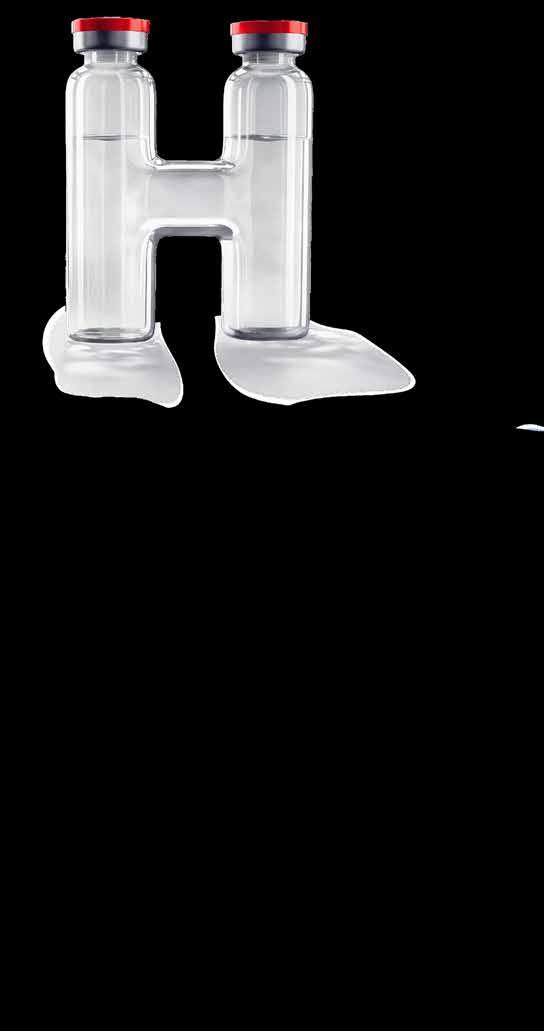

3/2025 - 6,50€




Giornalista e imprenditore, ha fondato questa rivista nel 1994. Con la sua visione arguta, le sue parole sagge e l’irresistibile simpatia è stato un punto di riferimento per tutti. Il ricordo della redazione.
Quando umanità e acume si incontrano, il risultato è qualcosa di raro, di memorabile. Queste due caratteristiche erano il sale di Stefano Lavorini, che ci ha lasciato il 25 aprile, dopo una malattia che ha segnato l’ultimo anno della sua vita.
Giornalista, imprenditore, Lavorini ha fondato la rivista ItaliaImballaggio ed è stato un punto di riferimento praticamente ineludibile per un intero settore industriale, quello del packaging. Ci spingiamo a dire ineludibile perché era davvero impossibile non essere raggiunti dall’eco dei suoi editoriali, da quelle parole sagge e affascinanti che aiutavano a fotografare il momento economico, che mettevano a nudo virtù e vizi del mondo produttivo, che invitavano a guardare i fatti da una prospettiva più ampia, storica, filosofica, immersa nel mare del vivere. Aveva la spiccata capacità di empatizzare con il lettore, di insegnargli qualcosa strizzandogli al contempo l’occhio, spronandolo. Le sue riflessioni hanno sempre guardato avanti, in direzione ostinata e contraria verso il miglioramento della vita di tutti e, in particolare, dei più fragili.
Questa sua inclinazione, nei rapporti personali, si traduceva in un’irresistibile simpatia. Stefano era, tutti quelli che l’hanno conosciuto lo sanno, simpatico. Brillante, con la battuta sempre pronta, rappresentava al meglio il crocevia di due regioni intense e sincere come la Toscana e il Lazio. Il suo accento romano, mai perso e che si faceva più ingombrante nei momenti di concitazione, l’amore per i tagli pregiati di
carne tipico del centro Italia e, guardando al passato, quella naturale passione per la classicità, per le citazioni colte, andavano perfettamente a braccetto con la placidità degli ulivi sulle colline senesi, col ritmo lento e incessante della raccolta nel mezzo dell’autunno.
I libri, e il sapere che dà loro forma, sono stati, per lui, un carburante inesauribile. Nei momenti più difficili dell’ultimo anno non ha mai smesso di leggere e di cercare, tra le pagine dei pensatori antichi e contemporanei, una risposta, un consiglio, una suggestione che fosse balsamo per l’anima. La carta ha rappresentato per lui un porto sicuro e una frontiera. Quando ha deciso di aprire la sua impresa, nel 1994, fondando ItaliaImballaggio, si è subito distinto per scelte coraggiose: pagine a colori, copertine d’artista, un approccio nuovo a una materia ‘dura’ come l’industria dell’imballaggio. E questa visione d’avanguardia l’ha accompagnato per tutto il suo percorso: basti pensare alla Carta Etica del Packaging, nata da una riflessione condivisa dalla sua ‘Edizioni Dativo’ e dal Politecnico di Milano, i cui valori - sempre attuali - sono oggi portati avanti da una fondazione dedicata. O all’attenzione al dato, un elemento fondante della società di oggi che Stefano ha da sempre collezionato con cura, attenzione e grande capacità di analisi. Ma parlavamo anche di carta come porto sicuro perché, nonostante la spinta innovativa, Stefano difendeva con orgoglio il lato ‘analogico’ dell’esistenza e dell’esercizio intellettuale. L’intelligenza artificiale non era certo nelle sue grazie, perché tra artificiale e umano, sapeva esattamente da che parte stare.
Se n’è andato, circondato dalle persone che amava e che si sono prese cura di lui con attenzione, lucidità e tenerezza, in un giorno intriso di significato e di valori civili, quello della Liberazione. Ci mancherà come l’aria.
A journalist and entrepreneur, Stefano Lavorini founded this magazine in 1994. With his deep insight, wise words and irresistible charm, he was a guiding light for us all. The editorial team remembers him with great affection.
When humanity and insight converge, the result is something rare and memorable. These two qualities were the defining traits of Stefano Lavorini, who passed away on 25 April after a year-long illness.
A journalist and entrepreneur, Stefano founded ItaliaImballaggio and became an almost indispensable point of reference for the entire packaging industry. We say “indispensable” on purpose, as it was impossible not to be touched by his editorials, by his words of wisdom that offered an insight into the economy, laid bare the virtues and shortcomings of the industrial world and invited readers to reflect on events from a broader historical and philosophical perspective, immersed in the flow of life. Stefano had a remarkable gift for engaging readers, offering insights with warmth and wit and encouraging them to think more deeply. His reflections always looked to the future with courage and
conviction, driven by a desire to improve life for everyone, especially the most vulnerable.
In his personal relationships, these qualities translated into irresistible charm. Those who knew Stefano remember him as instantly likeable, witty and brilliant, embodying the finest qualities of two vibrant and authentic Italian regions, Tuscany and Lazio. His Roman accent, which he never lost and which grew even more pronounced in moments of excitement, his appreciation for the fine cuts of meat typical of central Italy and his innate passion for the classics and for literary references all went hand-in-hand with the serene landscapes of olive groves in the Sienese hills and the gentle rhythm of the autumn harvest. Books, and the knowledge they impart, were a boundless source of inspiration. Even during the most difficult moments of his final year, Stefano never stopped reading and searching through the pages written by ancient and contemporary thinkers for answers, guidance or comfort. For Stefano, the printed word was both a safe haven and a frontier. When Stefano founded ItaliaImballaggio back in 1994,
he made a number of bold choices, opting for fullcolour pages, covers designed by artists and a fresh, accessible approach to a traditionally hard industrial subject like packaging. He maintained this visionary approach throughout his career. One example is the Ethical Packaging Charter, born out of a collaboration between his publishing house, Edizioni Dativo, and Milan Polytechnic, whose values remain highly relevant today and are now carried forward by a dedicated foundation. Another was his meticulous attention to data, which he collected, analysed and interpreted with great care, recognising its essential role in today’s society. We mentioned the printed word as a safe haven because, despite his commitment to innovation, Stefano remained fiercely loyal to the analogue dimension of life and intellectual activity. He was no fan of artificial intelligence: given a choice between artificial and human, he knew exactly where he stood. He left us surrounded by those he loved, cared for with devotion, lucidity and tenderness, on a day steeped in symbolic meaning and civic values, Italy’s Liberation Day. We will miss him as much as the air we breathe.

Valeriangelini è un’artista multidisciplinare italo-eritrea, che fonde astrazione e figurazione attraverso pittura, fotografia, video e installazioni site-specific. Il suo lavoro esplora memoria, identità e trasformazione digitale, creando esperienze immersive che dialogano con lo spazio e il pubblico. Ha esposto in eventi prestigiosi come Connessioni Interrotte alla Villa Reale di Monza e ha realizzato opere per spazi pubblici e ospedalieri, tra cui la nuova Ala di Pediatria dell’Ospedale San Gerardo di Monza.
Tra i suoi progetti recenti, la video-installazione What is Above is Like What is Below e I.D. Divine Identitas per Paratissima Torino. www.valeriangelini.com
Valeriangelini is an Italian-Eritrean multidisciplinary artist who merges abstraction and figuration through painting, photography, video, and site-specific installations. Her work explores memory, identity, and digital transformation, creating immersive experiences that engage with space and the public.
She has exhibited at prestigious events such as Connessioni Interrotte at Villa Reale in Monza and has created artworks for public and hospital spaces, including the new Pediatric Wing of San Gerardo Hospital in Monza. Her recent projects include the video installation What is Above is Like What is Below and I.D. Divine Identitas at Paratissima Torino.
Discover more at www.valeriangelini.com


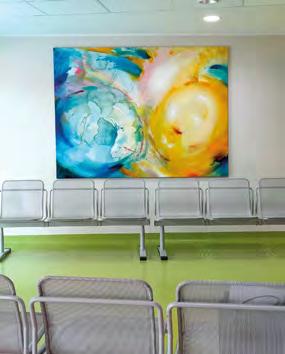



Gli azionamenti ad alte prestazioni sono essenziali per ottimizzare le macchine per l’imballaggio. Vi offriamo prodotti software e hardware scalabili che massimizzano l’efficienza dei processi: soluzione integrata: tecnologia di azionamento e motion control da un unico fornitore TwinCAT MC3: prestazioni più elevate grazie al motion control di ultima generazione flessibilità e rapido cambio formato con i sistemi di trasporto intelligente risparmio di costi e risorse grazie alla distributed drive technology scalabilità assicurata da una ampia gamma di sistemi modulari

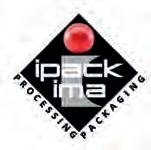

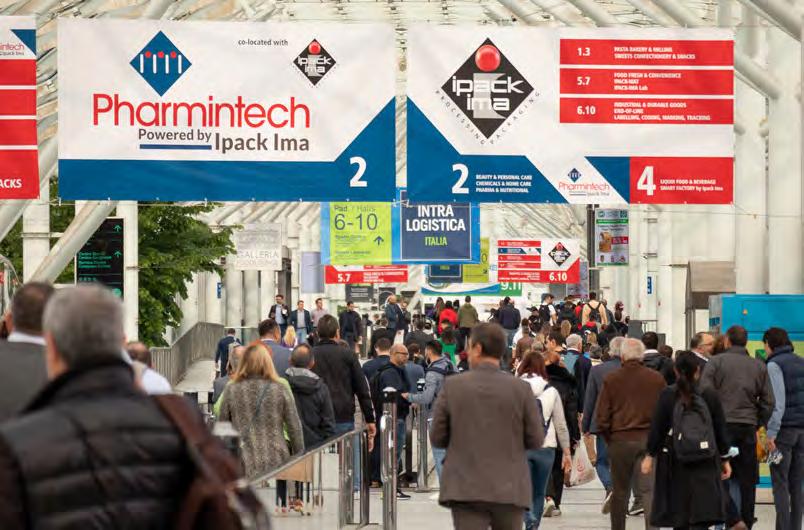

1 ItaliaImballaggio piange
Stefano Lavorini
ItaliaImballaggio remembers Stefano Lavorini
2 Behind the cover
Valeriangelini - Carrousel des rêves EVENTS
8 drinktec 2025
10 Eurasia packaging POWERED BY BEST PACKAGING
14 Best Packaging 2025: I finalisti in mostra
Finalists on display

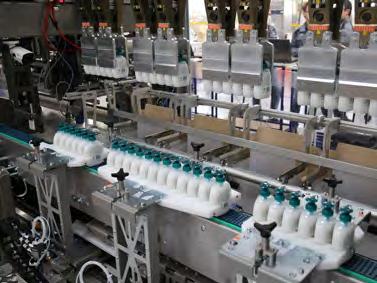

Marinella Vitulli
46 Materiali e oggetti a contatto con gli alimenti
Updates on MOCA: Food contact materials and objects
FOCUS IPACK-IMA 2025
lo speciale a cura della redazione Venite a trovarci in fiera! Pad. 5, stand C80
Meet us! Hall 5, booth C80
MATERIALS
58 Cutting Pack - L’evoluzione intelligente del packaging The intelligent evolution of packaging
60 HIPAC - HI.DEA, una rivoluzione per l’imballaggio manuale HI.DEA, a revolution for manual packaging
62 Punto Pack - Packaging secondario, importanza primaria
Secondary packaging, primary importance
64 Laminati green, l’IIot di Goglio MIND e la tracciabilità di Fres-co System®+ Green laminates, Goglio MIND’s IIot and Fres-co System® +
66 SDR Pack e Recycla: il packaging nell’economia circolare SDR Pack and Recycla: packaging as part of the circular economy

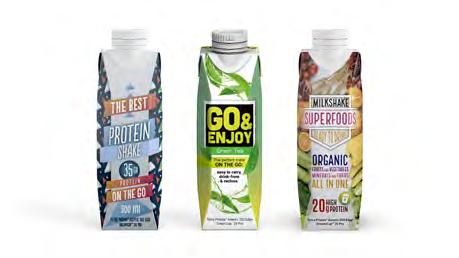
69 Super Film Packaging - Una crescita tra sostenibilità e innovazione
Growing in sustainability and innovation
PACKAGING MACHINERY
70 Cama - Un robot a 3 assi e carico automatico dei magazzini fustellati
A new 3-axis robot and automated magazine-loading technology for box blanks
72 CT Pack, tradizione e innovazione nel packaging
Tradition and innovation in packaging
75 Gampack - Soluzioni integrate per un packaging efficiente, smart e sostenibile
Integrated solutions for efficient, smart and sustainable packaging
78 Marchesini Group - Focus su processo e riempimento polveri
Focus on powder processing and filling
80 Sidel - Innovazione e soluzioni di impatto a Ipack-Ima 2025
Innovative and impactful solutions
83 Tiber Pack - Nicetuck, l’incartonamento senza colla è realtà Nicetuck, glueless case packing is here
85 MH Material Handling - Gestire l’accumulo dei prodotti ad alta velocità
Managing product accumulation at high speed
87 NEWS Comek, Universal Pack


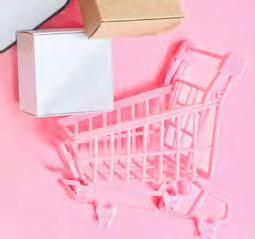
88 NEWS Arca Etichette
89 NEWS Altech, Herma
90 NEWS Etipack, Markem-Imaje
92 Nuovo Tech Service per Prati: nasce INNOTECH
The new Prati’s Tech Service: INNOTECH is here
AUTOMATION
95 D.C.M. - Da 50 anni un unico partner per soluzioni complete
For fifty years, a single partner for complete solutions
98 Schneider e Sacmi - L’elettronica rivoluziona il packaging del cioccolato
Electronics revolutionises chocolate packaging
100 HIWIN - Automazione e precisione al servizio del packaging industriale
Automation and precision at the Service of Industrial Packaging
102 Minebea Intec - Food: rispetto degli standard e protezione dai corpi estranei
Food: meeting standards and preventing foreign contamination
105 Il Sistema di interfaccia modulare icotek MIS
Modular nterface system Icotek MIS
106 Rockwell AutomationConfezionamento multiformato con una sola macchina
Multi-format packaging with one machine


108 NEWS Bonfiglioli, Pilz
109 NEWS WITTENSTEIN alpha
110 Efficienza, velocità affidabilità con le soluzioni SMC
Efficiency, speed and reliability with SMC solutions
AUXILIARY SYSTEMS
113 SIAD - Lunga vita al cibo con Foodline®
SIAD, food lasts longer with Foodline
116 EVOPALLET: evoluzione smart e sostenibile del pallet
EVOPALLET: smart and sustainable evolution of the pallet
PEOPLE
Edited by ItaliaImballaggio in cooperation with Ipack-Ima
121 Manuel Grassi (Ercopac), Marco Parretti (Etipack), Anna Paola Cavanna (Laminati Cavanna), Emiliano Caradonna (Qwarzo), Alessandro Pollini (Saba), Bruno Garavelli (Xnext), Giovanni Nocita (OMAG), Maria Grazia Preda (Sea Vision), Domenico Melchiorre (Taim), Daniele Romano (Vega Italia)
INTERVIEWS
Maria Costanza Candi
131 CMI Industries - Efficienza e soluzioni chiavi in mano per il riempimento chimico
Efficiency, local presence and turnkey solutions for chemical filling
Maria Costanza Candi
136 Aliplast - Closed loop e partnership strategiche per un packaging sostenibile e innovativo Closed loop and strategic partnerships for a sustainable and innovative packaging
Maria Costanza Candi
140 Tetra Pak - Normativa, sostenibilità e nuovi stili di vita disegnano il packaging del futuro
Regulations, sustainability and new lifestyles design the packaging of the future
FACTS & FIGURES
Luca Baraldi e Generoso Verrusio
144 Dazi e macchine packaging: cosa succederà nei prossimi tre anni?
Tariffs and packaging machines: what will happen in the next three years?
Milena Bernardi
147 E-commerce Italia: dati e prospettive di crescita
E-commerce Italy: data and growth prospects
TOPICS
Erik Ciravegna e Sara Battistini
151 Packaging Design. Care Package: kit per crisi emozionali
Care Package. Kits for emotional crises
158 Printing. Sun ChemicalEsperienza e trasformazione per le tecnologie di stampa Experience and transformation in printing technologies
Maria Costanza Candi
161 Cosmopack. Tecnologie per una bellezza “customizzata”: viste a Cosmopack
Technologies for a “customized” beauty: seen at Cosmopack

“Il mondo va così. Cento pensieri in libertà di Stefano Lavorini” è il libro che riceverà in omaggio con ItaliaImballaggio chi ritirerà la rivista a Ipack-Ima. Si tratta di un instant book che Kairos Media Group ha voluto realizzare per ricordare, a un mese dalla sua scomparsa, il fondatore di questa rivista. All’interno troverete una selezione dei suoi indimenticabili editoriali, un racconto lungo trent’anni che ha conquistato tantissimi lettori. Il libro verrà presentato in fiera a Milano martedì 27 maggio, alle 14.30, nella lounge di Ucima (Pad. 6, stand EST).

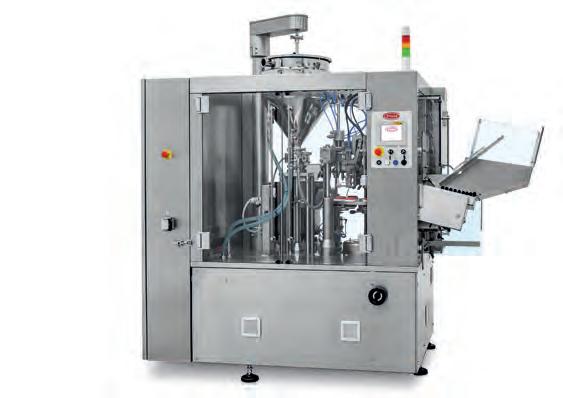

Direttore responsabile
Davide Miserendino
Condirettore
Luciana Guidotti
Redazione
Milena Bernardi, M. Costanza Candi
Traffico pubblicità
Salvatore Lavorini (salvatore.lavorini@kairosmediagroup.it)
Hanno collaborato
Luca Baraldi, Sara Battistini , Erik Ciravegna, Generoso Verrusio
Traduzioni
Ligabue Traduzioni e Interpretariati
Coordinamento artisti
Max Marra & Gianni Valentino
Progetto grafico e impaginazione Studio Grafico Page, Vincenzo De Rosa
Stampa e confezione
Faenza Printing Industries Spa Via Vittime Civili di Guerra 35, 48018 Faenza (RA)
Numero 3/2025 Maggio/Giugno 2025 anno 31
Pubblicazione iscritta al n 3 del Registro di Cancelleria del Tribunale di Modena in data 17/02/2025 Iscrizione nel Registro degli Operatori della Comunicazione n. 9673
Una copia: € 6,50 - Arretrati € 13
Periodicità
Bimestrale
Abbonamento per un anno:
Italia € 50
Rivista fondata nel 1994 da Stefano Lavorini
La riproduzione totale o parziale degli articoli e delle illustrazioni pubblicati su questa rivista è permessa previa autorizzazione della Direzione. La Direzione non assume responsabilità per le opinioni espresse dagli autori dei testi redazionali e pubblicitari
Kairos Media Group Srl Via Fossa Buracchione 84, 41126 Modena
Direttore editoriale
Davide Miserendino
Redazione/sede operativa
Via Fossa Buracchione 84, 41126, Modena T. +39 059512103, redazione@packmedia.net
Sales team
Massimo Chiereghin - m.chiereghin@kairosmediagroup.it
Roberta Pagan - r.pagan@kairosmediagroup.it
Nicola Saracino - n.saracino@kairosmediagroup.it
Elisa Verzelloni - e.verzelloni@kairosmediagroup.it
con la collaborazione di

SOCIO EFFETTIVO
ASSOCIAZIONE NAZIONALE EDITORIA DI SETTORE
Ai sensi del Regolamento Europeo sulla Protezione dei Dati 679/2016 (“GDPR”), del D.Lgs. 196/2013, del D.lgs. 101/2018 e delle successive modifiche e integrazioni, i trattamenti effettuati dal gruppo (U.C.I.M.A - proma-pack srl a socio unico - Kairos Media Group srl - MECS srl) saranno improntati ai principi di liceità, correttezza, trasparenza, limitazione delle finalità e della conservazione, minimizzazione dei dati, esattezza, integrità e riservatezza, nonché al principio di responsabilizzazione di cui all’art. 5 del Regolamento. Per consultare o rettificare i Vostri dati, o per opporvi alla ricezione della nostra rivista (art. 15-22 Regolamento Europeo 2016/679), potrete rivolgervi ai Titolari del trattamento, nelle società del gruppo UCIMA (U.C.I.M.A - proma-pack srl a socio unico - Kairos Media Group srl - MECS srl) scrivendo alla email del gruppo privacy@ucima.it.


drinktec

15 - 19 settembre 2025, Monaco di Baviera (D)
Organizer: Yontex
Con il suo focus su innovazione, sostenibilità e networking, drinktec si riconferma evento unico per l’intera catena del valore dell’industria del beverage e del liquid food.
n programma dal 15 al 19 settembre prossimi al Trade Fair Center Messe München, drinktec presenterà un’offerta completa di prodotti e servizi per l’industria delle bevande e degli alimenti liquidi, spaziando dalle materie prime e gli ingredienti alle tecnologie di processo, dai sistemi di riempimento e confezionamento per arrivare alla logistica.
Evento di caratura mondiale, nel 2022 ha richiamato 50.000 visitatori (70% internazionali) provenienti da 171 Paesi e si prevede che anche quest’anno diventi un momento irrinunciabile per i produttori di bevande analcoliche, birra, vino, spumante, bevande analcoliche gassate, succhi di frutta, alimenti liquidi, latte e prodotti lattiero-caseari liquidi. Ricordiamo che un contributo fondamentale allo sviluppo di drinktec arriva dalla VDMA
(Associazione tedesca per l’ingegneria meccanica e impiantistica) che, grazie all’expertise tecnica e alla sua rete globale, supporta la fiera come sponsor concettuale.
Hub di innovazione
Gran parte degli espositori sceglie drinktec per presentare in anteprima mondiale le proprie innovazioni. Imperdibile è quindi l’Innovation Guide, che raccoglie le proposte più recenti, selezionate da esperti e accessibili tramite una landing page: le informazioni dettagliate verranno infatti messe a disposizione dei visitatori direttamente nel quartiere fieristico tramite l’utilizzo di un QR code, così che non si perda nessuna delle anteprime mondiali presenti.
TuttoFood
Food exhibition
5-8/5/2025
Milano Rho (I) www.tuttofood.it
Macfrut
Fruit & vegetables professional show
6-8/5/2025
Rimini (I) www.macfrut.com
Labelexpo Southeast Asia
Label and packaging solutions
8-10/5/2025 Bangkok (T) www.labelexpo-seasia.com
Packaging Premiere & PCD Milan
Luxury packaging industry
13-15/5/2025
Milano (I) www.packagingpremiere.it
Ipack-Ima
Processing & packaging
27-30/5/2025
Milano Rho (I) www.ipackima.com
CosmeticBusiness 2025
Fiera internazionale dei fornitori per l’industria cosmetica 4-6/6/2025
Monaco di Baviera (D) www.cosmetic-business.com
Édition Spéciale Luxe Pack
Sustainable packaging solutions
1-2/7/2025
Paris (FR) www.editionspeciale-luxepack. com/en/
Drinktec
Beverage & liquid food industry - Processing, filling, packaging, marketing 15/9-19/5/2025 Munich (D) www.drinktec.com
Labelexpo Europe
Labeling industry 16-19/9/2025 Barcelona (E) www.labelexpo-europe.com
FachPack
Packaging, printing & logistics 23-25/9/2025 Nürnberg (D) www.fachpack.de/en
Luxe Pack Monaco Luxury packaging
29/9-1/10/2025
Montecarlo (MC) www.luxepackmonaco.com
K 2025
Plastics & rubber
8-15/10/2025
Düsseldorf (D) www.k-online.de


Futuro: parola chiave del programma collaterale
Il futuro è al centro del programma collaterale di drinktec, che si articola lungo tre filoni principali. Con “Circularity & Resource Management”, la fiera approfondirà l’uso responsabile delle risorse. “Data2Value” esplorerà il ruolo dell’intelligenza artificiale nell’industria. Il terzo tema, “Lifestyle & Health”, si focalizzerà sulle evoluzioni delle abitudini di consumo e sulle implicazioni per i produttori di bevande.
I visitatori possono già acquistare il biglietto di ingresso online e iniziare a pianificare la visita, consultando le piantine disponibili sul sito ufficiale. Grazie alla nuova versione del catalogo online sarà possibile personalizzare il proprio percorso e ottimizzare l’esperienza in fiera, utilizzando filtri che consentono di selezionare i padiglioni, i settori o i mercati di riferimento.
Per informazioni e il supporto in lingua italiana è possibile rivolgersi a BD Expo, la rappresentanza ufficiale della fiera drinktec in Italia (sales@bd-expo.net).
Host Hospitality exhibition
17-21/10/2025
Milano Rho (I) www.host.fieramilano.it
Eurasia Packaging Istanbul Packaging industry
22-25/10/2025 Istanbul (TR) http://packagingfair.com/en/
Cibus Tec Forum
Food processing & packaging technology
28-29/10/2025
Parma (I) www.cibustec.it
Gulfood Manufacturing Packaging & Processing
2-4/11/2025
Dubai (EAU)
drinktec September 15 - 19, 2025, Munich (D) Organizer: Yontex
With its focus on innovation, sustainability and networking, drinktec reconfirms its reputation as a unique event for the entire value chain of the beverage and liquid food industry.
Scheduled to take place Sept. 15-19 at the Trade Fair Center
Messe München, drinktec will present a comprehensive range of products and services for the beverage and liquid food industry, ranging from raw materials and ingredients to process technologies, filling

and packaging systems, and logistics.
proposals, selected by experts and accessible via a landing page: a QR code will provide detailed information directly at the exhibition centre, so that visitors do not miss any of the world premières hosted.
Future: the key word of the collateral events
The future is the focus of drinktec’s collateral events programme, which has three main themes. With “Circularity & Resource Management”, the fair will examine the responsible use of resources. “Data2Value” will explore the role of artificial intelligence in the industry. The third theme, “Lifestyle & Health”, will focus on changing consumption habits and the implications for beverage manufacturers.
Organising your visit
Mecspe Technologies for innovation
4-6/3/2026
Bologna (I) https://www.mecspe.com/it/
Cibus Tec
Food processing & packaging technology
27-30/10/2026
Parma (I) www.cibustec.it
This world-class event attracted 50,000 visitors (70% of them from abroad) from 171 countries in 2022 and is expected to be a must again this year for producers of soft drinks, beer, wine, sparkling wine, carbonated soft drinks, fruit juices, liquid foods, milk and liquid dairy products. A key contribution to drinktec’s development comes from VDMA (German Association for Mechanical and Plant Engineering), the conceptual sponsor of the fair that offers its technical expertise and global network.
Innovation Hub
Most exhibitors choose drinktec to showcase their innovations internationally for the first time, so not to be missed is the Innovation Guide, which presents the latest
Visitors can already purchase their entrance ticket online and start planning their visit by consulting the exhibition centre maps available on the official website. The new version of the online catalogue allows visitors to customise their itinerary and optimize their experience at the fair, using filters that allow you to select pavilions, sectors or reference markets.
Information and support in Italian can be obtained from BD Expo, the official representative of the drinktec fair in Italy(sales@bd-expo.net).
Eurasia Packaging 2025
22 - 25 ottobre 2025, Istanbul
Segreteria organizzativa: Reed Tüyap Fairs Inc.
La fiera Eurasia Packaging Istanbul si prepara a celebrare un importante anniversario nel 2025.
Più grande, più innovativa e più stimolante: l’edizione 2025 apre le porte dal 22 al 25 ottobre presso il Tüyap Fair and Congress Center di Istanbul. La fiera è organizzata in collaborazione con Turkish Packaging Manufacturers Association (ASD) e RX Tüyap, con il supporto di associazioni leader del comparto che includono Association of Packaging Machinery Manufacturers (AMD), Labeling Industry Association (ESD), Flexible Packaging Manufacturers Association (FASD), Cardboard Packaging Manufacturers Association (KASAD), Metal Packaging Manufacturers Association (MASD), Corrugated Board Manufacturers Association (OMÜD), Rigid Plastic Packaging Manufacturers Association (SEPA). Eurasia Packaging Istanbul 2025 si annuncia quindi come un’edizione speciale, ricca di eventi per celebrare un traguardo importante ma che guarda avanti.
Un successo che viene da lontano
La manifestazione vanta il patrocinio del Ministero del Commercio Turco e rappresenta
un punto di riferimento unico per le soluzioni di imballaggio, coprendo tutti i settori: dall’alimentare al beverage, dall’e-commerce alla logistica. Più che una semplice esposizione commerciale, Eurasia Packaging Istanbul si distingue come un polo di innovazione che contribuisce a delineare il futuro dell’industria del packaging. I visitatori potranno esplorare le ultime novità in materia di packaging sostenibile, tecnologie intelligenti per l’imballaggio e soluzioni all’avanguardia per il riciclo.
Cosa aspettarsi dalla fiera?
I visitatori avranno l’opportunità di scoprire una vasta offerta di prodotti tra packaging design, creatività e innovazione. Tra questi, materiali per imballaggio, macchine per il confezionamento, attrezzature per il processing alimentare, oltre a soluzioni per la stampa e la trasformazione del packaging. La manifestazione continua a crescere anno dopo anno, con nuovi padiglioni e espositori in aumento con oltre mille aziende presenti che portano all’attenzione di visitatori e buyer decine di migliaia di prodotti e soluzioni innovative.
Eurasia Packaging Istanbul Fair is preparing to celebrate an important anniversary in 2025
Bigger, more innovative, and more inspiring than ever, the fair will open its doors between October 22-25, 2025, at the Tüyap Fair and Congress Center in Istanbul. Organized in collaboration with the Turkish Packaging Manufacturers Association (ASD) and RX Tüyap, along with the support by industry-leading organizationsincluding the Association of Packaging Machinery Manufacturers (AMD), the Labeling Industry Association (ESD),
the Flexible Packaging Manufacturers Association (FASD), the Cardboard Packaging Manufacturers Association (KASAD), the Metal Packaging Manufacturers Association (MASD), the Corrugated Board Manufacturers Association (OMÜD), and the Rigid Plastic Packaging Manufacturers Association (SEPA) - Eurasia Packaging Istanbul 2025 is counting down to a milestone edition filled with special events for the 30th edition.
I NUMERI DELL’EDIZIONE 2024
Tenuto in concomitanza con FoodTech Eurasia (fiera internazionale delle tecnologie alimentari e delle bevande), Eurasia Packaging Istanbul 2024 ha occupato 16 padiglioni per una superficie espositiva coperta di 120.000 metri quadrati su cui hanno esposto 1.225 espositori e professionisti del settore provenienti da 39 paesi. L’edizione 2024, infine, ha registrato un totale di 77.572 visitatori, di cui 13.708 provenienti da 130 paesi senza dimenticare i 63.864 visitatori provenienti da tutta la Turchia.
2024 SHOW IN NUMBERS
Co-located with the FoodTech Eurasia - International Food and Beverage Technologies Fair, the Eurasia Packaging Istanbul Fair featured 16 halls covering 120,000 square meters of indoor exhibition space with 1,225 exhibiting companies and company representatives from 39 countries in 2024. A total of 77,572 visitors-13,708 of whom were from 130 countries, and 63,864 domestic visitors from across Türkiye came to the latest edition in 2024.
Registrarsi a Eurasia packaging
Per pianificare la visita a Eurasia Packaging Fair, è disponibile un codice QR per la registrazione online al sito: www.packagingfair.com/en
Getting a ticket
In order to plan a visit to Eurasia Packaging Fair, a QR code for registration is available (www.packagingfair. com/en)

A long lasting success
Supported by the Republic of Türkiye Ministry of Trade, the fair serves as a one-stop destination for creative packaging solutions across all industries, from food and beverages to e-commerce and logistics. More than just a trade show, Eurasia Packaging Istanbul stands out as a hub of innovation shaping the future of the packaging industry. Visitors will have the chance to explore groundbreaking advancements in sustainable packaging solutions, smart packaging technologies, and cutting-edge recycling innovations.
Visitors will have the opportunity to discover a vast array of creative and innovative packaging products, packaging machinery, food processing equipment, and printing and converting solutions. With continuous growth year after year, the fair is expanding with new halls, giving visitors access to over a thousand exhibitors and tens of thousands of products.

Imagine a complete turnkey processing and packaging line for your coffee. From beans reception to end-of-line solutions, each machine is interconnected in a digital ecosystem, maximising performance, production efficiency, and ensuring superior sustainability through monitored processing, reduced energy consumption, lower emissions, and with the ability to handle all compostable and recyclable packaging materials.
Imagine being able to have all this from one single source. IMA Coffee Hub. Look no further.

Visit us at Ipack-Ima 2025 27-30 Maggio Rho Pero Milano Hall 2 Booth C02-D01




Tema centrale dell’edizione 2025 del contest Best Packaging è l’innovazione tecnica e delle tecnologie. La premiazione dei vincitori si terrà il 28 maggio durante la fiera Ipack-Ima (27-30 maggio, Milano), luogo e momento deputato a rappresentare il rinnovamento e l’evoluzione dell’industria dell’imballaggio.
A cura della Redazione
Quest’anno, ci piace introdurre il servizio sul Best Packaging 2025 con un’annotazione, forse un po’ trascurata e passata in secondo piano, che invece noi riteniamo significativa: il contest è stato ufficialmente selezionato dal Ministero delle Imprese e del Made in Italy tra gli eventi rappresentativi della Giornata Nazionale del Made in Italy, che si è celebrata il 15 aprile scorso. Si è trattato di un riconoscimento importante, che ha confermato il valore culturale, economico e innovativo dell’iniziativa, da oltre sessant’anni punto di riferimento per il mondo dell’imballaggio italiano.
La Giornata, di fatto, rappresenta l’occasione per celebrare e promuovere l’identità italiana nei settori chiave dell’economia, mettendo in luce l’inventiva, la qualità e la sostenibilità che rendono unico il Made in Italy nel mondo. In questo contesto, la scelta del Best Packaging 2025 tra gli eventi ufficiali nasce proprio dalla capacità del contest di rappresentare in modo esemplare tali valori.
Fin dal 1957, il premio - organizzato da Packaging Meeting Srl e promosso da Istituto Italiano Imballaggio, quest’anno in collaborazione con Ipack-Ima e con il patrocinio di Conai e del Politecnico di Milano - intende infatti valorizzare le soluzioni che si distinguono in
The good ideas From Research to the Shelf Powered by Best Packaging Istituto Italiano Imballaggio Monthly showcase of packaging solutions to communicate, protect and distribute commonly used products.
termini di progettualità e design nella direzione dell’innovazione tecnica e tecnologica.
Conoscere i finalisti: valori e ricerca Il contest Best Packaging 2025 è dunque arrivato alla fase finale, la più attesa: quella della premiazione dei “migliori packaging”, scelti da una giuria di esperti fra i finalisti in gara, a cui nelle pagine seguenti diamo ampio e doveroso spazio.
E, ancora una volta, stupisce per il numero e la qualità delle soluzioni di imballaggio in concorso - prototipi, già commercializzate o in fase di industrializzazione nell’anno - valutate secondo i criteri di innovazione legati al miglioramento dell’impatto ambientale degli imballaggi ma soprattutto delle soluzioni tecnologiche adottate per migliorarne le prestazioni. Tutti progetti “messi a terra” dalle imprese del settore, che hanno saputo rinnovare materiali e tecnologie tradizionali, forme e prestazioni, offrendo una lettura alternativa e originale sulle tendenze che
The central theme of the 2025 edition of the Best Packaging contest is technical and technological innovation. The award ceremony for the winners will be held on May 28 during the Ipack-Ima exhibition (May 27-30, Milan), a place and time chosen to represent the renewal and evolution of the packaging industry.
By the Editorial Staff
This year, we’d like to introduce the report on Best Packaging 2025 with an observation which has perhaps been somewhat overlooked, but which we believe is significant: the contest was officially selected by the Ministry of Enterprises and Made in Italy as one of the representative events of the National Made in Italy Day, celebrated on April 15. This important acknowledgement confirmed the cultural, economic and
innovative value of the event, a benchmark for the Italian packaging world for over sixty years.
The Day offers an opportunity to celebrate and promote Italian identity in key sectors of the economy, highlighting the inventiveness, quality and sustainability for which Italy is unrivalled worldwide. In this context, the choice of Best Packaging 2025 as one of the official events stems precisely from the contest's
ability to provide an exemplary representation of these values. Since 1957, the award - organized by Packaging Meeting Srl and promoted by the Italian Institute of Packaging, this year in collaboration with Ipack-Ima and under the patronage of Conai and the Polytechnic University of Milan - has been seeking to highlight solutions that stand out in terms of planning and design aimed at fostering technical and technological innovation.
The Best Packaging 2025 contest has thus reached its final, most eagerly awaited stage: the presentation of the award for “best packaging”, with the winner chosen from the competition finalists by a jury of experts. We will be covering this at due length in the following pages.
Once again, an astonishing number of quality packaging solutions in the
competition - prototypes already on the market or in the process of being engineered during the year - have been evaluated according to the criteria of innovation related to improving the environmental impact of packaging, and above all, the technological solutions adopted to improve its performance. These are all projects that have been “sown” by companies in the industry that have been able to renew traditional materials and technologies, shapes and performance, offering an alternative and original interpretation of the trends set to redefine packaging in the coming years.
In a nutshell, the contest aims to highlight two types of innovation: on the one hand, solutions that stand out in terms of environmental prevention and circularity according to the eco-design mechanisms recommended by Conai; on the other, technological innovation, in accordance with the guidelines provided by Ipack-Ima. In addition, a special prize is awarded for
ridefiniranno il packaging nei prossimi anni. In estrema sintesi, il contest intende valorizzare due tipologie di innovazione: da un lato le soluzioni che si distinguono per la prevenzione ambientale e di circolarità secondo le leve di eco-design raccomandate da Conai; dall’altro l’innovazione delle tecnologie, secondo le linee guida messe a disposizione da Ipack-Ima. Inoltre un premio speciale viene assegnato al miglior design.
La Giuria di esperti ha valutato il grado di soddisfacimento ideale rispetto alle esigenze delle persone, degli operatori e dei mercati, basandosi sui tool in dotazione e sulla base di dati forniti dalle aziende.
Sta di fatto che il concorso non solo riconosce il valore innovativo nella progettazione del packaging, ma si impegna anche a promuovere la sostenibilità attraverso premi speciali per l’ambiente e il design «a conferma - ha osservato Francesco Legrenzi, direttore dell’Istituto Italiano Imballaggio, a cui lasciamo la parola - di quanto il packaging sia oggi un elemento strategico della filiera produttiva e comunicativa, in grado di unire estetica, funzione e responsabilità ambientale. Monitorare l’innovazione anche in ambito tecnologico rappresenta un passo ulteriore per riconoscere pubblicamente il valore innovativo della filiera del packaging».
NOTA. Il servizio dedicato ai finalisti del contest Best Packaging 2025 è curato dalla Redazione di ItaliaImballaggio su testi forniti dalle aziende.
1Barilla G. e R. fratelli SpA www.barillagroup.com
Cos’è. Pane di tipo “O” parzialmente cotto alla semola di grano duro con olio extravergine di oliva 3,5%. Il packaging consente di proteggere e conservare l’alimento a temperatura ambiente per 60 giorni, e di utilizzare il vassoio in cartone direttamente nel forno riscaldato a 220°C. Il prodotto rappresenta un’innovazione di successo in una categoria (specialità pani morbidi) in grande sviluppo. È inoltre apprezzabile per la sostenibilità dei materiali che sono riciclabili, e la riconosciuta convenience per gli utilizzatori finali.
Innovazione. Il vassoio in cartoncino di pura fibra di cellulosa consente un utilizzo immediato e semplice nel forno tradizionale; i materiali sono riciclabili nelle diverse filiere di raccolta differenziata (plastica e carta), e idonei al contatto con alimenti anche a temperature elevate.
Materiali utilizzati. Il film di polipropilene ha elevatissima barriera a gas ed umidità, pur rimanendo riciclabile nella filiera dei film monomateriali. La vaschetta è realizzata con carte Kraft antigrasso (prive di PFAS) e vegetali, che resiste a un trattamento termico fino a 220°C per 60’.
Tecnologie applicate e vantaggi. Confezionamento in atmosfera modificata e trattamento con alcool etilico in superficie. Il prodotto è diventato in poco tempo lo standard di mercato per la categoria.
the best design. The Jury of Experts assessed the ideal degree of fulfilment of the needs of people, operators and markets, based on the tools provided and based on data provided by companies. The competition not only acknowledges the value of innovation in packaging design; it is also committed to promoting sustainability through special awards for the environment and design, «confirming - noted Francesco Legrenzi, director of the Italian Institute of Packaging - that packaging is now a strategic element in the production and communication chain, able to combine style, function and environmental responsibility. Monitoring innovation in technology is a further step towards publicly acknowledging the innovative value of the packaging supply chain».
Product overview. Partially baked “Type 0” durum wheat semolina bread with 3.5% extra virgin olive oil. The packaging ensures the product can be safely stored at room temperature for up to 60 days, while the cardboard tray is designed for direct use in an oven preheated to 220°C. This product represents a significant innovation within the rapidly growing speciality soft bread category. It is also appreciated for its use of sustainable, recyclable materials and the well-recognised convenience it provides to end users.
Innovation. The tray, made from pure cellulose fibreboard, is designed for immediate and easy use in a conventional oven. The materials are recyclable through standard waste collection systems (paper and plastic), and are certified safe for food contact, even at high temperatures.
Materials used. Polypropylene film provides an excellent barrier against gas and moisture, while remaining recyclable through mono-material film supply chains. The tray is made from greaseproof (PFAS-free) Kraft paper


Inoltre la categoria dei pani morbidi parzialmente cotti può beneficiare di soluzioni tecniche ottenute con lo stesso tipo di materiale, adattando le misure al prodotto finito.
Benefici per ambiente e consumatori. Tutti i materiali sono riciclabili nelle filiere di raccolta differenziata (carta e plastica). Al consumatore è garantita convenience ed esperienza d’uso: direttamente nel forno senza impiego di utensili, il prodotto è pronto in cinque minuti.
Plus di comunicazione. La comunicazione sul pacco si focalizza sulla facilità di preparazione e sull’uso diretto del forno tradizionale.
of plant origin, capable of withstanding heat treatment at 220°C for up to 60 minutes.
Applied technologies and benefits. Modified atmosphere packaging and surface treatment with ethyl alcohol. The product quickly established itself as the market standard within its category. In addition, the partially baked soft bread category can benefit from technical solutions developed using the same type of material, adapting the measurements to the finished product.
Environmental and consumer benefits. All packaging materials are fully recyclable through separate waste collection chains (paper and plastic). Consumers enjoy maximum convenience and ease of use: the product can be placed directly in the oven without the use of additional utensils and is ready to serve in just five minutes.
Communication advantages. On-pack communication focuses on the product’s ease of preparation and its suitability for direct use in a conventional oven.

Cos’è. Scudo è un sistema di protezione realizzato al 100% in cartone con tecnologia 3D, che assorbe e riduce gli impatti che il prodotto riceve durante il processo logistico, contribuendo a ridurre la carbon footprint dell’imballaggio. È stato creato per le industrie che realizzano prodotti ad alto valore aggiunto, dove la protezione dagli urti è essenziale anche in condizioni estreme, eliminando l’uso eccessivo di materiali di imballaggio quali legno, plastica, polistirolo, ecc.
Design, sostenibilità ed efficacia sono le ragioni principali del successo di Scudo, un prodotto tecnologico rispettoso dell’ambiente che garantisce un’esperienza gradevole agli utilizzatori e ai loro clienti in termini di prestazioni, protezione e riciclo. E proprio il design fa la differenza rispetto ad altre soluzioni di protezione, tanto che dal 2022 fa parte della collezione permanente del Museo del Design di Barcellona.
Innovazione. La flessibilità del design consente una presa perfetta, adattandosi a qualsiasi spessore, forma e peso del prodotto, con l’utilizzo di un’unica materia prima, riciclabile al 100%.
Materiali utilizzati. Cartone riciclato e riciclabile al 100%.
Tecnologie applicate e vantaggi. La tecnologia utilizzata è la sovrapposizione di strati di cartone in 3D, per ottenere diversi spessori e forme. Oltre a eliminare il pericolo di rotture ad alto costo ambientale ed evitare l’eccesso di imballaggio, l’utilizzo del cartone come unica materia prima facilita il processo di riciclo e il ciclo di vita del materiale, migliorando i risultati in termini di protezione del prodotto rispetto ad altre soluzioni.
Scudo è stato sviluppato e testato in collaborazione con i produttori di macchine per l’imballaggio, per facilitare le operazioni di assemblaggio nel processo produttivo e logistico, adattandosi alle innovazioni industriali contemporanee.
Benefici per ambiente e consumatori. Brafim mette a disposizione un calcolo dell’impronta di carbonio sviluppato dal laboratorio Itene che consente di confrontare qualsiasi soluzione protettiva con Scudo. Secondo il raffronto tra Scudo e altre soluzioni presenti sul mercato (plastica, polistirolo o schiuma), i test di impatto (Droptest) effettuati nel laboratorio Brafim misurati in G indicano un’ ammortizzazione dell’impatto fino a 5 volte inferiori.
Innumerevoli i benefici per l’utilizzatore: Scudo riduce i costi di gestione delle rotture, nonché il costo del materiale di imballaggio; semplifica il processo di confezionamento e migliora la produttività; lo spazio di stoccaggio diminuisce, così come i costi di trasporto; espande la portata delle vendite (online & export). E, non ultimo, semplifica il riciclo per il cliente finale.

Product overview. Scudo is a protective packaging system made entirely of cardboard. Designed using 3D technology, it effectively absorbs and reduces impacts during logistics operations, thereby helping to lower the carbon footprint of the packaging. It was developed for industries that produce high-value-added products, where impact protection is essential, even under extreme conditions, eliminating the excessive use of packaging materials such as wood, plastic, Styrofoam, etc. Design, sustainability, and effectiveness are the key factors behind the success of Scudo, an environmentally friendly packaging solution that delivers an optimal experience for both users and their customers in terms of performance, protection, and recyclability. It is the design itself that sets Scudo apart from other protection solutions, so much so that, since 2022, it has been included in the permanent collection of the Barcelona Design Museum.
Innovation. The flexible design ensures a perfect grip, adapting to any product thickness, shape or weight, all while using a single raw material that is 100% recyclable.
Materials used. 100% recycled and recyclable cardboard.
Applied technologies and benefits. The technology involves overlapping layers of 3D cardboard to achieve varying thicknesses and shapes. In addition to eliminating the risk of breakage and reducing the environmental impact associated with excess packaging, the use of cardboard as the sole raw material simplifies recycling and extends the material’s life cycle-delivering superior protection compared to alternative solutions.
Scudo was developed and tested in cooperation with packaging machinery manufacturers to streamline assembly operations within production and logistics processes, ensuring compatibility with modern industrial innovations.
Environmental and consumer benefits. Brafim offers a carbon footprint assessment developed by the ITENE laboratory that enables direct comparison between Scudo and other protective packaging solutions.
Compared to other solutions on the market, such as plastic, polystyrene or foam, impact tests (Droptest) conducted in the Brafim laboratory, measured in G-force, show that Scudo provides up to five times better impact cushioning. Countless benefits for the user: Scudo helps reduce costs related to product breakage and packaging materials. It simplifies the packaging process, boosts productivity, reduces storage space requirements and transportation costs, and makes it easier to expand into online and export markets. Last but not least, it simplifies recycling for end users.

Esiste una geometria precisa nel sistema solare e ogni elemento interagisce in maniera perfetta con gli altri. Ispirandosi ai pianeti, PRATI costruisce le proprie macchine affinché ogni modello possa funzionare in armonia con l’ambiente e… “girare all’infinito”!

Metti PRATI al centro e raggiungi
un’altra dimensione tra le infinite possibilità di varnishing, digital foiling, die-cutting, numbering, 100% quality inspection, rewinding&stacking…
PRATI, tutto un altro pianeta nella nobilitazione e finitura post stampa di etichette e packaging: oro a freddo, digital doming, fustellatura, sfridatura, ispezione, sovrastampa, taglio, ribobinatura, stacking e sheeting, per essere sempre un passo avanti nel futuro nei settori food&bevarage, wine&spirits, cosmetico, farmaceutico, chimico, logistica, promozionale e brand protection.
PRATI srl Via Deruta, 2 48018 Faenza (Ra) - Italy +39 0546 633 811 info@praticompany.com
www.praticompany.com


PRATI USA LLC 4101 McEwen - Suite 368 Dallas, TX 75244 - USA +1 913 908 8607 fhasselberg@praticompany.com
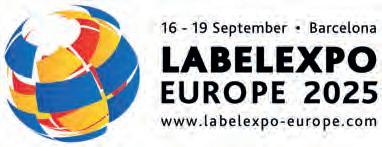

Cos’è. BeFresh è una vaschetta in cartoncino progettata per il confezionamento in atmosfera protettiva di alimenti freschi che si presta a molteplici utilizzi per il consumo, in condizioni di riscaldamento, refrigerazione e congelamento. Garantisce la medesima shelf life del materiale plastico, mantenendo la freschezza degli alimenti.
Pensata per l’industria alimentare in larga scala che confeziona i prodotti in atmosfera modificata, si propone come alternativa alle tradizionali vaschette in plastica per il confezionamento in ATM, migliorando circolarità e comunicazione.
Innovazione. In cartoncino certificato FSC®, la vaschetta è riciclabile nella carta (Aticelca 501®-livello B), combinando sostenibilità e alte prestazioni. Compatibile con le tradizionali macchine vuoto gas standard MAP, conserva gli alimenti freschi in atmosfera protettiva. Versatile e pratica, è adatta a forno, microonde, refrigerazione e congelamento, ed è disponibile anche con film pelabile.
Materiali utilizzati. Cartoncino innovativo in fibra vergine proveniente da fonti rinnovabili (certificato FSC®) e progettato appositamente per rispondere a elevati requisisti di formabilità. Il rivestimento plastico multistrato offre un’eccellente protezione contro umidità, ossigeno e grassi.
BeFresh può essere smaltita nella raccolta differenziata della carta (Aticelca 501®-livello B).
Tecnologie applicate e vantaggi. BeFresh è realizzata in cartoncino multistrato con film barriera ed è ad alta formabilità. Grazie a un avanzato processo di ingegnerizzazione e innovazione tecnologica degli stampi (che consentono di raggiungere una qualità del bordo della vaschetta pressoché piana), può essere termoformata direttamente senza bisogno di ulteriori lavorazioni, rendendo la produzione più efficiente.
Benefici per ambiente e consumatori. BeFresh nasce da materie prime rinnovabili e continua il suo ciclo virtuoso anche dopo l’uso, essendo riciclabile nella carta. In questo modo promuove un modello di economia circolare, contribuendo a un uso più efficiente delle risorse e riducendo gli sprechi alimentari. Soluzione ideale per chi cerca praticità e sicurezza nella conservazione degli alimenti freschi, non solo protegge i cibi durante il trasporto e la manipolazione evitando danni fisici, ma garantisce anche la massima sicurezza alimentare. Grazie alla possibilità di riscaldare il contenuto direttamente in forno tradizionale o microonde, e alla resistenza alle basse temperature di refrigerazione e congelamento, risulta molto versatile.
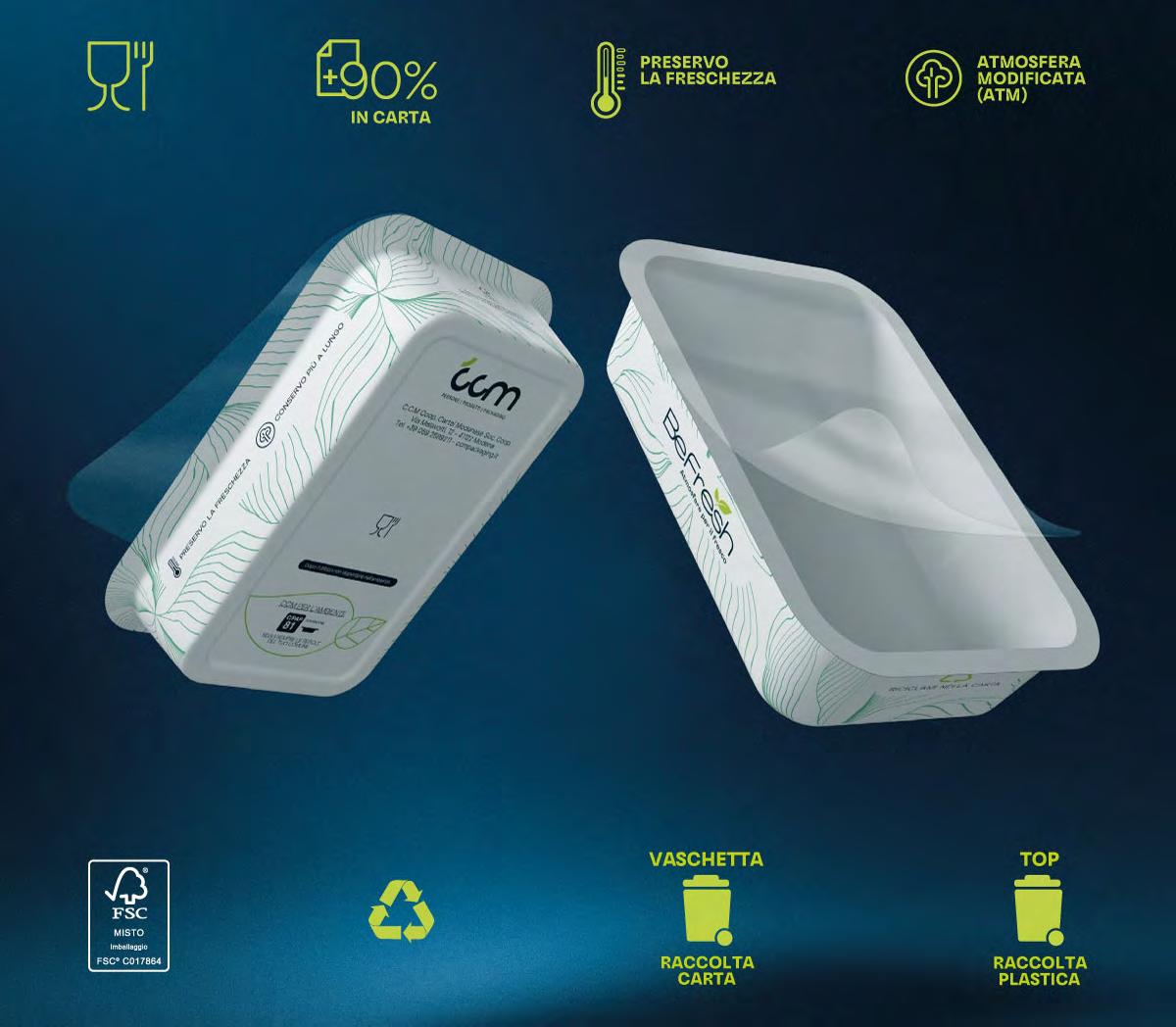
La saldatura in atmosfera modificata contribuisce a preservare la freschezza degli alimenti più a lungo. Il tutto con un occhio di riguardo alla praticità: smaltibile nella carta, utilizzo e smaltimento risultano ancora più intuitivi grazie alla possibilità di stampare direttamente sulla confezione le istruzioni per il corretto conferimento.
Adattabilità e scalabilità: BeFresh è progettata per integrarsi perfettamente nei processi produttivi senza richiedere investimenti aggiuntivi. È confezionabile sulle macchine vuoto gas standard MAP già presenti nell’industria alimentare, garantendo un passaggio fluido alle aziende che vogliono adottare un packaging più sostenibile senza modificare gli impianti esistenti.
Disponibile in diversi formati, può essere termosaldata con un film barriera ai gas per preservare la freschezza degli alimenti più a lungo. Grazie alla sua compatibilità con gli impianti di confezionamento tradizionali, BeFresh rappresenta una scelta pratica ed efficiente per ogni tipologia di pro -
dotto alimentare, offrendo massima protezione e un ridotto impatto ambientale.
Plus di comunicazione. BeFresh si distingue per un dialogo trasparente e responsabile con il consumatore, fornendo informazioni chiare e verificate sulle modalità d’uso, la sostenibilità e la riciclabilità del packaging. Ogni claim è supportato da certificazioni autorevoli, garantendo credibilità e affidabilità, senza ricorrere a pratiche di greenwashing.
Grazie a icone intuitive e messaggi immediati, BeFresh facilita la corretta gestione del prodotto, migliorando l’esperienza d’uso e promuovendo scelte più consapevoli. In questo modo, non solo protegge gli alimenti, ma sensibilizza i consumatori verso un consumo più responsabile e sostenibile.

Product overview. BeFresh is a cardboard tray designed for the protective atmosphere packaging of fresh food, suitable for a variety of uses including heating, refrigeration and freezing. It offers the same shelf life as plastic packaging while preserving the freshness of food. Designed for the large-scale food industry that packs products in modified atmospheres, BeFresh provides an alternative to traditional plastic trays used in Modified Atmosphere Packaging (MAP), improving both circularity and communication.
Innovation. Made from FSC®-certified cardboard, the tray is recyclable in paper (Aticelca 501®-level B), combining sustainability and high performance. Compatible with conventional MAPstandard gas vacuum machines, it preserves fresh food in a protective atmosphere. Versatile and practical, it is suitable for use in ovens, microwaves, refrigerators and freezers, and it is also available in peelable film.
Materials used. It is made from innovative virgin fibre paperboard sourced from renewable materials (FSC® certified) and specially designed to meet high formability requirements. The multilayer plastic coating provides excellent protection against moisture, oxygen and grease. BeFresh can be disposed of through separate paper collection (Aticelca 501®-level B).
Applied technologies and benefits.
BeFresh is made from multilayer cardboard with a barrier film, offering high formability. Thanks to advanced engineering and innovative mould technology (which ensures nearly flat tray edges), it can be thermoformed directly without the need for additional processing, thus streamlining production and improving efficiency.
Environmental and consumer benefits.
BeFresh is made from renewable raw materials and continues its virtuous cycle even after use, being fully recyclable as paper. This supports a circular economy model, contributing to more efficient use of resources and reducing food waste. It offers an ideal solution for those seeking convenience and safety in fresh food storage. BeFresh not only protects food during transport and handling, preventing physical damage, but also ensures maximum food safety. It offers exceptional
versatility, allowing contents to be heated directly in a conventional oven or microwave, while also withstanding low refrigeration and freezing temperatures. Sealing in a modified atmosphere helps extend the freshness of food. Designed with convenience in mind, it is fully disposable through paper waste collection. The packaging can also include printed instructions for proper disposal, making both use and disposal even more intuitive for consumers.
Adaptability and scalability: BeFresh is designed for easy integration into existing production processes, with no need for additional investment. It is compatible with MAP-standard gas vacuum machines commonly used in the food industry, ensuring a smooth transition for companies looking to adopt more sustainable packaging without the need to modify their current equipment. Available in various sizes, it can be heat-sealed with a gas barrier film to extend the freshness of food. Its compatibility with conventional packaging equipment makes BeFresh a practical and efficient choice for a wide range of food products, providing maximum protection while minimising environmental impact.
Communication advantages. BeFresh is distinguished by transparent and responsible communication with consumers, providing clear, verified information on the use, sustainability, and recyclability of the packaging. Every claim is backed by authoritative certifications, ensuring credibility and reliability without resorting to greenwashing practices. With intuitive icons and clear messaging, BeFresh simplifies proper product handling, enhancing the user experience and promoting more informed consumer choices. In this way, it not only protects food but also fosters greater awareness of responsible and sustainable consumption.
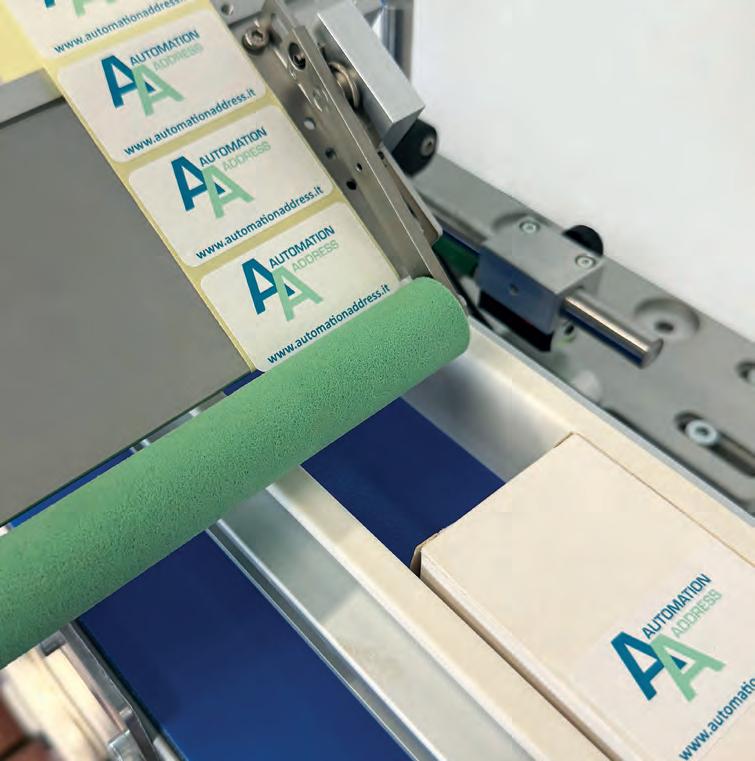




Cos’è. Nuova versione dell’iconico blend [ comfort zone ], Tranquillity™ Flower Blend è arricchito da fiori di amaranto essiccati, simbolo di forza e immortalità. Composto da oli essenziali di legno di cedro, arancia dolce, rosa, sandalo, geranio e vetiver, sfrutta l’aromaterapia per offrire benessere e rilassamento. L’aggiunta dei fiori, oltre al valore estetico, amplifica l’esperienza sensoriale e l’idea di connessione con la natura. Adatto a un pubblico ampio, si sostanzia in un packaging dal design floreale raffinato e accessibile, perfetto per chi vuole ricreare un’esperienza di benessere a casa, trasformando piccoli momenti quotidiani in rituali di relax e armonia.
Innovazione. Nato come edizione limitata di un prodotto iconico già sul mercato, il packaging è stato progettato per esaltarne l’esclusività. Ogni dettaglio - materiale, forma, peso e praticità - è studiato per offrire un’esperienza sensoriale e funzionale unica, rendendolo un elemento strategico. La chiave che rende unico il packaging di questo prodotto è l’innovativa chiusura ad interferenza, che è in grado di mantenere il vuoto, garantendo una protezione ottimale del prodotto all’interno, preservandone freschezza, qualità e integrità nel tempo.
L’assenza di un sistema di erogazione eleva l’esperienza d’uso, diversificando le possibilità di applicazione del blend, per utilizzarlo puro o in combinazione con le creme corpo.
Materiali utilizzati. Il flacone in vetro satinato riprende la geometria iconica della linea, mentre il tappo, impreziosito dal dettaglio delle parentesi, richiama il logo del brand. La confezione esterna, in carta 100% riciclata FSC, unisce estetica raffinata e rispetto per l’ambiente. Ispirata al prodotto, si apre come un fiore dai petali color amaranto, richiamando il fiore presente nel blend.

Tecnologie applicate e vantaggi. Il packaging primario in vetro neutro satinato non verniciato è stato realizzato utilizzando uno stampo proprietario con design esclusivo per esprimere eleganza e raffinatezza. Il tappo con parentesi quadre in rilievo valorizza il brand, mentre la chiusura a interferenza, senza erogatore, consente l’uso del blend puro o combinato con le creme corpo. Le etichette minimal in PET rendono il packaging quasi mono-materiale. L’astuccio secondario, in carta 100% riciclata FSC, si apre come un fiore, armonizzando concept, packaging e formula con un design elegante e minimalista nei toni del grigio.
Il flacone in vetro senza erogatore offre un design elegante e sostenibile, preservando la qualità del prodotto. Permette un dosaggio personalizzato e una maggiore versatilità d’uso, riducendo la necessità di sistemi complessi. Pratico e intuitivo, il prodotto si può utilizzare anche con una pipetta, senza sistemi di erogazione complessi.
Benefici per ambiente e consumatori. Il packaging primario in vetro, privo di vernici e inchiostri, può essere considerato mono-materiale (le etichette in PET pesano meno del 5% sul peso complessivo del flacone) e tutti i componenti sono facilmente separabili, consentendo quindi di smaltire ogni elemento nel corretto flusso di riciclo. L’astuccio è prodotto con carta 100% riciclata FSC.
Plus di comunicazione. Il prodotto nasce come variante esclusiva di un best-seller già affermato sul mercato, con l’obiettivo di valorizzare e incrementare le vendite sia del singolo articolo sia dell’intera linea Tranquillity™, la più iconica e rappresentativa del brand. Il design floreale del packaging lo rende particolarmente attraente e ideale come regalo. L’astuccio secondario offre informazioni chiare e utili al consumatore, includendo il logo BCorp, la certificazione Vegan e un QR code che conduce a una landing page dedicata, dove è possibile scoprire le modalità di riciclo del packaging, approfondire le formulazioni e conoscere i principi di eco-design che guidano il brand.
In pratica, Tranquillity™ Flower Blend non è solo un prodotto, è un viaggio sensoriale che incarna perfettamente i valori di [comfort zone] e del gruppo Davines, unendo arte, scienza e sostenibilità in un’unica esperienza.


Product overview. A new version of the iconic [ comfort zone ] blend, Tranquillity™ Flower Blend is enriched with dried amaranth flowers, a symbol of strength and immortality. Composed of essential oils of cedarwood, sweet orange, rose, sandalwood, geranium and vetiver, it promotes well-being and relaxation through the principles of aromatherapy. Beyond its aesthetic appeal, the inclusion of flowers enhances the sensory experience and reinforces the connection to nature. Suitable for a broad audience, it comes in elegantly designed packaging featuring an accessible floral aesthetic, perfect for those seeking to recreate a spa-like experience at home, turning small everyday moments into rituals of relaxation and harmony.
Innovation. Developed as a limited edition of an already iconic product, the packaging has been designed to enhance its exclusivity. Every detail-from the choice of materials to shape, weight, and functionality-has been carefully considered to provide a unique sensory and user experience, making the packaging a strategic element of the product itself.
What makes the packaging of this product truly unique is its innovative interference closure, which effectively maintains a vacuum seal. This feature ensures optimal protection of the contents, preserving freshness, quality and integrity over time.
The absence of a delivery system enhances the user experience by allowing greater versatility in application, whether used in its pure form or mixed with body creams.
Materials used. The frosted glass bottle reflects the iconic geometry of the line, while the cap, embellished with a bracket detail, subtly references the brand’s logo.
The outer packaging, made of FSCcertified 100% recycled paper, combines refined aesthetics with environmental responsibility. Inspired by the product itself, it opens like a flower, revealing amaranthcoloured petals that evoke the flower featured in the blend.
Applied technologies and benefits. The neutral, frosted, unpainted glass primary packaging is produced using a proprietary mould with an exclusive design that conveys elegance and sophistication. The
cap, featuring embossed square brackets, reinforces brand identity, while the interference closure-designed without a dispenser-allows the blend to be used on its own or mixed with body creams. Minimal PET labels make the packaging nearly mono-material. The secondary packaging, made of FSC-certified 100% recycled paper, opens like a flower, uniting concept, packaging, and formula in an elegant, minimalist design featuring grey tones.
The dispenser-free glass bottle adds to the sleek, sustainable aesthetic while preserving the product’s quality. It enables customised dosing and greater versatility of use, reducing the need for complex systems. Practical and intuitive, the product can also be used with a pipette, without the need for complex dispensing systems.
Environmental and consumer benefits.
The primary glass packaging, free from varnishes and inks, qualifies as mono-material (with PET labels accounting for less than 5% of the total bottle weight). All components are easily separable, allowing each element to be
disposed of in the appropriate recycling streams. The case is made from FSC-certified 100% recycled paper.
Communication advantages. The product was developed as an exclusive variant of an already successful best-seller, aimed at enhancing and boosting sales not only of the individual item but also of the entire Tranquillity™ line, the brand’s most iconic and representative collection. The floral design of the packaging enhances its visual appeal, making it an ideal choice for gifting. The secondary packaging provides clear and useful information for the consumer, including the BCorp logo, Vegan certification and a QR code that directs to a dedicated landing page. There, consumers can discover how the packaging is recycled, learn more about the formulations and explore the eco-design principles that guide the brand.
In essence, Tranquillity™ Flower Blend is more than just a product; it’s a sensory journey that perfectly embodies the values of [comfort zone] and the Davines Group, merging art, science and sustainability into one experience.


Cos’è. Soluzione completa che unisce tecnologia, innovazione e performance all-in-one: fres-co System®+ è un sistema integrato che stabilisce una connessione diretta tra i laminati flessibili e le linee di confezionamento, supportato dalla piattaforma digitale MIND, creando un ecosistema interconnesso dove materiali, macchine e dati collaborano in tempo reale. Si tratta di un’innovazione unica, che garantisce risultati concreti e misurabili, nonché un servizio in continua evoluzione: la raccolta dei dati permette al sistema di continuare a migliorarsi, eliminando inefficienze e anticipando gli interventi di manutenzione. fres-co system®+ può essere applicato a tutti i contesti industriali di confezionamento e a diversi settori: caffè, industria alimentare, cosmetica, settore industriale.
Innovazione. Un codice univoco sull’anima della bobina del laminato flessibile identifica il materiale, suggerisce alla linea i parametri per la migliore efficienza produttiva, comunica con Goglio MIND correlando le caratteristiche della bobina con le prestazioni produttive e raccoglie e analizza i dati di processo.
L’innovazione può essere applicata a tutte le linee di confezionamento di produzione Goglio e a tutti i laminati flessibili prodotti, sia tradizionali, sia di nuova generazione “pronti per il riciclo”.
Tecnologie applicate e vantaggi. L’innovazione è sviluppata all’interno della piattaforma digitale Industrial IoT di Goglio MIND, che permette il monitoraggio in tempo reale, l’analisi predittiva e l’ottimizzazione continua. La tecnologia applicata permette di ottimizzare in automatico i parametri di processo, la riduzione dei tempi di setup, la minimizzazione degli sprechi di materiale e la massimizzazione della qualità del confezionamento.
Benefici per ambiente e produttori. La tecnologia è stata testata con risultati particolarmente positivi nella produzione di confezioni con materiali “pronti per il riciclo”, che necessitano di un settaggio specifico della linea di confezionamento. L’impostazione automatica permette di ridurre tempi di setup e sprechi di materiale.
In ogni applicazione, fres-co System®+ garantisce massima efficienza produttiva, qualità costante del confezionamento, riduzione degli sprechi e ottimizzazione delle risorse.
Plus di comunicazione. Non esistono soluzioni paragonabili, dove un unico fornitore è in grado di fornire al contempo laminati, macchine e servizi digitali avanzati. In sintesi è un concentrato di innovazione tecnologica, sostenibilità, machine learning, customizzazione e tracciabilità a sostegno delle migliori partnership.

Product overview. fres-co System®+ is a complete solution that integrates technology, innovation and performance. This all-in-one system establishes a direct connection between flexible laminates and packaging lines, supported by the MIND digital platform. Together, they create an interconnected ecosystem where materials, machines and data collaborate in real time. This innovative solution guarantees concrete, measurable results and a continuously evolving service. By collecting and analysing data in real time, the system continuously optimises performance, eliminates inefficiencies and enables predictive maintenance. fres-co system®+ can be applied to all industrial packaging environments and is suitable for a wide range of industries, including coffee, food, cosmetics, and industrial applications.
Innovation. A unique code on the core of each flexible laminate roll identifies the material and recommends optimal production parameters to the packaging line. It also communicates with Goglio MIND, correlating the characteristics of each roll with the production performance, while collecting and analysing process data to enhance efficiency.
This innovation is compatible with all of Goglio’s packaging lines and can be applied to all flexible laminates produced, both traditional and the new generation of ‘ready to recycle’ laminates.
Applied technologies and benefits. The innovation is developed within Goglio MIND’s Industrial IoT digital platform, which enables real-time monitoring, predictive analytics, and continuous process optimisation.
The applied technology enables automatic optimisation of process parameters, reduces set-up times, minimises material waste and maximises packaging quality.
Benefits for the environment and producers. The technology has been tested with highly positive results in the production of packaging using ‘ready to recycle’ materials, which require specific packaging line configurations. Automatic configuration reduces setup time and material waste.
In every application, fres-co System®+ delivers maximum production efficiency, consistent packaging quality, reduced waste and optimised use of resources.
Communication advantages. There are no comparable solutions on the market where a single supplier can simultaneously provide laminates, machinery and advanced digital services. In short, fres-co System®+ represents a powerful combination of technological innovation, sustainability, machine learning, customisation and traceability to support the best partnerships.

Cos’è. Appeal, qualità e rispetto per l’ambiente ottenute grazie al connubbio di tradizione e innovazione. Presentazione accattivante e riduzione di plastica del 48% per il nuovo packaging dello Speck Senfter: costituito da film più sottili rispetto a quelli tradizionali, è resistente, funzionale, ottimizzato per gli scaffali, a ridotto impatto ambientale e in grado di assicurare la protezione del prodotto, che viene valorizzato al meglio anche dal punto di vista comunicativo. Un packaging in linea con gli obiettivi di riduzione plastica dettati dal Regolamento PPWR.
Innovazione. Impiego di film “speciali” ad alto contenuto tecnologico ottenuti per coestrusione in bolla tripla. In seguito al confezionamento su una termoformatrice specifica per form-shrink, il trancio di speck subisce un bagno di termoretrazione che consente di ottenere “l’effetto pelle”, migliorando così l’appeal del prodotto e permettendo una riduzione significativa del peso della confezione.
Tecnologie applicate e vantaggi. I film flessibili impiegati sono prodotti con estrusione in bolla tripla e sono più sottili rispetto agli attuali standard di mercato.
La confezionatrice è una termoformatrice adatta a utilizzare film formshrink; alla termoformatura e saldatura SV segue la termoretrazione ad acqua dei materiali. Il nuovo confezionamento sottovuoto è ideale per esaltare l’effetto pelle, per una nuova modalità di presentazione
Benefici per ambiente e consumatori. Il nuovo packaging dei tranci di Speck Senfter consente di ridurre l’utilizzo di plastica del 48% rispetto ai packaging tradizionali.
Passando da film rigidi a film flessibili ad alte prestazioni, il risultato è un packaging più leggero, con minor impatto sulla raccolta differenziata. Il consumatore può quindi optare per una confezione “su misura” per il prodotto contenuto, che al tempo stesso ne garantisca la protezione.
Plus di comunicazione. Il progetto è nato dalla condivisione di idee tra varie funzioni aziendali. Fondamentale è stato l’apporto dell’intera filiera, con incontri per valutare le proposte di costruttori di macchine di confezionamento e di produttori di film. Da questi tavoli di lavoro è nato il nuovo packaging, in grado di generare una sinergia tra innovazione e impegno per l’ambiente.
Il Gruppo estenderà la soluzione a tutti i formati di Speck. Senfter, già leader di mercato, diventa così brand di rifermento anticipando i tempi. Il nuovo packaging combina innovazione e sostenibilità con l’obiettivo di consolidare la fiducia del consumatore e ampliare il business a nuovi mercati.

Product overview. A perfect blend of tradition and innovation for packaging that is attractive, high-performing and eco-friendly. The new packaging for Senfter Speck combines an eye-catching design with a 48% reduction in plastic. Made from thinner yet durable films, it is functional, environmentally friendly and optimised for shelf display. The packaging ensures protection of the product while also enhancing brand communication. This solution aligns with the plastic reduction targets set out in the PPWR Regulation.
Innovation. Use of high-tech “special” films obtained by triple-bubble coextrusion technology. After being packaged using a specially designed form-shrink thermoforming machine, the speck piece undergoes a heat-shrinking bath that creates a “skin effect”. This enhances the product’s visual appeal and significantly reduces the overall packaging weight.
Applied technologies and benefits. The flexible films used are produced using triple-bubble extrusion technology and are thinner than standard market alternatives. Packaging is carried out using a thermoforming machine suitable for using form-shrink films. After thermoforming and vacuum sealing (SV), the materials undergo a heat-shrinking process in water. The new vacuum packaging is ideal for enhancing the skin-like effect, offering an innovative product presentation.
Environmental and consumer benefits. The new packaging for Senfter Speck pieces reduces plastic use by 48% compared to traditional solutions.
Replacing rigid films with high-performance flexible films results in lighter packaging that generates less waste and reduces environmental impact. Consumers benefit from packaging that is “tailored” to the product’s shape and size, while ensuring its protection.
Communication advantages. This project emerged from the collaborative exchange of ideas across various business departments. Input from the entire supply chain was crucial, with meetings to evaluate proposals from packaging machinery manufacturers and film manufacturers. These joint efforts led to the development of new packaging that successfully combines innovation with environmental responsibility.
The Group now plans to extend this solution to all Speck product formats. Already a market leader, Senfter further strengthens its position as a forward-thinking brand and a benchmark in the industry. By combining innovation and sustainability, the new packaging is designed to reinforce consumer trust and support the brand’s growth in new markets.

Cos’è. tissuePack è un esclusivo multivelo ondulato in fibre 100% naturali.
Grazie alla tecnologia di ondulazione sviluppata da Grifal, tissuePack offre una combinazione unica di morbidezza, protezione e sostenibilità, rendendolo ideale per il packaging di prodotti fragili, delicati e di alto valore (cosmetici, accessori di lusso e componenti industriali) ma anche alimenti.
Innovazione. Dalla combinazione tra lo studio dei materiali e la tecnologia di ondulazione di Grifal nasce un packaging in grado di avvolgere e proteggere i prodotti in modo soffice e al contempo resistente. Monomateriale in carta, quindi facilissimo da riciclare, si differenzia dai competitor per l’estrema resilienza.
Grifal ha dimostrato la bontà della propria tecnologia di ondulazione dei materiali, mettendo a punto un mix di tissue: il multivelo già conosciuto in ambito packaging con l’aggiunta dell’assorbimento dei liquidi e ulteriori caratteristiche di protezione.
La capacità ammortizzante e la memoria di forma, ovvero la resilienza alla compressione, è incrementata in modo significativo rispetto ai più comuni materiali da imballaggio, siano essi a base carta o plastica. La combinazione con la possibilità di assorbire liquidi aggiunge una “premium feature” che distingue in modo inequivocabile il prodotto in settori come l’alimentare e il farmaceutico. La gradevolezza estetica e al tatto, unita alle infinite possibilità di stampa e personalizzazione, aggiungono il non plus ultra.
Materiali utilizzati. Carta tissue riciclabile di colore bianco (fibre 100% naturali). Carta riciclata e riciclabile di qualità Kraft di colore avana.
Tecnologie applicate e vantaggi. La tecnologia di ondulazione di Grifal - esclusiva nel settore del packaging - permette di creare un materiale che non solo protegge i prodotti con efficacia, ma è anche estremamente flessibile e facile da riciclare. L’onda creata garantisce che il materiale torni sempre alla forma originale dopo aver assorbito gli urti, offrendo una protezione continua e affidabile.
Tale tecnologia assicura risparmio di materia prima rispetto a pannelli pieni o a materiali ondulati secondo logiche tradizionali. Il segreto sta nella forma dell’onda, ad archi di parabola anziché sinusoidale, alla sua altezza e al passo.
Benefici per ambiente e consumatori. Interamente in carta tissue 100% riciclabile certificata FSC, tissuePack semplifica la raccolta differenziata (riciclabile come la carta secondo metodo Aticelca 501/2023) ed è perfetto per supportare l’economia circolare: torna materia prima senza sprechi o impatti sull’ambiente. Non rilascia residui o polveri, prevenendo graffi e garantendo un’estetica impeccabile.
Oltre a garantire una protezione completa durante trasporto, stoccaggio e consegna delle merci, assicura l’integrità anche ai prodotti più delicati e pregiati. Grazie alla capacità di assorbire liquidi ed evitare ristagni, si distingue per le alte prestazioni: perfetto per proteggere alimenti, cosmetici, accessori di lusso e componenti industriali, tissuePack regola l’umidità in modo efficace, prevenendo ossidazioni, muffe e danni. Questa caratteristica ne fa l’imballo sostenibile ideale, contribuendo anche a prolungare la shelf-life di frutta e verdura, riducendone gli sprechi.
Plus di comunicazione. Non solo riciclabile, ma anche versatile: tissuePack si adatta perfettamente ai formati standard di scatole e cofanetti, offrendo alle aziende soluzioni diversificate di confezionamento. Inoltre, la possibilità di personalizzare il proprio imballo sostenibile con grafiche e messaggi tramite stampa digitale lo rende uno strumento efficace per comunicare i valori aziendali e l’impegno per l’ambiente direttamente sul packaging.
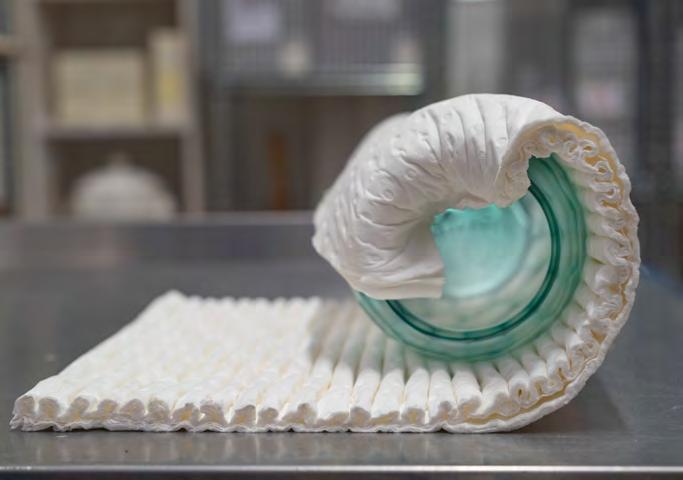
Product overview. It is a unique multi-ply corrugated material made entirely from natural fibres. Thanks to Grifal’s innovative corrugation technology, tissuePack offers a unique combination of softness, protection and sustainability, making it ideal for packaging fragile, delicate and high-value products (cosmetics, luxury accessories and industrial components), as well as food items.
Innovation. The combination of Grifal’s expertise in material research and corrugation technology has resulted in packaging that wraps and protects products with a unique balance of softness and durability. Made from a single paper-based material, tissuePack is very easy to recycle and stands out from competing solutions thanks to its exceptional resilience.
Grifal has demonstrated the quality of its corrugation technology by developing a tissue blend-an evolution of its well-known multi-ply packaging, now enhanced with liquid absorption and additional protective features.
The shock-absorbing capacity and shape memory (i.e., its ability to recover after compression) are significantly greater than those of most conventional packaging materials, whether paper- or plastic-based. The added ability to absorb liquids introduces a “premium feature” that clearly sets the product apart in industries such as food and pharmaceuticals. Its pleasing aesthetics, tactile quality, and endless printing and customisation options make it a truly standout packaging solution.
Materials used. White recyclable tissue paper (100% natural fibres). Recycled and recyclable Kraft paper in a natural Havana colour.
Applied technologies and benefits. Grifal’s corrugation technology - unique in the packaging industry - produces a material that offers exceptional product protection while remaining highly flexible and easy to recycle. The wave structure created ensures that the
material consistently returns to its original shape after impact, providing continuous and reliable shock absorption.
This technology allows for significant raw material savings compared to traditional solid panels or corrugated materials. The secret lies in the shape of the wave, parabolic arcs instead of traditional sine waves, precisely engineered in terms of height and pitch.
Environmental and consumer benefits. Made entirely from 100% recyclable, FSC-certified tissue paper, tissuePack simplifies separate waste collection. It can be recycled as paper according to the Aticelca 501/2023 method and is perfectly aligned with the principles of the circular economy: it returns to raw material without generating waste or harming the environment. It does not release residue or dust, preventing scratches and ensuring a flawless appearance.
In addition to providing complete protection during transport, storage and delivery of goods, it ensures the integrity of even the most delicate and high-value products. With its ability to absorb liquids and prevent stagnation, tissuePack stands out for its high performance. Ideal for protecting food, cosmetics, luxury accessories and industrial components, it effectively regulates moisture to prevent oxidation, mould and damage. This feature makes it an ideal sustainable packaging solution, also helping to extend the shelf life of fruits and vegetables and reduce waste.
Communication advantages. TissuePack is not only recyclable but also highly versatile. It fits perfectly into standard box and case formats, offering companies diversified packaging solutions. Furthermore, the ability to customise its sustainable packaging with graphics and messages through digital printing makes it an effective tool for communicating a company’s values and commitment to the environment directly on the packaging.

Unicoop Fi, Coopbox (Gruppo Happy)
www.coopfirenze.it - www.gruppo-happy.it/coopbox
Cos’è. Direct è un vassoio drenante senza pad assorbente, in grado di assorbire l’essudato emesso dalla carne o dal pesce, evitandone così il contatto diretto per una migliore conservazione delle caratteristiche organolettiche e una migliore presentazione sul punto vendita. Il nuovo Direct in XPS assicura la sicurezza e la funzionalità di sempre, e oggi è ancora più sostenibile e riciclabile.
Innovazione. È monomateriale, il più leggero in assoluto a parità di applicazione. Realizzato in polistirene espanso estruso (contenente riciclato post consumo food contact), grazie alla struttura espansa è particolarmente rigido e resistente per il confezionamento stretch o MAP.
Materiali utilizzati. Polistirene, talco, espandente che, attraverso un processo di estrusione specifico, si espande in una struttura composita a nido d’ape capace di assorbire l’essudato degli alimenti. Si ottiene così un vassoio leggerissimo, prestazionale e sostenibile grazie al ridottissimo impiego di materia prima.
Tecnologie applicate e vantaggi. Lo specifico processo di estrusione permette di ottenere una struttura monomateriale composita a nido d’ape, con celle chiuse all’esterno e celle aperte all’interno. Il vassoio ottenuto dopo la termoformatura, leggero e resistente, è idoneo al confezionamento stretch, BDF® e top seal. Il vassoio assorbe l’essudato emesso dagli alimenti senza l’utilizzo di pad assorbente, necessario invece per vaschette in PP o APET, che complica la fase della selezione e del riciclo.
Product overview. Direct is an absorbent tray without a pad, which can absorb the exudate emitted by meat or fish, thus avoiding direct contact for better preservation of organoleptic characteristics and better presentation at the point of sale. New Direct in XPS: safety and functionality as always, now even more sustainable and recyclable.
Innovation. It is mono-material, the lightest ever for the same application. Made of extruded expanded polystyrene (containing recycled post-consumer food contact), making it particularly rigid and durable for stretch or MAP packaging.
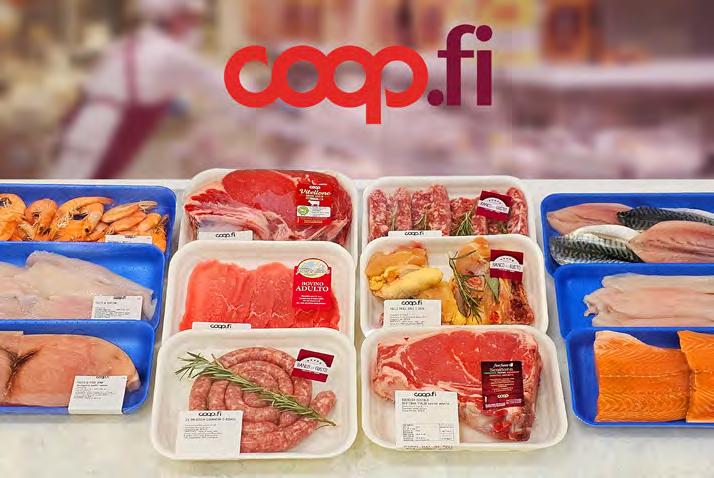
Benefici per ambiente e consumatori. Il ridottissimo utilizzo di materia prima, grazie al processo di espansione e alla sua parziale sostituzione con una percentuale di materia prima seconda, ne riduce drasticamente l’impatto rispetto a vassoi analoghi in r-APET con pad assorbente; in termini di GWP, la riduzione è -36%.
Oltre alla leggerezza del vassoio, la funzione drenante mantiene l’alimento separato dall’essudato, preservandone le qualità organolettiche. Lo smaltimento è semplificato nella raccolta della plastica, il che semplifica la gestione per i consumatori e incentiva la filiera del riciclo del polistirene.
Materials used. Polystyrene, talc, an expanding agent that, through a specific extrusion process, expands into a composite honeycomb structure capable of absorbing food exudate. This results in a very light, high-performance and sustainable tray due to the very low use of raw material.
Applied technologies and benefits. The specific extrusion process results in a composite mono-material honeycomb structure, with closed cells on the outside and open cells on the inside. The light and strong tray obtained after thermoforming is suitable for stretch, BDF® and top seal packaging. The tray absorbs the exudate
Plus di comunicazione. UNICOOP FI rafforza il dialogo con i propri soci/clienti attraverso materiali dedicati, fornendo informazioni chiare sull’impegno verso soluzioni di packaging sicure, funzionali e sostenibili, facilitando scelte consapevoli e comportamenti eco-friendly.
emitted by food without the use of an absorbent pad, which is necessary for PP or APET trays, complicating the sorting and recycling stage.
Environmental and consumer benefits. The very low use of raw materials due to the expansion process and its partial replacement with a percentage of secondary raw material, drastically reduces its impact compared with similar trays made of r-APET with absorbent pad; in terms of GWP, the reduction is -36%. In addition to the lightness of the tray, the draining function keeps the food separated from the exudate, preserving its organoleptic qualities. Disposal is
simplified in the collection of plastics, making it easier for consumers, and incentivizes the polystyrene recycling supply chain.
Communication advantages. UNICOOP FI strengthens its dialogue with its members/ customers through dedicated materials, providing clear information about its commitment to safe, functional and sustainable packaging solutions, facilitating informed choices and eco-friendly behaviour.

Cos’è. Bag-Box-Drawer è una bag a uso retail per il “mondo sneakers”, che si trasforma in cassettiera per tenere in ordine la collezione di scarpe. Doppio vantaggio per la marca: visibilità e valorizzazione del prodotto e spendibilità del messaggio. Infatti, come recita il claim coniato dall’azienda, “Second life is an opportunity not a problem!”.
Innovazione. Il cuore del progetto è l’ibridazione di due funzioni per ottenere un vantaggio funzionale diretto e un vantaggio green indiretto con l’uso di soluzioni cartotecniche consolidate, ma in modalità estremamente innovativa.
Materiali utilizzati. Cartone microonda con copertine Kraft ad alta resistenza e ottima durabilità ma a basso costo, quindi più sostenibile anche in termini commerciali.
Tecnologie applicate e vantaggi. Si tratta di un semplicissimo fustellato cartotecnico, il cui valore aggiunto dipende dall’uso prettamente “marketing oriented” della stampa a dato variabile della HP C550 single pass. La molteplicità dei soggetti grafici valorizza la customizzazione e rende unico ogni progetto di marca.
Avendo sviluppato da tempo soluzioni di second life nel mondo packaging ed essendo circondati da molti mock-up, è bastato aggiungere dei manici a strappo a uno di essi ed il gioco era fatto.
Inoltre, sono molte le testimonianze di soluzioni innovative ma spesso costose e non replicabili in alte tirature in ambito “bags”. Questo progetto si propone di essere disponibile in molti segmenti di mercato (alimentare, fashion, HBC, digitale...) e può costituire un punto di partenza per il collezionismo.
Benefici per ambiente e consumatori. Il cartone è di per sé il miglior amico dell’ambiente e non essendo plastificato può rientrare nel flusso del riciclo senza alcuna inefficienza. Gli inchiostri a base acqua garantiscono il massimo rispetto dell’ambiente a fine vita. Ma prima di tutto c’è il concetto di “second life” che prolunga il tempo di utilizzo e rimanda il riciclo a fine vita della cassettiera.
Il consumatore può disporre di un mini arredo di grande utilità, soprattutto per gli appassionati di scarpe sneakers, ma la soluzione può essere ampliata a svariati ambiti merceologici.
Plus di comunicazione. L’ottima visibilità offerta da Bag-Box-Drawer è facilmente spendibile sia instore che sui canali social. Forma e funzione sono a disposizione dei clienti per consolidare le policy di fidelizzazione. Il messaggio del brand è veicolato sia in modo diretto (funzione e second life), sia in modo grafico sul packaging stesso, sia sui canali social per creare campagne a tema: intuitivo per il cliente, grande comunicatore, vantaggioso per pianeta perché non diventa subito rifiuto sebbene sia riciclabile, ma soprattutto utile.
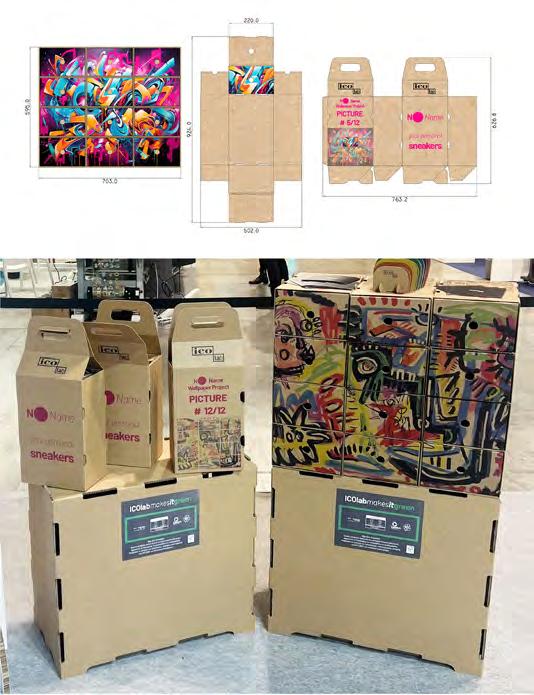
Product overview. Bag-Box-Drawer is a retail-use bag for the “sneaker world,” which doubles as a dresser to keep the shoe collection in order. A double benefit for the brand: visibility and enhancement of the product, and expendability of the message. Indeed, as the claim coined by the company states, “Second life is an opportunity not a problem!”.
Innovation. The heart of the project is the hybridization of two functions to achieve a direct functional benefit and an indirect green benefit with the use of established papermaking solutions, but in a highly innovative fashion.
Materials used. Micro flute corrugated cardboard with Kraft covers with high strength and excellent durability but at a low cost to allow the unit cost to be sustainable in commercial terms as well.
Applied technologies and benefits. It is a very simple papermaking die cut, the added value of which depends on the purely “marketingoriented” use of the variable-data printing of the HP C550 single pass.
The multiplicity of graphic subjects enhances customization and makes each brand project unique.
Having long since developed second-life solutions in the packaging world and being surrounded by many mock-ups, all it took was to add tear-off handles to one of them and it was done.
In addition, there are many accounts of innovative but often expensive solutions that cannot be replicated in high runs in the “bags” arena. This project aims to be available in many market segments (food, fashion, HBC, digital...) and can be a starting point for collecting.
Environmental and consumer benefits. Cardboard itself is the environment’s best friend, and since it is not plasticized it can re-enter the recycling cycle without any inefficiency. Water-based inks ensure maximum environmental friendliness at end-of-life. But most of all, there is the “second life” that extends the lifespan and postpones recycling to the end of the chest of drawers’ life.
The consumer can have a very useful piece of mini-furniture, especially for sneaker fans, but the solution can be extended to a variety of merchandise areas.
Communication advantages. The excellent visibility offered by Bag-Box-Drawer is easily exploitable both instore and on social channels. Form and function are available to customers to consolidate loyalty policies. The brand message is conveyed both directly (function and second-life), graphically on the packaging itself, and on social channels to create themed campaigns: intuitive for the customer, a great communicator, beneficial for the planet because it does not immediately become waste although it is recyclable, but most of all useful.



ALline E - Sistema lineare per applicazione di due etichette fronte/retro su prodotti rettangolari o ellittici.
• Gestione integrata tramite PLC, con industry 4.0, e assistenza remota.
• Interfaccia touch screen su pannello girevole, con memoria per 100 ricette di etichettatura.
• Convogliatore modulare silenzioso e sincronizzazione automatica.
• Posizionatori digitali su tutti i volantini di regolazione, con valori in ricetta consultabili da pannello comandi.
• Basamento perimetrale, con struttura di irrigidimento superiore e illuminazione interna.

Innovazione o conservazione? La direzione di queste filosofie appare opposta e inconciliabile. La prima promette prestazioni superiori, e nuove funzionalità. La seconda garantisce l’affidabilità e la praticità tipica delle soluzioni collaudate.
Noi di ALtech ci siamo impegnati affinchè innovazione e conservazione convivano nelle nostre etichettatrici. Ognuna di esse contiene le tecnologie più innovative, ma allo stesso tempo è il risultato degli affinamenti progettuali maturati grazie ai 30.000 collaudi effettuati fino ad oggi: un bagaglio tecnico che ci consente di affermare che ogni etichettatrice che offriamo non è solo all’avanguardia, ma è anche pratica, funzionale e affidabile.
Un esempio? il nostro sistema ALline E.
ALTECH Srl
Viale de Gasperi, 70
20008 Bareggio (MI) - Italy
Tel. +39 02 90363464
info@altech.it
www.altech.it

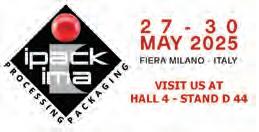


Cos’è. La maniglia Eco Easy Lift è una soluzione innovativa per il trasporto di fardelli pesanti in vari settori, tra cui alimentare e logistico. Offre maggiore resistenza all’umidità e un’ergonomia migliorata, rendendo il trasporto più sicuro e confortevole in ogni situazione. Presa comoda e la elevata riciclabilità rispondono alle esigenze di comfort, maneggevolezza e praticità di smaltimento richieste dal consumatore.
Innovazione. Eco Easy Lift unisce funzionalità ed eco-sostenibilità: ergonomica, monomateriale e resistente all’umidità. Realizzata con materiali certificati ISCC+, riduce l’impatto ambientale. La maggiore area di stampa migliora la comunicazione, mentre il design ottimizza trasporto, comfort e sicurezza.
Materiali utilizzati. Tutti ad alte prestazioni e sostenibili: BOPP, resistente e leggero, con tecnologia LISIM, certificato ISCC+, riduce lo spessore e l’uso di materie prime vergini; TNT (tessuto non tessuto) in PP migliora l’ergonomia e resiste all’umidità; adesivi hot-melt/acrilici solvent-free, garantiscono adesione sicura e duratura.
Tecnologie applicate e vantaggi. Oltre alla tecnologia LISIM, per ridurre lo spessore del film BOPP rispetto allo standard mantenendo inalterate le prestazioni, Irplast ha adottato processi di stampa flessografica e rotocalco nonché applicazione di adesivo mediante tecnologia proprietaria. La soluzione è applicabile su tutte le macchine manigliatrici.
La sostituzione della carta con TNT in PP crea una maniglia monomateriale riciclabile con il fardello e offre una presa comoda, ideale per carichi pesanti. Migliorate l’ergonomia e la resistenza all’umidità, con una riduzione del 20% della grammatura.
Ideale per aziende del beverage e della logistica che cercano packaging sostenibili ed ergonomici, ha il potenziale per essere adottato su larga scala grazie a normative ambientali favorevoli, inclusa la PPWR, e alla domanda crescente di soluzioni ecologiche.
Benefici per ambiente e consumatori. La maniglia Eco Easy Lift consente una riduzione di materia prima vergine grazie all’uso di film BOPP e adesivo certificati ISCC+, provenienti da fonti rinnovabili o da riciclo chimico, riducendo notevolmente l’impronta ecologica. Essendo monomateriale, la maniglia è riciclabile insieme alla plastica, semplificandone la gestione. L’ampia superficie di stampa rende più efficace la comunicazione al consumatore.
Plus di comunicazione. Eco Easy Lift significa funzionalità, sostenibilità e comunicazione in un’unica maniglia. Grazie alla maggiore superficie stampabile, si possono trasmettere valori, messaggi di brand e persino integrare un QR code per coinvolgere i consumatori in modo innovativo e diretto.

Product overview. The Eco Easy Lift handle is an innovative solution for transporting heavy loads in various industries, including food and logistics. It offers increased moisture resistance and improved ergonomics, making it safer and more comfortable to carry in any situation. Comfortable grip and high recyclability meet the needs for comfort, manageability, and convenience of disposal demanded by consumers.
Innovation. Eco Easy Lift combines functionality and eco-sustainability: ergonomic, mono-material, and moistureresistant. Made from ISCC+ certified materials, it reduces environmental impact. The larger print area improves communication, while the design optimises transport, comfort and safety.
Materials used. All high-performance and sustainable: BOPP, durable and lightweight, with LISIM technology, ISCC+ certified, reduces thickness and use of virgin raw materials; TNT (non-woven fabric) made of PP improves ergonomics and resists moisture; solvent-free hot-melt/acrylic adhesives ensure secure and durable adhesion.
Applied technologies and benefits. In addition to LISIM technology, to reduce the thickness of the BOPP film compared to the standard while maintaining performance, Irplast has adopted flexographic and gravure printing processes as well as adhesive
application through proprietary technology. The solution is applicable on all handle applying machines.
Replacing paper with PP TNT creates a single-material handle recyclable together with the load and provides a comfortable grip, ideal for heavy loads. Improved ergonomics and moisture resistance with a 20% reduction in weight.
Ideal for beverage and logistics companies seeking sustainable and ergonomic packaging, it has potential for large-scale adoption due to favourable environmental regulations, including PPWR, and growing demand for environmentally friendly solutions.
Environmental and consumer benefits. The Eco Easy Lift handle enables a reduction in virgin raw material through the use of ISCC+ certified BOPP film and adhesive from renewable sources or chemical recycling, greatly reducing the carbon footprint. Because it is mono-material, the handle is recyclable along with the plastic, simplifying its management.
The large print area makes consumer communication more effective.
Communication advantages. Eco Easy Lift means functionality, sustainability and communication in one handle. With the larger printable area, values, brand messages and even a QR code can be conveyed to engage consumers in an innovative and direct way.
Cos’è. Il prodotto punta a sostituire il BOPET nel lidding per packaging alimentare. Irplast intende fornire ai produttori un film monomateriale, completamente riciclabile, certificato ISCC, ermetico e termostabile, in grado di garantire alte prestazioni senza modifiche di processo: la soluzione nella transizione verso il packaging circolare e sostenibile.
Innovazione. Il packaging finale risulta completamente in polipropilene e quindi riciclabile. A questo si aggiunge la riduzione di materia prima vergine utilizzata, in virtù della certificazione ISCC PLUS da fonti rinnovabili o da riciclo chimico dei film impiegati.
Materiali utilizzati. Si sfruttano resine bio-based ISCC. Come fonti rinnovabili si intendono oli vegetali provenienti da scarti di lavorazione di altri processi produttivi. Da riciclo chimico si intende il pyroil, che sfrutta la pirolisi e permette di ottenere un polimero con le stesse caratteristiche di quello vergine.
Tecnologie applicate e vantaggi. Si sfrutta la tecnologia LISIM (estrusione a stiro simultaneo), che consente un alto grado di personalizzazione delle caratteristiche tecniche e dello spessore. La tecnologia garantisce il mantenimento della shape nelle stesse condizioni di processo senza modificare i macchinari in uso
Benefici per ambiente e consumatori. Il prodotto punta alla monomaterialità per migliorare la riciclabilità in funzione del PPWR e i materiali utilizzati permettono una riduzione importante nell’impronta carbonica in virtù della certificazione ISCC.
MonoMaterial Lidding si presta a essere applicato su vaschette destinate a vari settori merceologici, ove sia necessario mantenere le caratteristiche del prodotto migliorandone lo shelf-appeal, con un ottimo impatto visivo.
Plus di comunicazione. Uno degli obiettivi è quello di trasmettere al consumatore messaggi chiari e incisivi. Il prodotto proposto, con la sua ampia area di stampa, permette alle aziende di inserire vari messaggi promozio-
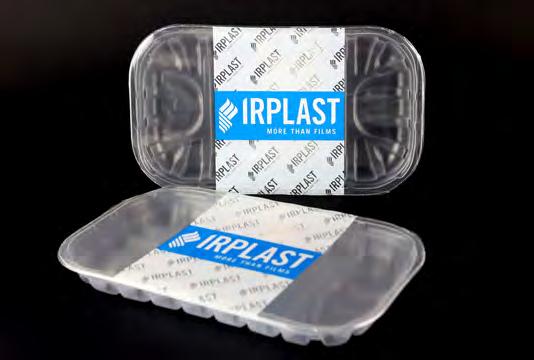
Product overview. The product is designed to replace BOPET in food packaging lids. Irplast offers manufacturers a mono-material, fully recyclable, ISCC-certified film that ensures a hermetic seal and excellent heat resistance. Delivering high performance without requiring changes to existing production processes, it is an effective solution for the transition to circular and sustainable packaging.
Innovation. The final packaging is made entirely of polypropylene, making it fully recyclable. In addition, the use of ISCC PLUS-certified films - sourced from renewable materials or through chemical recycling - reduces reliance on virgin raw materials.
Materials used. The product is made using ISCC-certified bio-based resins. These renewable sources include vegetable oils derived as by-products from other production processes. Chemical recycling involves pyroil, a process based on pyrolysis that makes it possible to produce polymers with properties equivalent to those of virgin plastic.

is manufactured using LISIM (simultaneous stretching line) technology, which allows for a high level of customisation in both technical properties and thickness. The technology ensures shape retention under existing process conditions, eliminating the need for changes to the machinery in use.
Environmental and consumer benefits. The product features a mono-material structure to improve recyclability in accordance with the Packaging and Packaging Waste Regulation (PPWR), while the use of ISCC-certified materials significantly reduces the carbon footprint.
MonoMaterial Lidding is suitable for use on trays across various sectors, where it is necessary to preserve product characteristics while enhancing shelf appeal through excellent visual impact.
Communication advantages. One of the key objectives is to convey clear and impactful messages to the consumer. Thanks to its large printing surface, the product offers ample space for companies to include promotional content such as slogans, logos



Cos’è. La clip fascetta è leggera, resistente e realizzata in polipropilene 100% riciclabile. La sua funzione principale è prevenire lo sversamento del prodotto, impedendo l’apertura accidentale del coperchio durante il trasporto, garantendo così una chiusura sicura e affidabile. E come recita il claim del prodotto, “la sicurezza in un gesto: clic e via!”.
Innovazione. Clip fascetta garantisce la chiusura sicura del coperchio durante il trasporto, evitando l’apertura accidentale e fungendo da sigillo di garanzia. Viene eliminato l’uso del nastro adesivo richiesto dalle piattaforme online per la spedizione, valorizzando il prodotto. È compatibile con qualsiasi contenitore in plastica dotato di fascione, oltre ad adattarsi alle loro diverse forme. Al momento dell’acquisto, viene fornito un unico codice prodotto, semplificane la gestione. Grazie alla versatilità e ai benefici ambientali, ha un grande potenziale per essere adottata su larga scala nel mercato, rispondendo alle crescenti esigenze di sostenibilità e sicurezza nei trasporti.
Materiali utilizzati. Polipropilene 100% riciclabile.
Tecnologie applicate e vantaggi. La clip fascetta è realizzata tramite stampaggio a iniezione, un processo che consente di ottenere un prodotto di alta qualità, leggero e resistente. Funzionale anche come sigillo di garanzia, supera le soluzioni tradizionali offrendo prestazioni superiori in termini di sicurezza e protezione del prodotto, con un impatto ambientale ridotto grazie al materiale 100% riciclabile.
Benefici per ambiente e consumatori. I vantaggi ambientali della clip fascetta derivano dall’utilizzo di materiale 100% riciclabile e dalla sicurezza della chiusura, che previene lo sversamento del prodotto nell’ambiente. Questo contribuisce a ridurre i rischi di inquinamento, promuovendo un impatto ecologico positivo e rendendo il packaging più sostenibile e rispettoso dell’ambiente. Al consumatore viene garantita la qualità e l’integrità del prodotto durante il trasporto, evitando danni e preservando il contenuto fino al momento dell’apertura.
Plus di comunicazione. Clip fascetta nasce in risposta all’esigenza delle piattaforme online, dove i contenitori vengono tradizionalmente chiusi con nastro adesivo per la spedizione e per evitare perdite accidentali durante il trasporto. Con questa soluzione, il contenitore risulta più accattivante, valorizzando così il contenuto e garantendo al contempo una spedizione sicura e protetta per ogni singolo prodotto. Può essere utilizzata in diversi settori, adattandosi a qualsiasi prodotto che richieda la chiusura o l’unione di due parti separate. Migliorato anche il dialogo con il consumatore: grazie al design elegante e funzionale, valorizza il prodotto all’interno del packaging, offrendo una prima impressione positiva e un’esperienza di unboxing che sottolinea l’attenzione alla qualità e alla cura nei dettagli.

Product overview. The clip band is lightweight, durable and made entirely of recyclable polypropylene. Its main function is to prevent product spillage by preventing accidental opening of the lid during transport, thus ensuring a safe and reliable closure. As the product tagline says: “Safety in a single gesture: click and go!”
Innovation. The clip band ensures a secure closure of the lid during transport, preventing accidental opening and acting as a warranty seal. It eliminates the need for adhesive tape typically required by online platforms for shipping, adding value to the product. It is compatible with any plastic container with a rim, adapting easily to different shapes and sizes. A unique product code is provided at the time of purchase, simplifying its management. Thanks to its versatility and eco-friendly benefits, the clip band has great potential for large-scale market adoption, meeting the growing demand for sustainable and safe transportation.
Materials used. 100% recyclable polypropylene.
Applied technologies and benefits. The clip band is produced using injection moulding, a process that yields a high-quality, lightweight and durable product. It also functions as a warranty seal, outperforming traditional solutions by offering enhanced safety and protection, while reducing environmental
impact due to its 100% recyclable material.
Environmental and consumer benefits. The clip band offers clear environmental benefits through its use of 100% recyclable material and a secure closure system that prevents product leakage into the environment. This helps reduce risks of pollution, promoting a positive ecological impact and contributing to more sustainable and environmentally friendly packaging. Consumers are assured of the product’s quality and integrity during transport, with damage prevented and contents preserved until the moment of opening.
Communication advantages. The clip band was developed to address the needs of online platforms, where containers are typically sealed with tape to prevent accidental leakage during transport. This innovative solution not only ensures safe and secure shipping of each individual product, but also enhances the appearance of the container, making the product more visually appealing. It is versatile and can be used across a wide range of applications, adapting to any product that requires two separate parts to be joined or securely closed. It also improves communication with the consumer: its sleek and functional design elevates the product’s presentation within the packaging, creating a strong first impression and an unboxing experience that highlights the brand’s attention to quality and detail.


IMA E-COMMERCE’S FLEXIBLE PACKAGING EQUIPMENT IS DESIGNED FOR E-FULFILLMENT, INTRALOGISTICS, AND 3PL
Discover the E-CO Flex family of machines: our range of automated packing stations , case lidders, and height reduction case closers is designed to improve your daily throughput. case formers, Visit us at IPACK-IM A 2025 MILAN, ITALY • 27-3 0 May • Hal l 5, Booth B47-C48
sales.ecommerce@ima.it
ima.it/e-commerce

www.fattorieosella.it - https://istitutostampa.it
Cos’è. Il nuovo packaging della robiola Osella è una struttura monomateriale in carta riciclabile, più leggera e sostenibile. Grazie a una speciale vernice, risulta adatta all’ambiente umido e mantiene la piega nel confezionamento. Conserva le prestazioni di shelf-life e sicurezza alimentare, riducendo l’impatto ambientale. Il packaging garantisce funzioni eccellenti grazie alla equilibrata integrazione tra la semplicità del supporto in carta e la ricerca tecnologica innovativa.
Innovazione. Il nuovo incarto sostituisce la struttura multistrato in alluminio, carta e plastica con una soluzione monomateriale in carta riciclabile. Il peso ridotto del 24% e la certificazione Aticelca ne potenziano la sostenibilità. Da ricordare che le soluzioni attualmente sul mercato non sono riciclabili, sono generalmente più costose e spesso, per raggiungere pari vita commerciale del prodotto, è necessaria l’aggiunta dei conservanti, cosa che non avviene nella Robiola Osella.
Materiali utilizzati. Con la scelta di tornare alla carta, abbandonando il complesso multistrato, è stata riscoperta la semplicità. Questo ritorno essenziale garantisce le stesse performance di conservazione grazie a una speciale vernice che assicura un’ottima resistenza all’umidità. Inoltre, l’incarto è riciclabile nella carta, rendendo il packaging più sostenibile rispetto al precedente, destinato invece alla raccolta indifferenziata (termovalorizzazione).
Tecnologie applicate e vantaggi. Scelta della carta, vernice di sovrastampa, stampa flessografica, adattamento alla macchina confezionatrice: l’innovazione distintiva è l’uso di una carta senza barriera specifica per un formaggio fresco che si presenta in un ambiente umido. Questa carta risulta adatta sia all’ambiente della vaschetta che alla linea di confezionamento. Un’inedita soluzione per il mercato, che unisce semplicità, funzionalità e sostenibilità.
Il nuovo packaging resistente all’umido può essere utilizzato anche per altri prodotti che necessitano di una protezione simile. Questa innovazione apre nuove possibilità nel settore, offrendo una soluzione sostenibile senza compromettere funzionalità e prestazioni. Il nuovo packaging infatti risulta più performante sulla linea produttiva standard.
Benefici per ambiente e consumatori. Il nuovo packaging in carta riciclabile riduce l’impatto ambientale rispetto alla precedente struttura multistrato. La Carbon Footprint evidenzia una significativa riduzione delle emissioni di CO₂ per m² di prodotto, passando da 0,206 kg CO₂eq a 0,122 kg CO₂eq, con un risparmio del 41%. Inoltre, la struttura più leggera contribuisce ulteriormente alla sostenibilità complessiva del packaging. Il nuovo packaging offre al consumatore un’esperienza più sostenibile senza rinunciare alla qualità. Essendo completamente riciclabile nella carta, semplifica lo smaltimento e riduce l’impatto ambientale. La minore impronta di CO₂ contribuisce a un consumo più responsabile, mentre la speciale

vernice garantisce la stessa protezione e freschezza della robiola. Innovazione e praticità si uniscono, permettendo di scegliere un prodotto che coniuga qualità e rispetto per l’ambiente.
Plus di comunicazione. Per un formaggio di elevata qualità, Fattorie Osella voleva un incarto completamente riciclabile che mantenesse le caratteristiche sensoriali uniche della Robiola Osella per tutta la vita del prodotto.
Dopo diversi tentativi in varie direzioni è giunta a questa soluzione che presenta tutte le caratteristiche volute.
Tutta la gamma Robiola di Osella è passata a questo incarto, una scelta che mira a rafforzare il legame con i consumatori abituali offrendo loro un prodotto più responsabile, e ad attrarne di nuovi, uniti dal desiderio di sostenere insieme un futuro più sostenibile. Con la scritta “Riciclami, sono di carta” sul packaging il consumatore finale non avrà dubbi su dove buttare il materiale.
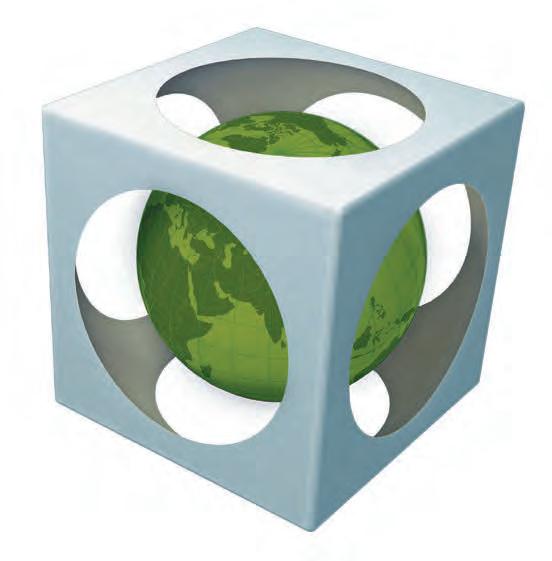




Product overview. The new packaging for La Robiola Osella is a mono-material structure made of recyclable paper, offering a lighter more sustainable solution. Thanks to a special varnish, it performs well in humid environments and maintains its fold during packing. It preserves shelf-life and ensures food safety while reducing environmental impact. This packaging combines the simplicity of paper with advanced technological innovation, delivering both functionality and sustainability.
Innovation. The new packaging replaces the multilayer structure - composed of aluminium, paper and plastic - with a mono-material solution made of recyclable paper. Its weight is reduced by 24%, and it is Aticelca-certified to further enhance sustainability. It’s worth noting that other solutions currently on the market are typically non-recyclable, more expensive, and often require added preservatives to achieve a comparable shelf life, something that La Robiola Osella does not require.
Materials used. The decision to return to paper and move away from complex multilayer materials marks a rediscovery of simplicity. This essential shift maintains the same preservation performance, thanks to a special varnish that provides excellent moisture resistance. Moreover, the new packaging is recyclable as paper, offering a far more sustainable alternative to the previous version, which was destined for undifferentiated waste collection (waste-to-energy).
Applied technologies and benefits. From paper selection and overprinting varnish to flexographic printing and adaptation to the packaging machine, every step reflects targeted innovation. The standout feature is the use of barrier-free paper, specifically developed for fresh cheese packaged in a humid environment. This paper is adaptable to both the tray environment and the packaging line. A brand-new solution for the market that combines simplicity, functionality and sustainability. The new moisture-resistant packaging is also suitable for other products requiring similar protection. This innovation opens up new possibilities in the industry by offering a sustainable solution that doesn’t compromise on functionality or performance. In fact, the new packaging delivers even better results on standard production lines.
Environmental and consumer benefits. The new recyclable paper packaging reduces environmental impact compared to the previous multilayer structure.
Carbon Footprint analysis shows a notable reduction in CO₂ emissions per square metre of product-from 0.206 kg CO₂eq to 0.122 kg CO₂eq-representing a 41% decrease. In addition, the lighter structure further enhances the overall sustainability of the packaging.
Consumers benefit from a more environmentally friendly experience without any compromise on quality. Fully recyclable as paper, the new packaging simplifies disposal and contributes to a reduced environmental footprint. The reduced CO₂ footprint promotes more responsible consumption, while the special coating guarantees the same level of protection and freshness for the Robiola. Innovation and practicality come together, offering a product that combines high quality with environmental responsibility.
Communication advantages. For a high-quality cheese like La Robiola Osella, Fattorie Osella sought a fully recyclable wrapper that could preserve the product’s unique sensory qualities throughout its shelf life.
After exploring various options, the company arrived at this solution, which successfully meets all the desired requirements.
Osella’s entire Robiola range has adopted this new packaging, a choice aimed at strengthening loyalty among existing consumers by offering a more responsible product, while also appealing to new customers, who share the commitment to a more sustainable future. With the message “Recycle Me, I’m Paper” printed on the packaging, consumers can easily identify how to dispose of it correctlyremoving any doubt.



www.granterre.it - https://istitutostampa.it
Cos’è. “Snack&Vai rivoluziona il suo packaging: zero plastica, solo carta!”: la nuova confezione è composta da carta certificata FSC più leggera rispetto allo standard e verniciata con saldante a freddo. Resistente, funzionale e ottimizzato per vending e scaffali, il packaging riduce l’impatto ambientale senza compromettere la protezione del prodotto e risulta ideale come incarto secondario in imballaggi multipli.
Innovazione. È stata introdotta la tecnologia di saldatura a freddo, eliminando la plastica e la necessità di calore per il confezionamento. La nuova struttura permette un risparmio energetico e un’ottimizzazione della logistica. Migliorata anche la riciclabilità, passando da livello Aticelca B ad Aticelca A.
L’obiettivo di GranTerre è estendere l’utilizzo del nuovo packaging all’intera gamma Snack&Vai: un impegno che conferma la volontà dell’azienda di ridurre l’impatto ambientale e offrire ai consumatori soluzioni sempre più innovative e responsabili. Il miglior grado di riciclabilità ottenuto ha permesso di aggiornare, all’interno del box ambientale, l’indicazione del materiale in PAP22.
Materiali utilizzati. Il progetto nasce dall’esigenza di sviluppare un incarto ancor più sostenibile, in grado di fornire una chiusura efficiente e garantire la protezione dei prodotti confezionati. Per questo è stata scelta una struttura in carta plain certificata FSC, con l’aggiunta di una vernice saldante che permette la chiusura senza necessità di plastica o calore. La riduzione della carta da 60 g/m2 a 50 g/m2 assicura la resistenza necessaria a sorreggere il peso dei prodotti contenuti, garantendo al tempo stesso il funzionamento sulla macchina confezionatrice nonché la riduzione complessiva dei materiali utilizzati e una migliorata riciclabilità.
Tecnologie applicate e vantaggi. La carta nuda viene laccata con vernice saldante a freddo a registro. La confezionatrice è una flowpack orizzontale e la saldatura avviene per sola pressione meccanica, senza utilizzo di calore. Il ricorso (innovativo) alla tecnologia di saldatura a freddo, tipicamente diffusa in altri settori come il dolciario, ha permesso di eliminare definitivamente la plastica. Inoltre, ha contribuito a ottimizzare la logistica, grazie a una maggiore saturazione dei pallet a fronte di una riduzione dei costi energetici in produzione.
Benefici per ambiente e consumatori. Il nuovo packaging di Snack&Vai è riciclabile in livello Aticelca A. Con una riduzione del peso della confezione del 22%, diminuisce l’impatto ambientale. Inoltre, ottimizza le fasi logistiche da Istituto Stampa agli stabilimenti di Granterre, aumentando la saturazione dei bancali del 28,7%. Il passaggio da un incarto accoppiato carta/plastica a sola carta rende inoltre più facile e intuitivo il conferimento nella raccolta differenziata da parte del consumatore.
Plus di comunicazione. La soluzione adottata posiziona Snack&Vai come un brand all’avanguardia, in grado di combinare performance, responsabilità ambientale e innovazione tecnologica, rafforzando la fiducia dei consumatori e creando nuove opportunità di mercato. Un chiaro vantaggio competitivo per entrambe le aziende coinvolte nel progetto, che dimostrano un impegno concreto in sostenibilità, rispondendo alle crescenti esigenze dei consumatori e delle normative ambientali.
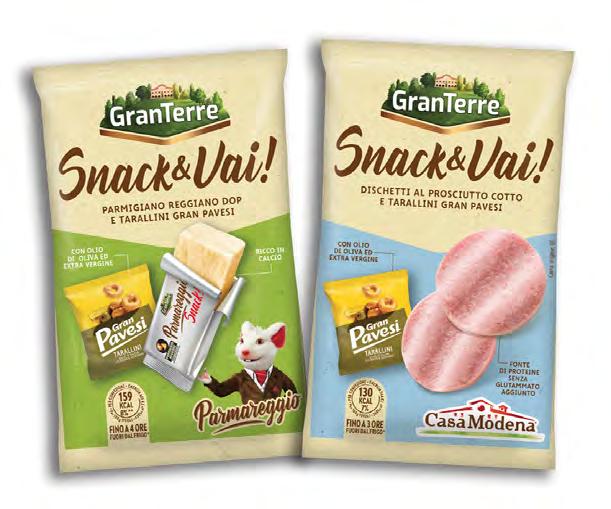
Product overview. “Snack&Vai revolutionises its packaging: zero plastic, all paper!” The new packaging is made of FSC-certified paper that is lighter than standard paper and a cold-seal coating. Durable, practical and optimised for both vending machines and store shelves, this packaging reduces environmental impact without compromising on product protection. It’s also perfect as secondary packaging for multi-packs.
Innovation. Snack&Vai has introduced cold-seal technology, eliminating the need for plastic and heat during packaging. The new structure allows for energy savings and more efficient logistics. Recyclability has also been improved, moving from Aticelca Level B to Level A. GranTerre aims to roll out this new packaging across the entire Snack&Vai range - an ambitious step that underscores the company’s commitment to reducing environmental impact while offering consumers increasingly innovative and responsible solutions. Thanks to the improved recyclability, the material classification inside the environmental box has been updated to PAP22.
Materials used. The project was born from the need to develop a more sustainable wrapper - one that ensures secure sealing and protects the contents effectively. To achieve this, a plain FSC-certified paper was chosen and treated with a special cold-seal coating that allows it to seal without the use of plastic or heat. Reducing the paper from 60 g/m2 to 50 g/m2 maintains the strength needed to support the weight of the contents, while ensuring smooth operation on packaging machines. This change also results in less material usage and improved recyclability.
Applied technologies and benefits. The plain paper is coated with a cold-seal lacquer, applied in register.
Packaging is carried out using a horizontal flowpack machine, where sealing is achieved through mechanical pressure alone, without the use of heat. The innovative use of cold-sealing technology, typically used in other industries such as confectionery, has made it possible to eliminate plastic entirely. It has also contributed to logistics optimisation by increasing pallet saturation while reducing energy costs during production.
Environmental and consumer benefits. Snack&Vai’s new packaging is recyclable at Aticelca A level, and features a 22% reduction in weight - helping to lower environmental impact. Logistics are also more efficient, with a 28.7% increase in pallet saturation during transport from Istituto Stampa to Granterre’s facilities. By replacing the previous paper/plastic laminated wrapper with a paper-only solution, the packaging is now easier and more intuitive for consumers to dispose of correctly through separate waste collection.
Communication advantages. The new packaging solution positions Snack&Vai as a forward-thinking brand that combines high performance with environmental responsibility and technological innovation, strengthening consumer trust and opening up new market opportunities. It also provides a clear competitive edge for both companies involved in the project, showcasing their genuine commitment to sustainability and their ability to meet the growing demands of consumers and environmental regulations.

www.lindt.it - caffarel.com
Cos’è. Pensata e realizzata per coprire il segmento del gifting, la gamma di confezioni Caffarel si articola in “Gianduia 1865 l’autentico Gianduiotto di Torino” (icona di Caffarel), “I Grandi Classici”, “Cremì e Delizie d’Italia”. Ciascuna linea gode di un assortimento specifico, coprendo diverse occasioni d’acquisto. La nuova confezione rientra in un progetto win-win sul piano industriale/consumer, dato che non solo ha spinto l’azienda a ottimizzare i propri processi interni volti a uniformare la gamma ma, grazie a tecniche di stampa specifiche, ha contribuito ad aumentare la premiumness di Caffarel, rinnovandone l’immagine.
Innovazione. Tutto parte dalla rivisitazione grafica delle confezioni regalo nel settore food, con l’utilizzo di vernici estetiche e nobilitazioni in oro a caldo su cartoncino Natural METSA, per offrire una diversa sensazione tattile e visiva al consumatore, congiunta all’ottimizzazione industriale e alla sostenibilità.
Materiali utilizzati. Per il fondo e il coperchio delle scatole è stato utilizzato il cartoncino Natural Metsa 325 g, che garantisce alte prestazioni in macchina evitando le rotture durante la formazione. Inoltre, per simulare l’effetto di una scatola rigida, al coperchio è stato applicato un rinforzo realizzato con lo stesso cartoncino, arrivando a una grammatura totale di 650 g. Anche la fascia è prodotta con cartoncino Natural, ma di grammatura inferiore dato che non ha una funzione strutturale ma è utile a differenziare i vari assortimenti. Un vassoio in cartoncino accoppiato a un film PET oro sostituisce quello tradizionale in PET oro. Ultimo componente delle scatole è il cuscinetto a protezione dei cioccolatini, ora completamente in carta. Per la sicurezza di antimanomissione sono presenti infine un’etichetta in PP con apertura facilitata e un film termoretraibile.
Tecnologie applicate e vantaggi. Le scatole sono progettate per la produzione in linea: fondi e coperchi vengono formati automaticamente in macchina, l’inserimento delle praline avviene in modo semi-automatico e il confezionamento finale è eseguito manualmente. Il processo di stampa include sia la stampa offset che flessografica, mentre le parti di nobilitazione in oro a caldo sono prodotte con un cliché microinciso.
La standardizzazione a soli quattro formati con le medesime caratteristiche strutturali ha permesso di ridurre la complessità dell’offerta, grazie a una parziale automazione del processo produttivo, con impatto positivo sui costi e le prestazioni industriali.
Benefici per ambiente e consumatori. La sostituzione del vassoio in plastica (PET oro) con un cartoncino accoppiato a film metallizzato oro PET (<5% del peso totale del vassoio) garantisce una maggiore riciclabilità. Pensate come regalo ideale per celebrare momenti speciali, grazie al rinnovamento di design e struttura, le nuove confezioni Caffarel sono più semplici da individuare a scaffale oltre che più semplici da smaltire.
Plus di comunicazione. Oggi, una struttura unica declinata in quattro diverse grammature può coprire le diverse fasce di peso e prezzo: si combina con la fascia dorata ad hoc, realizzata con diverse tecniche di stampa e nobilitazioni in linea, che differenzia gamme e assortimenti. L’uniformità grafica per una migliore visibilità a scaffale sfrutta elementi di marca (quali la firma di Caffarel e il claim in microincisione “cioccolato e nocciole anima e cuore”), aumentando ulteriormente la premiumness del brand anche presso target più ampio di consumatori

Product overview. Caffarel’s packaging range has been designed and created to target the gifting segment, and is divided into “Gianduia 1865 - the original Gianduiotto of Turin” (Caffarel’s icon), “I Grandi Classici,” and “Cremì & Delizie d’Italia”.
Each line offers a specific assortment to suit various gifting and purchasing occasions. The new packaging is part of a WIN-WIN initiative that benefits both the company and the consumer. It allowed the company to optimise its internal processes by standardising the range, while specific printing techniques elevated the brand’s premium appeal and refreshed its image.
Innovation. It all begins with a graphic reimagining of gift packaging in the food sector. By using aesthetic paints and hot-foil gold finishing techniques on Natural METSA cardboard, Caffarel created a unique tactile and visual experience for the consumer. This is combined with industrial optimisation and sustainability.
Materials used. Natural Metsa 325 g cardboard was used for the bottom and lid of the boxes, chosen for its high mechanical performance and resistance to breakage during the forming process. In addition, to mimic the look and feel of a rigid box, a reinforcement made from the same cardboard was added to the lid, bringing the total weight to 650 g.
The band is also made from Natural cardboard, but with a lighter weight, as it serves no structural purpose. Instead, it is used to distinguish the different product assortments.
A cardboard tray laminated with a gold PET film has replaced the traditional gold PET tray. The final component of the box is the pad that protects the chocolates, now made entirely of paper.
For tamper-proof security, the packaging
includes a PP label with easy-open functionality and a shrink film seal.
Applied technologies and benefits. The boxes are designed for in-line production: the bottoms and lids are formed automatically by machine, pralines are inserted semi-automatically, and final packaging is completed manually. The printing process involves both offset and flexographic techniques, while the hot-foil stamping is applied using a micro-engraved plate for added refinement.
Standardising the packaging to just four formats with identical structural features has allowed the company to streamline the offer. This partial automation of the production process had led to greater cost efficiency and improved industrial performance.
Environmental and consumer benefits.
Replacing the plastic tray (gold PET) with a cardboard version laminated with gold metallised PET film (less than 5% of the tray’s total weight) significantly improves recyclability. Thanks to their revamped design and structure, Caffarel’s new packages are not only ideal for gifting and celebrating special moments, but also more eye-catching on the shelf and easier to dispose of.
Communication advantages. Today, a single packaging structure available in four different weights can meet a variety of weight and price requirements. This is paired with a customdesigned gold band, created using different printing techniques and in-line finishes that distinguish the various product lines and assortments. Consistent graphics throughout the range enhance shelf visibility by leveraging key brand elements (such as Caffarel’s signature and the micro-engraved claim “chocolate and hazelnuts, heart and soul”), further reinforcing the brand’s premium appeal across a broader consumer audience.

loacker.it - fraunhofer.it
Fraunhofer Italia Research Società consortile a responsabilità limitata SMARTFLEXPACK FESR 1054
Cos’è. Il progetto SMARTFLEXPACK mira a sviluppare una tecnologia di stampa dedicata, ottimizzando l’uso di inchiostri e riducendo l’impatto ambientale attraverso un framework di gemello digitale e mediante l’ausilio di un sistema di computer vision. Innovazione, sostenibilità, impatto positivo sul mercato e miglioramento della qualità delle informazioni stampate: il tutto a garanzia di sicurezza per il consumatore
Innovazione. L’uso innovativo di inchiostri sostenibili e la modellazione tramite gemello digitale ottimizzano i processi di stampa, riducendo l’uso di etichette autoadesive, migliorando sostenibilità e riciclabilità del pack. Tramite computer vision, inoltre, lo studio permette la validazione delle informazioni stampate.
Materiali utilizzati. Inchiostri a base d’acqua e UV low migration destinati a materiali di imballaggio flessibili, in sostituzione delle attuali etichette autoadesive. La semplificazione della struttura garantisce una maggiore sostenibilità del processo e una migliore riciclabilità del packaging.
Tecnologie applicate e vantaggi. Tecnologia di stampa diretta su imballaggi, gemello digitale per la simulazione e ottimizzazione del processo produttivo, computer vision con camera integrate in linea di produzione per il controllo qualità: tutto concorre a migliorare in modo significativo le caratteristiche del prodotto, apportando benefici ambientali ed economici.
Questa tecnologia, facilmente integrabile nei processi produttivi esistenti, può essere estesa ad altri prodotti e settori.
Benefici per ambiente e consumatori. Riduzione dell’uso di plastica, ottimizzazione delle risorse con diminuzione degli sprechi di materiale e della carbon footprint; riduzione dei costi e dell’impatto ambientale legati al trasporto di etichette autoadesive; migliore riciclabilità dell’imballaggio: questi in sintesi i plus ambientali del nuovo packaging, che supera le soluzioni attuali in termini di sostenibilità e riciclabilità, nonché riduzione della complessità nella gestione di etichette e SKU. I consumatori potranno contare quindi su una tipologia di imballaggio più sostenibile e personalizzata, nonché sulla miglior qualità delle informazioni stampate e una riduzione dei costi.
Plus di comunicazione. La specifica modalità di stampa garantisce un’ottima leggibilità delle informazioni, estrema durabilità dei caratteri e personalizzazione del layout. Si integra armonicamente nella visione dell’industria 5.0.


Product overview. The SMARTFLEXPACK project aims to develop a dedicated printing technology that optimises ink usage and reduces environmental impact. This is achieved through a digital twin framework and the integration of a computer vision system. The project combines innovation, sustainability, positive market impact, and enhanced print quality - all with the ultimate goal of ensuring consumer safety.
Innovation. The innovative use of sustainable inks and digital twin modelling optimises the printing process, reducing reliance on self-adhesive labels and improving the sustainability and recyclability of the pack. The use of computer vision technology also enables validation of printed information.
Materials used. Water-based and UV low-migration inks specifically designed for flexible packaging materials, replacing current self-adhesive labels. By simplifying the structure, the process becomes more sustainable and improves the recyclability of the packaging.
Applied technologies and benefits. Direct-to-pack printing technology, digital twin simulation for optimisation of the production process, and computer vision
with an integrated camera for in-line quality control: all these aspects contribute to significant improvements in product characteristics, delivering both environmental and economic benefits. Easily integrated into existing production lines, this technology can also be extended to other products and sectors.
Environmental and consumer benefits. Reduced use of plastics; optimised resource consumption, lower material waste and smaller carbon footprint; reduced transport costs and environmental impact from eliminating self-adhesive labels; improved recyclability of the packaging: these are just some of the key environmental benefits of the new packaging. It outperforms current solutions in terms of sustainability and recyclability and also simplifies label and SKU management. For consumers, this translates into more sustainable and customisable packaging, as well as higher-quality printed information and lower costs.
Communication advantages. The specific printing mode ensures excellent readability of information, exceptional font durability and flexible layout customisation. This solution aligns perfectly with the vision of Industry 5.0.

Lucaprint per Claber www.lucaprintgroup.com
Cos’è. Dopo uno studio dedicato è stato creato un packaging che risponde appieno alle richieste di protezione e presentazione del prodotto, ma che risulta più sostenibile e funzionale rispetto a quello utilizzato in precedenza da Claber: realizzato interamente in cartoncino, elimina la necessità della valva termoformata, riducendo così i materiali utilizzati.
Innovazione. Dal punto di vista logistico, peso e ingombro del packaging di Lancia Pro 8535 sono stati ridotti del 50% circa, ottenendo risparmi nei costi di trasporto. Migliorata l’efficienza produttiva, grazie alla riduzione dei materiali e delle fasi di assemblaggio. Anche la presentazione del prodotto è più efficace: la visibilità a scaffale è ottimale senza compromettere la protezione.
Il principio di eco-design con cui il packaging è stato ideato è frutto di uno studio che non riguarda l’imballaggio di un singolo prodotto ma un’intera linea (linea fuori terra Claber). Questo ha implicato che le nuove soluzioni dovessero essere integrate nei processi di confezionamento esistenti, agevolando la fase di chiusura attraverso un unico gancio.
Materiali utilizzati. Il materiale scelto è un cartoncino in fibra vergine certificato FSC - il CKB 315g della cartiera Stora Enso - adottato a fronte delle qualità tecniche e di resistenza rispetto ad altri materiali.
Tecnologie applicate e vantaggi. Nella fase di produzione del packaging è stato necessario uno studio approfondito sulle pieghe presenti nel cartoncino e dei punti di tenuta per facilitare sia la produzione interna, nella fase di incollatura, sia la fase di confezionamento finale del prodotto. La stampa offset permette una resa ottimale della grafica e insieme alla fustellatura con macchinari Bobst assicura un prodotto finale di qualità.
L’innovazione si esprime principalmente negli aspetti di sostenibilità, funzionalità ed estetica del connubio riuscito tra il packaging e il prodotto Claber: la confezione priva di plastica si distingue per il look-and-feel innovativo e all’avanguardia, l’estetica lineare e l’ingombro ridotto, coniugato alla possibilità di “toccare con mano” il prodotto. Il gancio di chiusura e il sistema di ancoraggio hanno richiesto uno studio approfondito, che tenesse conto del peso del prodotto da sostenere, mettendo a punto una soluzione che lo ancorasse ma lo rendesse anche facile da confezionare.
Benefici per ambiente e consumatori . Il passaggio da più materiali a uno singolo - peraltro completamente riciclabile nella raccolta cartanon ha dimezzato solo il peso della confezione da 31 a 15 grammi, ma anche l’impatto ambientale. Ridotto della metà anche l’ingombro a scaffale, passando da 15,3 cm a 7,9 cm. Nella fase di acquisto, il consumatore può toccare il prodotto per verificarne la qualità; facilitate anche le fasi di smaltimento e riciclo.
Plus di comunicazione. I vantaggi della comunicazione attraverso il packaging includono l’eliminazione della necessità di libretti esplicativi, dato che tutte le informazioni sono inserite nella grafica del packaging insieme alle indicazioni sulle modalità di smaltimento. La standardizzazione grafica e dei materiali rende la linea di prodotti facilmente riconoscibile. L’uso di un unico materiale comunica l’attenzione del produttore verso l’ambiente.
Product overview. Following a dedicated design process, packaging was created to ensure optimal product protection and presentation, while offering greater sustainability and functionality compared to Claber’s previous packaging. Made entirely of cardboard, it eliminates the need for a thermoformed plastic insert, thus reducing material usage.
Innovation. Logistically, the weight and packaging footprint of the Lancia Pro 8535 have been reduced by about 50%, resulting in lower transportation costs. Production efficiency has also improved, thanks to the reduction in materials and assembly steps. The product’s presentation is also more effective, offering excellent shelf visibility without compromising protection. The eco-design approach behind the new packaging is the result of a study that considered not just a single product but the entire Claber above-ground line. This meant that the new solutions had to be integrated into existing packaging processes, simplifying the closing stage with a single hook.
Materials used. The packaging is made from FSC-certified virgin fibre board - CKB 315g from the Stora Enso paper millselected for its technical quality and strength compared to other materials.
Applied technologies and benefits. During the packaging production phase, an in-depth study of the folds in the cardboard and sealing points was carried out to facilitate both the in-house glueing process and the final product packaging phase. Offset printing ensures optimal
rendering of graphics, while die-cutting with Bobst machinery guarantees a precise and professional finish. The innovation lies primarily in the sustainable, functional, and aesthetic qualities of the successful integration between the packaging and the Claber product. The plastic-free packaging stands out for its innovative, cutting-edge look and feel, linear design and compact footprint, allowing consumers to physically touch the product. The closing hook and anchoring system were the result of extensive research, carefully designed to support the weight of the product while ensuring it could be securely anchored and easily packed.
Environmental and consumer benefits. Switching from a multi-material solution to a single material - which, moreover, is fully recyclable as paper - not only halved the packaging weight, from 31 to 15 grams, but also reduced its environmental impact. Shelf space has likewise been reduced by half, from 15.3 cm to 7.9 cm. At the point of purchase, consumers can touch the product to check its quality, while disposal and recycling are made easier.
Communication advantages. A key advantage of the new packaging is that it eliminates the need for additional explanatory booklets as all essential information, including disposal instructions, is clearly printed on the packaging itself. Standardised graphics and materials make the product line easily recognisable. The use of a single material also communicates the manufacturer’s commitment to the environment.


Cos’è. XTAG, l’airless refill in vetro di Lumson, unisce innovazione e protezione della formula cosmetica a un approccio responsabile (riuso), migliorando l’esperienza d’acquisto “digital tool” e rafforzando il legame tra brand e consumatori. Questo sistema di ricarica airless incoraggia il brand e il consumatore al riutilizzo del packaging, contribuendo a ridurre le emissioni di CO₂.
Innovazione. Il design premium dall’estetica impeccabile è ottenuto con tecnologia pressè, che rende il flacone privo di imperfezioni. La tecnica di verniciatura interna lo impreziosisce e gli consente di vivere di identità propria (upcycling). XTAG assicura inoltre l’inviolabilità del prodotto contenuto, grazie alla pouch posta nella ricarica, che ne garantisce l’assoluta protezione dall’aria e dagli agenti esterni.
Il chip MET (Microchip Embedded Technology), posto all’interno del packaging senza entrare in contatto con la formula, offre una experience journey evoluta: con la semplice scansione del chip, brand e consumatore possono accedere in tempo reale a informazioni su autenticità, antitaccheggio e tracciabilità del prodotto, oltre che contenuti più dinamici e programmi fedeltà.
Materiali utilizzati. Vetro per il flacone (con capacità 15 / 30ml); PP per la ricarica; PP + EVOH per la pouch interna alla ricarica (per una perfetta conservazione della formula).
La pompa è composta da collar in PP o PP+alluminio, engine - eco purity (motore senza il materiale POM, con elevato livello di compatibilità grazie all’assenza di parti metalliche a contatto con la formula), erogatore in PP o PP+ alluminio. Il link glass (collegamento ricarica + flacone) è in HDPE e il cappuccio è in PP o PP + alluminio.
Tecnologie applicate e vantaggi. Oltre alla tecnologia pressé utilizzata per produrre il flacone di vetro senza imperfezioni o difetti e alla verniciatura interna, l’azienda ha realizzato gli elementi in plastica con tecnologie di iniezione (pompa, cappuccio, link glass) ed estrusione soffiaggio (ricarica). La tecnologia a pouch brevettata è posta all’interno della ricarica airless. Il chip brevettato è integrato nel packaging, non a contatto con la formula, e rende XTAG un digital tool che rivoluziona l’esperienza d’acquisto.
Benefici per ambiente e consumatori. XTAG si fa portavoce del concetto di recupero e riutilizzo del packaging, contribuendo a ridurre le emissioni di CO₂ fino al 38% (risultati ottenuti paragonando un flacone Lumson 30ml airless in vetro standard con pompa e overcap in plastica con XTAG cambiando per 3 volte la ricarica; fonte SPICE). Realizzato con materiali eco-friendly (vetro, PP) promuove un atteggiamento responsabile tra i consumatori: ad esempio, l’utilizzo di 1 milione di pezzi di XTAG consentirebbe una riduzione di 116.700 kg delle emissioni di CO2, pari all’equivalente di 536 305 km percorsi in macchina o a fare più di 10 volte il giro del mondo (analisi con impactco2.fr). Questo packaging primario per il cosmetico contribuisce a una migliore qualità di vita e dell’ambiente, senza rinunciare all’estetica, al design, alla tecnologia e funzionalità.
Plus di comunicazione. Destinato al settore cosmetico (masstige, prestige, luxury), XTAG è ideale per: prodotti la cui formula skincare/make-up necessita di totale protezione e non può entrare in contatto con agenti esterni; per quei brand che vogliano promuovere un atteggiamento responsabile (sistema refill) e che vedono nel packaging un potenziale strumento digitale per rafforzare il legame con il consumatore con contenuti ad hoc, per certificare l’autenticità del prodotto, la tracciabilità, evitare contraffazioni e antitaccheggio. Una soluzione airless che, in qualità di digital tool, offre un’esperienza interattiva e immersiva.
Product overview. XTAG, Lumson’s refillable airless glass system, combines innovation with protection of the cosmetic formula, all while promoting a more sustainable, reuse-oriented approach. Designed to enhance the “digital” shopping experience, XTAG helps strengthen the connection between brand and consumer. This airless refillable system encourages brands and consumers to reuse packaging, helping to reduce CO2 emissions.
Innovation. The premium design and impeccable aesthetics are achieved through pressé technology, which ensures an imperfection-free glass bottle. An internal painting technique embellishes the bottle and gives it a distinct identity, making it ideal for upcycling. XTAG also ensures product integrity: a protective pouch within the refill guarantees its absolute protection from air and external contaminants.
The MET (Microchip Embedded Technology) chip, embedded within the packaging without coming into contact with the formula, offers an enhanced user experience. With a simple scan of the chip, both brand and consumer can access real-time information on product authenticity, anti-theft protection and traceability, as well as interactive content and loyalty programmes.
Materials used. Glass for the bottle (available in 15 and 30ml capacities); PP for the refill; PP + EVOH for the pouch inside the refill (ensuring optimal preservation of the formula). The pump consists of a PP or PP+aluminium collar, an eco-purity engine free of polyoxymethylene (POM) designed without metal components in contact with the formula, ensuring a high level of compatibility, and a PP or PP+aluminium dispenser. The link glass (refill + bottle connection) is made of HDPE, while the cap is available in PP or PP + aluminium.
Applied technologies and benefits. In addition to the pressé technology used to produce the glass bottle without imperfections or flaws and the internal coating process, the plastic components (pump, cap and link glass) are manufactured using injection moulding and extrusion blow moulding (refill) technologies. A patented
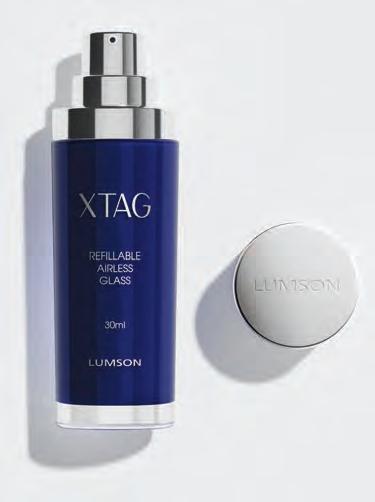
pouch technology is placed inside the airless refill. The patented chip is embedded in the packaging without coming into contact with the formula, transforming XTAG into a digital tool that revolutionises the shopping experience.
Environmental and consumer benefits. XTAG embodies the concept of packaging recovery and reuse, helping to reduce CO2 emissions by up to 38% - a figure based on a comparison between a standard 30 ml Lumson glass airless bottle with plastic pump and overcap, and XTAG with the refill replaced three times (source: SPICE). Made from eco-friendly materials (glass and PP), it encourages consumers to adopt a more responsible attitude. For example, using 1 million XTAG units could cut CO2 emissions by approximately 116,700 kg, which is the equivalent of driving 536,305 km or circling the globe more than ten times (source: impactco2.fr).
This primary packaging for cosmetics offers a sustainable solution that enhances quality of life and environmental responsibility without compromising on aesthetics, design, technology and functionality.
Communication advantages. Designed for the cosmetic sector (masstige, prestige and luxury segments), XTAG is the ideal solution for products whose skincare or make-up formulas require complete protection from external agents. It caters to brands committed to promoting responsible consumption through refillable systems, while also viewing packaging as a potential digital tool to strengthen the bond with consumers. With XTAG, brands can offer tailored content, certify product authenticity, ensure traceability, prevent counterfeiting and implement anti-theft measures.
As an airless solution with built-in digital capabilities, XTAG offers an interactive and immersive brand experience.

www.plastigraftrevigiana.com
Cos’è. Picasso™ Natura è un cartoncino bianco/bianco nato per essere termoformato, a cui è applicato un coating a dispersione acquosa per garantire elevate proprietà di barriera: un prodotto idoneo al contatto con tutti i tipi di alimento, ma che non utilizza film plastici.
Innovazione. Picasso™ Natura è un cartoncino monomateriale, conforme al contatto alimentare e idoneo alla cottura al forno e al congelamento. Risponde all’esigenza - nata prima del PPWR - di packaging senza film plastico espressa dal settore alimentare.
Plastigraf Trevigiana ha avuto l’intuizione di applicare il coating a dispersione acquosa anche al cartoncino, non più solo alla carta, sperimentando una bobina alla volta. Questa flessibilità ha rappresentato un vantaggio competitivo nella customizzazione del prodotto finito.
Materiali utilizzati. Cartoncino bianco/bianco di fibra vergine SBS trattato con coating a dispersione acquosa, contenente fino al 95% di fibra cellulosica, completamente privo di sostanze PFAS e considerato monomateriale.
Tecnologie applicate e vantaggi. Spalmatura uniforme di un coating a base acquosa su un lato di cartoncino bianco/bianco non patinato. Lo speciale trattamento con coating a base acquosa rende possibile realizzare pack per il contatto alimentare completamente privi di film plastici, ma che garantiscono elevata barriera a umidità (COBB <5 a 1800 sec.) e ai grassi (Kitt 12).
L’utilizzo della dispersione a base acquosa, massimo 10-15 g/mq, si pone come alternativa all’estrusione diretta dei polimeri (30-40 g/mq) o alla plastificazione diretta. Inoltre, come le soluzioni contenenti materiale plastico, il prodotto resiste agli sbalzi termici (congelamento, forno convenzionale fino a 220 °C, microonde a 800 Watt).
Benefici per ambiente e consumatori. Compostabile CIC (certificato 187-P5287), è riciclabile con la carta con livello A secondo i criteri Aticelca® (UNI 11743). Le vaschette prodotte con Picasso™ Natura sono a loro volta compostabili e riciclabili, quindi facilmente smaltibili e resistenti agli shock termici.
Plus di comunicazione. Il cartoncino è nato per essere termoformato, ma può anche essere incollato a caldo e utilizzato per vaschette piega e incolla oppure per coperchi. Inoltre, una vaschetta termoformata con Picasso™ Natura può essere termosaldata, per esempio con un coperchio dello stesso materiale. Il retro della vaschetta è stampabile con le varie informazioni su utilizzo, aspetto e smaltimento. Il materiale si presta a numerose personalizzazioni, lasciando piena libertà di design al produttore.
Product overview. PicassoTM Natura is a white/white cardboard designed for thermoforming, featuring an aqueous dispersion coating that provides highbarrier properties. It is suitable for contact with all types of food, without the need for plastic films.
Innovation. PicassoTM Natura is a mono-material cardboard that is food-contact compliant and suitable for baking and freezing. It was developed in response to the food industry’s growing demand for plastic film-free packaging - a need that emerged even before the introduction of the PPWR. Plastigraf Trevigiana had the foresight to extend the use of aqueous dispersion coating from paper to cardboard, experimenting one reel at a time. This flexibility became a competitive advantage, allowing for greater customisation of the finished product.
Materials used. White/white SBS virgin fibre cardboard treated with an aqueous dispersion coating. It contains up to 95% cellulose fibre, is entirely free from PFAS and is classified as a mono-material solution.
Applied technologies and benefits. A uniform water-based coating is applied to one side of the uncoated white/white cardboard. The special aqueous dispersion coating treatment enables the production of food-contact packaging that is entirely free from plastic films, while still offering excellent barrier properties-moisture
resistance (COBB <5 at 1800 sec) and grease resistance (Kitt level 12). With an application weight of just 10-15 g/ sqm, the water-based coating provides a sustainable alternative to direct polymer extrusion (30-40 g/sqm) or direct plastic lamination. In addition, like plastic-based solutions, the product is resistant to temperature variations (freezing, conventional oven baking up to 220 °C and microwave heating at 800 watts).
Environmental and consumer benefits. Certified compostable by CIC (certificate 187-P5287), it is recyclable as A-grade paper according to Aticelca® standards (UNI 11743). Trays made with PicassoTM Natura are both compostable and recyclable, offering easy end-of-life disposal while remaining resistant to thermal shock.
Communication advantages. The cardboard was originally designed for thermoforming, but it can also be hot-glued and used to produce fold-and-paste trays or lids. In addition, thermoformed trays made with PicassoTM Natura can be heat-sealed, for example, with a lid made from the same material.
The back of the tray is printable, allowing for the inclusion of usage instructions, visual branding and disposal guidelines. The material is highly versatile and supports a wide range of customisations, offering manufacturers complete creative freedom in design.
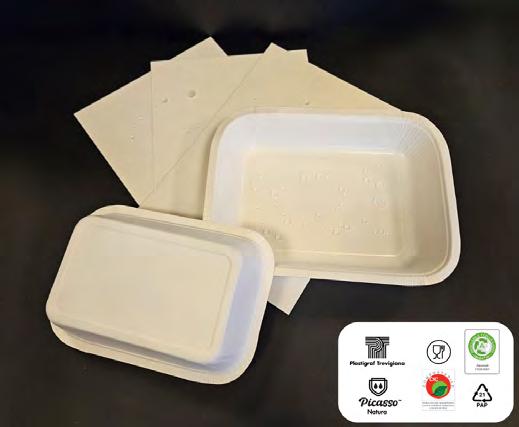

Cos’è. “T-BAG and Stop! Portami con te”… è il messaggio semplice e diretto che evidenzia la praticità e portabilità del prodotto, frutto della collaborazione tra Smilesys e Mustangpack. T-BAG è una busta preformata in carta, leggera, versatile e termosigillabile, progettata per proteggere e valorizzare i prodotti ortofrutticoli, riducendo l’uso di risorse grazie a materiali naturali e a un design funzionale.
Innovazione. A differenza degli shopper tradizionali, T-BAG è prodotta con carta leggera (da 40 g/m²), senza piegature complesse né incollaggi. Questo consente un risparmio del 50% di materiale e una superficie ottimale per la comunicazione.
Materiali utilizzati. Realizzata con carta da 40 g/m², rete in viscosa e maniglia integrata, T-BAG è 100% riciclabile, naturale e sostenibile, con una drastica riduzione dell’uso di materiali rispetto agli imballi tradizionali.
Tecnologie applicate e vantaggi. Il packaging nasce dal riadattamento di un impianto per mascherine COVID. La macchina produce buste singole o a nastro, ottimizzando i processi automatici o manuali, con alta efficienza e versatilità. Migliora le fasi di confezionamento grazie a un sistema che unisce riempimento e sigillatura automatica, aumentando l’efficienza produttiva e riducendo costi, tempi e sprechi, adattandosi a diverse esigenze produttive.
Benefici per ambiente e consumatori. T-BAG è completamente naturale: l’uso di carta e viscosa riduce l’impatto ambientale lungo l’intero ciclo di vita, risparmiando risorse e promuovendo un approccio sostenibile. Se prodotta responsabilmente, infatti, la carta è una valida alternativa alla plastica e T-BAG dimostra che materiali naturali possono offrire prestazioni elevate oltre a un impatto ambientale contenuto, generando meno rifiuti. Facile da aprire, trasportare e smaltire, il consumatore può contare su una struttura stabile: la maniglia integrata e la visibilità del prodotto garantiscono un’esperienza d’uso comoda, igienica ed esteticamente efficace.
Plus di comunicazione. T-BAG nasce dall’osservazione nei supermercati e dalla volontà di ridurre sprechi e impatti ambientali nel settore ortofrutta. Rispetto a cassette, plastica o shopper in carta classiche, è più leggera, ecologica e igienica. Riduce costi, sprechi e manipolazioni, migliorando la protezione e valorizzando il prodotto. Pensata per consumatori attenti all’ambiente e per distributori che vogliono efficienza e sostenibilità, T-BAG ha le potenzialità per poter essere adottata su larga scala: grazie a sostenibilità, versatilità e semplicità logistica, si integra facilmente in vari canali distributivi, migliorando branding e operatività. Si adatta a prodotti freschi e secchi, esposti in piccoli negozi o supermercati. Ottimizza spazio, distribuzione e processi, mantenendo funzionalità e resistenza. Offre un’ampia superficie stampabile interna ed esterna, una finestra visiva e una base stabile. Il design favorisce la personalizzazione e rafforza l’identità del brand, creando impatto sullo scaffale. Combina sostenibilità, estetica e funzionalità in un imballo che si distingue, valorizzando il contenuto e comunicando valori green.
Product overview. “T-BAG and Stop! Take me with you” - a simple and direct message that highlights the practicality and portability of the product, resulting from the collaboration between Smilesys and Mustangpack. T-BAG is a lightweight, versatile, heat-sealable preformed paper bag designed to protect and add value to fruit and vegetables. Its use of natural materials and functional design helps reduce resource consumption.
Innovation. Unlike traditional shopping bags, T-BAG is made from lightweight paper (40 g/ m²), with no complex folding or glueing. This reduces material usage by 50% and offers an ideal surface for communication.
Materials used. Made of 40 g/m² paper, viscose mesh and an integrated handle, T-BAG is 100% recyclable, natural and sustainable. Its minimalist construction significantly reduces material use compared to traditional packaging solutions.
Applied technologies and benefits. The packaging comes from the repurposing of a factory that once manufactured COVID masks. The machine is capable of producing individual or ribbon-style pouches, offering high efficiency and flexibility for automatic and manual packaging processes. It streamlines the packaging workflow thanks to a system that integrates automatic filling and sealing, increasing production efficiency while reducing costs, time and waste. It can be easily adapted to meet different production needs.
Environmental and consumer benefits.
T-BAG is made entirely from natural materials - paper and viscose - reducing environmental impact throughout its life cycle, saving resources and promoting a sustainable approach to packaging. When produced responsibly, in fact, paper is a credible
alternative to plastic, and T-BAG proves that natural materials can deliver both high performance and low environmental impact, while also generating less waste.
Designed with consumers in mind, T-BAG is easy to open, carry, and dispose of. Its stable structure, integrated handle and product visibility ensure a convenient, hygienic, and visually appealing user experience.
Communication advantages. T-BAG was inspired by observation in supermarkets and driven by a desire to reduce waste and environmental impact in the fruit and vegetable sector. Compared to crates, plastic bags or classic paper shopping bags, it is lighter, more sustainable and more hygienic. It lowers costs, minimises waste and simplifies handling - all while offering better protection and enhancing product appeal. Designed for environmentally conscious consumers and distributors seeking efficient and sustainable solutions, T-BAG has strong potential for large-scale adoption. Its sustainability, versatility, and logistical simplicity make it easy to integrate into various distribution channels, improving branding and operational performance. Ideal for fresh or dry produce in small stores or supermarkets, T-BAG optimises shelf space, distribution and processes without compromising on functionality and durability.
T-BAG features large printable surfaces on both the inside and outside, a viewing window, and a stable base. Its design allows for full customisation, reinforcing brand identity and creating a strong visual impact at the point of sale. By combining sustainability, aesthetics and functionality, T-BAG stands out as a packaging solution that not only enhances product appeal but also clearly communicates eco-friendly values.


Taghleef Industries e Plastigraf Trevigiana
www.ti-films.com - www.plastigraftrevigiana.com
prodotti
Cos’è. Packaging innovativo per applicazioni di lusso, quali cofanetti di profumi e prodotti cosmetici, che combina estetica e rispetto per l’ambiente tramite l’uso di film biobased NATIVIA® di Taghleef Industries, laminati su carta da Plastigraf Trevigiana. Una risposta concreta alle esigenze di un mercato in evoluzione come quello dei cosmetici di lusso, dove la sostenibilità e l’estetica non sono più in contraddizione, ma si rafforzano a vicenda.
Innovazione. Impiego di risorse rinnovabili per applicazioni lusso, caratterizzate da elevati standard estetici, sia per i supporti cartacei che per i film polimerici. Attraverso anni di affinamento di formulazione e processo, Taghleef ha adattato la tecnologia produttiva per migliorare la qualità di film tradizionalmente utilizzati esclusivamente nel food packaging e poter soddisfare le rigorose esigenze del settore delle arti grafiche di lusso.
Plastigraf Trevigiana, attraverso un processo di laminazione perfezionato, accoppia i film NATIVIA con carte di alta qualità (FSC, PEFC), creando così un prodotto con oltre il 90% di materiali rinnovabili. Questa soluzione rappresenta una completa innovazione per il settore e una valida alternativa alle strutture tradizionalmente utilizzate con film convenzionali come il PET metallizzato.
Materiali utilizzati. La scatola rigida è realizzata in cartoncino riciclato da 600 g/m2, rivestita esternamente con il laminato, composto da carta da 160 g/m2 laminata con NATIVIA® N160 20μm (film BOPLA metallizzato), e stampata offset UV.
Tecnologie applicate e vantaggi. Estrusione in testa piana, metallizzazione, stampa offset UV, laminazione.
Benefici per ambiente e consumatori. Il prodotto è progettato nell’ottica di un’economia circolare, in cui l’uso dei materiali di imballaggio è completamente svincolato dal consumo di risorse finite, sia per il substrato cartaceo che per il film polimerico. I film NATIVIA® di Taghleef in acido polilattico (PLA) sostituiscono le plastiche tradizionali a base di petrolio. Plastigraf Trevigiana lamina i film NATIVIA® su substrati di carta di alta qualità, proveniente da foreste gestite in modo sostenibile (FSC, PEFC).
La percentuale di materiali ricavati da risorse rinnovabili del laminato è superiore al 90%.
I laminati sono stati testati con successo per la riciclabilità nel flusso della carta, secondo i rigorosi standard italiani e francesi (Aticelca e CTP), perciò il beneficio del consumatore è quello di non dover separare i materiali usati, ma conferire l’intero packaging in un unico contenitore.
Plus di comunicazione. I brand del lusso si trovano ad affrontare la pressione dei consumatori, che richiedono pratiche rispettose dell’ambiente. Tuttavia, il settore deve ancora accettare pienamente la sfida, adottando soluzioni di imballaggio sostenibili che possano in qualche modo compromettere l’estetica o le prestazioni. L’approccio innovativo adottato dimostra che sostenibilità e lusso possono coesistere e fornisce una soluzione concreta quanto necessaria, che consente di mantenere l’aspetto premium e soddisfare le aspettative dei clienti, riducendo al contempo l’impatto ambientale e contribuendo a un’economia circolare.
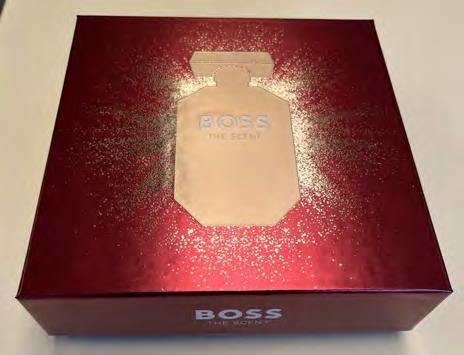
Product overview. Innovative packaging for luxury applications, such as perfume boxes and cosmetic products, that combines aesthetic appeal with environmental responsibility, using NATIVIA® biobased films from Taghleef Industries, laminated onto paper by Plastigraf Trevigiana. This packaging offers a concrete response to the evolving demands of the luxury cosmetics market, where sustainability and aesthetics are no longer at odds but instead complement and enhance each other.
Innovation. Use of renewable resources for luxury applications, characterised by high aesthetic standards, for both paper substrates and polymer films. After years of formulation and process refinement, Taghleef has optimised its production technology to elevate the quality of films once used solely for food packaging, making them suitable for the exacting requirements of the luxury graphic arts industry.
Plastigraf Trevigiana complements this innovation with an enhanced lamination process, bonding NATIVIA® films to premium paper (FSC- and PEFC-certified). The result is a product made from over 90% renewable materials. This marks a true breakthrough for the industry and presents a viable alternative to traditional structures that rely on conventional films such as metallised PET.
Materials used. The rigid box is made of 600 g/m2 recycled cardboard, externally coated with the laminate, consisting of 160 g/m2 paper laminated with NATIVIA® N160 20μm (metallic BOPLA film), and finished with UV offset printing.
Applied technologies and benefits. Flat-head extrusion, metallisation, UV offset printing, lamination.
Environmental and consumer benefits. The product is designed with a circular economy in mind, aiming to decouple material use from the consumption of finite resources - both in the paper substrate and polymer film.
Taghleef’s NATIVIA® polylactic acid (PLA) films replace traditional petroleum-based plastics. These films are laminated by Plastigraf Trevigiana onto high-quality paper substrates sourced from sustainably managed forests (FSC, PEFC certified). The laminate is composed of more than 90% materials derived from renewable resources. The laminates have been successfully tested for recyclability in the paper stream according to strict Italian and French standards (Aticelca and CTP). This means consumers don’t need to separate the used components, but can dispose of the entire packaging in a single paper recycling bin.
Communication advantages. Luxury brands are increasingly under pressure from consumers to adopt environmentally responsible practices. Yet, the industry has been slow to fully embrace sustainable packaging solutions, often out of concern that these may compromise aesthetics or performance. The innovative approach proves that sustainability and luxury can coexist and provides a practical yet essential solution, maintaining a premium appearance and meeting customer expectations, while reducing environmental impact and supporting a circular economy.

Cos’è. Nicetuck introduce un nuovo concetto di imballo e un innovativo sistema di incartonamento automatico che consentono la sigillatura senza l’utilizzo di colle hot-melt e adesivi. Interamente ideato e progettato da Tiber Pack, Nicetuck definisce nuovi standard operativi nell’ambito del packaging secondario, all’insegna della sostenibilità. Ad oggi, ha trovato applicazione nel settore della produzione alimentare a servizio della GDO, ma l’utilizzo può essere esteso a tutte le produzioni di beni che necessitano di un imballo secondario. Non si escludono anche applicazioni nel settore e-commerce.
Innovazione. È un’innovazione che non si vede ma fa la differenza. L’unicità sta nel fatto che il sistema è in grado di apportare importanti vantaggi economici, riducendo l’impatto ambientale.
Materiali utilizzati. Il fustellato Nicetuck viene realizzato utilizzando semplice cartone ondulato. Si ottiene dalla geometria di un fustellato wrap around, applicando particolari tagli e cordonature che ne permettono la chiusura automatica senza colle e adesivi e non richiedono nessuna superficie di taglio aggiuntiva.
Tecnologie applicate e vantaggi. I fustellati del tipo Nicetuck possono essere realizzati con tecnologie di fustellatura standard. I dispositivi di sigillatura dell’imballo Nicetuck sono stati sviluppati e brevettati dal reparto di Ricerca & Sviluppo di Tiber Pack.
Oltre a eliminare i costi di approvvigionamento delle colle, tale imballo consente di diminuire notevolmente i consumi energetici dei processi di incartonamento e, contemporaneamente, mantenere tutti i vantaggi dell’automazione. Si migliora inoltre l’efficienza di lavorazione e si abbattono i costi per interventi di manutenzione e pulizia degli impianti.
Benefici per ambiente e consumatori. È ecologico ed economico poiché, eliminando l’utilizzo di colle, contribuisce a diminuire le emissioni di CO2 e migliora il consumo di energia elettrica assorbita dagli impianti di incartonamento.
L’imballo Nicetuck permette una più agevole apertura, ed essendo privo di colle e adesivi, può essere smaltito più facilmente.
Plus di comunicazione. Oltre a poter disporre di un packaging di qualità, I consumatori finali possono essere informati e resi più consapevoli dell’impatto ambientale di ciò che stanno acquistando.
Product overview. Nicetuck introduces a new concept in packaging, featuring an innovative automatic wrapping system that enables sealing without the use of hot-melt glues or adhesives. Entirely conceived and designed by Tiber Pack, Nicetuck sets new operating standards in secondary packaging focused on sustainability. Currently used in food production for large-scale retail, Nicetuck is suitable for a wide range of goods that require secondary packaging. Its potential applications in the e-commerce sector are also being explored.
Innovation. An invisible innovation that makes a real difference. What sets Nicetuck apart is its ability to generate significant economic benefits while reducing environmental impact.
Materials used. The Nicetuck die-cut is made from simple corrugated cardboard. Its design is based on the geometry of a wrap-around die-cut, featuring special cuts and scoring that allow it to close automatically without the need for glues, adhesives or additional cutting surfaces.
Applied technologies and benefits. Nicetuck type die-cuts can be made using standard die-cutting technologies. The sealing systems of the Nicetuck packaging were developed and patented by Tiber Pack’s R&D department.
By eliminating the need for glue, this packaging not only reduces material procurement costs but also significantly lowers the energy consumption associated with cartoning processes while maintaining all the advantages of automation. Additionally, it enhances processing efficiency and reduces maintenance and cleaning costs for packaging lines.
Environmental and consumer benefits. It is both environmentally friendly and cost-effective. By eliminating the use of glues, it helps to reduce CO2 emissions and lowers the energy consumption of cartoning plants.
Nicetuck packaging is easier to open, and because it’s free from glues and adhesives, it’s also simpler to dispose of.
Communication advantages. In addition to offering high-quality packaging, Nicetuck provides an opportunity to inform and engage end consumers, raising awareness about the environmental impact of their purchase.

Cos’è. L’astuccio in cartoncino certificato FSC, stampato con inchiostro ad acqua, è un’evoluzione di packaging del Modulo relé ad impulsi Quid 10A. Rispetto all’imballo iniziale, gli interventi di ecodesign ne hanno ottimizzato le dimensioni, migliorando i tempi di confezionamento, la gestione logistica e il trasporto. Crea un impatto positivo sul mercato sensibile alle tematiche ambientali. Insomma, come recita il claim coniato dall’azienda, “Meno packaging, più sostenibilità”.
Innovazione. Ottimizzazione dell’imballo di un prodotto di successo, con l’obiettivo di ridurre l’impatto ambientale mantenendo al contempo una comunicazione grafica efficace. Nello studio del packaging è stata adottata una strategia volta al riutilizzo massivo delle soluzioni di confezionamento, con l’obiettivo di ridurre il numero di imballaggi gestiti e ottimizzare la filiera di approvvigionamento. Questa strategia prevede l’uso di materiali riciclabili, l’implementazione di tecniche di imballaggio modulare per una maggiore efficienza e sostenibilità del processo di confezionamento.
Materiali utilizzati. Il materiale VINCICOAT fornito da RDM è un cartone patinato bianco con retro-grigio (WLC) di tipo GD ed è composto al 90% da fibre riciclate e al 10% da fibre vergini. Il fornitore utilizza principalmente carta da riciclare proveniente dai settori industriali e commerciali, nonché dalle raccolte cittadine. Una quantità limitata di fibra vergine certificata FSC®/PEFC viene acquistata esternamente da fornitori selezionati per conferire al cartone specifiche caratteristiche fisiche e meccaniche.
Tecnologie applicate e vantaggi. Le tecnologie impiegate sono le stesse già adottate dai fornitori per la produzione di astucci in cartoncino teso utilizzando il materiale Vincicoat.
Benefici per ambiente e consumatori. L’imballo è stato ridimensionato per ridurre l’impatto ambientale, mantenendo la comunicazione grafica. Il Modulo relé ad impulsi Quid 10°, prodotto innovativo, ha visto una crescita significativa delle vendite negli ultimi anni. L’ottimizzazione dell’imballo ha ridotto il numero di pallet spediti annualmente del 47%, passando da 106 a 56 pallet. Anche l’ottimizzazione della logistica produttiva rappresenta un vantaggio competitivo sia per l’azienda che per i suoi clienti, che possono godere di una maggiore disponibilità del prodotto, tempi di consegna più rapidi e un servizio complessivamente migliore. L’imballo è in carta riciclata certificata FSC ed è riciclabile nella carta. Lo studio LCA ha determinato una riduzione di circa il 30% dell’impatto ambientale.
A fronte delle ridotte dimensioni dell’astuccio, il consumatore vedrà diminuire la quantità di carta da smaltire.
Plus di comunicazione. Il dialogo con il consumatore si arricchisce grazie a icone grafiche intuitive, capaci di raccontare il prodotto in modo immediato. Inoltre, l’attenzione alla sostenibilità è sottolineata dai marchi Eco Pack e FSC, in grado di creare una connessione emotiva con l’interlocutore, sensibile alla riduzione dell’impatto ambientale.

Product overview. The FSC-certified cardboard box, printed with water-based ink, represents an evolved packaging solution for the Quid 10A Step Relay Module. Thanks to targeted ecodesign interventions, the new packaging is more compact than its predecessor, resulting in improved packing time, easier logistics management and more sustainable transportation. It creates a positive impact on environmentally sensitive markets. In short, as the company’s tagline puts it: “Less packaging, more sustainability”.
Innovation. The packaging for this successful product has been optimised with the goal of reducing environmental impact while preserving strong visual communication. As part of the packaging development process, a strategy was adopted to encourage the widespread reuse of packaging solutions aimed at minimising the number of packaging components handled and optimising the supply chain. This strategy includes the use of recyclable materials and the implementation of modular packaging techniques to improve both the efficiency and sustainability of the packaging process.

Materials used. The VINCICOAT material supplied by RDM is a GD-type white coated cardboard with a grey reverse side (WLC) and is composed of 90% recycled fibres and 10% virgin fibres. The supplier mainly uses recycled paper from industrial, commercial and municipal paper collection systems. A small portion of FSC®/PEFC-certified virgin fibres is purchased externally from selected suppliers to ensure the box meets specific physical and mechanical performance requirements.
Applied technologies and benefits. The technologies used are the same as those already employed by suppliers for producing flat cardboard boxes made with VINCICOAT material.
Environmental and consumer benefits. The packaging has been redesigned to reduce environmental impact while preserving its graphic communication. The innovative Quid 10A Pulse Relay Module has experienced significant sales growth in recent years. Packaging optimisation has led to a 47% reduction in the number of pallets shipped annually, from 106 to 56. This optimisation in production logistics provides a competitive advantage for both the company and its customers, resulting in greater product availability, faster delivery times, and an overall improved service. The packaging is made of FSC-certified recycled paper and is fully recyclable as paper. A LCA study confirmed an approximate 30% reduction in environmental impact. Thanks to the smaller size of the box, consumers will also benefit from having less paper waste to dispose of. Communication advantages. Communication with the consumer is enhanced through the use of intuitive graphic icons that convey key product information at a glance. In addition, the focus on sustainability is emphasised by the Eco Pack and FSC labels, reinforcing the brand’s environmental commitment and creating an emotional connection with eco-conscious consumers.


Aggiornamenti, revisioni e nuove prospettive della legislazione sui MOCA in ambito europeo: dal quadro normativo vigente alle tendenze in atto, che prevedono una maggiore focalizzazione sul prodotto finale, privilegiando la valutazione e il controllo delle sostanze impiegate, nonché la promozione di alternative più sicure e sostenibili.
A cura di Marinella Vitulli, Food Contact Center
Come di consueto, a chiusura di numerose attività incentrate sulla sicurezza dei materiali a contatto con gli alimenti, a dicembre 2024 si è svolto l’atteso seminario organizzato dall’Istituto Italiano Imballaggio, con la partecipazione della dottoressa Maria Rosaria Milana, già responsabile del Laboratorio Nazionale di Riferimento sui Materiali a Contatto con Alimenti dell’ISS, e dell’intero team. E, come di consueto, l’iniziativa ha riscosso notevole interesse, attirando un’ampia platea di specialisti del settore. Nel corso della mattinata sono state illustrate le leggi vigenti con i vari cambiamenti regolatori ad esse legati nonché le norme in sviluppo nell’immediato futuro.
Le presentazioni esposte dal gruppo dell’ISS hanno descritto lo stato attuale del quadro normativo Europeo e Nazionale in merito ai MOCA; un’attenzione particolare è stata rivolta alle nuove tendenze e alle nuove normative, con particolare riferimento agli aggiornamenti in merito al Regolamento per l’utilizzo di plastica riciclata a contatto con gli alimenti.
Il pomeriggio è stato caratterizzato da un question time: tante le domande da parte delle aziende, con l’obiettivo di fornire risposte operative al gran numero di esperti presenti in sala.
Nota: 19 dicembre 2024, 26sima edizione del seminario “Materiali e oggetti a contatto con gli alimenti”, realizzato da Istituto Italiano Imballaggio in collaborazione con l’Istituto Superiore di Sanità.
Note: On 19 December 2024, the 26th edition of the seminar “Materials and Objects in Contact with Food” was held, organised by the Istituto Italiano Imballaggio in collaboration with the Istituto Superiore di Sanità.

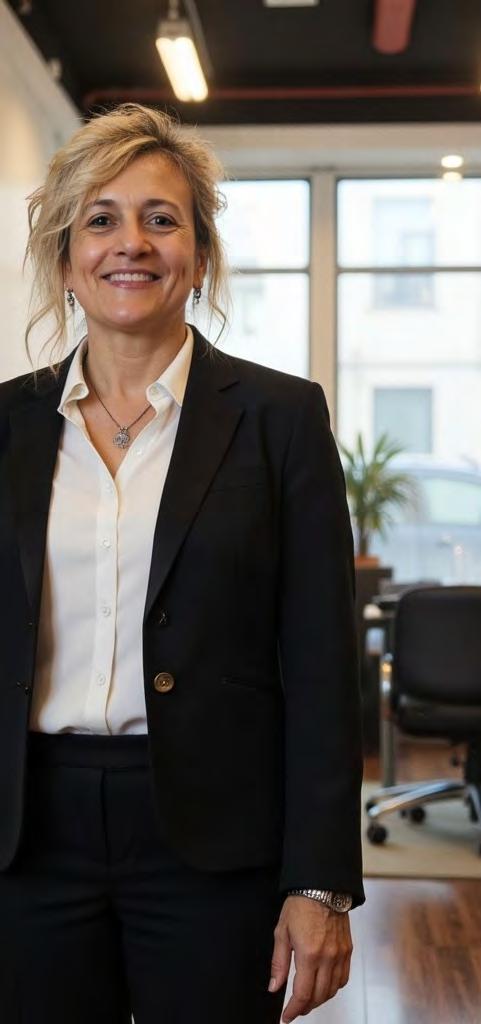

Servizi personalizzati e su misura, utili a ottenere prodotti tecnologicamente idonei allo scopo e sicuri, tramite uno studio e un piano mirato guidato dalla conoscenza dei materiali e degli affari regolatori connessi ai mercati, in un’ottica di sostenibilità e razionalità dei controlli.
Il Food Contact Center Srl - centro che fornisce servizi specialistici di analisi su materiali, fondato a Pistoia nel 2016 da Marinella Vitulli, e oggi attivo anche nel laboratorio materiali di Brescia e negli uffici di Cuneo - mette a disposizione dei propri clienti anni di esperienza in attività di studio e di analisi su packaging e materiali, contando su un team composto da oltre 30 tecnici qualificati.
Nel 2022, dalla sinergia fra il Food Contact Center e un gruppo di professionisti del settore con esperienza pluridecennale nasce una nuova società: il Food Contact Services Srl, che ha come scopo principale la diffusione della cultura della qualità di processi e prodotti nelle aziende produttrici e utilizzatrici di materiali a contatto con gli alimenti. Food Contact Services si occupa di consulenza e formazione, elaborando progetti su misura per le imprese; fornisce servizi di aggiornamento normativo e di consultazione on line delle legislazioni globali sui MOCA e sull’etichettatura cogente.
Può aiutare le imprese a definire un piano di autocontrollo o manuale, progettando una valutazione del rischio, in collaborazione con il Food Contact Center. A questo proposito, è possibile operare tramite test volti alla conformità, ma non solo. Le prove non sono l’unica forma ammessa per la definizione di conformità: con adeguate valutazioni guidate da competenze specifiche, è possibile associare altri calcoli o considerazioni a un numero limitato di prove analitiche, ad esempio correlati a migrazioni per calcolo, o stima di simulanti e situazioni peggiorativi, mirati anche ad associare i provini testati con svariate referenze, anche tramite la valutazione di spessori, ingredienti e processo utilizzati; è possibile così programmare piani di prove sostenibili per le aziende, che insieme ad altre competenze consentono di definire la documentazione di supporto.
Food Contact Center è specializzato anche in valutazione dell’esposizione del consumatore ed esecuzione di prove di migrazione di contaminanti food contact in alimenti, tra cui prove accreditate Accredia quali la migrazione in alimenti di Bisfenolo A e di elementi metallici come ad esempio Alluminio e Ferro, aspetti chiave anche per valutare la conformità di macchinari ed elettrodomestici.
Fondamentale anche l’analisi dei NIAS, accreditata dal laboratorio, per l’identifica-
Stato attuale e sviluppi legislativi in corso
La presentazione della Dott.ssa Milana ha inaugurato la giornata offrendo una panoramica complessiva sulla normativa vigente relativa ai MOCA. Sono stati esaminati i criteri fondamentali sanciti dai regolamenti quadro Reg. CE 1935/2004 e Reg. CE 2023/2006 (GMP), sottolineando come tali materiali rientrino nel campo della sicurezza alimentare e siano soggetti alla medesima regolamentazione applicata al settore alimentare in materia di controlli ufficiali.
Nel 2020 è stata annunciata la revisione della Strategia “Farm to Fork” della Commissione Europea, finalizzata a rendere il sistema alimentare più equo, sicuro e sostenibile. Di conseguenza, gli Stati membri, nell’applicare normative e leggi, devono conformarsi alle politiche dell’Unione e attenersi agli obiettivi stabiliti dalla Commissione.
Per quanto concerne le modifiche alla legislazione sui MOCA, è altamente probabile che la strategia futura si focalizzi maggiormente sul prodotto finale, privilegiando la valutazione e il controllo delle sostanze impiegate, nonché la promozione di alternative più sicure e sostenibili.
Modifiche in discussione per la legislazione MOCA
Le future strategie legislative sui MOCA si concentreranno sul prodotto finale, rafforzando la valutazione delle sostanze utilizzate e promuovendo alternative più sicure e sostenibili.
La Commissione Europea si occuperà di:
• stabilire regole più mirate per il MOCA finale in contatto con gli alimenti;
• rafforzare le regole sulle buone pratiche di fabbricazione (GMP);
• dare priorità alla valutazione e gestione delle sostanze, con particolare attenzione a:
- NIAS (sostanze non intenzionalmente aggiunte),
- sostanze CMR (cancerogene, mutagene e tossiche per la riproduzione),
- ED (distruttori endocrini) e sostanze persistenti, bioaccumulative e tossiche, - sostanze in nanoforma e altre categorie critiche.
Inoltre, l’UE punta a sostenere alternative più sostenibili, favorendo il riutilizzo sicuro e ampliando il riconoscimento delle tecnologie di riciclaggio nel rispetto della normativa ambientale.
Attività in corso e prossimi passi
Nel 2024 sono stati avviati:
• lo scoping paper, che definisce le linee guida per la revisione della normativa;
• lo studio sulla sostenibilità, che analizza il mercato per identificare soluzioni eco-compatibili;
• la rivalidazione delle priorità con la nuova Commissione Europea.
La roadmap prevede:
• pubblicazione del P olicy Paper entro fine 2025;
• valutazione d’impatto entro metà 2026;
• proposta legislativa nei primi mesi del 2027. Un aspetto chiave della revisione sarà il miglioramento della qualità e l’accessibilità delle informazioni lungo la filiera, con la digitalizzazione delle dichiarazioni di conformità per supportare le imprese.
Infine, si sta valutando la possibilità di coinvolgere organismi delegati (Reg. UE 625/2017) nei controlli ufficiali, ampliando le competenze oltre alle autorità competenti.
L’evoluzione della normativa sui MOCA continuerà nei prossimi anni, richiedendo un adeguamento costante da parte di tutti gli operatori del settore.
Evoluzione di specifici lavori comunitari: stato dell’arte
Il convegno è poi entrato nel dettaglio delle attività svolte dai vari tavoli tecnici istituzionali.
1) Per quanto riguarda il futuro 18° emendamento del Regolamento (UE) 10/2011, emerge la necessità di allinearsi al Regolamento (UE) 2022/1616, comportando modifiche sostanziali all’articolato.
In questo caso le principali novità includono:
• revisione dell’Articolo 2, con l’introduzione delle definizioni di “rilavorazione della plastica” e “sostanza UVCB” (sostanza di composizione sconosciuta o variabile);
• modifica dell’Articolo 4, con il chiarimento che i materiali plastici immessi sul mercato devono essere conformi al Regolamento (UE) 2022/1616, se rientrano nel suo ambito di applicazione;
• revisione dell’Articolo 5, per garantire che solo le sostanze incluse nell’Elenco dell’Unione possano essere utilizzate, con la possibilità di consultare l’EFSA in caso di dubbi sull’identità di una sostanza;
• modifica dell’Articolo 6, per consentire l’utilizzo di sostanze con funzione biocida autorizzate dal Regolamento Biocidi (UE) 528/2012;
• eliminazione dell’Articolo 7, con il ritiro dell’elenco provvisorio delle nuove sostanze;
• revisione dell’Articolo 8, per rafforzare i requisiti di purezza delle sostanze utilizzate nei MOCA, con un nuovo Articolo 3a che definisce l’”elevato grado di purezza;
• modifica dell’Articolo 14, con l’introduzione di test di migrazione specifici per materiali multistrato multimateriale;
• r evisione del Capo IV, con l’introduzione dell’Articolo 14bis per regolare l’uso ripetuto degli articoli di plastica e prevenire il deterioramento che potrebbe aumentare la migrazione di sostanze negli alimenti;
• modifica dell’Articolo 16, con aggiornamenti ai requisiti della dichiarazione di conformità. Infine, il nuovo emendamento introduce regole più stringenti per i materiali plastici multistrato multimateriale, specificando che, qualora lo strato a contatto con gli alimenti sia in plastica, esso dovrà rispettare i limiti di migrazione stabiliti dal Regolamento 10/2011. Viene inoltre aggiornata la dichiarazione di conformità, includendo informazioni dettagliate sulla durata e temperatura di trattamento e conservazione degli oggetti in plastica destinati all’uso ripetuto.
2) Per quanto riguarda il nuovo regolamento sul Bisfenolo A (BPA), è stata anticipata l’introduzione di misure più restrittive, tra cui il divieto di utilizzo del BPA come monomero o sostanza di partenza in adesivi, gomme, materie plastiche, vernici, siliconi e altri materiali destinati al contatto con alimenti. Sono previste deroghe limitate per specifiche applicazioni industriali, con stringenti requisiti di contenuto non rilevabile.
Il percorso di aggiornamento normativo è quindi in continua evoluzione, con ulteriori modifiche attese per il 2025.
3) Una presentazione si è poi focalizzata sul Regolamento (UE) 2022/1616 sulle materie plastiche da riciclo, un tema chiave nell’ambito dell’economia circolare. In vigore dal 10 ottobre 2022, il nuovo regolamento stabilisce una base giuridica per tutti i processi di riciclo, regolamentando sia le tecnologie già riconosciute come idonee (ad esempio, il riciclo meccanico del PET) sia le nuove tecnologie ancora in fase di sviluppo. I processi di riciclo devono ridurre ogni contaminazione iniziale a livelli che non presentino rischi per la salute umana, con un’attenzione particolare alla fase di decontaminazione.
È previsto un sistema di garanzia della qualità conforme al Regolamento (CE) 2023/2006 per assicurare la sicurezza dei materiali prodotti. Il regolamento disciplina l’immissione sul mercato delle materie plastiche riciclate destinate al contatto alimentare, stabilendo condizioni e restrizioni d’uso, che devono essere documentate attraverso una specifica Dichiarazione di Conformità.
Inoltre, le tecnologie di riciclo idonee devono essere valutate dall’EFSA e autorizzate dalla Commissione Europea e dagli Stati Membri. Il regolamento prevede anche la registrazione delle informazioni necessarie per i controlli ufficiali e la documentazione di conformità, incluse le schede di monitoraggio della conformità (CMSS).
Per le nuove tecnologie, il Regolamento stabilisce un iter di valutazione che prevede la notifica all’Autorità Competente almeno sei mesi prima dell’entrata in funzione dell’impianto di decontaminazione, la pubblicazione di relazioni periodiche e, se i dati risultano sufficienti, la richiesta di valutazione da parte dell’EFSA. Inoltre, è in corso l’implementazione del Registro Comunitario per la gestione delle informazioni relative agli impianti e alle tecnologie di riciclo.
4) Sono state poi illustrate le evidenze correlate ai controlli ufficiali. Nel 2024 il sistema RASFF ha registrato 170 notifiche relative ai materiali e oggetti a contatto con alimenti (MOCA), un dato stabile rispetto all’anno precedente ma in calo rispetto al biennio 20212022, quando le segnalazioni erano circa 200. Le principali criticità segnalate hanno riguardato la migrazione di sostanze pericolose, con un 40% delle notifiche relative alla presenza di ammine aromatiche primarie, melammina e formaldeide, in particolare da oggetti contenenti bamboo. I metalli (cromo, nickel, manganese, arsenico, alluminio e cobalto) hanno rappresentato il 19% delle segnalazioni, mentre il piombo, riscontrato soprattutto nei cartoni da pizza e nelle ceramiche, ha costituito il 12,5% delle notifiche.
Ulteriori problematiche hanno riguardato il bisfenolo A (10 segnalazioni), gli ftalati nei cartoni da pizza (16 segnalazioni) e la migrazione globale non conforme (13 segnalazioni). Un aspetto rilevante è stato il numero significativo di notifiche (24) legate a dichiarazioni di conformità errate o a documentazione insufficiente, segnalando la necessità di un maggiore controllo sulla tracciabilità e sulla conformità normativa dei MOCA.
Si evidenzia inoltre un netto calo delle notifiche sui MOCA contenenti bamboo e altre fibre vegetali non autorizzate (riso, mais, cotone), che nel 2021 rappresentavano il 60% delle segnalazioni e oggi si attestano al 5%, grazie a un piano d’azione coordinato tra gli Stati membri.


zione di sostanze non intenzionalmente aggiunte, tramite tecniche analitiche
Untargeted, argomento sul quale il Centro si è specializzato tramite studi e costruzione di librerie e database svolti in collaborazione con le Università di Pisa e Firenze e con il produttore di strumentazione Sciex. Anche le analisi di oltre 10000 PFAS sono accreditate con approccio target e di screening.
In merito alle strategie analitiche, il Centro collabora attivamente in gruppi di lavoro nazionali e internazionali quali ad esempio commissioni presso GIFLEX, Istituto Italiano Imballaggio, ILSI Europe e FREP.
Oltre ai test, Food Contact Center&Services possono fornire ulteriore assistenza nella conseguente stesura della dichiarazione di conformità, prevista dalla legge, nonché nell’ottimizzazione e nel controllo dei sistemi di gestione aziendale, nell’ambito delle certificazioni facoltative, anche attraverso l’esecuzione di ispezioni accreditate Accredia ai sensi della norma ISO 17020.
Altri aspetti su cui il team supporta le aziende sono le questioni relative alle valutazioni del ciclo di vita, la progettazione di test di sfida per i materiali riciclati, l’ecodesign e l’impatto ambientale, l’etichettatura in conformità con la normativa ambientale europea e non UE.

5) Le presentazioni successive hanno riguardato le attività in corso da parte del laboratorio europeo EURL FCM, che fornisce assistenza scientifica e tecnica agli Stati membri e supporto alla Commissione Europea nelle fasi pre-normative e di revisione della normativa MOCA. Sono stati illustrati i lavori del network tra laboratori nazionali di riferimento (NRL) ed EURL, i programmi di formazione (workshop e training course), e gli esercizi interlaboratorio volti a garantire criteri uniformi per la valutazione della conformità dei materiali e oggetti a contatto con alimenti (MOCA). Un focus specifico è stato dedicato alla normativa vigente su plastiche, carte e cartoni, metalli e leghe, e alle attività di armonizzazione delle metodologie di test.
Il laboratorio JRC sta conducendo studi mirati a migliorare l’affidabilità dei test di migrazione, in particolare su parametri come la temperatura del forno, il posizionamento degli articoli, la stabilità delle condizioni di test e il monitoraggio della temperatura con strumenti calibrati. Inoltre, si sta lavorando alla definizione della durata di vita massima prevista di un MOCA, con l’obiettivo di fornire indicazioni dettagliate sulle istruzioni per rallentare il deterioramento e sui cambiamenti osservabili che segnalano la fine vita del materiale. Tra i programmi futuri, è prevista la pubblicazione di linee guida per la progettazione dei test di migrazione e la valutazione della conformità dei MOCA in plastica a uso ripetuto, oltre all’organizzazione di nuovi Proficiency Testing (PT) su sostanze di interesse come PFAS e BPA.
Il Question Time: le risposte alle aziende
Nel pomeriggio del 19 dicembre si è tenuto il question time, con le domande dei presenti consegnate nel corso della mattinata, e le risposte del team dell’Istituto Superiore di Sanità seguite da commenti sugli aspetti applicativi. Uno degli argomenti oggetto di domande ha riguardato i materiali multistrato multimateriali, con un quesito che ha permesso di confermare che è importante che lo strato a contatto con alimenti, qualora sia in plastica, rispetti i limiti di migrazione stabiliti dal Regolamento 10/2011. Altri quesiti hanno riguardato le dichiarazioni di conformità, così da comprendere se le novità introdotte comporteranno novità nella loro compilazione.
Anche il riciclo è stato oggetto di confronto, visto che la legislazione vigente potrà incidere non poco in merito alla necessità per le aziende del settore di adeguarsi. Altri aspetti oggetto di intervento da parte del pubblico presente sono stati i contaminanti, quali ad esempio i bisfenoli ed i composti perfluorati.
Come sempre si è trattato di un dibattito vivace e interessante, a conferma dell’importanza della partecipazione a questa tipologia di eventi del settore.
Updates, revisions, and new developments in European MOCA legislation: from the current regulatory framework to emerging trends that place greater emphasis on the end product, prioritising the evaluation and control of the substances used, as well as the promotion of safer and more sustainable alternatives.
Edited by Marinella Vitulli, Food Contact Centre
The much-anticipated seminar organised by the Istituto Italiano Imballaggio took place in December 2024, marking the conclusion of numerous activities dedicated to the safety of food contact materials. The event featured the participation of Dr Maria Rosaria Milana, former head of the ISS National Reference Laboratory for Food Contact Materials, along with her entire team. Once again, the seminar generated significant interest, drawing a large audience of specialists in the field.
The morning session of the seminar focused on current legislation, highlighting recent regulatory updates, and upcoming regulations expected in the near future.
Presentations by the ISS team outlined the current state of the European and Italian regulatory framework for Food Contact Materials (MOCAs), with particular emphasis on emerging trends and new standards, including the latest updates on the regulation governing the use of recycled plastics in contact with food.
The afternoon was dedicated to a Q&A session, during which numerous questions were raised by companies, with the goal of providing operational answers to the many experts in attendance.
Current status and ongoing legislative developments
The seminar opened with a presentation by Dr Milana, who provided a comprehensive overview of current legislation related to MOCAs. She outlined the basic criteria set out in Framework Regulations (EC) No. 1935/2004 and No. 2023/2006 (Good Manufacturing Practices - GMP), pointing out that MOCAs fall under the scope of food safety. As such, they are subject to the same official control regulations
that govern the food industry.
The review of the European Commission’s “Farm to Fork” Strategy, aimed at making the food system fairer, safer and more sustainable, was announced in 2020.
In this context, Member States are required to implement regulations and laws in line with EU policy, while adhering to the objectives set out by the Commission.
With regard to changes in MOCA legislation, it is highly likely that future strategies will focus more on the end product, prioritising the evaluation and control of substances used, as well as promoting safer and more sustainable alternatives.
Changes under discussion for MOCA legislation
Future legislative strategies on MOCAs are expected to focus more on the end product, strengthening the evaluation of the substances used and promoting safer and more sustainable alternatives.
The European Commission will:
• establish more targeted rules for end products and materials intended to come into contact with food;
• strengthen regulations on Good Manufacturing Practices (GMP);
• prioritise the evaluation and management of substances, with particular attention to:
- NIAS (Non-Intentionally Added Substances),
- CMR (Carcinogenic, Mutagenic and Reprotoxic) substances,
- EDs (Endocrine Disruptors) and substances classified as Persistent, Bioaccumulative and Toxic (PBT),
- Substances in nanoform and other high-concern categories.
In addition, the EU aims to encourage more sustainable alternatives by promoting safe reuse and
broadening the recognition of recycling technologies that comply with environmental regulations.
Current activities and next steps
In 2024, several initiatives were launched:
• The Scoping Paper, which sets out guidelines for revising the regulations;
• a Sustainability Study, aimed at analysing the market to identify eco-friendly solutions;
• The Reassessment of Priorities in coordination with the newly appointed European Commission.
The roadmap includes:
• Publication of the Policy Paper by the end of 2025;
• Impact Assessment by mid-2026;
• Legislative Proposal in early 2027.
A key aspect of the revision is to improve the quality and accessibility of information throughout the supply chain, particularly through the digitalisation of compliance documentation to support businesses.
Finally, the possibility of involving delegated bodies (as per EU Regulation No. 625/2017) is being considered to expand the scope of official controls beyond the current competent authorities.
The evolution of MOCA regulations is expected to continue in the coming years, necessitating that all stakeholders in the industry adapt to ongoing changes.
Evolution of specific EU activities: state of the art
The conference then delved into the activities carried out by various institutional technical working groups.
1) Regarding the future 18th amendment to Regulation (EU) No. 10/2011, there is a need to align with Regulation (EU) No. 2022/1616, which will involve substantial revisions to the articles.
In this case, the main proposed changes include:
• Revision of Article 2: introduction of new definitions, such as “plastic rework” and “UVCB substances” (substances of unknown or variable composition);
• Amendment to Article 4: clarification that plastic materials placed on the market must comply
Personalised and tailored services, useful for obtaining products that are technologically suitable for the purpose and safe, through a study and a targeted plan guided by knowledge of materials and regulatory affairs related to the markets, with a view to sustainability and rational controls.
The Food Contact Center Srl - a center that provides specialist material analysis services, founded in Pistoia in 2016 on the initiative of Marinella Vitulli, and today operating in the materials laboratory in Brescia and in its offices in Cuneo - offers its clients years of experience in the study and analysis of packaging and materials, thanks to a team of over 25 qualified technicians.
In 2022 a new company was established thanks to the synergy between the Food Contact Center and a group of professionals in the sector with decades of experience: the Food Contact Services Srl, whose main aim is the dissemination of culture of process and product quality in manufacturing companies and users of materials in contact with foods. Food Contact Services offers advice and training, drawing up tailored projects for enterprises; it provides regulatory updating and online consultation services on global FCM (Food Contact Materials) legislation and on mandatory labelling.
It can assist enterprises to define a self-control or manual plan, designing a risk assessment in collaboration with the Food Contact Center. In this regard, it’s possible to operate through targeted conformity tests, but not only. Tests are not the only form admitted for the definition of conformity: with adequate assessments guided by specific skills, it’s possible to associate a limited number of analytical tests with other calculations or considerations, for example, correlated computational migrations, or estimation of simulants and pejorative situations, aimed also at associating the samples tested with various references, also through the evaluation of the thicknesses, ingredients and process used; it’s possible, in this way, to programme sustainable test plans for companies, which together with other skills allow for the definition of the supporting documentation.
Food Contact Center is also specialised in the evaluation of consumer exposure and in the performance of migration tests of food contact contaminants, including migration of Bisphenol A and metals such as, for example, Aluminium and Iron in food, key aspects also for evaluating the conformity of machines and appliances. Evaluation of NIAS (Non-Intentionally Added Substances) through Untargeted analytical techniques, is also fundamental. This is an area on which the Center has become specialised through studies and the development of libraries and databases in collaboration with the University of Pisa and Florence and with the instrumentation producer, Sciex. With regards to analytical strategies, the Center actively collaborates with national and international working groups such as, for example, commissions from GIFLEX, the Italian Packaging Institute and ILSI.
After the tests, Food Contact Center&Services can provide further assistance in the consequent drawing up of conformity declarations, as provided for by law, as well as the optimisation and control of company management systems, in the context of voluntary certifications, also through the carrying out of Accredia accredited inspection visits according to ISO 17020.
Other aspects on which the team supports companies are in areas related to life-cycle assessments, the planning of challenge tests for recycled materials, eco-design and environmental impact, and labelling in compliance with environmental legislation pertaining to European and non-EU laws.
with Regulation (EU) No. 2022/1616 when applicable;
• Revision of Article 5: confirmation that only substances included in the EU List may be used, with the possibility of consulting EFSA when substance identity is unclear;
• Amendment to Article 6: authorisation for the use of substances with biocidal properties, provided they are approved under the Biocidal Products Regulation (EU) 528/2012;
• Deletion of Article 7: removal of the provisional list of new substances;
• Revision of Article 8: strengthening of purity requirements for substances used in MOCAs, with the addition of a new Article 3a defining the “high degree of purity”.
• Amendment to Article 14: introduction of specific migration testing for multi-material, multilayer materials;
• Revision of Chapter IV: introduction of a new Article 14a regulating the repeated use of plastic materials to prevent degradation that could increase the migration of substances into food;
• Amendment to Article 16: updates to the requirements for the Declaration of Conformity. Finally, the new amendment introduces stricter requirements for multi-material, multi-layer plastic materials, specifying that if the food contact layer is made of plastic, it must comply with the migration limits established by Regulation No. 10/2011. The Declaration of Compliance is also being updated to include more detailed information on the duration and temperature of treatment and storage of plastic objects intended for repeated use.
2) Regarding the new regulation on Bisphenol A (BPA), the introduction of stricter measures was anticipated, including a ban on the use of BPA as a monomer or starting substance in adhesives, rubbers, plastics, paints, silicones and other food contact materials. Limited exemptions are foreseen for specific industrial applications, but these will be subject to stringent requirements for undetectable content.
This regulatory update is part of an ongoing process, with further changes expected by 2025.
3) A presentation then focused on Regulation (EU) No. 2022/1616 on recycled plastics, a key issue in the context of the circular economy. Effective as of 10 October 2022, the new regulation establishes a legal basis for all recycling processes, covering technologies already recognised as suitable (such as mechanical recycling of PET) and new technologies still under development. A key requirement is that recycling processes must reduce any initial contamination to levels that pose no risk to human health, with particular emphasis on the decontamination phase.
A quality assurance system in accordance with Regulation (EC) No. 2023/2006 has been implemented to ensure the safety of the materials produced.
The regulation governs the placing on the market of recycled plastics intended for food contact, establishing conditions and restrictions of use, which must be documented through a specific Declaration of Conformity. In addition, suitable recycling technologies must be evaluated by EFSA and authorised by the European Commission and Member States.
The regulation also mandates the recording of all information necessary for official controls and compliance documentation, including the preparation of Compliance Monitoring Sheets (CMSS).
For new technologies, the regulation establishes an evaluation process that includes notification to the Competent Authority at least six months prior to the decontamination facility becoming operational, publication of periodic reports, and, if the collected data is deemed sufficient, submission of a request for evaluation by EFSA. Lastly, the implementation of a Community Registry is currently underway, aimed at managing information on recycling facilities and technologies.
4) The findings correlated to official controls were then explained. In 2024, the Rapid Alert System for Food and Feed (RASFF) recorded 170 alerts concerning Materials and Objects intended to come into Contact with Food (MOCAs), a figure that remains stable compared to the previous year, yet lower than the 2021-2022 period, which saw approximately 200 alerts.
The main critical issues reported involved the migration of hazardous substances, with 40% of alerts concerning the presence of primary aromatic amines, melamine, and formaldehyde, particularly from items containing bamboo. Metals, such as chromium, nickel, manganese, arsenic, aluminium and cobalt accounted for 19% of the alerts, while lead, mostly found in pizza boxes and ceramic items, accounted for 12.5%.
Other issues reported included bisphenol A (10 alerts), phthalates in pizza boxes (16 alerts), and non-compliant overall migration levels (13 alerts). One noteworthy aspect was the considerable number of alerts (24) concerning false declarations of conformity or insufficient documentation, which highlights the need for stricter oversight of the traceability and regulatory compliance of MOCAs.
There was also evidence of a sharp decline in alerts involving MOCAs containing bamboo and other unauthorised plant-based fibres (such as rice, corn, and cotton), which had accounted for 60% of alerts in 2021 but dropped to just 5% in 2024, thanks to a coordinated action plan implemented by Member States.
5) Subsequent presentations covered ongoing activities of the European EURL FCM laboratory, which provides scientific and technical support to Member States and assists the European Commission during the preregulatory and revision phases of MOCA legislation.
The collaborative efforts between National Reference Laboratories (NRLs) and the EURL were highlighted, as well as training programmes (workshops and courses) and interlaboratory comparison exercises aimed at ensuring consistent and harmonised criteria for the conformity assessment of food contact materials and objects (MOCAs). Particular attention was given to the current regulations governing plastics, paper and cardboard, metals and alloys, as well as to the harmonisation of testing methodologies.
The Joint Research Centre (JRC) is conducting targeted studies to
improve the reliability of migration testing, particularly on parameters such as oven temperature, item placement, stability of testing conditions, and temperature monitoring using calibrated instruments.
In addition, work is underway to define the maximum expected lifespan of a MOCA, with the aim of providing detailed guidance on instructions to slow material degradation, as well as on the observable changes that indicate the end of the material’s life. Future initiatives include the publication of guidelines for the design of migration tests and the assessment of compliance of plastic MOCAs intended for repeated use, along with the organisation of new Proficiency Testing (PT) schemes focused on substances of concern such as PFAS and BPA.
Question Time: the answers to companies
A question time session was held on the afternoon of 19 December, during which the team from the Istituto Superiore di Sanità addressed questions submitted by participants earlier in the day. The session was followed by comments on the practical aspects of implementation.
One of the issues raised concerned multi-material, multi-layer materials. In response to a specific question, it was confirmed that if the food contact layer is made of plastic, it must comply with the migration limits established by Regulation (EU) No. 10/2011. Other questions focused on Declarations of Conformity, with participants seeking clarification on whether the recent changes will introduce new requirements for their preparation and completion.
Recycling was also a topic of discussion, given that current legislation could significantly affect the extent to which companies in the sector will need to adapt.
Additional topics raised by participants included the presence of contaminants such as bisphenols and perfluorinated compounds.
As always, it was a lively and engaging debate, underscoring the importance of participating in industry events of this kind.


PERFORMANCE / /
Modular machine from 1 to 6
Delta Robots suitable for speeds up to 400 b.p.m.
Possibility to feed symmetrical or asymmetrical bottles, either in pucks or directly on the line conveyor
/
Simple human interface and historical data collection
One touch rapid change-over including bottle emptying
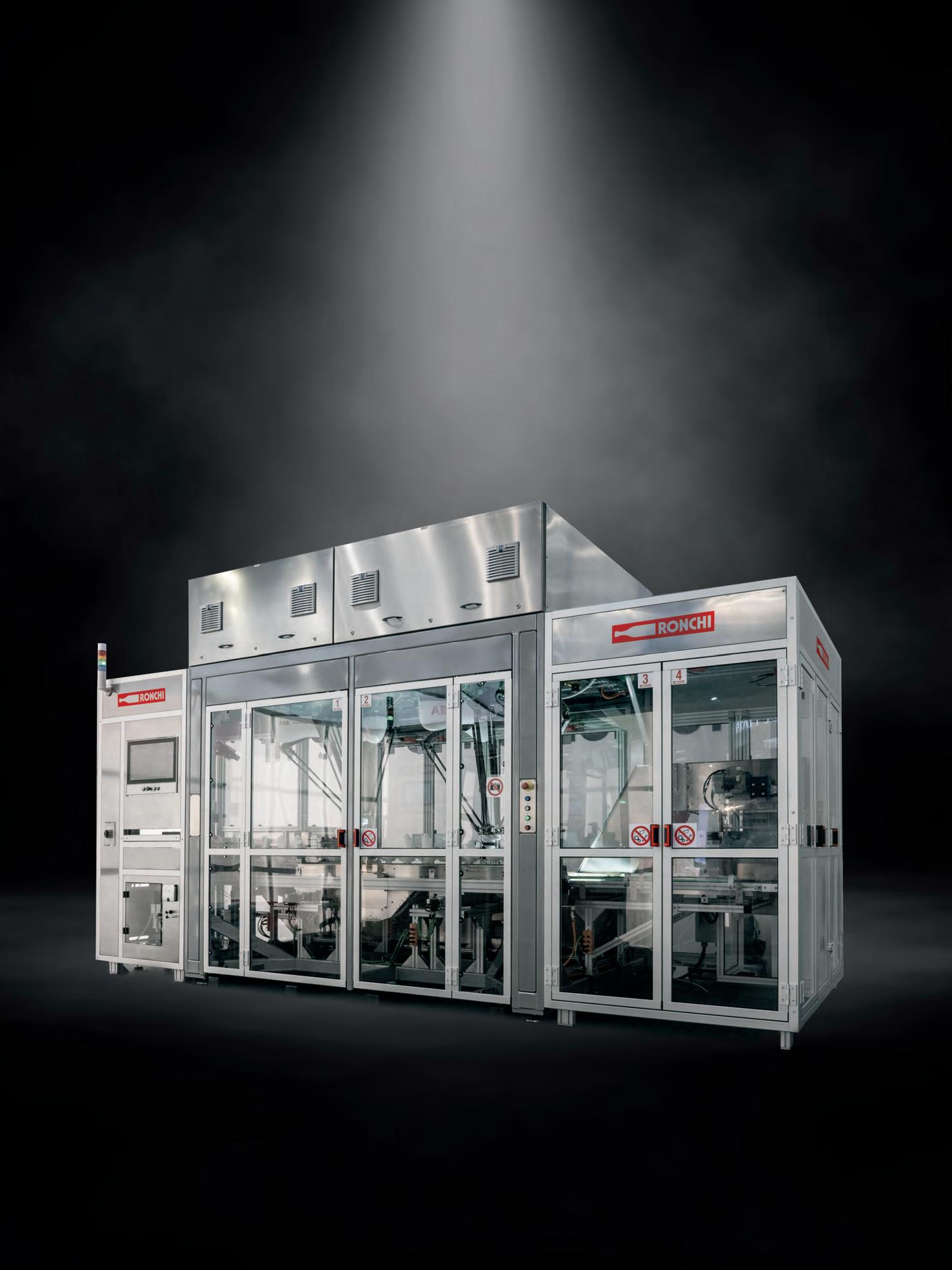

Key figures
1200
gli espositori the exhibitors
30%
la quota di espositori stranieri foreign exhibitors
50 i Paesi di provenienza dei buyer the buyers’ countries of origin
60
gli speaker protagonisti degli eventi the speakers
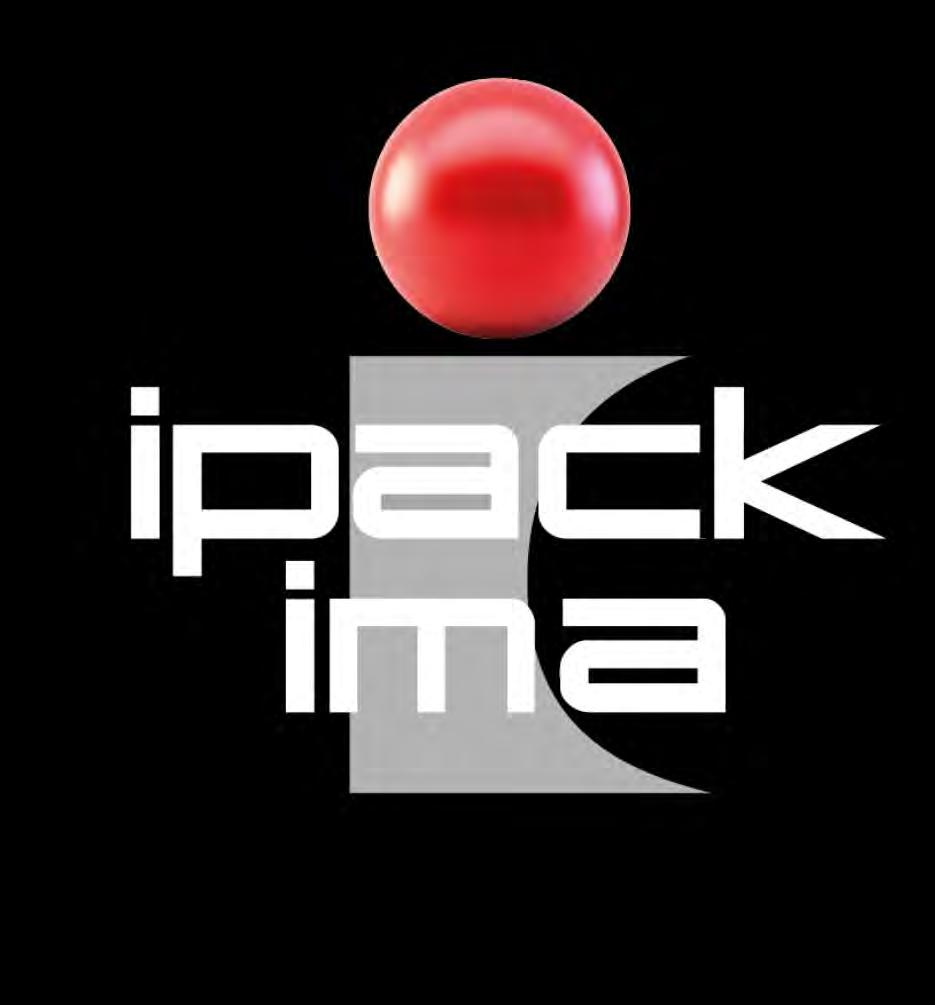



percorso
Da oltre trent’anni Cutting Pack affianca il mondo del packaging flessibile e delle applicazioni tecniche. Fondata nel 1993, Cutting Pack è oggi un’azienda con una consolidata presenza in Italia e nel Sud Europa, che si distingue per competenze tecniche, conoscenza dei materiali e una crescente capacità di anticipare i bisogni e trasformarli in soluzioni personalizzate.
Un hub di competenze al fianco dei converter
Cutting Pack è quindi un hub integrato di competenze, dove esperienza tecnica e supporto commerciale si uniscono per offrire soluzioni complete: dalla vendita di film e foil tecnici alla consulenza commerciale, dall’analisi di mercato allo sviluppo delle reti vendita, fino alla condivisione di know-how. L’azienda agisce come agenzia specializzata, selezionando prodotti di alta qualità da aziende che rispettano gli stessi elevati standard qualitativi.
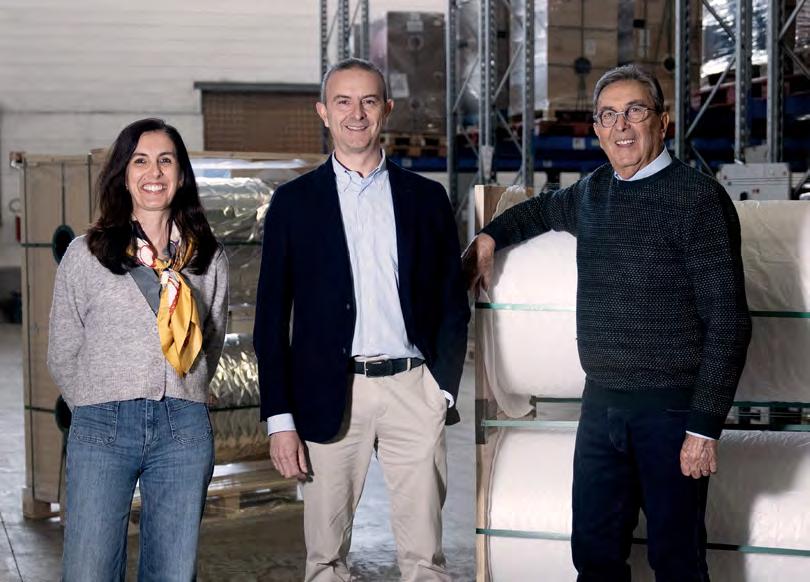
Cutting Pack
At Ipack-Ima - Hall 5, booth C84 - Cutting Pack brings expertise and practical experience.
Cutting Pack has been supporting the world of flexible packaging and technical applications for over thirty years. Founded in 1993, Cutting Pack is today a company with a strong presence in Italy and Southern Europe, standing out for its technical expertise, knowledge of materials and a growing ability to anticipate needs and turn them into customised solutions.
A hub of expertise alongside converters
Cutting Pack is an integrated hub of expertise, where technical experience and commercial support come together to offer complete solutions: from the sale of technical films and foils to commercial consultancy, as well as market analysis, development of sales networks and sharing of know-how. The company acts as a specialised agency, selecting highquality products from companies that meet the same high quality standards.
Customised materials and services
The Cutting Pack product portfolio includes a wide selection of technical materials: ALUFOIL, BOPET, BOPA, BOPP, CPP, PE - chosen for reliability and flexibility in terms of application. Services range from full truck and full container supply to local stock management and customised formulas for deferred consumption. The customer experience is facilitated by a 24-hour online warehouse with up-to-date availability and the possibility to place pre-orders independently.
A future that starts with listening
The generational transition at Cutting Pack, which sees Massimo and Paola succeed founder Ferdinando Ravelli, has ushered in a new phase of growth, driven by innovation and rooted in the values that have always defined the company. This move has introduced an even more marketoriented, flexible and responsive approach, able to adapt to changes in the industry and build tailor-made solutions, based on the effective needs of customers.
Cutting Pack verso il futuro: appuntamento a Ipack-Ima 2025 “A Ipack-Ima 2025 l’azienda presenta un’identità evoluta, proiettata verso un futuro in cui tecnologia, dati e intelligenza applicata diventano strumenti chiave per affrontare le nuove sfide del packaging” afferma Massimo Ravelli, direttore commerciale “La varietà di prodotti e servizi, la personalizzazione dell’offerta e la visione strategica si integrano alle più recenti applicazioni tecnologiche. Lo stand Cutting Pack si presenta quindi come uno spazio progettato per raccontare un’evoluzione fatta di soluzioni su misura, tecnologie intelligenti, affermando il concetto di Deep Innovation in Flexible Packaging, il modo in cui Cutting Pack guarda al futuro”.
Cutting Pack towards the future: rendezvous at Ipack-Ima 2025
“At Ipack-Ima 2025, the company will be presenting a renewed identity, projected towards a future in which technology, data and applied intelligence become key tools to rise to the new packaging challenges,” says sales director Massimo Ravelli. “A variety of products and services, a customised offer and our strategic vision are integrated with the latest technological applications. The Cutting Pack stand is thus designed to illustrate the evolution of the company, comprising tailor-made solutions and intelligent technologies and affirming the concept of Deep Innovation in Flexible Packaging, the Cutting Pack approach to the future”.
Materiali e servizi su misura
Il portafoglio prodotti Cutting Pack include un’ampia selezione di materiali tecnici: ALUFOIL, BOPET, BOPA, BOPP, CPP, PEscelti per affidabilità e flessibilità applicativa. I servizi vanno dalla fornitura full truck e full container alla gestione di stock locali e alle formule personalizzate per il consumo differito. Per rendere tutto più semplice, i clienti possono contare su un magazzino online attivo H24, con disponibilità aggiornata e possibilità di inoltrare preordini in totale autonomia.
Un futuro che parte dall’ascolto
Il passaggio generazionale in Cutting Pack che vede Massimo e Paola, succedere al fondatore Ferdinando Ravelli, apre una nuova fase di crescita, guidata dall’innovazione e radicata nei valori che, da sempre, definiscono l’azienda. Un’evoluzione concreta, che porta a un approccio ancora più orientato al mercato, flessibile e reattivo, capace di adattarsi ai cambiamenti del settore e costruire soluzioni su misura, a partire dai bisogni reali dei clienti.

Il nuovo dispenser in anteprima assoluta nell’area demo di HIPAC a Ipack-Ima.
Pad. 10, stand E11 - F20
Leader europeo nella produzione di film estensibile, HIPAC presenta HI.DEA, il nuovo dispenser appositamente studiato per agevolare le operazioni di imballaggio manuale delle merci su pallet, apportando al contempo importanti benefici in termini di salute e sicurezza sul posto di lavoro per gli operatori della logistica. Grazie al suo design ergonomico e alla versatilità nell’utilizzo di diverse tipologie di film, il dispenser HI.DEA rappresenta lo strumento ideale per chi vuole lavorare con produttività e precisione, minimizzando fatica e sprechi.
R&D al servizio dell’ergonomia
Sviluppato dal team R&D di HIPAC,100% Made in Italy e in fase di brevetto, il dispenser HI.DEA è stato progettato per un’applicazione facile, veloce ed efficiente del film estensibile manuale, garantendo inoltre una migliore stabilità del carico avvolto. HI.DEA evita l’insorgenza di problemi muscolo-scheletrici e mitiga il rischio dovuto ad attività ripetitive che richiedono sforzi musco-
lari. L’impugnatura è studiata per essere armonizzata con le caratteristiche antropometriche. HI.DEA: ergonomico, leggero e pratico, la soluzione ideale per tutte le logistiche e per i loro operatori impegnati ogni giorno nelle operazioni di imballaggio manuale.
Il connubio ideale: HI.DEA e 555
NetRoll®
Il dispenser HI.DEA può essere utilizzato con il film rigido 555 in bassi spessori (a partire da 7 µm) in versione NetRoll® senza il tubo in cartone. In questo modo, non solo si riduce ulteriormente il peso della bobina in uso, ma si eliminano anche tutti gli impatti ambientali legati alla produzione e smaltimento del tubo in cartone.
Protagonista in fiera e non solo
HI.DEA è stato tra i protagonisti della “International Conference on Safety & Innovation”, tenutasi a marzo 2025 nella sede Inail di Roma, durante la quale sono stati illustrati i risultati dello studio dal titolo “Ergonomics, workplace safety and pallet stability: the Dea project and the new dispenser HI.DEA”.
HI.DEA è a disposizione di tutti i visitatori della fiera Ipack Ima: allo Stand E11-F20, Pad.10 l’area demo di HIPAC ospita dimostrazioni pratiche sull’utilizzo del dispositivo, con la possibilità di provare la soluzione in prima persona.
The new dispenser is being previewed in HIPAC’s demo area at Ipack-Ima. Hall 10, booth E11 - F20
HIPAC, Europe’s leader manufacturers of stretch film, presents HI.DEA, the new dispenser specifically designed to facilitate manual wrapping of products on pallet operations, while bringing important health and safety benefits in the workplace for logistics operators. Thanks to its ergonomic design and versatility in using different types of films, HI.DEA dispenser is the ideal tool for working with productivity and precision, reducing effort and waste to a minimum.
R&D at the service of ergonomics
Developed by the HIPAC R&D team, 100% Made in Italy and in the patent phase, the HI.DEA dispenser is designed for easy, fast and efficient application of manual stretch film, improving the stability of the load wrapped. HI.DEA avoids musculoskeletal problems for the operator and mitigates the risk for repetitive activities requiring muscle effort. The ergonomic grip is designed to work in harmony with the proportions of the human body.
Light and practical, HI.DEA is the ideal solution for all logistics companies and their operators involved in manual packaging operations every day.
The ideal combination: HI.DEA e 555 NetRoll®
The HI.DEA dispenser can be used with 555 rigid film in low thicknesses (starting from 7 µm) in NetRoll® version without the cardboard tube. This not only further reduces the weight of the reel in use, but also eliminates all
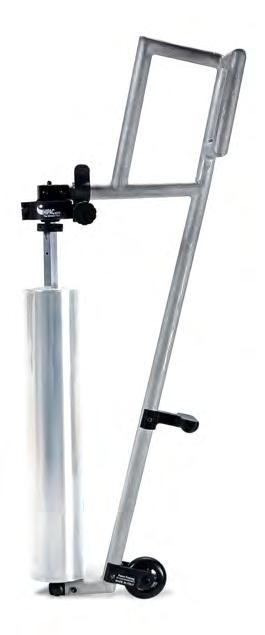
environmental impacts related to the production and disposal of the cardboard tube.
Featured at the fair and beyond HI.DEA was the focus of a panel at the ‘International Conference on Safety & Innovation’, held in March 2025 at the Inail headquarters in Rome, during which the results of the study entitled ‘Ergonomics, workplace safety and pallet stability: the Dea project and the new HI.DEA dispenser’, were illustrated.
HI.DEA is being previewed at Ipack-Ima. The HIPAC demo area, in Hall 10, Stand E11-F20, will host practical demonstrations on the use of the device, allowing visitors to try out the solution for themselves.







La frutta e verdura è raccolta all’apice della maturità, in piena stagione. Passano appena 6 ore dalla raccolta alla messa in conserva, così da preservarne le vitamine ed i minerali.
•

Punto Pack
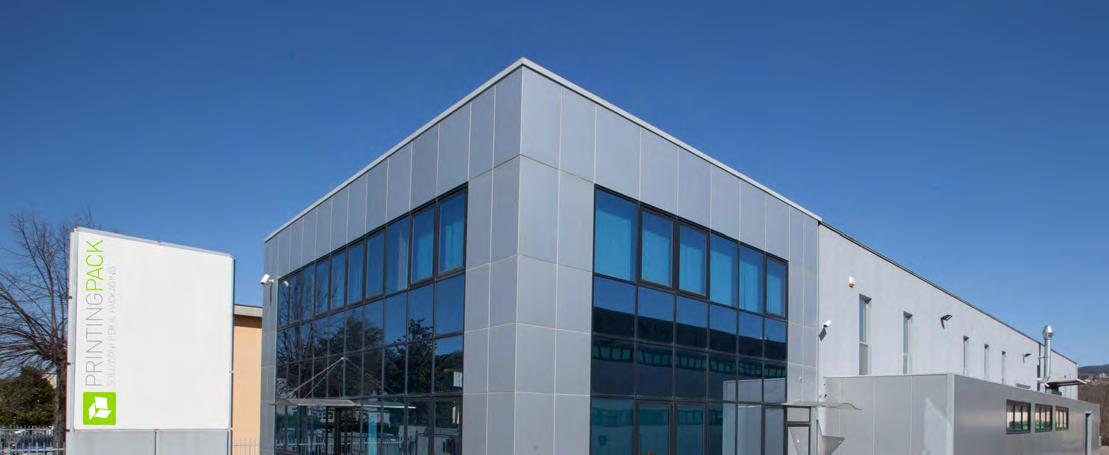
Il Gruppo Punto Pack si è recentemente ampliato acquisendo il controllo di Printingpack realtà fortemente sinergica che, peraltro, aveva contribuito a fondare.
Nel 2012, tre realtà all’epoca emergenti decidono di unire le forze per creare un polo produttivo capace di donare un’immagine unica ai prodotti attraverso il packaging secondario in carta. A distanza di tredici anni quelle realtà, tra i migliori partner di Punto Pack, rappresentano oggi dei riferimenti assoluti in ambito nutraceutico, operando con un ampio portfolio clienti in una varietà di prodotti e mercati.
Un naturale completamento dell’offerta Punto Pack e Mav Printingpack cresce e si afferma lavorando in modo specifico nell’ambito dei dispositivi medici e degli integratori alimentari, diviene quindi il naturale completamento dell’offerta di packaging primario proposta da Punto Pack e Mav. La specializzazione sui prodotti
specifici, l’attenzione alla qualità, il rispetto delle più rigorose normative e un sistema produttivo all’avanguardia consentono a Printingpack di fornire soluzioni integrate e combinate, volte a razionalizzare la filiera del confezionamento con notevoli vantaggi in termini di eliminazione dei costi occulti.
Con la nuova acquisizione il gruppo Punto Pack può oggi avvalersi di 5 società, 4 stabilimenti produttivi, oltre 150 dipendenti, oltre 60 milioni di fatturato consolidato.
La parola ai protagonisti
“Lavorare carta e derivati impone di mettere la sostenibilità al primo posto nella nostra lista delle priorità” afferma Luca Marchetti Presidente di Printingpack e Vice Presidente di Punto Pack “Il nostro gruppo, certificato B Corp dal 2020, ha visto in Printingpack una confluenza di competenze, capacità ed esperienze che ci permetteranno di migliorare in modo notevole il nostro livello di servizio alla clientela”.
“Operare in team con clienti che erano parte del nostro azionariato ci ha permesso di crescere comprendendo bene quelli che sono i plus richiesti al packaging secondario” dichiara Marino Vieri, co-fondatore e CEO di Printingpack “tutti i nostri asset tecnologici e l’intera impostazione aziendale sono volti ad estendere ai clienti il massimo dal punto di vista qualitativo e normativo, senza trascurare alcun particolare, dalla scelta delle materie prime, alle certificazioni FSC ed ISO9001, alla flessibilità che ci consente di avere minimi d’ordine molto bassi“.



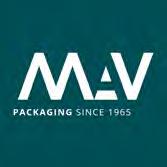


Punto Pack
The Punto Pack Group has recently expanded by acquiring control of Printingpack, a strongly synergistic business the Group helped establish.
In 2012, three up-and-coming companies decided to join forces to create a production hub able to give products a unique image through secondary paper packaging. Thirteen years later, those companies, among Punto Pack’s top partners, are very much benchmarks in the nutraceutical sector, operating with a broad customer portfolio in a variety of products and markets.
A natural complement to the Punto Pack and Mav offer Printingpack is growing and making a name for itself by working specifically in the area of medical devices and dietary supplements, making it the natural complement to the primary packaging produced by Punto Pack and Mav. Specialization in specific products, attention to quality, compliance with the strictest regulations and a state-of-the-art production system enable Printingpack to provide integrated and combined solutions aimed at rationalizing the packaging supply chain, with significant benefits in terms of eliminating
hidden costs. With the new acquisition, Punto Pack Group now comprises 5 companies, with 4 production plants, more than 150 employees, and over 60 million in consolidated sales.
A word from the executives “Processing paper and derivatives requires us to put sustainability at the top of our priority list”, explains Luca Marchetti, President of Printingpack and Vice President of Punto Pack. “Our group, B Corp certified since 2020, has identified a set of skills, abilities and experience in Printingpack that will allow us to significantly boost our level of customer service”.


premium per la tua applicazione

“Operating as a team with customers who were part of our shareholding structure has allowed us to grow thanks to a clear understanding of the features required of secondary packaging”, adds Marino Vieri, co-founder and CEO of Printingpack. “All of our technological assets and the entire company set-up are aimed at offering our customers the very best from a quality and regulatory point of view, without neglecting any detail, from the choice of raw materials to FSC and ISO9001 certifications and the flexibility that allows us to have very low order minimums”.
Prestazioni, integrazione, efficienza.
Prestazioni, integrazione, efficienza.
Servotecnica distribuisce soluzioni high-end per ogni esigenza di automazione.
Servotecnica distribuisce soluzioni high-end per ogni esigenza di automazione.



Le novità in fiera
A Ipack-Ima Goglio è protagonista con un’offerta completa di soluzioni integrate per il packaging flessibile. Pad. 7, stand A28 - B27

Presenza ricca di contenuti a Ipack-Ima per Goglio: 175 anni di storia e di innovazioni nel mondo del packaging con sistemi completi che evolvono insieme ai mercati e ai consumatori.
All’interno del padiglione 7, infatti, i visitatori possono scoprire la gamma di laminati flessibili ad alta barriera, anche in versione “pronta per il riciclo” e Goglio MIND, l’innovativa piattaforma Industrial Internet of Things che permette di monitorare e ottimizzare l’efficienza delle linee produttive, e tutti i prodotti e servizi del Gruppo. Accanto alle soluzioni di confezionamento, Goglio offre un approc-
cio che integra materiali, linee e servizi avanzati per rispondere in modo completo alle esigenze di diversi settori, dal caffè agli alimenti liquidi fino al pet food, con una particolare attenzione alla sostenibilità e all’ottimizzazione dei processi.
Bobine tracciate per prestazioni migliori
Si colloca in questo ambito il Fres-co System®+, il sistema che permette di tracciare ogni bobina grazie a un codice univoco inciso sull’anima del materiale che rende disponibili in tempo reale sulla piattaforma
MIND tutte le informazioni relative al laminato, come caratteristiche tecniche e parametri produttivi. L’integrazione ottimizza così la sinergia tra laminati e linee di confezionamento consentendo di adeguare automaticamente le impostazioni della macchina in base al tipo di laminato utilizzato, migliorando le prestazioni della linea e raccogliendo dati preziosi per lo sviluppo dei materiali.
Alle Smart Factory con due linee di confezionamento
All’interno dei padiglioni fieristici Goglio è inoltre presente con alcuni partner in due delle Smart Factory organizzate da Ipack-Ima stessa con due diverse linee di confezionamento. Nel Pad. 7 Stand C106, è possibile visionare la G21, linea automatica verticale per il confezionamento di sacchetti da 250g di caffè in atmosfera con compensazione di gas inerte. Nel Pad. 1 Stand C135 i visitatori possono invece scoprire la GStar, una linea per il confezionamento alimentare particolarmente adatta al caffè - in polvere e in grani - e capace di operare sia in modalità sottovuoto che soft pack. Con una velocità di produzione fino a 200 confezioni al minuto e la possibilità di produrre confezioni da 250g fino a 1kg, GStar garantisce una velocità e un’efficienza unica nel settore. Nello specifico, la GStar esposta produce confezioni di caffè da 250g in monomateriale.
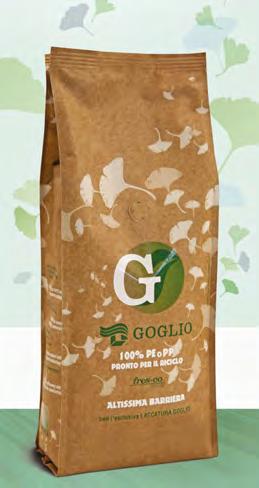
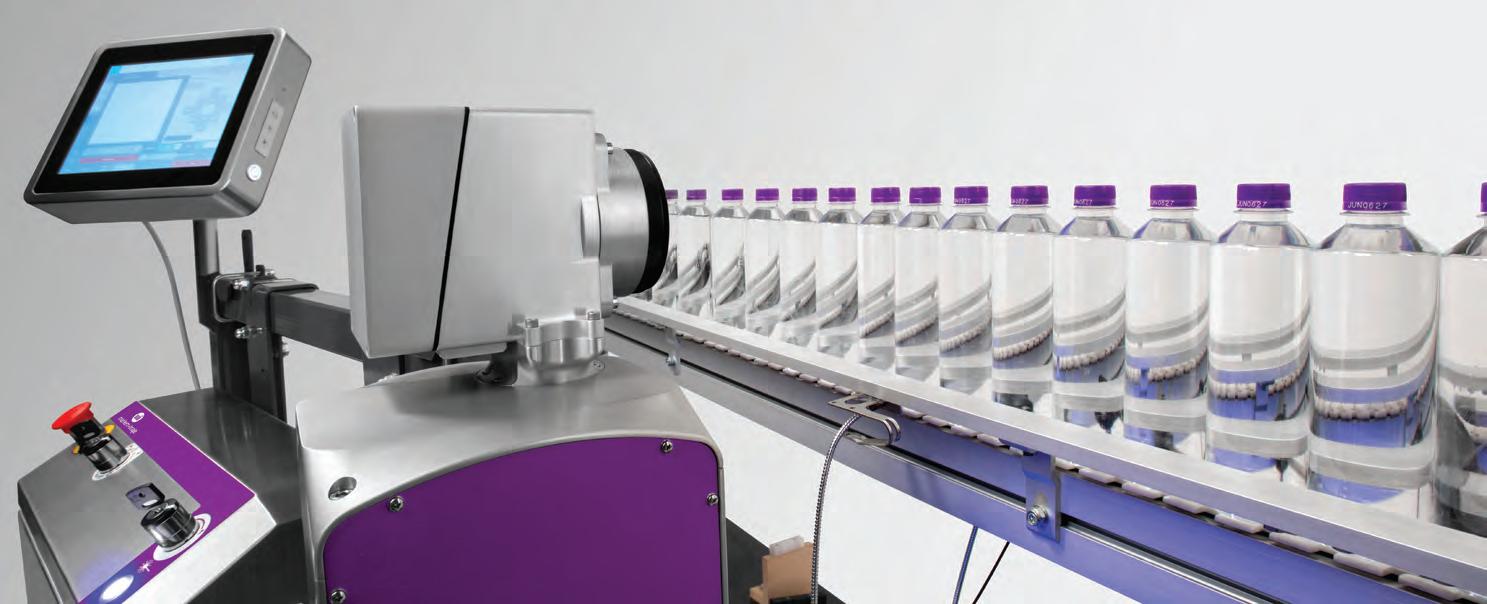

At Ipack-Ima - Hall 7 Booth A28 - B27 - Goglio presents a complete offer of integrated solutions for flexible packaging.
Content-rich presence at Ipack-Ima for Goglio: 175 years of history and innovation in the world of packaging, with complete systems that evolve together with the markets and consumers.
In Hall 7, visitors will have the chance to discover the range of high-barrier flexible laminates, also in “recycle ready” versions, and Goglio MIND, the innovative Industrial Internet of Things platform for monitoring and optimizing the efficiency of production lines, as well as all the Group’s products and services.
Alongside packaging solutions, Goglio offers an approach that integrates advanced materials, lines and services, offering a comprehensive response to the
needs of different sectors, from coffee and liquid foods to pet food, with a focus on sustainability and process optimisation.
Reels tracked for improved performance
This is where the Fres-co System®+ comes in: a system that allows each reel to be tracked thanks to a unique code engraved on the core of the material that makes all the information on the laminate - such as technical characteristics and production parameters - available in real time on the MIND platform. This integration thus optimizes the synergy between laminates and packaging lines by enabling automatic adjustment of machine
settings based on the type of laminate used, improving line performance and collecting valuable data for material development.
At the Smart Factories with two packaging lines Goglio is also present in the exhibition halls along with some of its partners, in two of the Smart Factories organized by Ipack-Ima with two different packaging lines.
In Hall 7 Booth C106, visitors can view the G21, an automatic vertical line for packing 250g bags of coffee in atmosphere with inert gas compensation. In Hall 1 Booth C135, visitors will have the chance to discover GStar, a food packaging line particularly suited to coffee
powder and beans that can operate in both vacuum and soft pack modes. With a production speed of up to 200 packs per minute and the ability to produce packs from 250g up to 1kg, GStar offers uniquely rapid, efficient solutions, unrivalled in the sector. Specifically, the GStar line on show produces 250g mono-material coffee packs.

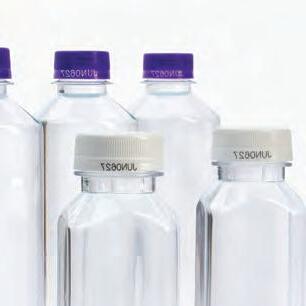

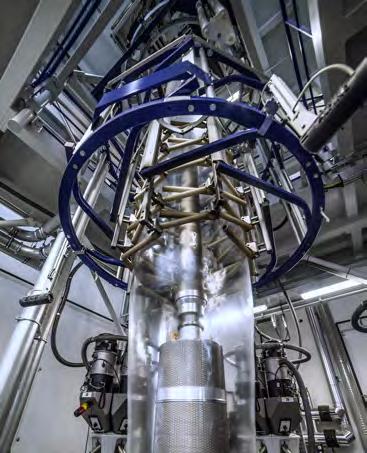
SDR Pack è azienda all’avanguardia nella produzione di imballaggi flessibili con una particolare vocazione per il settore alimentare e attività anche nel mondo non food. L’azienda ha consolidato una partnership di lunga data con Recycla, società del Gruppo Herambiente che gestisce i rifiuti industriali dal 2000. La collaborazione tra SDR Pack e Recycla è basata su valori condivisi e sinergia umana permettendo una gestione efficace dei rifiuti e il raggiungimento di importanti traguardi in sostenibilità. L’azienda produce infatti soluzioni riciclabili in plastica, carta e compostabili in bobine e buste, con focus particolare sul recupero e il riutilizzo. Grazie al servizio ECOL360° di Recycla, SDR Pack gestisce gli scarti, forma i dipendenti e rispetta le normative, affrontando sfide come la gestione di rifiuti pericolosi (poliaccoppiati, inchiostri, adesivi, metalli contaminati).
I dati raccolti da Recycla, certificati, sono diventati fondamentali per la stesura del bilancio di sostenibilità di SDR Pack. Nel 2024, questi dati mostrano il recupero di oltre 14.000 kg di imballaggi e un risparmio di 295 tep di combustibile fossile. Inoltre, attraverso il recupero dei rifiuti, Recycla crea combustibile alternativo, contribuendo alla riduzione delle emissioni e alla dipendenza dai combustibili fossili.
La plastica: un materiale sostenibile SDR Pack dimostra che la plastica, se gestita correttamente, può essere parte integrante di un sistema virtuoso. Guardando al futuro, l’azienda continua a creare soluzioni performanti, sicure e in linea con i principi dell’economia più circolare.
SDR Pack and Recycla: packaging as part of the circular economy
SDR Pack is a state-of-the-art flexible packaging company with a special focus on the food sector, and also active in the non-food world. The company has established a longstanding partnership with Recycla, a Herambiente Group company that has been managing industrial waste since 2000. Economic ethics and sustainability: shared values for a winning industrial project
The collaboration between SDR Pack and Recycla is based on shared values and human synergy, enabling effective waste management and the achievement of important milestones in sustainability. The company produces recyclable plastic, paper, and compostable solutions in rolls and pouches, with a special focus on recovery and reuse. Through Recycla’s ECOL360° service, SDR Pack manages waste, trains employees and complies with regulations, addressing challenges such as handling hazardous waste (polylaminates, inks, adhesives, contaminated metals).
A circular, certified supply chain The certified data collected by Recycla have become central to the drafting of SDR Pack’s sustainability report. In 2024, these figures showed the recovery of more than 14,000 kilograms of packaging and a saving of 295 toe in fossil fuel. In addition, through waste recovery, Recycla creates alternative fuel, contributing to a reduction in emissions and dependence on fossil fuels. Plastics: a sustainable material SDR Pack demonstrates that plastics, if managed properly, can be an integral part of a virtuous system. With an eye on the future, the company continues to create performance solutions that are safe and in line with the principles of an increasingly circular economy.

"THE ART OF INNOVATION" FIERA DI MILANO - RHO 27 - 30 MAGGIO 2025



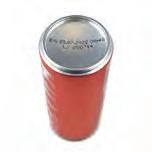

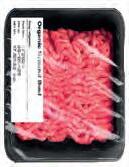

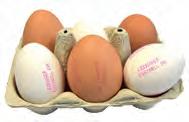

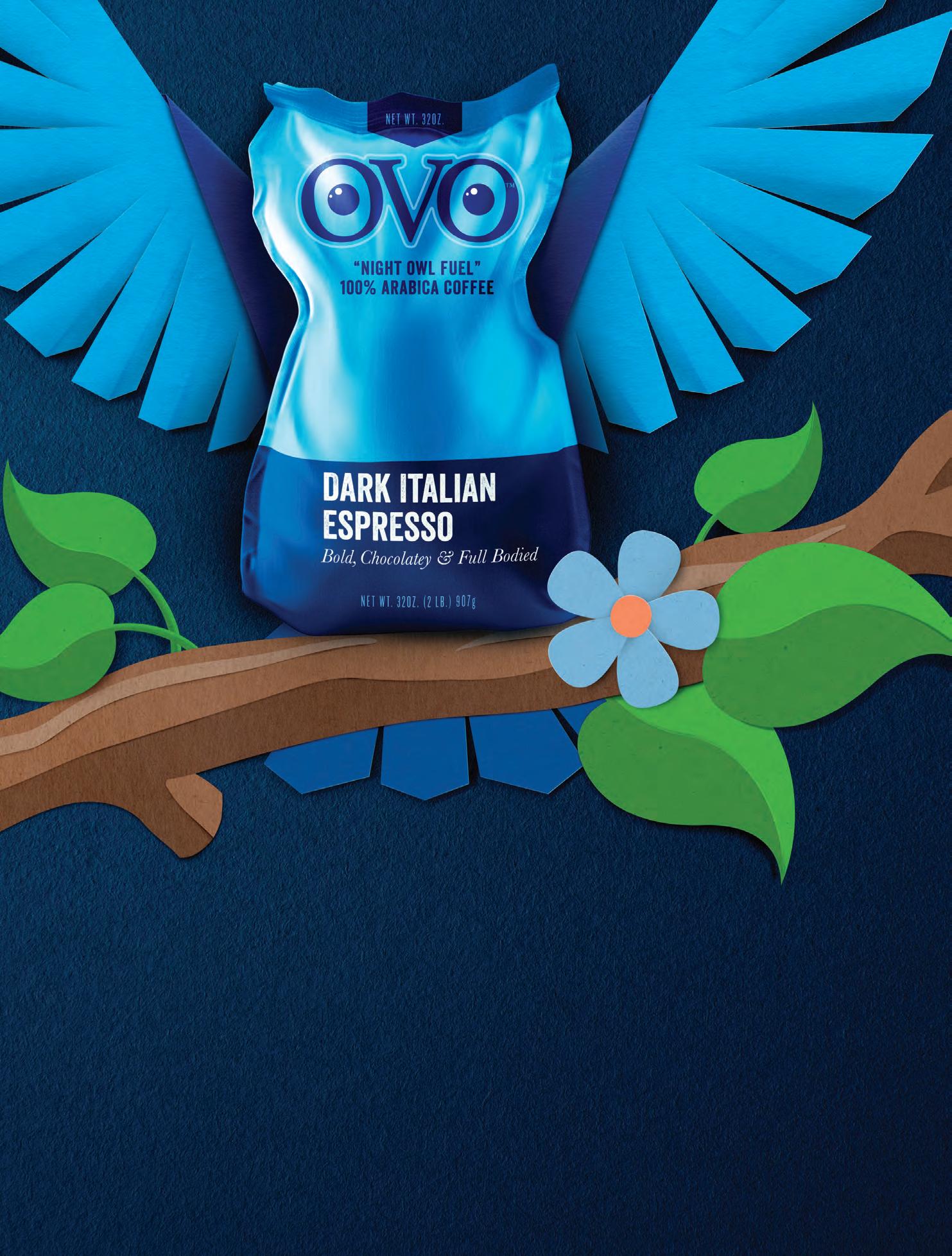


Affidatevi alla nostra conoscenza ed esperienza per soddisfare tutti i vostri obiettivi di sostenibilità.
Quando iniziate a separare i diversi film che compongono un multistrato, è facile capire perché sempre più stampatori scelgono l’imballaggio monomateriale. Non solo è più semplice da riciclare, ma la maggior leggerezza ne migliora il trasporto, il che si traduce in minori emissioni di carbonio. Se siete pronti ad affrontare le sfide della sostenibilità, collaborate con noi e portate la vostra attività a un livello superiore. Scoprite come possiamo aiutarvi a riprogettare il vostro imballaggio flessibile con soluzioni monomateriale su www.sunchemical.com/flexpackaging-transform



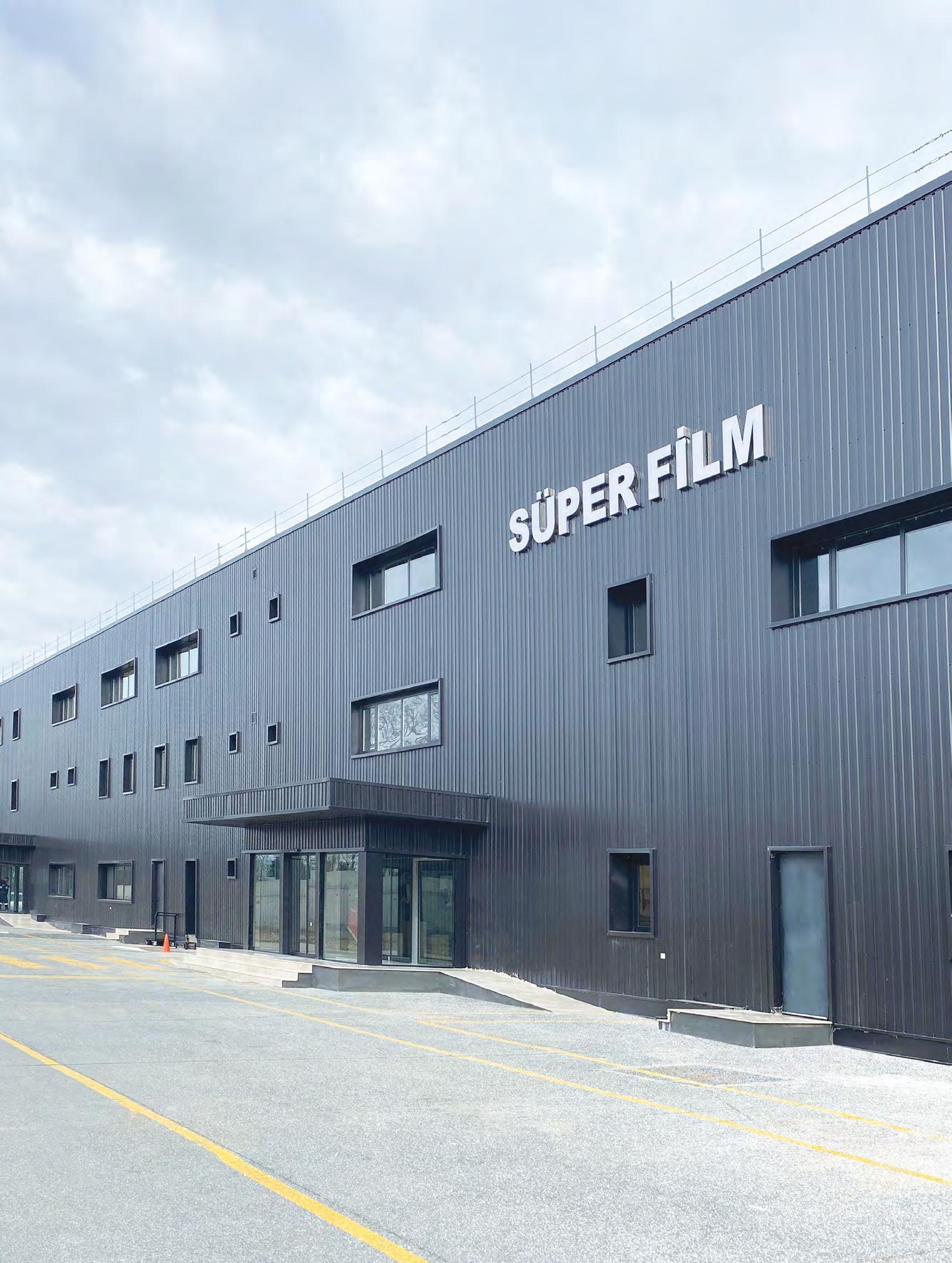


Super Film Packaging - società parte del gruppo Sanko Holding - è oggi tra i primi dieci produttori mondiali di film plastici.
L’azienda si distingue per una visione orientata a innovazione e sostenibilità, offrendo soluzioni a valore aggiunto che rispettano ambiente, dipendenti e clienti. Super Film Packaging fornisce soluzioni di imballaggio per una varietà di prodotti alimentari, etichette, articoli per il personal care e medicale a cui si aggiungono le numerose applicazioni industriali.
Nuovi impianti per una produzione di packaging sostenibile
Oltre agli stabilimenti produttivi per il BOPP, BOPET e CAST situati a Gaziantep (Turchia), la nuova fabbrica di Lüleburgaz permette a Super Film Packaging di raggiungere una capacità produttiva annuale pari a 184.000 tonnellate. Grazie alla linea BOPP di ultima generazione, inoltre, lo stabilimento di Lüleburgaz è il primo sito produttivo a ottenere la certificazione LEED in Turchia.
Packaging sostenibile ad elevate performance
L’azienda ha messo a punto film BOPP resistenti al calore, film con avanzate pro prietà di termosaldabilità, film BOPP e CPP per basse temperature e materiali ad ele vata barriera. Soluzioni che permettono l’uso di strutture mono-PP o mono-PET in alternativa agli imballaggi multimateriale. Inoltre, Super Film Packaging ha completato studi su film BOPP e BOPET con percentuali di riciclato post-consumo (cPCR). I film ottenuti tramite riciclo chimico (a marchio SUPCYCLE e PETCYCLE) presentano proprietà ottiche e meccaniche comparabili a quelle dei film standard e risultano idonei anche per applicazioni alimentari e igienico-sanitarie.


Un’azienda premiata a livello globale per ricerca, sviluppo e innovazione sostenibile
Tra le soluzioni firmate Super Film, una soluzione di film mono-PP con contenuto PCR ha recentemente vinto il World Star Award 2025.
The Turkish player to increase its leading role in the packaging sector
Super Film Packaging - a company of Sanko Holding - is now amongst the world’s Top 10 largest film producers, with a vision to offer added value in innovation, sustainable and value-creating products, while respecting environment, its employees and customers. The company, provides packaging solutions for many food products, various label types, medical and personal care products, and different industrial applications.
New facilities for sustainable packaging production
In addition to BOPP, BOPET and CAST production facilities located in Gaziantep-Türkiye, Super Film Packaging’s new Lüleburgaz factory enabled to reach 184.000 tons of annual production capacity. Thanks to its state-of-art BOPP line, Super Film Lüleburgaz plant has become the first site in Turkey ever to get the LEED certification. A special and continuos focus is devoted to mono-material packaging applications. The company has developed heat-resistant BOPP
L’R&D ha inoltre intensificato lo sviluppo di film realizzati con materie prime rinnovabili utilizzando biopolimeri derivati da alghe per la produzione di film BOPP ibridi e materiali biobased provenienti da oli esausti (a marchio SUPRENEW). L’obiettivo è ridurre di oltre il 60% la dipendenza dei film da risorse fossili, mantenendo inalterate le avanzate proprietà ottiche e meccaniche che caratterizzano i prodotti Super Film. Grazie a un impegno continuo nell’integrare la sostenibilità nei propri processi, Super Film Packaging figura infatti oggi tra il 15% delle aziende con la migliore valutazione nella classifica di Ecovadis, principale auditor indipendente di rating in ambito sostenibilità.
films, films with improved heat seal properties, very low temperature BOPP and CPP films and various films with high barrier properties. All solutions which allow the use of mono-PP or mono-PET structures as an alternative to the multi-material package structures. In addition, Super Film Packaging has completed studies on BOPP and BOPET films containing chemical postconsumer recycled (cPCR) raw materials. The films produced from PCR raw material obtained by chemical recovery (SUPCYCLE and PETCYCLE brands) have similar optical and mechanical properties to standard films and can also be used in food and hygiene applications.
A world star winner company due to R&D and innovation in sustainable solutions Among the Supe Film products, one of
PCR mono PP solution has recently won the World Star Prize in 2025. At the same time Super Film R&D center has accelerated its efforts in developing products using renewable inputs either in the field of Biopolymer-based films, by producing a hybrid BOPP film with biopolymer derived from algae-based resources, or by offering BOPP films (SUPRENEW brand) obtained from bio-based renewable resources such as waste oils. The aim is to reduce the dependence of packaging films on fossil resources by more than 60%, while ensuring that the advanced optical and mechanical properties of the film are maintained. As a result of its continuous efforts to incorporate sustainability into its operations, Super Film Packaging is proud to be amongst the Top 15% of rating by Ecovadis - the leading independent sustainability rating agency.

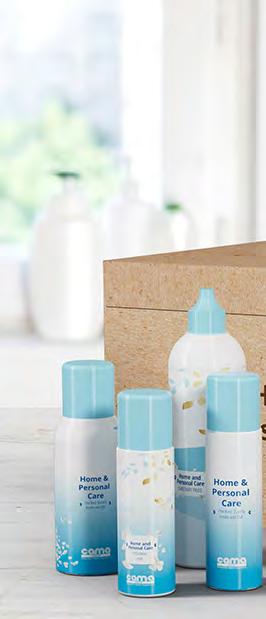
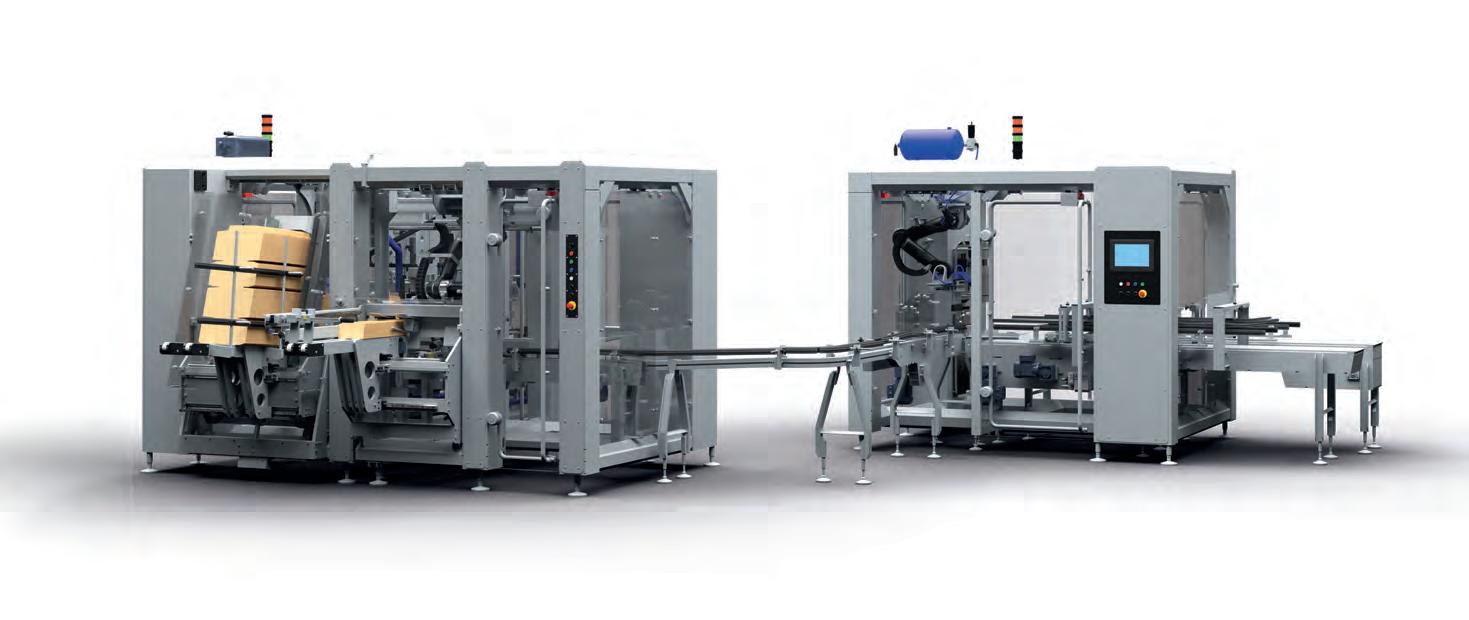
CAMA prosegue il percorso di innovazione sulle sue filiere e presenta le novità a Ipack-Ima.
Pad. 5, stand A17 B18
Un’ampia gamma di macchine, tecnologie, soluzioni robotizzate e la capacità di integrare funzionalità aggiuntive hanno permesso a Cama di supportare importanti player internazionali attivi in tutto il mondo.
Tra queste spicca il recente progetto presso un’azienda para-farmaceutica danese che produce un’ampia varietà di soluzioni medicali per uso ospedaliero e domestico. Il cliente era infatti alla ricerca di una tecnologia flessibile per l’imballaggio secondario in grado di confezionare in spazi ridotti quattro aerosol/bottiglie di dimensioni diverse: due da 50 ml e due da 75 e 240 ml.
La risposta di CAMA
Durante il funzionamento, in un’unità di scarico CAMA, le scatole RSC vengono aperte manualmente e caricate su un nastro trasportatore di ingresso, dove un sistema di visione ne rileva il contenuto. Un robot a tre assi preleva quindi gli aerosol dalla scatola e li colloca su un nastro trasportatore di accumulo. Il sistema di visione è fondamentale in questa fase per evitare il posizionamento casuale. I prodotti passano quindi ad un’unità
di etichettatura e codifica e relativo sistema di controllo qualità che verifica anche l’applicazione e la leggibilità, grazie a un sistema di visione dedicato a doppia telecamera. Una volta etichettati, i prodotti vengono poi trasportati e suddivisi nel gruppo di confezionamento desiderato, prima di entrare nell’incartonatrice, dove vengono aggiunti gli intercalari verticali (se necessari), prima che il gruppo completo venga spinto in una scatola wraparound pre-allestita. Dopo il carico, le scatole vengono trasferite a una stazione di piegatura dei lembi e fissate con hot-melt prima di essere trasportate all’uscita della macchina
La componente di automazione
L’integrazione di tre robot RB 003 CAMA di nuova generazione ha valorizzato il sistema in termini di prestazione e flessibilità, mantenendo il sistema compatto. CAMA ha implementato la serie ACL (Automatic Carton Loading): la linea sarà equipaggiata da un robot collaborativo per il carico dei fustellati per rendere la linea ancora più tecnologica e customizzata sulle esigenze dei partner.
A Ipack-Ima appuntamento con l’innovazione
Ogni applicazione di packaging presenta una serie di sfide uniche, per cui un portafoglio completo di tecnologie CAMA, insieme a una significativa esperienza multisettoriale, sono essenziali per offrire soluzioni personalizzate che i visitatori possono toccare con mano visitando il Pad 5, stand A17 B18.

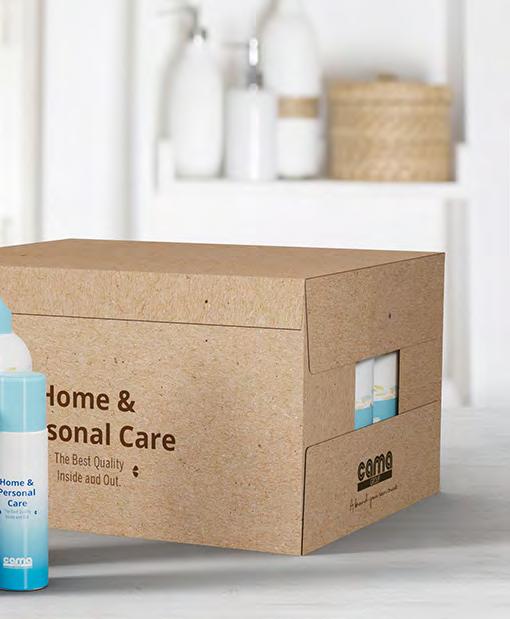
CAMA goes ahead adding value while remaining focused on its supply chain with new technologies showcased at Ipack-Ima. Hall 5, booth A17 B18
Cama Group the expert Italian company that offers customised solutions in the field of secondary packaging lines. The company has successfully helped worldwide companies achieve significant results, by offering a wide range of machines and technologies, robotic solutions, and the ability to integrate numerous additional functionalities and third-party technologies.
Flexible technology for the parapharmaceutical sector CAMA capabilities were perfectly in evidence on a recent project at a Danish parapharmaceutical company. Producing a wide variety of medical solutions for hospital and home use, the company was looking for flexible secondary packaging technology that would enable it to package in small spaces four aerosol/bottle sizes: two 50 ml and two 75 and 240 ml.
The technical solution by CAMA
During operation, in a CAMA unloading unit, RSC boxes are manually opened and loaded onto an infeed conveyor belt, where a vision system detects their contents. A three-axis robot then removes the aerosols from the
box and places them on an accumulation conveyor belt. The vision system is crucial at this stage to avoid random positioning.
The products are then passed to a labelling and coding unit and its quality control system, which also checks the application and readability, thanks to a dedicated dual-camera vision system. The labelled products are then transported and sorted into the desired pack, before entering the case packer, where vertical dividers are added (if required), before the whole pack is pushed into a pre-packed wraparound box. After loading, the boxes are transferred to a flap-folding station and sealed closed with hot-melt glue before being transported to the machine outfeed.
The automation
The integration of three latestgeneration CAMA RB 003 robots has enhanced the system in terms of performance and flexibility, while remaining extremely compact.
CAMA has implemented ACL (Automatic Carton Loading) series: the line will be equipped with a collaborative robot for loading the box blanks, making its technology even leaner and more customised to partners’ needs.
Meeting innovation at Ipack-Ima 2025
Every packaging application presents a unique set of challenges, so CAMA offers the key essentials to a comprehensive range of solutions and technologies which are available at Hall 5, booth A17 B18 in order to discover the vast range of multiindustry customised solutions.

Vancom Imballaggi è specializzata nella progettazione e costruzione di imballaggi in legno su misura per il trasporto di prodotti industriali. L’azienda con un’esperienza di 35 anni nel settore degli imballaggi, è in grado di fornire un servizio a 360° che include il rilievo dimensionale, la progettazione tecnica dell’imballo secondo la normativa UNI9151, la produzione del packaging su misura, le operazioni di imballaggio e il trasporto.
Via delle Tre Venezie, 15
26010 Casaletto Vaprio (CR) www.vancomimballaggi.it
mail: info@vancomimballaggi.com







A Ipack-Ima l’azienda presenta
le sue ultime innovazioni, soluzioni all’avanguardia per ottimizzare le linee di confezionamento.
Pad. 7, stand C09

Da oltre sessant’anni, CT Pack è un punto di riferimento nel settore del packaging con soluzioni complete che coprono l’intero processo, dal packaging primario, secondario e terziario fino alla pallettizzazione. CT Pack è specializzata nella fornitura di sistemi integrati ad alte prestazioni, progettati principalmente per l’industria alimentare e non solo, garantendo massima efficienza, precisione e affidabilità in ogni fase della produzione.
Ingegnerizzazione di soluzioni customizzate
Con sede a Ferrara, in Italia, CT Pack si fonda su una solida tradizione ingegneristica in continua evoluzione per rispondere alle esigenze di un mercato sempre più dinamico e competitivo. Grazie alla sua esperienza, l’azienda opera in diversi settori, adattando le proprie
soluzioni alle specifiche necessità dei diversi mercati in cui opera. Questa flessibilità, unita a un forte orientamento all’innovazione, ha reso CT Pack un partner di fiducia per i produttori a livello globale.
Vicini ai clienti ovunque nel mondo
Oggi, CT Pack è riconosciuta come leader nell’automazione del packaging, offrendo un’ampia gamma di soluzioni che combinano innovazione tecnologica e una profonda conoscenza delle tendenze di mercato.
Anticipando i cambiamenti del settore e investendo costantemente in ricerca e sviluppo, l’azienda ha rafforzato la propria presenza internazionale con filiali in Messico, Stati Uniti e Cina. Si tratta di sedi strategiche che consentono a CT Pack di garantire un supporto locale efficace e tempi di risposta rapidi, assicurando un servizio ottimale ovunque operino i clienti.
Una gamma completa
Il vasto portafoglio di CT Pack copre l’intera linea di confezionamento, dalle macchine di processo avanzate, come miscelatori e tappatrici, alla gestione ad alta velocità di prodotti sfusi, fino ai sistemi di inscatolamento e pallettizzazione. Tra le soluzioni più avanzate spiccano i sistemi robotizzati per la movimentazione, progettati per garantire massima velocità e precisione, confezionatrici flow-pack orizzontali ad alta velocità per una protezione superiore del prodotto e soluzioni modulari per l’inscatolamento, facilmente adattabili a diversi formati e richieste produttive. A completare l’offerta, una gamma di macchine per il confezionamento in casse e la pallettizzazione, perfettamente integrabili nelle linee esistenti per garantire elevata produttività, scalabilità e ottimizzazione dei flussi produttivi.
L’impegno costante nella ricerca e sviluppo guida l’innovazione di CT Pack, migliorando le prestazioni delle macchine con particolare attenzione alla sostenibilità e all’efficienza energetica. L’integrazione di tecnologie digitali e sistemi di automazione avanzati consente ai clienti di aumentare la competitività e ottimizzare i processi produttivi.


At Ipack-Ima, the company unveils its latest innovations, cuttingedge solutions to optimize packaging lines. Hall 7, Booth C09
For over sixty years, CT Pack has been a benchmark in the packaging industry, offering end-to-end solutions that cover the entire process from primary, secondary, and tertiary packaging to palletizing. The company specializes in delivering integrated, high-performance systems tailored to the food sector and beyond, ensuring maximum efficiency,
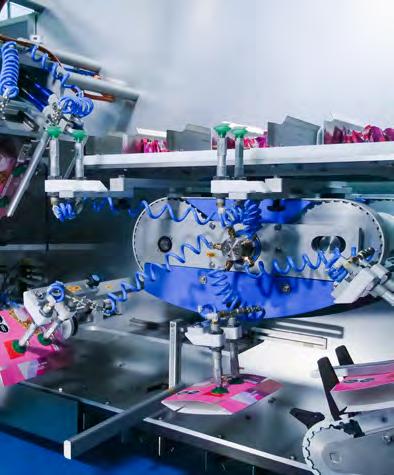
precision, and reliability in every phase of production.
Design of customized lines
Headquartered in Ferrara, Italy, CT Pack is built on a strong engineering tradition that continuously evolves to meet the demands of an increasingly dynamic and competitive market. The company’s expertise extends across multiple industries, adapting its solutions to the unique needs of each sector. This flexibility, combined with a strong focus on innovation, has positioned CT Pack as a trusted partner for global manufacturers.
Today, CT Pack is recognized as a leader in packaging automation, offering a comprehensive range of solutions that merge technological innovation with a deep understanding of market trends. By anticipating industry shifts and investing in research and development, the company has solidified its global presence, establishing subsidiaries in Mexico, the United States, and China. These strategic locations enable CT Pack to provide localized support and fast response times, ensuring that customers receive optimal service wherever they operate.
A full range of solutions
CT Pack’s extensive portfolio spans the entire production line, from advanced process machines, like mixers and cappers, to high-speed naked product handling, boxing, and palletizing systems. Among its most advanced solutions are robotic handling systems, designed for maximum speed and precision, high-speed horizontal flow wrappers that ensure superior product protection, and modular boxing solutions that easily adapt to different formats and production demands. These technologies are complemented by a range of case packing and palletizing machines that integrate seamlessly into existing lines, guaranteeing high productivity, scalability and optimize production workflows.
A strong commitment to research and development drives CT Pack’s continuous innovation, enhancing machine performance with a focus on sustainability and energy efficiency. The integration of digital technologies and advanced automation systems empowers customers to boost competitiveness and optimize production processes.

Welcome to Gampack, your trusted partner for secondary packaging machines and complete, fully integrated endof-line solutions.
GAMPACK invests the 5% of its turnover in R&D in order to find the best and most suitable solutions with its team of experienced engineers, continually looking for new and stimulating milestones and with a constant eye towards the future.
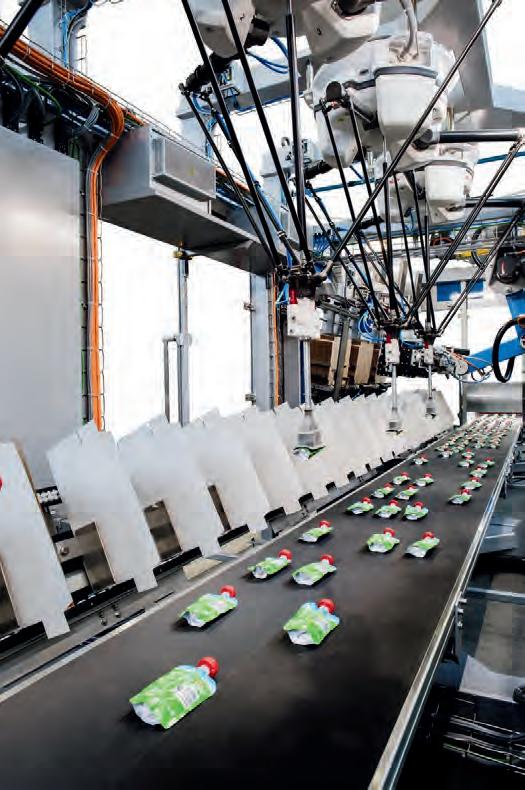


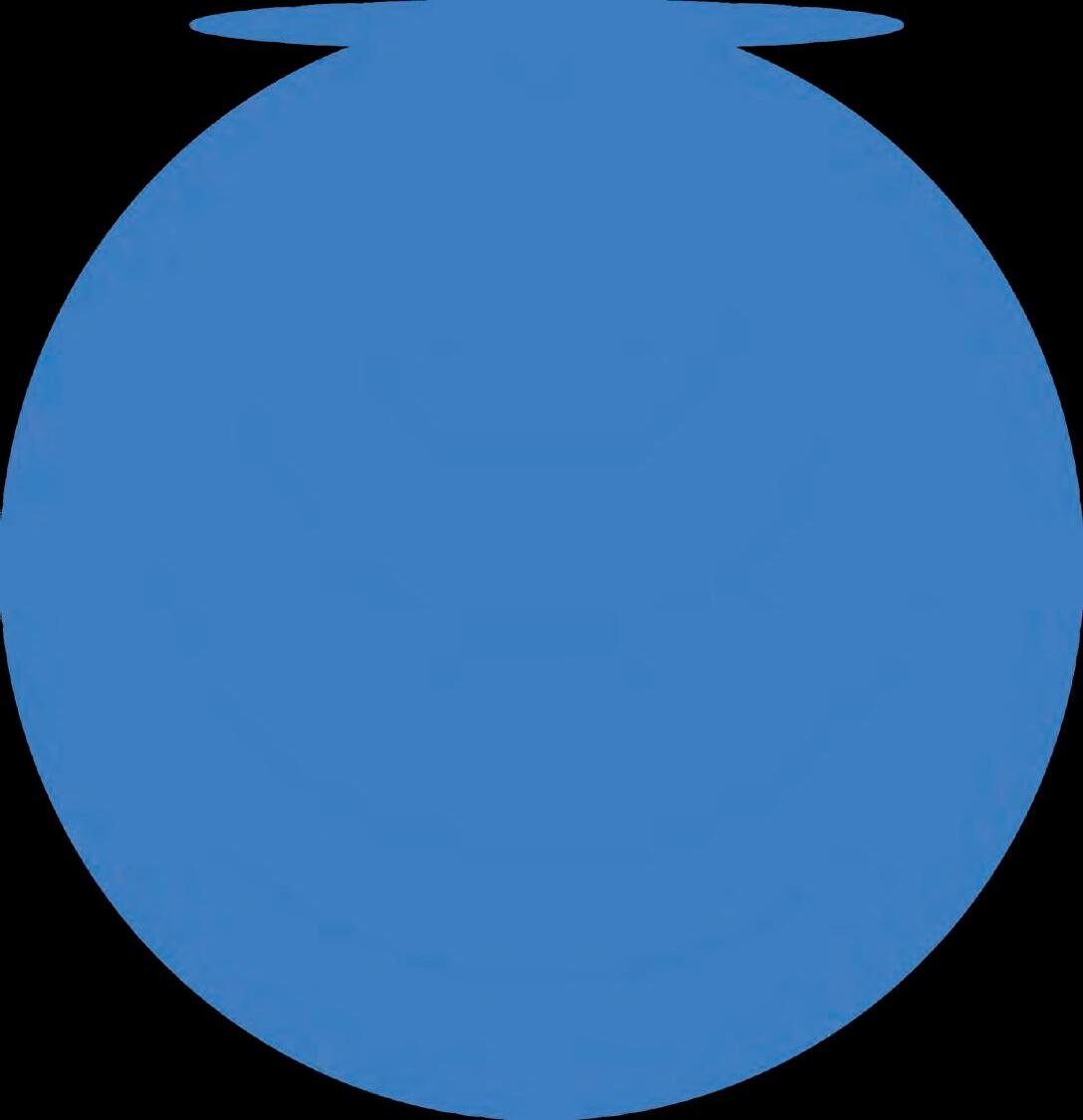
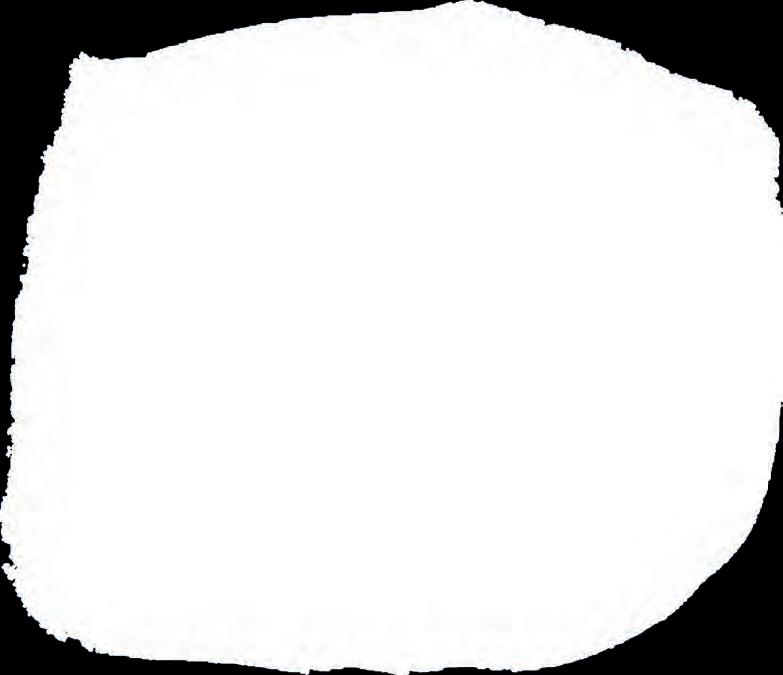
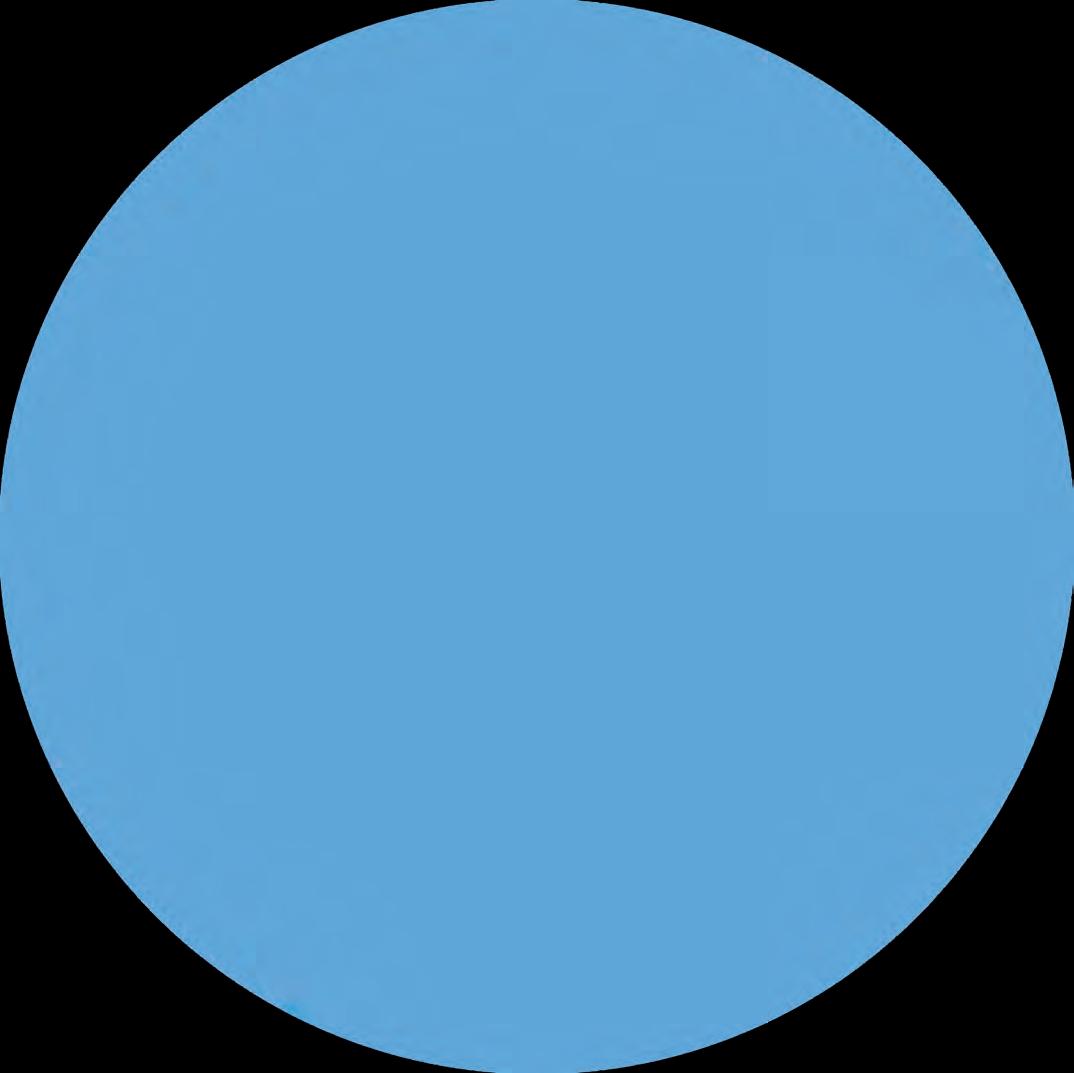


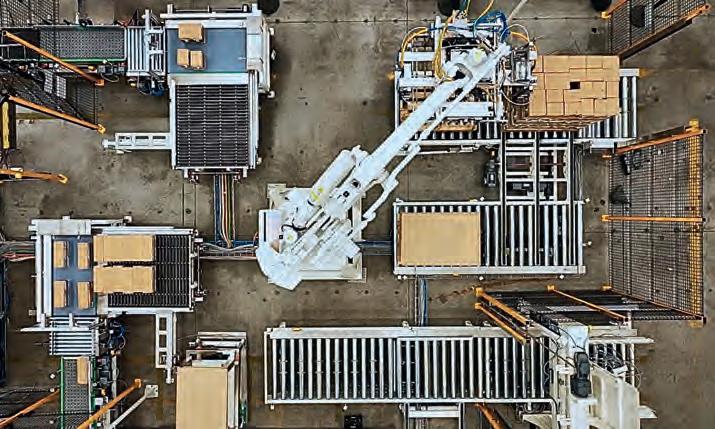






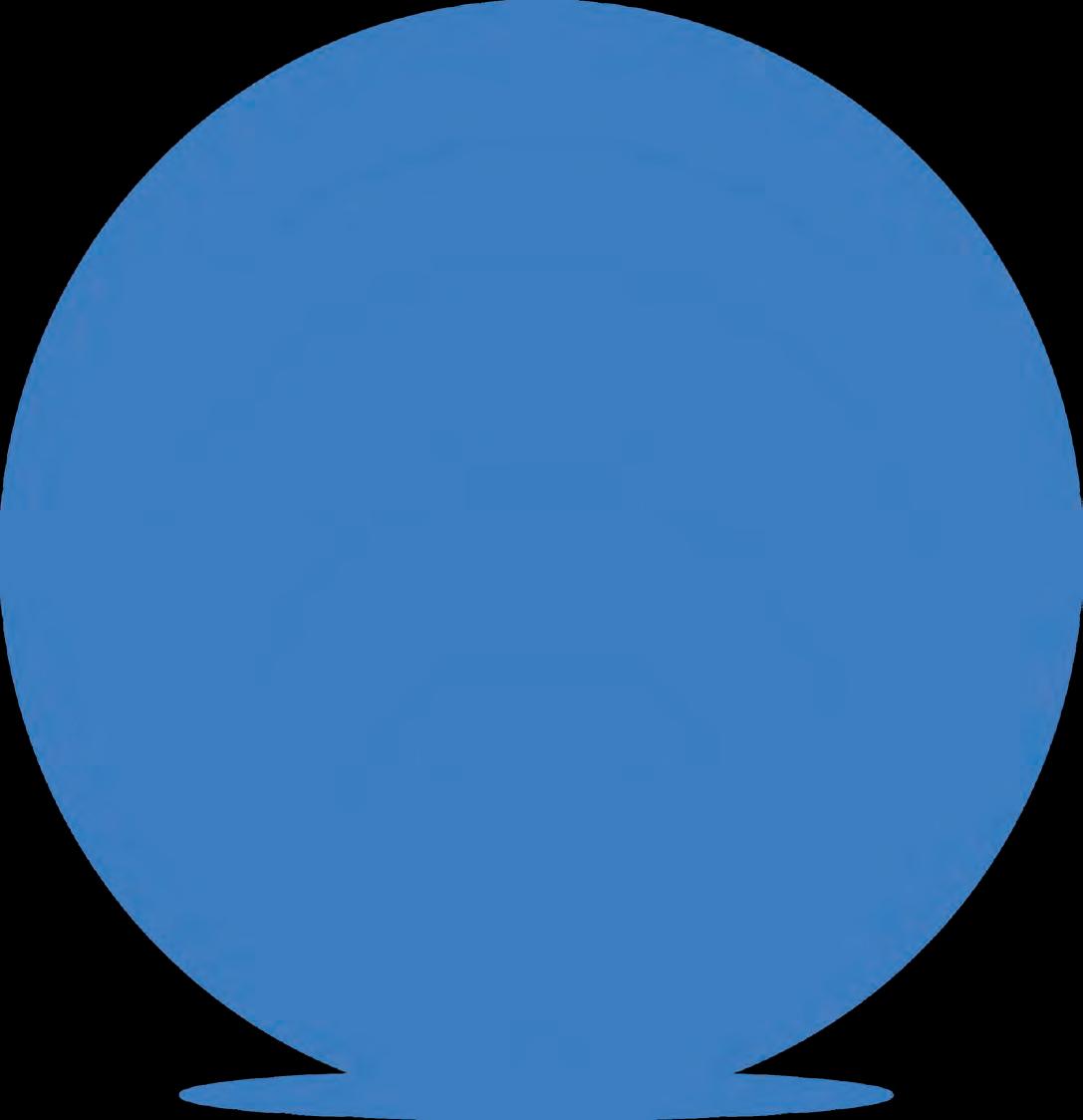



Ipack-Ima Gampack
ampack conferma la propria vocazione all’innovazione presentando soluzioni integrate per il confezionamento secondario e terziario, pensate per rispondere alle nuove e più diversificate esigenze del settore. A Ipack-Ima il focus è quindi su flessibilità, digitalizzazione e sostenibilità, leve decisive per affrontare mercati in rapida evoluzione, oltre ad essere i pilastri delle nuove proposte tecnologiche presentate
Le nuove macchine firmate Gampack sono progettate per una piena integrazione sulle linee ad alta produttività, grazie a un’architettura modulare che semplifica il cambio formato e l’adattamento a diversi tipi di prodotto. I layout compatti e la rapida installazione rendono le soluzioni Gampack ideali anche per impianti produttivi già saturi, dove l’ottimizzazione degli spazi e dei tempi è fondamentale.
Un altro elemento distintivo è la digitalizzazione evoluta: le linee sono dotate di software intelligenti, sviluppati in house e sistemi di diagnostica remota che permettono il controllo a distanza, anche in impianti distribuiti su scala globale. L’uso dell’Intelligenza Artificiale consente di analizzare i dati di produzione in tempo reale, supportando la manutenzione preventiva e l’ottimizzazione delle performance.
Un unico interlocutore per soluzioni complete
Dal progetto al post-vendita: il mercato richiede sempre più linee “chiavi in mano”, dal primario al fine linea, che garantiscano coerenza progettuale e un unico interlocutore tecnico. Gampack risponde con un servizio di assistenza definito il suo “fiore all’oc chiello”: tempestivo, personalizzato, orientato a ridurre i tempi di fermo e semplificare la gestione dell’intero impianto.

Sostenibilità: riduzione dei consumi e compattezza
Non manca l’attenzione all’ambiente con la “serie green” di Gampack presente a IPACK IMA con un insieme di soluzioni ecosostenibili che riducono sia le dimensioni dei macchinari che l’uso di materiali plastici per rispondere alle nuove esigenze di GDO, discount e retail. La gamma comprende soluzioni come Mini Tray, I-Layer, Eco Label, progettate per ridurre o eliminare interamente l’uso di plastica senza rinunciare a funzionalità e appeal dei prodotti a scaffale. L’applicazione di componenti a basso consumo energetico e di motori ad alta efficienza conferma l’impegno dell’azienda verso un’industria più responsabile. La direzione è chiara: meno plastica, più efficienza, controllo intelligente e soluzioni integrate. Con un occhio attento alle esigenze dei grandi player e l’altro rivolto a un futuro più sostenibile, Gampack si conferma partner strategico per il packaging di domani.
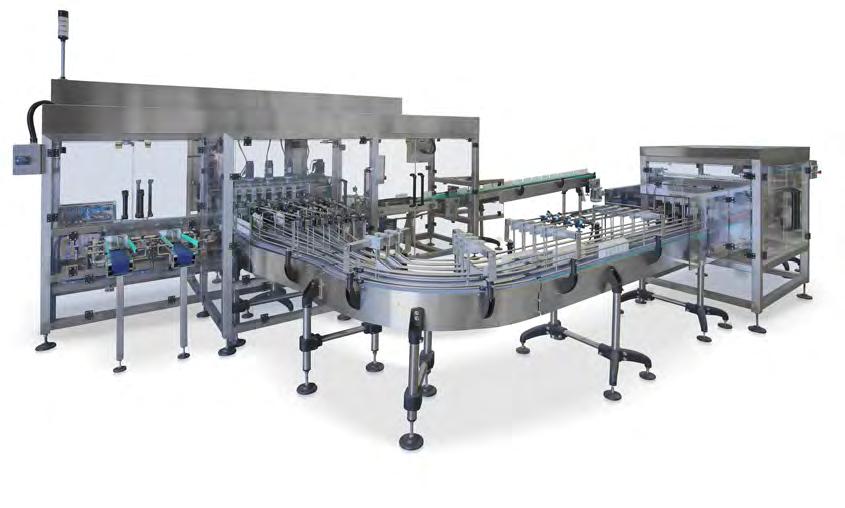
Gampack sarà presente anche a Gulfood Manufacturing, Dubai, dal 4 al 6 novembre 2025.

Gampack confirms its vocation for innovation by presenting integrated solutions for secondary and tertiary packaging, designed to meet the new, increasingly diversified needs of the industry. At Ipack-Ima the focus will be on flexibility, digitalization and sustainability: decisive levers for dealing with rapidly changing markets, as well as the pillars of the new technological proposals presented at the trade show.
Versatility, integration and digitalization
Gampack’s new machines are designed for full integration on high-productivity lines thanks to a modular architecture that simplifies size changeover and adaptation to different product types. Compact
footprints and quick installation also make Gampack solutions ideal for production facilities that are already saturated, where optimization of space and time is critical. Another stand-out feature is advanced digitalization: lines are equipped with intelligent software, developed in-house, and remote diagnostic systems that enable remote control, even in globally distributed plants. The use of Artificial Intelligence enables real-time analysis of production data, supporting preventive maintenance and performance optimization.
A single point of contact for comprehensive solutions From design to after-sales: the market increasingly demands
turnkey solutions, from primary to end-of-line, able to guarantee design consistency and a single technical point of contact. Gampack responds to this need with its flagship assistance service: timely, customized and geared toward reducing downtime and simplifying management of the entire plant.
Sustainability: reduced consumption and compactness
Attention to the environment is guaranteed with Gampack’s “green series”, featured at IPACK IMA and offering a set of eco-sustainable solutions that reduce both machinery size and the use of plastic materials, to meet the new needs of large-scale distribution, discount stores and retail. The range includes solutions







such as Mini Tray, I-Layer, and Eco Label, designed to reduce or eliminate the use of plastic, without compromising on the functionality and shelf appeal of products. The application of energy-efficient components and high-efficiency motors confirms the company’s commitment to a more responsible industry.
The road ahead is clear: less plastic, more efficiency, intelligent control and integrated solutions. With a careful eye on both the needs of large players and a more sustainable future, Gampack confirms its role as a strategic partner for tomorrow’s packaging.

Meet Gampack also at Gulfood Manufacturing, to be held in Dubai, from 4 to 6 November 2025.






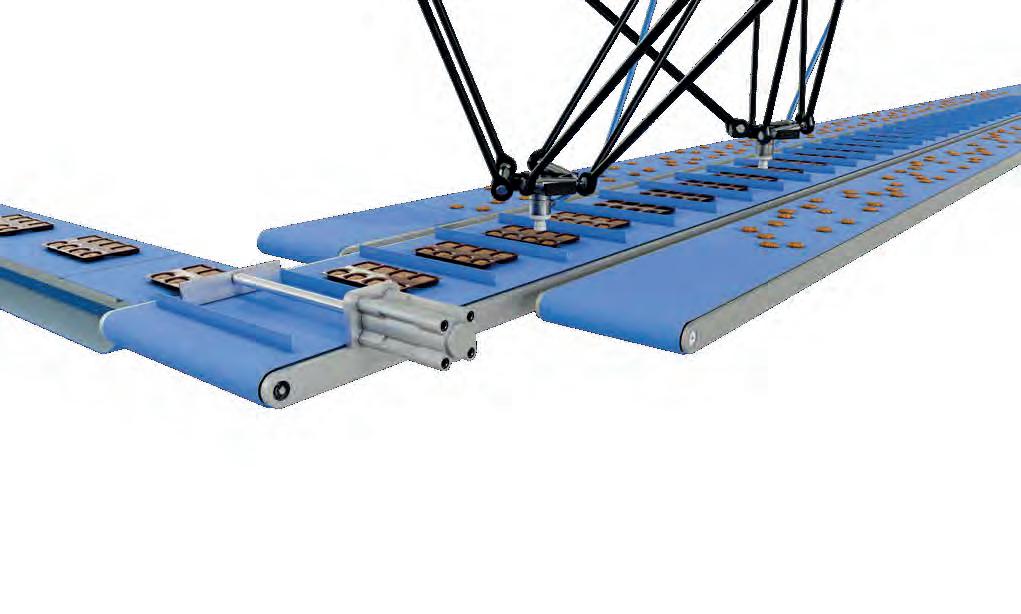



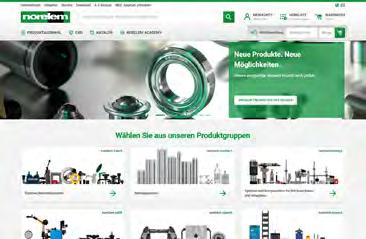








































Marchesini Group
Macchine all’avanguardia per l’industria farmaceutica e cosmetica in mostra a Pharmintech
powered by Ipack-Ima Pad. 2, stand A26 B25
Leader negli impianti di confezionamento per l’industria farmaceutica e cosmetica, Marchesini Group, partecipa all’edizione 2025 di Pharmintech powered by Ipack-Ima, la fiera dedicata alle innovazioni e soluzioni di processo e confezionamento in programma a Milano dal 27 al 30 maggio 2025.
L’appuntamento è un’occasione di confronto e networking per Marchesini Group che guarda al 2025 con cauto ottimismo, dopo il buon risultato del 2024 che si è chiuso con un fatturato consolidato di oltre 600 milioni.
Soluzioni per il farmaceutico
Tra le proposte presenti allo stand, un’ampia gamma di soluzioni per l’industria farmaceutica e cosmetica: dalle macchine per il processo al confezionamento primario di prodotti solidi, liquidi e in polvere con un corner dedicato anche alle tecnologie digital.
Per quanto riguarda il business farmaceutico, due i focus principali: da un lato le soluzioni per il riempimento di prodotti in polvere, sul quale il Gruppo sta puntando molto nell’ultimo periodo grazie all’integrazione del marchio MAR; dall’altro le tecnologie legate al processo con il marchio Dumek, sempre più orientato alla produzione farmaceutica e al rispetto quindi delle normative che disciplinano questo settore.
LA PAROLA AI PROTAGONISTI
“Siamo soddisfatti dei risultati ottenuti lo scorso anno. Il Gruppo infatti ha continuato stabilmente a crescere - commenta Valerio Soli, AD di Marchesini Group - e puntiamo a raggiungere nel medio breve termine il miliardo di fatturato attraverso ulteriori acquisizioni e opportunità di business in nuove aree geografiche. Nell’ottica di offrire linee sempre più complete e integrate ai nostri clienti, abbiamo deciso di esporre in fiera a Milano alcuni modelli di macchine in grado di confezionare diverse tipologie di farmaci e cosmetici, senza dimenticare i servizi digital con protagonista l’intelligenza artificiale.”

Visibili sullo stand, inoltre, una macchina riempitrice pol veri con tecnologia di riempimento a disco vuoto-pressione e IPC 100% e un turboemul sionatore sottovuoto per il processo di prodot ti liquidi o cremosi, caratterizzato da un siste ma interattivo che lascia intravedere le varie fasi di produzione.
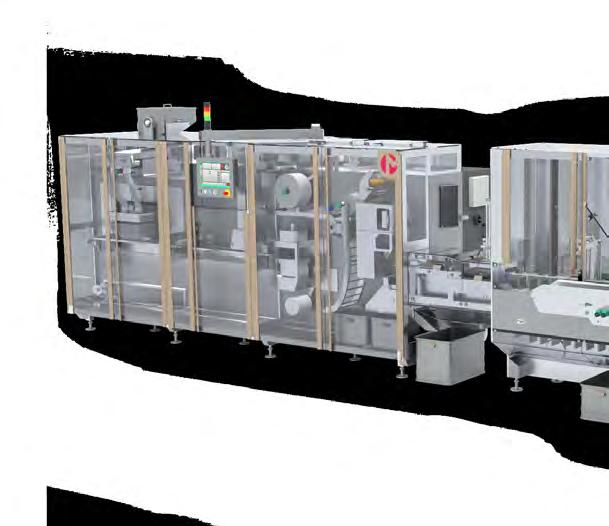
Spazio anche a una monoblocco per il confezionamento di prodotti in blister con integrata la nuova astucciatrice alternata in grado di macchinare un’ampia gamma di formati ad una velocità massima di 150 pezzi al minuto. Completano l’offerta anche una selezione di macchine da laboratorio targate Dott. Bonapace che includono: una linea completa di riempimento, raffreddamento, codifica e sigillatura di ovuli e supposte; una incapsulatrice, una blisteratrice semi-automatica con tre stazioni indipendenti per termoformatura, sigillatura e taglio ed una comprimitrice rotativa.
Spazio al beauty
Quanto al business cosmetico, la Beauty Division è rappresentata da una linea per tubetti, prima riempiti e chiusi da un’intubettatrice di Axomatic, poi adagiati in astuccio dall’astucciatrice orizzontale a movimento alternato di V2 engineering. In mostra anche una linea, sviluppata dalla collaborazione tra marchi Vibrotech e Axomatic, composta da un sistema di alimentazione robotizzato perfettamente integrato con una macchina di riempimento e tappatura per flaconi stabili.
Tra digitalizzazione e visione industriale
Spazio infine alle tecnologie della divisione
Digital (tra cui la manutenzione predittiva, il Customer Portal e il cambio formato in realtà aumentata), ma anche ai sistemi di visione di SEA Vision che festeggia in fiera i suoi 30 anni di esperienza nel settore.

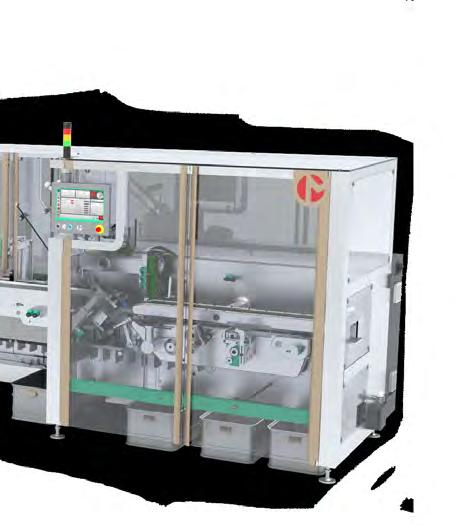
Marchesini Group showcases at Pharmintech powered by Ipack-Ima various machines for the cosmetic and pharmaceutical industry Hall 2, booth A26 B25
looking towards 2025 with cautious optimism after the good results of 2024, which saw consolidated turnover of over 600 million Euros.
“We are satisfied with the results achieved last year; the Group has continued to grow steadily,” commented Valerio Soli, CEO of Marchesini Group. “We aim to reach a billion Euros of revenue in the medium-short term through further acquisitions and business opportunities in new geographical areas. With the goal of offering increasingly complete and integrated lines to our customers, we have decided to showcase in Milan some machine models which are capable of packaging various types of drugs and cosmetics, without neglecting our digital services featuring artificial intelligence.”
Marchesini Group, a leader in packaging machinery for the pharmaceutical and cosmetics industry, will be exhibiting at the upcoming edition of Pharmintech powered by Ipack-Ima, the exhibition dedicated to innovations and solutions in processing and packaging, being held in Milan, Italy from May 27 to 30, 2025. The trade fair is an opportunity for Marchesini Group to engage in discussions and networking,
At Pharmintech powered by Ipack-Ima, the Group showcases a wide range of solutions for the pharmaceutical and cosmetics industry: from processing machines to primary packaging of solid, liquid, and powder products, with a corner dedicated to digital technologies. With regard to the pharmaceutical business, the main focuses are two: on the one hand, solutions for powder filling, which the Group has been emphasizing recently thanks to the integration of the MAR brand; on the other hand, process technologies with the Dumek brand, increasingly oriented towards pharmaceutical production and compliance with sector regulations. On display at the stand powder filling machine with vacuumpressure disk filling technology and
100% IPC, and a vacuum turboemulsifier for processing liquid or cream products, featuring an interactive system that shows off the various production phases. On the stage also a monoblock for blister packaging integrated with the new alternating cartoner, capable of handling a wide range of formats at a maximum speed of 150 pieces per minute. Rounding off the offering a selection of Dott. Bonapace branded laboratory machines, including a complete line for filling, cooling, and sealing ovules and suppositories; as well as a capsule filler and a rotary tablet press.
The beauty sector at stage As regards the cosmetics sector, on the other hand, the Beauty Division will be showcasing a line for tubes,
first filled and closed by an Axomatic tube filler, then placed in cartons by the V2 engineering horizontal alternating motion cartoner. Also on display a line developed through the collaboration between the Vibrotech and Axomatic brands, consisting of a robotic feeding system perfectly integrated with a linear filling and capping machine for stable bottles.
Digitalisation and industrial vision technology
The technologies of the Digital division (including predictive maintenance, the Customer Portal, and augmented reality format change) will also be featured, along with vision systems from SEA Vision, celebrating its 30 years of experience in the sector at the stand.
Ti interessa?
Richiedi ora il tuo campione gratuito




Sidel

In fiera la gamma di linee complete e fine linea Pad. 7, stand C91
Sidel punta i riflettori sulle soluzioni di confezionamento avanzate per la linea completa e il fine linea, ideate per potenziare la redditività, la sostenibilità e l’efficienza operativa dei produttori dei settori food and beverage e home and personal care.
Massima efficienza e soluzioni
“chiavi in mano”
Protagoniste a Ipack Ima, le linee complete “chiavi in mano” di Sidel che definiscono un nuovo livello di efficienza per i produttori di alimenti, bevande e prodotti per la cura della casa e della persona. Si tratta di sistemi totalmente integrati che ottimizzano le performance e la flessibilità garantendo qualità del prodotto e sicurezza alimentare oltre a promuovere l’uso di packaging future-ready in linea con gli obiettivi di economia circolare.
Dal concept all’installazione, infatti, il vasto know-how di Sidel in materia di progettazione tecnica e integrazione assicura una produzione ininterrotta, con risultati affidabili per tutte le tipologie di packaging che si tratti di vetro, lattine, PET, sia monouso che a rendere, per bevande e altri formati di imballaggio primario.
Sidel mette in campo un team dedicato che lavora a stretto contatto con i clienti con l’obiettivo di offrire soluzioni personalizzate
capaci di potenziare la produttività, ridurre i tempi di fermo e adattarsi alle richieste del mercato.
Soluzioni innovative per l’incartonamento e la pallettizzazione
Tra le novità in fiera, le soluzioni per incartonamento e pallettizzazione per imballaggi primari come bottiglie, vasetti, lattine, barattoli e cartoni. A questi si aggiunge una gamma di soluzioni per il confezionamento secondario come casse RSC, wrap-around, packaging shelf-ready e pellicola, sistemi progettati per potenziare al massimo flessibilità, semplicità e affidabilità, aiutando i produttori a ridurre il TCO (Total Cost of Ownership) senza abbassare le performance.
Grande adattabilità
A Ipack-Ima, Sidel presenta una gamma di soluzioni di confezionamento adattabili a un’ampia varietà di prodotti e dimensioni: in mostra tecnologia con caricamento dall’alto, dal basso o laterale oltre a sistemi pick-and-place e wraparound. Le tecnologie di pallettizzazione di Sidel, dai modelli tradizionali alle soluzioni robotiche e cobotiche, si allineano perfettamente ai flussi di produzione e all’assortimento di SKU - Stock Keeping Unit -, gestendo in modo efficiente pallet e interfalda pieni o vuoti.


At Ipack-Ima, the range of complete and end-of-line solutions on show in Hall 7, booth C91
Sidel shines the spotlight on advanced complete-line and end-of-line packaging solutions, designed to enhance profitability, sustainability and operational efficiency for manufacturers in the food and beverage and home and personal care sectors.
Showcased at Ipack Ima, Sidel’s complete turnkey lines take efficiency to new heights for manufacturers of food, beverage, and home and personal care products. These fully integrated systems optimize performance and flexibility while ensuring product quality and food safety, as well as promoting the use of future-ready packaging in line with circular economy goals.
From concept to installation, Sidel’s extensive know-how regarding technical design and integration ensures uninterrupted production with reliable results for all types of packaging: glass, cans, PET, both disposable and returnable, for beverages and other primary packaging formats.
Sidel’s dedicated team works closely with customers to offer customized solutions able to enhance productivity, reduce downtime and adapt to market demands.
Innovative solutions for case packing and palletizing
The new products on show include packing and palletizing solutions for primary packaging such as bottles, jars, cans, tins and cartons. These are complemented by a range of secondary packaging solutions such as RSC cases, wrap-around packaging, shelf-ready packaging, and film, systems designed to maximize flexibility, simplicity, and reliability, helping manufacturers
reduce TCO (Total Cost of Ownership) without impacting performance.
To sum up
At Ipack-Ima, Sidel is presenting a range of packaging solutions that can be adapted to a wide variety of products and sizes: showcasing top- bottom or side-loading technology as well as pick-andplace and wrap-around systems. Sidel’s palletizing technologies, from traditional models to robotic and cobotic solutions, align seamlessly with production flows and SKU (Stock Keeping Unit) assortment, efficiently managing full or empty pallets and interlayers.




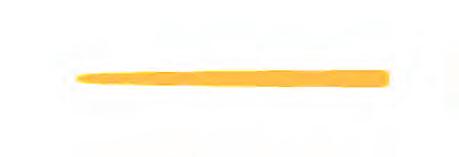
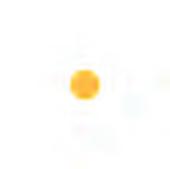
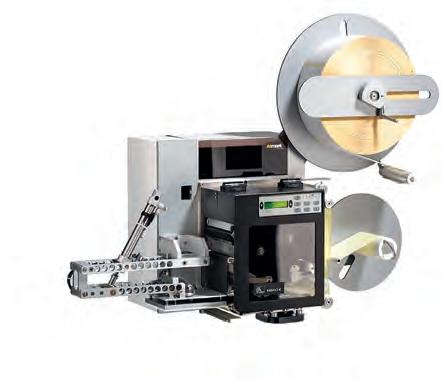




Dal 27 al 30 maggio 2025 saremo presenti in fiera per mostrarvi - per la prima volta - la nostra grande ultima innovazione: Nicetuck. Saremo al Padiglione 5 Stand C57-D58 per rispondere a qualsiasi domanda e per fornirvi tutte le informazioni necessarie. Vi aspettiamo!
PATENT PENDING BY


Tiber Pack
Ipack -Ima la tecnologia
Nicetuck di Tiber Pack è finalista al Best
Packaging 2025.
Pad 5, stand C57 D58
Con oltre 50 anni di esperienza nel settore del fine linea, Tiber Pack SpA presenta l’impianto Nicetuck, una soluzione capace di rivoluzionare l’incartonamento in termini economici ed ecologici.
L’impronta di Tiber Pack
“Ogni scelta che facciamo è un’impronta che lasciamo”: questo il claim che caratterizza l’approccio alla sostenibilità di Tiber Pack che guarda all’ambiente, al rispetto e alla salvaguardia della natura eliminando colle e adesivi grazie a un concetto di innovazione invisibile, ma capace di fare la differenza.
Il futuro è a Ipack-Ima 2025
Ad attendere clienti e visitatori allo stand Tiber Pack - padiglione 5 C57 D58 - il nuovo impianto con tecnologia brevetta Nicetuck, una soluzione capace di rivoluzionare il mondo del fine linea. Già in funzione presso lo stabilimento produttivo di Amica chips, primo buyer di questo sistema innovativo, Nicetuck è un prodotto di successo, subito sposato con entusiasmo da altri importanti clienti internazionali e selezionato tra i finalisti del “Best packaging 2025” promosso dall’Istituto italiano imballaggio.
Qualità certificata
Le prestazioni dell’imballo Nicetuck in termini di protezione del prodotto e di trasportabilità sono state verificate da test di laboratorio condotti dall’Istituto di ricerca Lucense presso la divisione Centro Qualità della Carta.
Sostenibilità: nice to meet you!
Questo lo slogan Nicetuck promosso da Tiber Pack per supportare i propri clienti nel mantenimento di elevati standard qualitativi del packaging e del prodotto senza dimenticare l’importanza di un futuro più green, sostenibile e Nice dove Nicetuck rappresenta la scelta ideale.

I vantaggi di Nicetuck
Allo stand Tiber Pack i tecnici commerciali sono pronti ad accompagnare i visitatori alla scoperta dell’innovazione e dei numerosi vantaggi che Nicetuck può portare alle linee produttive.
• eliminazione del costo di acquisto, trasporto e stoccaggio delle colle
• riduzione del 25% - 30% di energia elettrica
• assenza dei costi di manutenzione e pulizia degli impianti hot-melt
• riduzione del 50% per le emissioni di CO2. Valutato attraverso uno studio LCA comparativo condotto da TUV Italia. I risultati hanno inoltre evidenziato l’importante abbattimento di numerosi altri fattori che contribuiscono all’impatto ambientale dei processi produttivi e logistici
• rafforzamento del ruolo dei clienti Tiber Pack come protagonisti della rivoluzione green.



At Ipack-Ima the patented Nicetuck technology: a finalist for Best Packaging 2025. Hall 5, booth C57 - D58
Tiber Pack spa, with more than 50 years of experience in the end-ofline sector, presents Nicetuck: a revolution in case packing, in economic and ecological terms.
Tiber Pack’s footprint “Every choice we make is a footprint we leave behind” sums up Tiber Pack’s approach to environmental sustainability, which respects and preserves nature by eliminating glues and adhesives, thanks to a concept of invisible innovation that makes a difference.
The future is at Ipack-Ima 2025 Customers and visitors to the Tiber Pack booth - Hall 5 C57 D58 - can admire the new plant with patented Nicetuck technology, a revolutionary end-of-line solution. Already in operation at the production plant of Amica Chips, the first to purchase this innovative system, Nicetuck is a successful product that has been immediately embraced with enthusiasm by
other major international customers and selected among the finalists of the “Best Packaging 2025” award organised by the Italian Packaging Institute.
The performance of Nicetuck packaging in terms of product protection and transportability has been verified by laboratory tests conducted by the Lucense Research Institute at the Paper Quality Center Division.
Sustainability: nice to meet you! This is the Nicetuck slogan created by Tiber Pack to support its customers in maintaining high packaging and product quality standards, without forgetting the importance of a greener, more sustainable, Nicer future for which Nicetuck is the ideal choice.
At the Tiber Pack booth, sales engineers are ready to show visitors the innovation and numerous advantages Nicetuck can bring to production lines.
• e limination of the cost of purchasing, transporting and storing glues;
• 25% to 30% reduction in electricity;
• absence of maintenance and cleaning costs for hot-melt plants;
• 50% r eduction in CO2 emissions. Assessed through a comparative LCA study conducted by TUV Italy. The results also showed the important abatement of several other factors that contribute to the environmental impact of production and logistics processes
• st rengthening the role of Tiber Pack customers as key players in the green revolution.


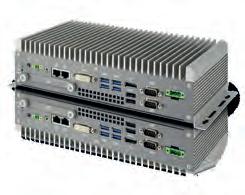

MH Material Handling
MH Material Handling presenta a Ipack-Ima una gamma di soluzioni per la gestione avanzata delle linee e i sistemi Bat Buffer Pad. 7, stand B21
Nel contesto dell’automazione per il confezionamento, la gestione dell’accumulo e del reintegro dei prodotti rappresenta un punto cardine della linea, soprattutto quando si lavora ad alta velocità con confezioni che richiedono un orientamento preciso.
Sistemi Bat Buffer: come funzionano
L’integrazione di un sistema Bat Buffer in una linea di astucci con caratteristiche di orientamento specifiche è un caso emblematico su cui
MH Material Handling ha lavorato. La configurazione prevede due piste di ingresso, ognuna con una linea indipendente, che alimentano un’unica macchina a valle. In condizioni operative standard, il sistema di carico del buffer
lavora come unificatore 2 in 1, mantenendo ordinato il flusso in ingresso.
Si tratta di una linea a bassa autonomia di attesa, poiché la zona di passaggio operatori sopraelevata porta il prodotto rapidamente all’unificatore tramite discensore gommato. Questa condizione impone tempi di reintegro molto rapidi e una progettazione particolarmente attenta agli spazi.
In caso di micro-fermate a valle, l’obiettivo è restituire il prodotto senza bloccare la produzione a monte. Il sistema è stato quindi configurato in modo che la pista di rientro dal buffer affianchi fisicamente il percorso principale, alimentando direttamente un trasferitore pneumatico lungo, capace di reintegrare una grande quantità di prodotto in tempi molto brevi.
MH Material Handling presents a range of solutions for advanced line management and Bat Buffer systems at IPACK-IMA (Hall 7, booth B21).
In the context of packaging automation, product accumulation and replenishment management is a cornerstone of the production line, especially when working at high speed with packages that require precise orientation.
Bat Buffer systems: how they work
The integration of a Bat Buffer system into a line of cartons with specific orientation
characteristics is a case in point that MH Material Handling has been working on. The configuration involves two track inputs, each with an independent line, feeding a single downstream machine. Under standard operating conditions, the buffer loading system works as a 2-in-1 merger, maintaining an orderly incoming flow. This is a line with low waiting time, because the elevated operator passage area

Un ulteriore elemento chiave è la presenza di un tappeto modulare intermedio, che funge da snodo tra il buffer e i tappeti fasatori dell’unificatore dinamico. Quando la linea riparte, il sistema passa automaticamente da una logica 2 in 1 a una 3 in 1, permettendo di recuperare rapidamente gli astucci accumulati nel buffer. Questa configurazione è possibile perché il prodotto - essendo rigido e confezionato - può sopportare una leggera pressione tra le unità, permettendo un accumulo denso e ordinato. Inoltre, grazie al trasferitore, viene mantenuto il corretto orientamento richiesto dalla grafica degli astucci.
Versatilità ed efficienza
Il risultato è un sistema che combina la logica di unificazione e quella di accumulo per dare vita a un’architettura flessibile, veloce e capace di reagire in modo intelligente agli stop temporanei. Una declinazione avanzata del Bat Buffer, progettata per aumentare l’efficienza senza compromettere la continuità produttiva.
brings the product quickly to the merger using a lowerator with rubber flighted belt. This condition requires very rapid reintegration times and a design that plays close attention to spaces. In the event of downstream microstops, the aim is to return the product without blocking production upstream. The system has thus been configured so that the re-entry track from the buffer runs alongside the main track, directly feeding a long pneumatic conveyor, able to replenish a large amount of product in a very short time. Another key element is the presence of an intermediate modular mat, which connects the buffer and the phasing belt of the dynamic merger. When the line restarts, the system automatically switches from 2-in-1 to 3-in-1
logic, allowing for rapid retrieval of cartons accumulated in the buffer. This configuration is possible because the product - since it is rigid and packaged - can withstand slight pressure between units, allowing for dense and orderly accumulation. In addition, the conveyor maintains the correct orientation required by the graphics of the cartons.
The result is a system that combines unification and accumulation logic to create an architecture that is flexible, fast, and able to react intelligently to temporary stops. This advanced version of the Bat Buffer is designed to increase efficiency without compromising on production continuity.

In today’s ever-changing world, complexity has become an opportunity. An opportunity to create new dimensions, advanced connections and effective solutions together with a single supplier who can provide everything you need to shape the future of pharma.
Visit us at PHARMINTECH 2025
Milan, ITALY • 27-30 May • Hall 2, Booth B46-C45 ima.it/pharma

Pad. 3, stand A38 - C49
Da oltre 20 anni, Comek si distingue nel settore del confezionamento e della pesatura automatica, fornendo soluzioni affidabili e personalizzate per proteggere e valorizzare i prodotti. Specializzata nello sviluppo di linee complete per il packaging alimentare, Comek, con sede a Mantova, guarda in particolare a precisione, efficienza e sostenibilità.
L’ampia gamma di macchine include infatti pesatrici multitesta, lineari e dosatori volumetrici, oltre a confezionatrici verticali e orizzontali per formati cuscino, fondo quadro, Stabilo, doy-pack e flow pack. Si tratta di soluzioni che assicurano dosaggi precisi, garantiscono versatilità ed efficienza e
permettono di ottimizzare l’intero processo di confezionamento.
L’approccio di Comek è incentrato sulla costante ricerca e sviluppo di tecnologie all’avanguardia, progettate per gestire velocità elevate, varietà di prodotti e materiali ecologici che spaziano dal mono-materiale alla carta riciclabile al compostabile.
Guardando ai mercati di destinazione, Comek vanta una rete internazionale in oltre 25 Paesi, garantendo supporto, assistenza e formazione che permettono di affidarsi a un servizio a 360 gradi, dalla progettazione all’installazione e una costante attenzione alla

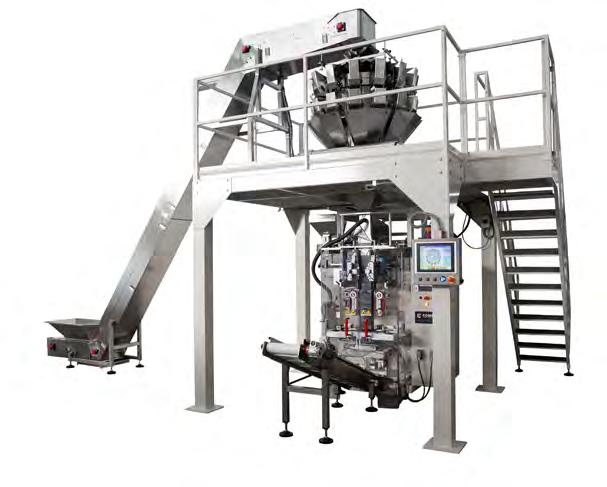
sostenibilità. Grazie a tecnologie versatili e a un’esperienza consolidata, infatti, Comek continua a innovare, puntando a soluzioni su misura e a un futuro sempre più sostenibile.
Pad. 2, stand A82
Nel 1965 Gino Donati fondava Universal Pack con un’intuizione semplice: creare macchine che semplificassero il confezionamento monodose. Sessant’anni dopo, quell’idea si è trasformata in una realtà
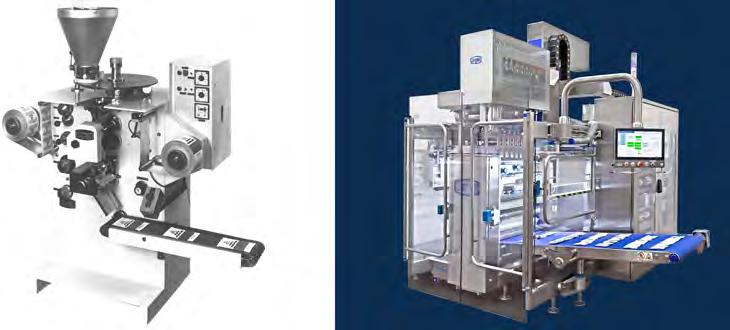
Comek: customized solutions for weighing and packaging
Hall 3, booth A38 - C49
For over 20 years, Comek has been a leader in the automatic packaging and weighing sector, offering reliable and customised solutions to protect and preserve your products. Specialising in the design of complete food packaging lines, Comek, based in Mantua-focuses on precision, efficiency and sustainability.
The wide range of machines includes multihead weighers, linear weighers and volumetric doser as well as vertical and horizontal packaging machines for pillow, block bottom, stabilo, doy pack and flow pack bags.
These solutions ensure accurate dosing, guarantee versatility and efficiency, and optimise the packaging process. Comek’s approach is based on constant research and development of advanced technologies designed to handle high speeds, product variety, and environmentally friendly materials (mono-material, recyclable paper, compostable).
The company has an international network in more than 25 countries to guarantee support, assistance and training. Choosing Comek means relying on a 360-degree service, from design to installation, with a strong focus on the environment. Thanks to versatile technologies and solid
globale, guidata oggi da Pietro Donati. Ogni macchina installata da Universal Pack, porta con sé una sfida risolta, un dialogo aperto, una soluzione su misura. Secondo l’azienda, infatti, il lavoro non si ferma alla tecnologia: è consulenza, comprensione profonda del prodotto, del mercato, del tempo del cliente.
In sei decenni Universal Pack ha evoluto i suoi sistemi, le linee, la visione mantenendo al centro lo stesso impegno: trasformare ogni esigenza in opportunità, ogni relazione in fiducia per sessant’anni di futuro costruito insieme.
“Se siamo arrivati fin qui - come afferma Marco Nardini, Sales Director - è grazie a un principio che non abbiamo mai tradito: ascoltare. Abbiamo costruito relazioni che vanno oltre la fornitura, diventando partner strategici per clienti che ci hanno spinto a migliorarci, progetto dopo progetto.”
experience, Comek continues to innovate, aiming at tailor-made solutions and a more sustainable future.
shared innovation
Hall 2, booth A82
In 1965, Gino Donati founded Universal Pack with a simple intuition: to create machines that would simplify single-serve packaging. Sixty years later, that idea has become a global reality, headed today by Pietro Donati. Every machine installed by Universal Pack brings with it a challenge resolved, an open dialogue, a tailored solution. The company believes that their task involves providing not only
technology, but also consulting, a profound understanding of the product, the market, and the customer’s time.
Over six decades, Universal Pack systems, lines and vision have evolved, while maintaining the same core commitment to turning every need into an opportunity, every relationship into trust, for sixty years of shaping the future.
“Everything we have achieved so far”, as Sales Director Marco Nardini says, “is thanks to a principle we have never betrayed: the ability to listen. We have built relationships that go beyond supply, becoming strategic partners for customers who have pushed us to improve, project after project”.

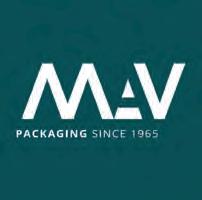

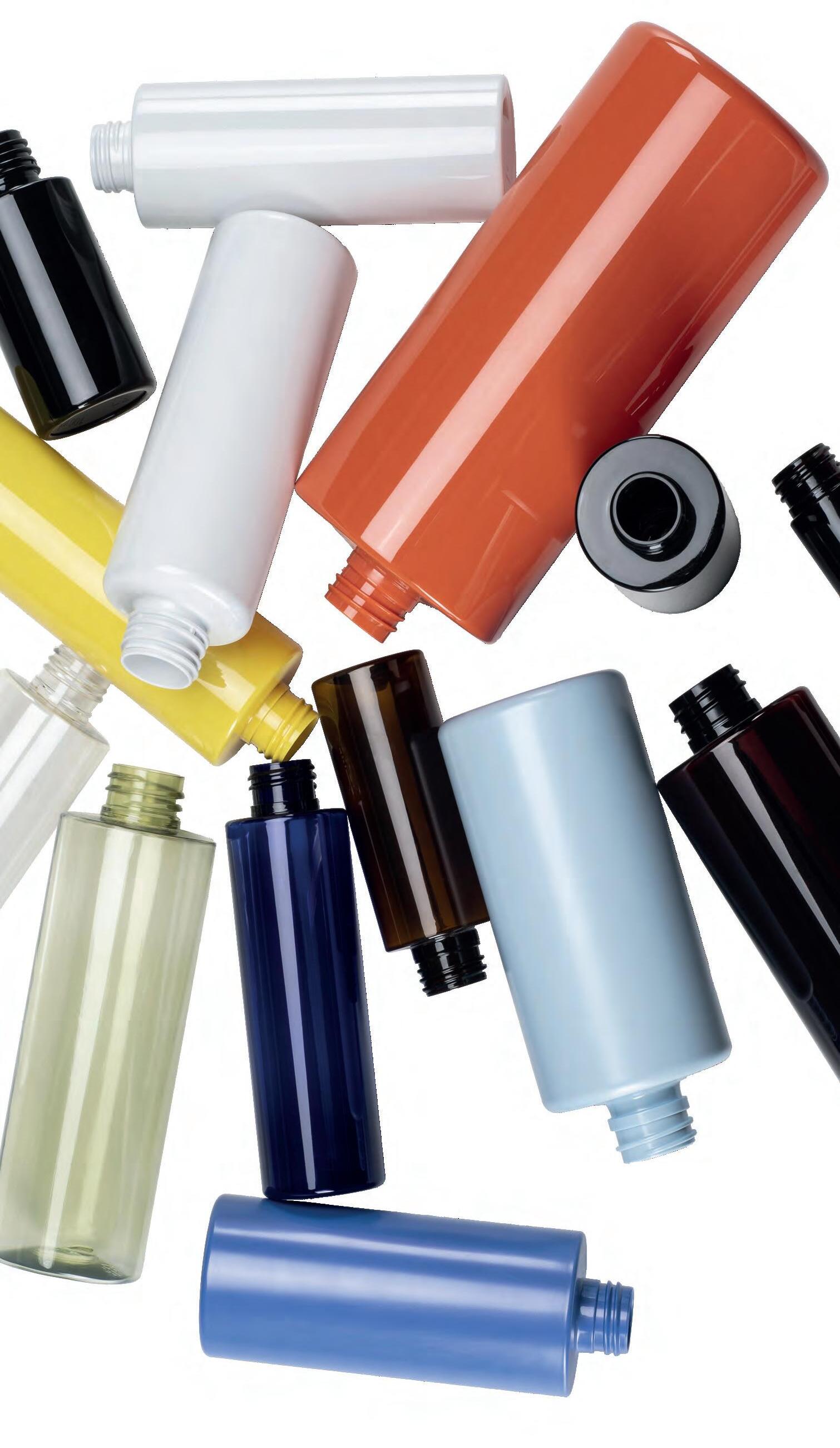

Con un’esperienza specifica acquisita da più di tre decenni nel settore farmaceutico - ambito nel quale sviluppa il 35% circa del proprio volume d’affari - Arca Etichette presta la massima attenzione alle esigenze di sicurezza, alla garanzia dell’originalità e alla tracciabilità dei prodotti, con l’obiettivo di garantire il corretto utilizzo dei farmaci e la conformità alle normative. In particolare, l’azienda è specializzata nella produzione di svariate soluzioni autoadesive:
• per il decoro di qualsiasi confezione;
• trasparenti “No label look” per fiale di piccolo diametro;
• etichette con stampa Braille e rilievi serigrafici;
• etichette con gancio per prodotti “infusionali” sospesi;
• multipagina (sia con piega booklet che con pieghevole a fisarmonica) e multistrato (fino a 6 strati, 11 facciate) per aumentare lo spazio a disposizione per testi e istruzioni;
• sigilli tamper-evident, in conformità alla Direttiva 2011/62/EU;
• etichette serializzate e personalizzate con inchiostri speciali di sicurezza anti-contraffazione e per il track & trace;
• per blister “child-resistant/senior-friendly”;
• sleeve termoretraibili per decoro e sigillo.
Per quanto riguarda la produzione delle etichette adesive, ogni dettaglio, dalla materia prima alla tipologia di stampa, è dunque selezionato e curato con la massima attenzione: oltre all’impiego di un’ampia gamma di materiali eco-friendly, Arca Etichette garantisce procedure di produzione dedicate e anti-frammischiamento conformi alle GMP nonché controlli videoispezione sul 100% delle etichette per identificare eventuali difetti, ma anche procedure di change control. Il tutto corredato da un’accurata documentazione di qualità e dall’esperienza maturata con i più importanti produttori europei di farmaci.

Arca Etichette for the pharmaceutical sector
With specific experience acquired over three decades in the pharmaceutical industry pharmaceutical industry - where it generates around 35% of its turnover
- Arca Etichette pays the utmost attention to security requirements, the guarantee of authenticity and product traceability.Its goal is to ensure the correct use of drugs and compliance with regulations. The company specialises in the production of a wide range of self-adhesive solutions:
• for the decoration of any type of packaging;
• transparent “no-label look” labels for small-diameter vials;
• Braille-printed labels and screenprinted embossing;
• labels with hooks for suspended “infusion” products;
• multipage (booklet or zig-zag fold) and multilayer labels (up to 6 layers, 11 printed sides) to maximise space available for text and instructions;
• tamper-evident seals compliant with Directive 2011/62/EU;
• serialised and customised labels with special security inks for anti-counterfeiting and track & trace features;
• labels for “child-resistant” and “senior-friendly” blister packs.
• heat shrink sleeves for decoration and sealing.
When it comes to the production of adhesive labels, every detail, from raw materials to the type of printing, is carefully selected and managed. In

A Ipack-Ima 2025, Pad. 4 D44, ALTECH presenta i suoi ultimi sviluppi tecnologici nel campo di etichettatura e identificazione.
Leader nella progettazione di sistemi modulari ed espandibili, ALTECH offre soluzioni adatte a diverse esigenze produttive con macchine costruite con materiali di alta qualità e componentistica affidabile, pensate per durare nel tempo e semplificare la manutenzione.
Forte di anni di esperienza, ALTECH investe costantemente in ricerca e sviluppo per offrire tecnologie personalizzate e performanti.
HERMA ECO,

Pad. 4, stand D44
Sistemi in esposizione
La presenza in fiera è caratterizzata da diverse soluzioni tecnologiche e, in particolare, un sistema ALline E/C per l’etichettatura fronte-retro di flaconi, dotato di regolazione automatica tramite ricetta su display e un sistema ALcode P per l’etichettatura di pallet secondo lo standard EAN 128.
Saranno inoltre visibili le teste etichettatrici
ALritma e ALstep in versione 4.0 e le soluzioni print & apply ALcode, a conferma del ruolo centrale di ALTECH nel settore del packaging.
A Ipack-Ima 2025 (Pad.4 - Stand B98) Automation
Address propone HERMA ECO, la nuova etichettatrice entry level della famiglia HERMA, pensata per applicazioni semplici senza compromettere qualità, affidabilità e precisione: soluzione versatile e di alta qualità, che incarna l’eccellenza della tecnologia “Made in Germany”. Disponibile in versione destra o sinistra, raggiunge velocità fino a 30 m/min con etichette larghe fino a 160 mm. Facile da usare, può essere controllata tramite il pannello o PLC.
La macchina è dotata di funzioni avanzate, come un encoder master per sincronizzare la velocità del prodotto e dell’etichettatura e opzioni di aggiornamento del firmware. L’encoder
addition to using a wide range of eco-friendly materials, Arca Etichette ensures dedicated production procedures and anti-mixing processes in compliance with GMP, as well as video inspection controls on 100% of the labels to identify any defects, along with change control procedures. All of this is supported by thorough quality documentation and the experience gained with the leading European pharmaceutical manufacturers.
ALTECH, innovative labelling, printing, and coding solutions
Hall. 4, booth D44
At IPACK-IMA 2025, Hall 4 D44, ALTECH showcases its latest technological innovations in labelling and product identification.
Leader in modular and expandable systems, ALTECH designs machines that adapt to diverse production needs. Built with high-quality materials and reliable components, ALTECH systems ensure durability and easy maintenance. With decades of experience, the company continuously invests in R&D to deliver highperformance, customised solutions.
Systems at the exhibition
On display at the show visitors meets an ALline E/C system for front-back labelling of flat and elliptical bottles, featuring automatic adjustment via recipe recall on the display; an ALcode P system for pallet labelling in compliance with EAN 128 standards. Also featured the updated ALritma and ALstep labelling heads (now Industry
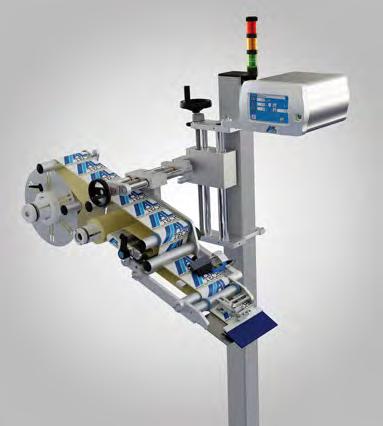
Pad. 4, stand B98
master garantisce precisione anche con variazioni di velocità, sincronizzando l’alimentazione delle etichette alla velocità del nastro trasportatore.
HERMA ECO è equipaggiata con fotocellula a forcella o sensore FS03 per una scansione affidabile delle etichette e una porta mini-USB per aggiornamenti del firmware.
Con oltre 30 anni di esperienza sul campo, ricordiamo che Automation Address Srl è il rivenditore esclusivo per il territorio italiano delle etichettatrici industriali HERMA, garantendo un servizio di assistenza in tutta la Penisola grazie a una squadra di tecnici qualificati e costantemente formati per poter risolvere le problematiche in loco o tramite assistenza telefonica.
4.0 ready), and Alcode print & apply systems - highlighting ALTECH’s strong position in the packaging sector.
Hall. 4, booth B98
At Ipack-Ima 2025 (Hall 4 - Stand B98) Automation Address will be offering HERMA ECO, the new entry-level labelling machine in the HERMA family, designed for simple applications without compromising on quality, reliability and precision: a versatile, high-quality solution that embodies the excellence of “Made in Germany” technology. Available in left or right versions, it can achieve speeds of up to 30 m/min with labels up to 160 mm wide. It is easy to operate, and can be controlled from a panel or PLC.
The machine is equipped with advanced features, such as a master encoder to synchronise product and labelling speed, and firmware upgrade options. The master encoder ensures accuracy even with variations in speed, synchronising label feeding to the speed of the conveyor belt. HERMA ECO is equipped with a fork photocell or FS03 sensor for reliable label scanning and a mini-USB port for firmware updates.
With more than 30 years of experience in the field, Automation Address Srl is the exclusive retailer in Italy of HERMA industrial labelling machines, guaranteeing service throughout mainland Italy thanks to a team of qualified technicians who are constantly trained to be able to solve problems on-site or over the phone.

Etipack, at the WorldStar Awards for smart and sustainable labelling technologies Hall. 4, booth A39-B40
The growing demand for Etipack multipack solutions confirms that sustainability is a priority for consumers, businesses and the environment. Using advanced labelling technologies, the company offers systems that eliminate unnecessary packaging, reducing costs and environmental impact. These flexible, modular solutions can be easily integrated into existing lines, adapting to different sectors, from food to cosmetics.
Among the most innovative projects is the Multipack Handle® Labelling Machine, developed with two industrial partners for the packaging of wet wipes. By applying special patented labels with handles, the system makes it possible to create transport-ready multipacks without additional packaging. The solution, already a Best Packaging 2024 winner, is close to being recognized by WorldStar for sustainability during the 2025 edition of Ipack-Ima.
In Hall 4, booth A39/B40, Etipack presents all-round standard and customized packaging solutions, ideal for line manufacturers and builders who recognize the experience and expertise of Etipack, which has always been a reliable partner for optimizing every packaging process.
Markem-Imaje: the 2D barcodes technology Hall. 4, booth B51-C52
The solution, integrated with the new portfolio of after-sales maintenance packages, involves dynamic firmware-generated QR codes that provide solutions through automated and customized access to the 24/7 AI virtual assistant. Simply scanning the dynamic QR code using a smartphone automatically identifies the customer’s coding hardware and guides the printer operator to perform the correct steps to solve the problem. The dynamic QR and virtual assistant help reduce printer downtime, while facilitating quick action for issues that cannot be solved in real time. The QR Virtual Assistant is already incorporated into some of Markem-Imaje’s most popular coders, such as the 9750 continuous inkjet series or the new 9712 coder. These models are joined by the SmartDate® thermal transfer printers and the 5940 G large character inkjet printer. Upcoming developments will see the extension of the QR Virtual Assistant to numerous coders in the Markem-Imaje range, including different types of lasers.
Massimo Cavazzini, Sales Director for MarkemImaje Italy said: “We’re constantly striving to offer the most useful services and features to our customers, helping them to optimize production and make coding operations as smooth as possible. Our new dynamic QR code function marks another step forward in our mission to help optimize our customers’ uptime by limiting the need for technician visits or service waits as far as possible”.
e sostenibile
Pad. 4, stand A39-B40
La crescente domanda di soluzioni multipack Etipack conferma che la sostenibilità è una priorità per consumatori, aziende e ambiente. Grazie a tecnologie di etichettatura avanzate, l’azienda propone sistemi che eliminano il packaging superfluo, riducendo costi e impatto ambientale. Le soluzioni, flessibili e modulari, si integrano facilmente nelle linee esistenti, adattandosi a diversi settori, dal food alla cosmetica. Tra i progetti più innovativi spicca Multipack Handle® Labelling Machine, sviluppata con due partner industriali per il confezionamento di salviette umidificate. Il sistema, applicando speciali etichette brevettate con maniglia, consente di creare multipack pronti al trasporto senza imballaggi aggiuntivi. La soluzione, già vincitrice del Best Packaging 2024 è prossima al riconoscimento del WorldStar per la sostenibilità durante l’edizione 2025 di Ipack-Ima. Al Pad. 4, stand A39/B40, Etipack presenta soluzioni di packaging a 360°, standard e personalizzate, ideali per produttori e costruttori di linee che riconoscono l’esperienza e la competenza di Etipack, da sempre partner affidabile per ottimizzare ogni processo di confezionamento.

Pad. 4, stand B51-C52

Markem-Imaje lancia la nuova tecnologia integrata nel firmware delle sue stampanti. La soluzione, integrata al nuovo portafoglio di pacchetti di manutenzione post-vendita prevede codici QR dinamici generati dal firmware che forniscono soluzioni attraverso l’accesso automatico e personalizzato all’assistente virtuale AI, disponibile 24 ore su 24, 7 giorni su 7.
La semplice scansione del codice QR dinamico attraverso un comune smartphone identifica automaticamente l’hardware di codifica del cliente e guida l’operatore della stampante ad eseguire i passaggi corretti per risolvere il problema. Il QR dinamico e l’assistente virtuale aiutano a ridurre i tempi di inattività della
stampante, facilitando al tempo stesso un rapido intervento in caso di problemi che non possono essere risolti in tempo reale. Il QR Virtual Assistant è già incorporato in alcuni dei codificatori più diffusi di MarkemImaje, come la serie a getto d’inchiostro continuo 9750 o il nuovo codificatore 9712 A questi modelli si aggiungono le stampanti a trasferimento termico SmartDate® e la stampante a getto d’inchiostro a caratteri grandi 5940 G. I prossimi sviluppi vedono l’estensione del QR Virtual Assistant a numerosi codificatori della gamma MarkemImaje compresi i diversi tipi di laser. Massimo Cavazzini, Direttore Vendite di Markem-Imaje Italia ha dichiarato:
“Ci impegniamo costantemente per offrire i servizi e le funzionalità più utili ai nostri clienti, aiutandoli a ottimizzare la produzione e rendere le operazioni di codifica il più agevoli possibile. La nostra nuova funzionalità di codice QR dinamico segna un altro passo avanti nella missione che ci siamo prefissati, cioè aiutare a ottimizzare i tempi di attività dei nostri clienti limitando ove possibile, la necessità di visite di tecnici o di attese di assistenza”.



Dove c’è INNOTECH c’è Team: nuova organizzazione e gioco di squadra
post vendita
Prati rinnova il Tech-Service, e con la nomina di Luca Bentini a capo e coordinamento del reparto nasce INNOTECH…innovazione nel servizio tecnico. Una nuova organizzazione che, partendo dalle esigenze del cliente, sta rafforzando anche il gioco di squadra. Secondo Prati, infatti, il risultato migliore, anche in termini di assistenza, non è quello ottenuto dal singolo ma dal Team.
Nuovo nome, nuovo spazio
Per INNOTECH, Prati ha investito nella costruzione di un nuovo ambiente all’interno dello stabilimento, più spazioso e funzionale, per gestire con una visione rinnovata il post-vendita.
“Per INNOTECH - spiega Luca Bentini, Service and Installation Manager Prati -è stata creata una nuova area dedicata, suddivisa in due parti: una per gli installatori e una per gli operatori del Tech-Service, che seguiranno il postvendita. Grazie alla piattaforma FASTLANE a cui i clienti accedono dal sito, il reparto può contare su una nuova dashboard che consente di visualizzare tutte le richieste dei clienti, e di verificarne lo stato di avanzamento. Dall’arrivo
della richiesta, infatti, il sistema - in base alla specializzazione e al know-how sul tipo di macchine - assegna il tecnico che seguirà l’assistenza, ottimizzando così i tempi di gestione della pratica. Ma non è l’unico aspetto ad essere automatizzato: il gestionale attribuisce infatti una corsia preferenziale alle macchine di nuova installazione rispetto ai vecchi modelli per quanto anche questi possano contare su un servizio di assistenza prioritaria grazie al canone annuo di assistenza.
Grazie all’esperienza di ogni operatore cerchiamo di essere più reattivi possibile con il cliente, che è libero di comunicare con noi con lo strumento che preferisce tra le più comuni piattaforme come Teams, whatsapp web o chiamate classiche; l’obiettivo è di concludere l’assistenza nel giro di una settimana. Nel caso di pezzi mancanti dove è richiesto un tempo maggiore, la collaborazione con il cliente ci permette di risolvere nel migliore dei modi. Ovviamente, se non si riuscisse in tempi brevi a individuare il problema o nel caso di assistenza prioritaria il cliente può contare sul supporto di un nostro tecnico”.
Fast technical support
“FASTLANE- commenta Chiara Prati, CEO & CSO Prati - è accessibile dal nostro sito per l’inserimento delle richieste 24/7. Consente di aprire un ticket e monitorare in tempo reale i vari passaggi di risoluzione. Permette anche un collegamento da remoto per tele-diagnosi della problematica e troubleshooting. Attiva già
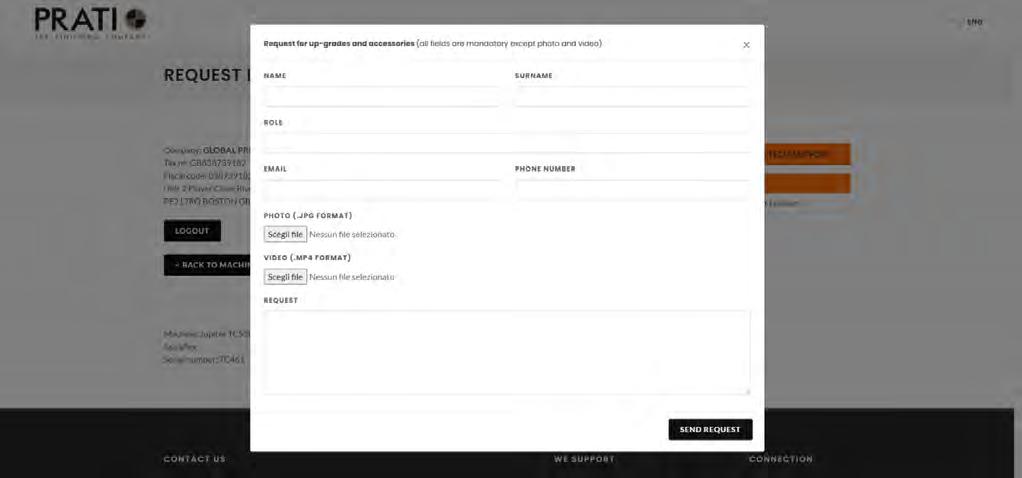


dal 2021, ne abbiamo potenziato le funzionalità a inizio 2025, anche grazie all’adozione della nuova dashboard, che si sta dimostrando un valido supporto non solo per il Tech-Service, per cui verrà posizionata anche in altri uffici in modo da condividere le informazioni tempestivamente con tutti gli operatori interessati a monte e a valle del processo”.
Flessibilità verso il cliente esterno ed interno: la parola ai protagonisti Per offrire maggiore flessibilità del servizio, Prati ha modificato i turni di lavoro in modo da garantire un contatto diretto dalle 07:00 alle 20:00, e reperibilità per le urgenze anche il sabato e domenica dalle 8,30 alle 17,30.
Una flessibilità accolta anche dal personale, come confermato da Omar Araibi Haouari, TechService Prati: la maggiore flessibilità verso i clienti si è tradotta in una maggiore flessibilità anche all’interno. Il team era già affiatato ma ora ci troviamo meglio. La gestione flessibile dell’orario ci ha aiutato anche a combinare lavoro e famiglia. E se, per motivi personali, abbiamo bisogno di lavorare in un altro orario, abbiamo la possibilità di cambiare il turno tra di noi”.
Dello stesso parere Achraf El Fadel, TechService Prati. “La flessibilità al lavoro aiuta a stare bene e quindi a produrre bene per dare un buon servizio al cliente, che chiede sempre di più, alla ricerca di un servizio rapido ed efficiente. La supervisione di Luca Bentini, che conosce le macchine, ci aiuta molto e sta rafforzando anche la squadra. Ci si scambia know-how ed esperienze pregresse contribuendo così a svi-
luppare ulteriormente il servizio. Il team è la base e dove c’è gioco di squadra e obiettivi comuni si può andare lontano”.
Un altro vantaggio aziendale è ben spiegato dall’installer specialist Marco Savorani: “Come installatore sono spesso in giro per il mondo e ora, anche se in azienda per poco tempo, riesco ad avere il quadro delle richieste guardando la dashboard. Questo mi permette di aiutare i colleghi di INNOTECH perché il sistema visualizza in modo ordinato e preciso a che punto è il percorso di assistenza. Abbiamo trasmesso ai clienti un messaggio fondamentale: la velocità non andava di pari passo con una chiamata o un messaggio whatsapp perché solo affidandosi ad un sistema come FASTLANE, attraverso la compilazione di campi preimpostati, si può attribuire correttamente le priorità. Tramite FASTLANE” prosegue ancora Savorani “è possibile anche inoltrare un ordine di pezzi di ricambio. La richiesta arriva direttamente al customer care, senza passare da INNOTECH. Inoltre, se un cliente vuole effettuare un reso per un errore nell’ordine, può farlo sempre con FASTLANE, evitando mail o telefonate. Sarà sufficiente scannerizzare il Qrcode della macchina e fare tutto molto velocemente. Altro aspetto molto interessante è legato alla percezione del cliente che capisce di essere seguito a ogni passo, partendo dal messaggio che riceve. Non usiamo infatti un testo preimpostato dal sistema come spesso accade in altri siti, ma ad ogni richiesta facciamo seguire un messaggio scritto appositamente per la presa in carico del caso”.
Accanto all’automazione… il contributo dell’uomo
Gestire le problematiche dei clienti comporta un buon allenamento allo stress. Non tutto infatti è facile e veloce, le variabili sono molte e non sempre il problema deriva dal costruttore. Per Mohamed Afouzar, Tech-Service Prati da un anno e mezzo, la sfida è proprio quella di acquisire sempre più conoscenza, attraverso una formazione sul campo:
“La nuova organizzazione dei softwaristi in azienda ci sta permettendo sia di crescere internamente che di fornire risposte più rapide. Al nuovo reparto, che ha consentito di migliorare l’ambiente di lavoro, si aggiunge una grande voglia di mettersi in gioco e conoscere sempre di più, soprattutto la tecnologia delle nuove macchine. Questo permette la crescita personale, portando ad essere sempre più autonomi nell’interfacciarsi con l’esterno, ma anche di rispondere più efficacemente alle aspettative del cliente”.
“In Prati è successo quanto spesso accade nella vita di tutti noi…” afferma la Communication Manager Concetta Daniela Binario “quando si agisce per gli altri come in questo caso, per andare incontro al cliente, qualcosa arriva sempre anche a noi! “


INNOTECH means Team: new organisation and teamwork to enhance the after sales services
Prati has renewed the Tech-Service, and with the appointment of Luca Bentini as head and coordinator of the department, INNOTECH is born… innovation in technical service. A new organization that, starting from customer needs, is also strengthening teamwork. Because the best result, even in terms of support, is not achieved by the individual but by the Team.
New name, new space…
For INNOTECH, Prati has invested in the construction of a new area within the plant, more spacious and functional, to manage after-sales with a renewed vision.
“For INNOTECH - explains Luca Bentini, Service and Installation Manager Prati - a new dedicated area has been created, divided into two parts: one for installers and one for Tech-Service operators, who will follow the after-sales process. The department will be able to rely on a new dashboard that allows not only to immediately view all customer requests - and this thanks to the FASTLANE platform that customers can access from the website - but also to monitor their progress. From the moment the customer’s request arrives, the system - based on specialization and know-how regarding the type of machines - assigns the technician who will handle the support, thus optimizing the case management time. But this is not the only aspect that is automated: the system also assigns priority to new machines over the older technologies. Moreover old machines are allowed to receive prioritized assistance with an annual support fee.
Thanks to each operator’s experience, we try to be as responsive as possible with the customer, who is free to communicate with us through the tool of their choice (Teams, WhatsApp Web, or classic calls): the goal is to complete the support within a week. In the case of missing parts, more time may be needed. The strong cooperation with the customer bring assistance to success in any case. Of course, if the problem cannot be identified quickly or in the case of priority assistance, the customer can count on support from one of our technicians”.
Fast technical support
“FASTLANE - comments Chiara Prati, CEO & CSO Prati - is accessible from our website 24/7 to submit requests. It allows you to open a ticket and monitor in real-time the various resolution steps. It also enables remote connection for problem telediagnosis and troubleshooting. Despite the service operations since 2021, we enhanced its functionality at the beginning of 2025. The adoption of the new dashboard demonstrated to be a valuable support for both the Tech-Service and customers. That’s why we will also place it in other offices to promptly share information with all operators involved upstream and downstream in the process”.
Flexibility toward external and internal customers: the word to the protagonists
To offer greater service flexibility, Prati has changed work shifts to ensure direct contact from 07:00 to 20:00, and availability for emergencies even on Saturdays and Sundays from 8:30 to 17:30.
The value of flexibility is shared by Prati’ personnel as confirmed by Omar Araibi Haouari, Tech-Service Prati: “the greater flexibility toward customers has also translated into greater internal flexibility. The team was already close-knit, but now we feel even better. The flexible schedule management has also helped us balance work and family. In case for personal reasons, we need to work at a different time, we have the possibility to swap shifts among ourselves”.
Same opinion from Achraf El Fadel, Tech-Service Prati: “Flexibility in the work environment helps to feel good and therefore to work well to provide good service to the customer, who is always asking for more, looking for fast and efficient service. Moreover, the supervision of Luca Bentini, who knows the machines, helps us a lot and is also strengthening the team. We exchange know-how and previous experiences, and this can certainly contribute to further developing the service. The team is the foundation. Where there is teamwork and common goals, you can go far”. Another business advantage is well explained by Marco Savorani, Installer Specialist Prati: “As an installer I’m often around the world. Even in case I return to the company for a short time, the dashboard gives me the immediate understanding of the status of requests, helping INNOTECH colleagues thanks to a clear and precise picture of how far along the assistance is.
We conveyed a fundamental message to customers: speed did not go hand-in-hand with a call or a WhatsApp message because only by relying on a system like FASTLANE, through the compilation of preset fields, can priorities be correctly assigned. Through FASTLANE - Savorani emphasizes - it is also possible to forward an order for spare parts, and the request goes directly to customer care, without going through INNOTECH. In case a customer wants to return parts because of an
order error, FASTLANE is ready to support the process, avoiding emails or phone calls. As a matter of fact, the process requires a machine’s QR code scan.
Finally, another aspect that I find very positive: the customer understands that we are truly following up, even from the message they receive. INNOTECH doesn’t use system-generated message, as often happens on other sites, while we always read the request and write the response in real-time”.
Surely managing customer issues requires good stress management, because it’s not all easy and fast, there are many variables, and the problem is not always the manufacturer’s fault.
For Mohamed Afouzar, TechService Prati, who has been with the company for a year and a half, the challenge is precisely to acquire more and more knowledge through on-the-job training. “The new organization of the software team within the company is allowing us both to grow internally and to provide quicker responses.
“declares Mr Afouzar “In fact, alongside the new department that has improved the work environment, there is a strong desire to step up and keep learning more about the technology behind the new machines. This meets the goal of a personal growth to become increasingly independent when dealing externally, but also to respond more effectively to customer expectations”.
“As in life... when we act for others, as it was the case in order to meet client’s needs, something always comes back to us too!” declares the Communication Manager Concetta Daniela Binario.

D.C.M.
Dall’alimentazione al trasporto e la robotica: l’azienda si presenta a Ipack-Ima affermandosi come partner di riferimento per il packaging industriale, che nella soddisfazione del cliente e nelle risposte alle richieste di sostenibilità trova la misura del proprio successo. Pad. 3, stand C10 - Pad. 2, stand A50
Fondata nel 1974, D.C.M. ha il proprio core business nella distribuzione di macchine per la piega di carta per i settori farmaceutico, cartotecnico e delle arti grafiche in generale. Tuttavia, la capacità di evolversi e la volontà di portare innovazione al proprio interno hanno fatto sì che, nel tempo, il suo portafoglio si sia arricchito di nuove soluzioni di confezionamento. Per rispondere alle diverse esigenze dei clienti, D.C.M propone oggi anche sistemi di dispensazione, trasporto, manipolazione e movimentazione robotica per molteplici settori merceologici.
Oltre al marchio Guk, D.C.M. distribuisce in esclusiva per l’Italia anche le soluzioni Kraus, Autonox Robotics e BVM Brunner attestandosi così quale fornitore di riferimento per i costruttori di macchine. Una proposta che a Ipack-Ima troverà piena espressione e spazio per una vetrina d’eccellenza.


Expertise unica nella piega di carta con Guk
D.C.M. ha acquisito nel tempo un’esperienza unica nel fornire e installare i prodotti Guk, famosi in tutto il mondo per praticità, robustezza e affidabilità. I formati realizzati dalle macchine Guk sono tra i più vari, con linee di piega che raggiungono velocità fino a 600 pezzi/min e garantiscono maggiore qualità del prodotto finito grazie alla costanza dei risultati e all’utilizzo di soluzioni uniche e brevettate.
Le versioni standard possono essere equipaggiate con accessori e componenti aggiuntivi per estenderne ulteriormente le capacità. Tra queste, ad esempio, il sistema di visione e di scarto automatico per eliminare il rischio di frammischiamento.
Grazie alla tecnologia Guk, ogni giorno in Italia vengono realizzati milioni di prospetti illustrativi, una performance che ha permesso all’azienda di mettere a punto un sistema originale capace di evitare la compromissione della produttività delle macchine. Mercurio, questo il nome della soluzione, oltre a monitorare e raccogliere dati dalla macchina per pianificare gli interventi di manutenzione, permette di interconnettere le macchine seguendo i criteri dell’industria 4.0.
Ipack-Ima 2025 sarà l’occasione per presentare una delle innovazioni Guk più attese: il sistema PP Cobo, una soluzione all’avanguardia per l’automazione della raccolta dei fogli illustrativi piegati. Questo sistema, dotato di un braccio robotico collaborativo posizionato a valle della linea di piega, è in grado di prelevare in autonomia i booklet e collocarli ordinatamente nei vassoi predisposti su entrambi i lati. Il PP Cobo libera così l’operatore dalle

operazioni ripetitive di raccolta, permettendogli di concentrarsi sulle fasi successive del confezionamento e migliorando efficienza e continuità del processo produttivo.
Dispensazione, trasporto e lavorazione di prodotti con Kraus Gli sfogliatori Kraus sono progettati per lavorare a ritmi industriali e sono ideali per dispensare prodotti a velocità elevate in diversi settori merceologici. La crescente attenzione degli ultimi anni alla sostenibilità ha comportato la trasformazione delle macchine, adattate alla richiesta di imballaggi ecologici, i cosiddetti green packaging. L’impiego sempre più frequente di materiali riciclabili nella produzione di posate monouso, cartoncini, vassoi e vaschette ha comportato delle modifiche anche alle soluzioni tecnologiche adottate per la loro singolarizzazione e distribuzione, effettuate in modo completamente automatico sulle linee di produzione.
D.C.M per il mercato farmaceutico con Brava
Si tratta di un tema che tocca da vicino anche il settore farmaceutico, di cui D.C.M. vanta una conoscenza molto approfondita. Ed è proprio tramite il know how acquisito nel pharma che è nata una soluzione di nuova concezione.
La famiglia di prodotti Brava nasce infatti per dare seguito alla domanda sempre più frequente di sostituzione dei vassoi termoformati in plastica con un supporto eco-sostenibile. Composta da 3 diverse macchine, Brava fornisce un supporto in cartoncino che presenta dalle 2 alle 6 file di cuspidi che, in fase di confezionamento, vanno a ospitare prodotti come siringhe, boccette e flaconcini.
Lavorazioni speciali, ecco Labeljack
Guardando alle lavorazioni speciali invece, spicca il sistema di etichettatura Labeljack, caratterizzato da un’elevata velocità di ciclo, predisposizione all’industria 4.0 e gestione di etichette di diverso formato.
Fra le molteplici lavorazioni sviluppate per le linee speciali, i sistemi di etichettatura hanno un ruolo di primo piano, soprattutto per l’alto livello di personalizzazione offerta. Attraverso il controllo integrato di Labeljack è possibile definire impostazioni come lingua, interfaccia e memoria del formato etichetta. Grazie al suo esclusivo meccanismo di bloccaggio e alla semplicità d’uso, inoltre, è garantita maneggevolezza, massima precisione e dinamica.
Robotica industriale e digital twin
L’evoluzione dell’informatica e dell’elettronica ha permesso di sviluppare nuovi robot industriali avanzati come quelli a marchio

Autonox Robotics, in grado di realizzare quasi ogni tipo di attività di confezionamento e manipolazione di prodotti di diverso peso e dimensione.
L’intera gamma è controller independent e si compone di duopodi, robot Delta da 3 a 5 assi, antropomorfi da tre a sei assi e scara, in grado di lavorare con cicliche sostenute e di incontrare le diverse richieste per payload e aree di lavoro: da 0,5 a 350 kg e da 200 mm fino a 2838 mm.
Le versioni standard sono completate dalle rinnovate versioni in Hygienic Design, per lavorare nel packaging primario con grado di protezione IP69K e dai rivoluzionari bracci robotici antropomorfi dedicati alle lavorazioni CNC.
Guardando alla robotica, è in crescita negli ultimi anni la richiesta di simulazione dei processi produttivi, in particolare per il virtual testing di robot grazie all’uso del digital twin, il “gemello digitale”. Dando seguito alla cultura dell’innovazione e della creazione di valore che la caratterizza, D.C.M. ha integrato nella sua offerta la possibilità di simulare l’applicazione robotica del cliente tramite un software di virtual commissioning. A questo si aggiunge la possibilità di proporre il giusto dimensionamento robotico e testare la fattibilità di un progetto, offrendo un grande vantaggio tecnologico che, nella maggior parte dei casi, può sostituire la parte dei test fisici della macchina.
Il supporto pre e post-vendita con OPTIMAC
D.C.M. non significa solo soluzioni e prodotti, ma anche consulenza e assistenza che l’azienda ha riunito in un marchio proprietario che racchiude tutte le attività di supporto, consulenza e formazione fornite. Con “OPTIMAC”, D.C.M. offre massima efficienza e professionalità nel supportare i clienti in tutte le fasi, da quelle preliminari di progettazione fino alla ricambistica e manutenzione.
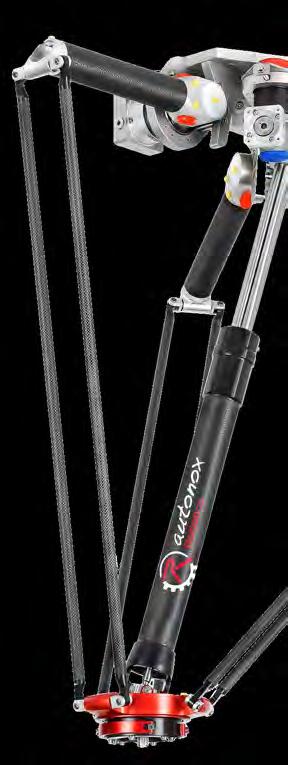
From food to transport and robotics: the company will be present at Ipack-Ima as a partner of choice for industrial packaging, whose success lies in customer satisfaction and providing responses to the demand for sustainable solutions. Hall 3, booth C10 - Hall 2, booth A50
Founded in 1974, D.C.M.’s core business is the distribution of paper folding machines for the pharmaceutical, paper processing and graphic arts sectors in general. However, its ability to evolve and its desire to bring innovation in-house have enabled the expansion of its portfolio to include new packaging solutions. In order to respond to different customer needs, D.C.M. now also offers dispensing, conveying, handling and robotic handling systems for a variety of product sectors.

advanced industrial robots such as those under the Autonox Robotics brand, able to perform almost any type of packaging and handling task on products of different weights and sizes.
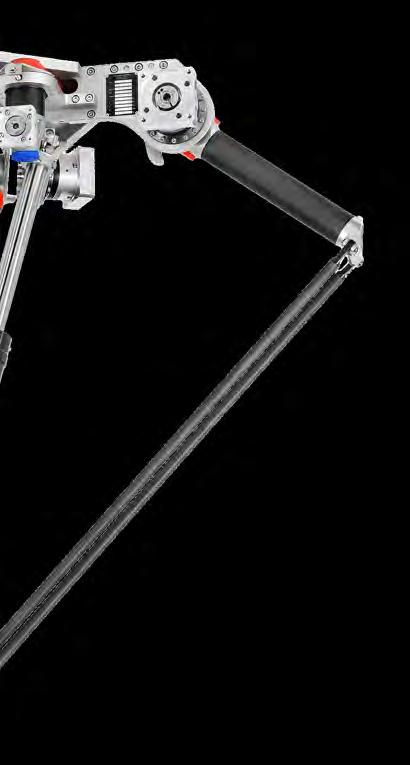
In addition to the Guk brand, D.C.M. is also the exclusive distributor of Kraus, Autonox Robotics and BVM Brunner solutions in Italy, making the company the supplier of choice for machinery manufacturers. These solutions will be effectively finished products, thanks to the consistency of the results and the
use of unique, patented solutions. Standard versions can be equipped with accessories and add-ons to further extend their capabilities. These include, for example, the automatic vision and rejection system to eliminate the risk of components getting mixed up. Thanks to Guk technology, millions of brochures are produced every day in Italy. This performance has allowed the company to develop an original system that avoids impacting the productivity of machinery. The Mercurio solution not only monitors and collects data from the machine to plan maintenance work, but also allows machines to be interconnected according to Industry 4.0 criteria. Ipack-Ima 2025 will see the presentation of one of Guk’s most eagerly awaited innovations: the PP Cobo system, a state-of-the-art solution for the automation of folded leaflet collection. This system, equipped with a collaborative robotic arm positioned downstream of the folding line, is able to independently pick up the leaflets and place them neatly in the trays provided on both sides. By taking care of the repetitive collection operations, the Cobo PP allows operators to concentrate on the subsequent stages of packaging, thus improving the efficiency and continuity of the production process.
Dispensing, transporting and processing products with Kraus Kraus feeders are designed to work at an industrial pace, and are ideal for dispensing products at high speeds in a variety of goods sectors. The growing attention paid to sustainability in recent years has led to the transformation of machines, adapting them to the demand for environmentally friendly, green packaging. The increasing use of recyclable
materials in the production of disposable cutlery, cartons and trays has also led to changes in the technological solutions adopted for their individualisation and distribution, which are carried out completely automatically on the production lines.
D.C.M for the pharmaceutical market with Brava
This is a question that is also directly relevant to the pharmaceutical sector, of which D.C.M. has very thorough knowledge. And it is precisely the know-how acquired in pharma that led to the development of a novel solution, with the Brava product family, in response to the increasingly frequent demand to replace thermoformed plastic trays with an environmentally sustainable alternative. Consisting of 3 different machines, Brava provides a cardboard support with 2 to 6 rows of cusps that accommodate products such as syringes, bottles and vials during packaging.
for special processes
The Labeljack labelling system for special processes is characterised by its high cycle speed, Industry 4.0 readiness and ability to handle different label formats.
Among the many processes developed for special lines, labelling systems play a prominent role, especially because of the high level of customisation offered.
Labeljack’s built-in control system is able to define settings such as language, interface and label format memory. Thanks to its unique locking mechanism and ease of use, simple handling, maximum precision and dynamics are guaranteed.
The evolution of information technology and electronics has enabled the development of new
The entire range is controller independent and consists of duopods, 3- to 5-axis Delta robots, 3- to 6-axis anthropomorphic robots and SCARA robots, capable of working with fast cycles and meeting different payload and area requirements: from 0.5 to 350 kg and from 200 mm up to 2838 mm.
The standard versions are complemented by the revamped Hygienic Design versions for working in primary packaging with IP69K protection, and by the revolutionary anthropomorphic robotic arms dedicated to CNC machining.
With regard to robotics, the demand for simulation of production processes has been growing in recent years, in particular for virtual testing of robots through the use of the ‘digital twin’. In keeping with its hallmark culture of innovation and value creation, D.C.M. has integrated its offer with the possibility of simulating the customer’s robotic application using virtual commissioning software. Added to this is the possibility to propose the right robotic sizing and testing the feasibility of a project, offering a major technological advantage that in most cases can replace the physical testing part of the machine.
D.C.M. offers not only solutions and products, but also consulting and support, which the company has combined into a proprietary brand that encompasses all the support, consulting and training activities provided. With ‘OPTIMAC’, D.C.M. offers maximum efficiency and professionalism in supporting customers at all stages, from preliminary design to spare parts and maintenance.

Schneider Electric con SACMI Packaging & Chocolate

Dalla meccanica alla meccatronica, con Schneider Electric. Grazie all’uso di assi elettronici e componentistica digitale, gli impianti della divisione Packaging & Chocolate di SACMI consentono elevate prestazioni, sostenibilità e controllo dei consumi migliorando la qualità.

Con il lancio sul mercato dell’HTB, la nuova incartatrice per tavolette di cioccolato in stile wrapping tradizionale, SACMI Packaging & Chocolate offre una produttività superiore del 25% rispetto ai competitor, consumi ridotti del 40%, una riduzione sensibile dei fermi macchina e un drastico abbattimento di ripartenza a seguito di cambio formato grazie all’assenza di camme e ingranaggi meccanici.
Versatilità che supporta la crescita del cliente
Per la divisione Packaging & Chocolate del gruppo SACMI - realtà leader nelle tecnologie avanzate per la ceramica e per il confezionamento operante a livello globale, con oltre 70 società di produzione, distribuzione e servizi attive in 28 paesi - la scelta di espandere le prestazioni degli impianti con l’impiego degli assi elettronici a supporto degli assi meccanici ha consentito un decisivo cambio di marcia, generando vantaggi che hanno superato le aspettative.
I sistemi e le linee SACMI per la produzione e il confezionamento del cioccolato sono progettati per l’intero processo industriale: dalla la-
vorazione delle masse di cioccolato sino agli incarti primario (in modalità wrapping tradizionale o flow pack) e secondario, a valle dei quali le aziende clienti del gruppo ottengono prodotti pronti per la distribuzione e la commercializzazione. Il tutto passando per i processi di trasformazione della materia prima come la raffinazione, il temperaggio e il modellaggio, cioè la creazione vera e propria della pralina o della tavoletta.
“Seguendo l’evoluzione dei bisogni dei clienti, abbiamo cambiato radicalmente la filosofia di costruzione delle macchine, adottando un approccio diverso e andando ben oltre un semplice riposizionamento sul mercato”, sottolinea Ernesto Gabrielli, Wrapping & Tray Forming BU Director di SACMI Packaging & Chocolate.
“Abbiamo privilegiato l’adozione di un sistema full-servo, prevedendo un asse elettronico per ogni asse funzionale della macchina”. Una vera e propria rivoluzione e un progetto ambizioso, realizzato con soluzioni Schneider Electric, che ha portato a risultati straordinari”.
“Le nostre nuove macchine consentono un aumento della produttività del 25%, se paragonate alle prestazioni degli impianti dei nostri competitor”, aggiunge Gabrielli, “il tutto mantenendo
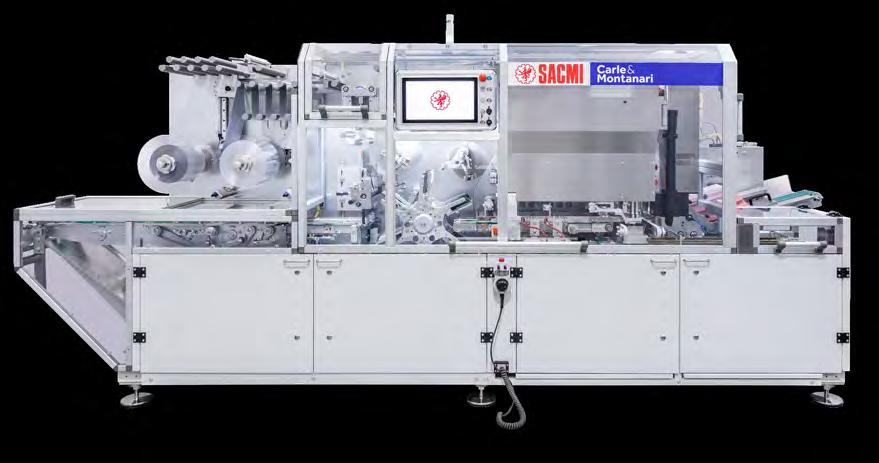


un’elevata qualità di risultato e riducendo gli scarti”.
Dati a cui va aggiunta la maggiore flessibilità in caso di riprogrammazione della produzione. “Il passaggio da un formato all’altro nelle scelte di produzione avviene con semplici touch, in sostituzione di complesse regolazioni meccaniche, eliminando lunghi tempi di fermo macchina e rendendo immediata la ripresa in produzione”. Senza contare che minore manutenzione corrisponde anche a facilità d’uso. “L’interfaccia utente semplificata, basata su ricette preimpostate, rende le macchine accessibili anche a operatori con meno esperienza”.
Sostenibilità e sicurezza alimentare
L’ottimizzazione della tecnologia tradizionale con l’introduzione dell’elettronica ha azzerato l’impiego di oli e grassi, abbattendo il rischio di contatto con i prodotti - un aspetto fondamentale nell’industria alimentare - e riducendo al contempo l’impatto ambientale.
“L’evoluzione dei nostri impianti elimina il pericolo di perdite di lubrificante”, sottolinea Gabrielli. “Per i nostri clienti è un fattore ormai diventato decisivo: la richiesta di usufruire di linee oil-free è sempre più frequente”.
Ma i benefici del connubio tra prestazioni e sostenibilità non finiscono qui.
“Grazie alla piattaforma elettronica adottata, siamo in grado di rigenerare energia durante la fase di decelerazione degli assi nel loro moto alternato”, continua Gabrielli, “un fattore che permette agli utenti dei nostri impianti un significativo risparmio energetico”.
Manutenzione preventiva grazie alla digitalizzazione
I vantaggi dell’uso dell’elettronica vanno ben oltre: l’azienda ora è in grado di conoscere lo “stato di salute” della macchina in ogni suo singolo asse con una frequenza di un millisecondo, cosa impossibile in soluzioni meccaniche. “Possiamo dotare le linee che progettiamo di sistemi di monitoraggio,” chiarisce Gabrielli, “che permettono di prevenire interferenze e collisioni durante le fasi produttive, evitando importanti fermi linea”.
Una partnership di successo
Per la divisione Packaging & Chocolate, la collaborazione con Schneider Electric e il ricorso alla componentistica della gamma PacDrive 3, hanno permesso un vero e proprio cambio di paradigma. L’evoluzione dalla meccanica alla meccatronica rientra in un processo di trasformazione perfettamente in linea con l’obiettivo del gruppo SACMI: investire in ricerca e sviluppo per progettare soluzioni sempre più efficienti, flessibili, sostenibili, in grado di soddisfare le esigenze di un mercato in costante trasformazione.
From mechanics to mechatronics with Schneider Electric. By integrating electronic axes and digital components, SACMI’s Packaging & Chocolate systems achieve superior performance, greater sustainability and precise consumption control - all while improving product quality.
With the market launch of HTB - a new wrapping machine for chocolate tablets and bars in the traditional wrapping style - SACMI Packaging & Chocolate offers 25% higher productivity than its competitors, 40% lower energy consumption, significantly reduced machine downtime, and a drastic decrease in restarts after format changes, thanks to the elimination of mechanical cams and gears.
Versatility that supports customer growth
For the Packaging & Chocolate division of the SACMI Group - a global leader in advanced ceramic and packaging technologies with more than 70 production, distribution and service companies across 28 countries - the decision to enhance plant performance with the use of electronic axes alongside mechanical ones has marked a significant turning point, generating benefits that have exceeded expectations.
SACMI’s chocolate production and packaging systems and lines are designed to cover the entire industrial process - from Chocolate mass processing to primary packaging (both traditional and flow pack) and secondary packaging. Downstream of these stages, the company’s customers are able to produce finished goods ready for distribution and sale. This comprehensive process includes all key stages of raw material transformation, such as refining, tempering and moulding, i.e. the actual creation of chocolate pralines or tablets.
“Responding to the evolving needs of our customers, we have completely rethought our machine design philosophy,” says Ernesto Gabrielli, Wrapping & Tray Forming BU Director at SACMI Packaging & Chocolate. “This involved adopting a different approach and going well beyond a simple repositioning on the market”. “We We have privileged a fully servo-driven architecture, providing an electronic axis for each functional axis of the machine. It is a true revolution and an ambitious project, brought to life through our collaboration with Schneider Electric, and one that has delivered exceptional results”.
“Our new machines offer a 25% increase in productivity compared to the performance of competing systems,” Gabrielli adds, “all while maintaining consistently high quality and reducing waste”.
These figures are further enhanced by the system’s increased flexibility, especially when production schedules need to be adjusted. “Switching from one production format to another is now quick and easy,
thanks to intuitive controls that replace complex mechanical adjustments. This minimises downtime and allows production to resume rapidly and efficiently”. What’s more, reduced maintenance means greater ease of use. “A simplified user interface, based on preset recipes, makes the machines accessible even to less experienced operators”.
Sustainability
The optimisation of traditional technology through the introduction of electronics has eliminated the need for oils and greases, thus reducing the risk of product contamination - a critical concern in the food industry - while also lowering environmental impact.
“The evolution of our equipment has eliminated the risk of lubricant leakage,” Gabrielli emphasises. “This has now become a decisive factor for our customers, as the demand for oil-free lines is growing rapidly”.
But the benefits of combining performance with sustainability don’t stop there.
“Thanks to the electronic platform we have adopted, our systems can regenerate energy during the deceleration phase of the axes in their reciprocating motion,” Gabrielli continues. “This translates into significant energy savings for users of our systems”.
Preventive maintenance through digitisation
The advantages of using electronics extend well beyond this: the company is now able to know the “health status” of the machine in each of its individual axes with a frequency of one millisecond, which is impossible in mechanical solutions. “We can equip our lines with monitoring systems,” explains Gabrielli, “allowing us to detect and prevent potential issues such as interference or collisions during production. This approach helps us avoid major downtimes”.
A successful partnership
For the Packaging & Chocolate division, the partnership with Schneider Electric and the adoption of components from the PacDrive 3 range have enabled a true paradigm shift. The evolution from mechanical to mechatronic systems is a key part of SACMI Group’s broader transformation strategy, which is fully aligned with its commitment to research and development. The goal is to deliver increasingly efficient, flexible and sustainable solutions that respond to the demands of a constantly evolving market.

In un contesto in cui efficienza e qualità sono determinanti, l’automazione emerge come la chiave per ottimizzare i processi produttivi e rispondere alle sfide sempre più complesse del mercato globale. Le aziende che adottano tecnologie automatizzate possono rispondere più rapidamente alle esigenze del mercato, migliorando la loro capacità di innovare e di ottimizzare i processi produttivi.
Un’offerta completa
HIWIN offre una gamma di prodotti, dalle soluzioni di movimentazione ai sistemi di controllo avanzati, che permettono di integrare automazione e controllo in modo sinergico, portando a una riduzione dei costi e a un miglioramento della qualità delle macchine e de-
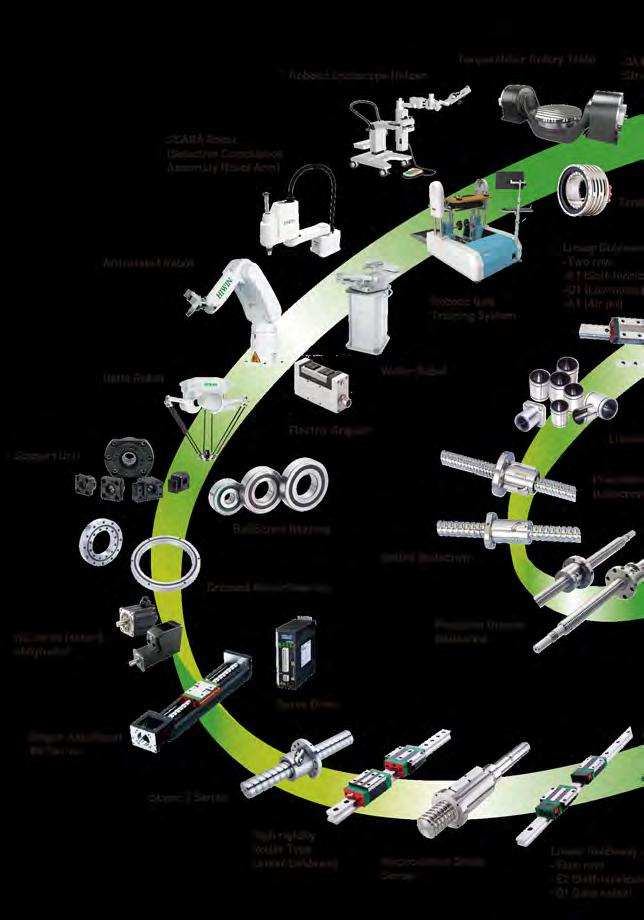
gli impianti. Ampia soprattutto l’offerta di guide lineari, che comprende guide a rulli, con o senza co ver, guide a sfere, con trattamenti anticorrosione, in acciaio inox, viti a ricircolo di sfere rullate e rettificate. Non solo la gamma meccanica, ma anche le soluzioni meccatroni che, che includono azionamenti da utilizzare insieme alle tavole rotanti per automazione, motori coppia, motori lineari e brushless, assi lineari a vite, a cinghia e con motore lineare.
Non solo componenti ma soluzioni HIWIN si propone sul mercato come fornitore di soluzioni complete, non solo di componenti. In fiera è possibile incontrare gli esperti HIWIN per le soluzioni integrate e vedere in movimento i componenti all’interno di soluzioni dimo-
At Ipack-Ima - Hall 5 booth A51 - HIWIN presents its industrial automation and precision mechanics solutions.
In an environment where efficiency and quality are crucial, automation emerges as the key to optimizing production processes and meeting
the increasingly complex challenges of the global market. Companies that adopt automated technologies are able to offer a
strative. Un team di ingegneri è inoltre a disposizione per sviluppare progetti custom interamente made in HIWIN.
Case history di successo
Un esempio emblematico è un’applicazione di avvolgitura e svolgitura. La chiave del progetto è la necessità di garantire un’elevata accuratezza e costanza della tensione del materiale controllando il motore in coppia
more rapid response to market needs, improving their ability to innovate and optimize production processes.
Comprehensive offer
HIWIN offers a range of products, from motion solutions to advanced control systems, that enable a smooth, effective integration of automation and control, leading to reduced costs and improved machine and plant quality. Particularly extensive is the range of linear guides, including roller guides, with or without covers, ball
bearing guides, with anti-corrosion treatments, in stainless steel, rolled and ground ball screws. The mechanical range is accompanied by mechatronic solutions, which include drives for use together with rotary tables for automation, torque motors, linear and brushless motors, screw, belt and linear motor axes.
Solutions as well as components
HIWIN offers the market a range of complete solutions as well as components. Visitors to the trade show will have the chance to meet

senza componenti meccanici aggiuntivi. L’utilizzo delle tavole rotanti della serie DMN, accoppiate direttamente al carico hanno permesso di raggiungere un’elevata accuratezza del controllo di coppia rispetto a soluzioni tradizionali quali motore brushless e riduttore. A questo si aggiunge una notevole compattezza in termini di ingombri meccanici grazie al profilo ribassato, tempi di assemblaggio ridotti, continuità ed elevata efficienza elevata grazie alla riduzione di organi di trasmissione.




Home & Personal Care
HIWIN experts for integrated solutions and watch demonstrations with components in motion. A team of HIWIN engineers is also on hand to develop 100% in-house custom designs.
Successful case histories
A winding and unwinding application is a prime example. The key feature of the design is the need to ensure highly accurate and consistent material tension by controlling the motor in torque without additional mechanical
components. The use of DMN series rotary tables, coupled directly to the load, has enabled high torque control accuracy compared to traditional options such as brushless motor and gearbox solutions. This is complemented by remarkable compactness in terms of mechanical footprint due to the low profile, reduced assembly times, continuity and high efficiency due to the reduction of transmission components.





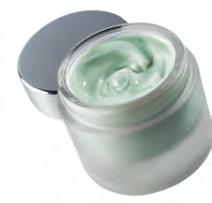
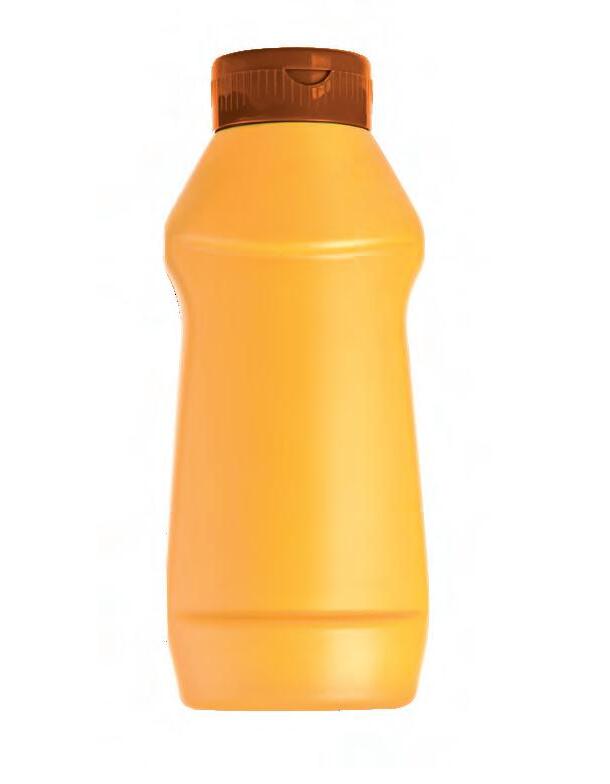
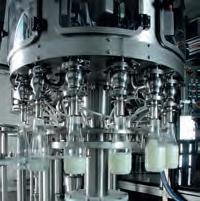

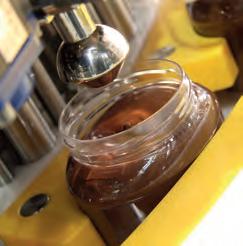




Minebea Intec e la food safety
Selezionatrici ponderali, rilevatori di metalli, piattaforme di pesatura, sistemi a raggi X, gestione delle ricette per tutti i processi di formulazione: Minebea Intec mette in campo strumenti evoluti per fare qualità e aumentare la produttività.
Come stabilito da rigorose normative internazionaliHACCP, ISO 22000, NSF - i requisiti di igiene e qualità nella produzione di alimenti sono molto elevati. I produttori devono quindi ricorrere a tecnologie affidabili e precise per rispettare gli standard imposti, pur affrontando l’aumento dei costi di materie prime, energia e lavoro. Minebea Intec offre un programma di soluzioni tecnologiche personalizzate per affrontare e rispettare tutti i requisiti richiesti, che riassumiamo nel seguito.
Tecnologie per l’HACCP
Il sistema di gestione preventiva della sicurezza alimentare HACCP obbliga i produttori a identificare i rischi (biologici, chimici, fisici) e a definire i punti critici di controllo (CCP) per eliminarli.
Come evitare i richiami alimentari
Immaginate una riunione urgente in cui il reparto controllo qualità annuncia la presenza di trucioli di metallo in un lotto di prodotti alimentari. Un richiamo è inevitabile, e il team deve gestire una serie di attività urgenti: comunicare con i clienti, fermare la produzione e ispezionare le macchine per evitare contaminazioni future. Secondo la FDA e il database RAPEX dell’UE, la presenza di corpi estranei comporta fino al 23% dei richiami alimentari, con danni significativi in termini di costi e reputazione.
Oltre a un ampio portafoglio di tecnologie, Minebea Intec mette a disposizione dei propri clienti una rete di assistenza globale, puntando sull’affidabilità delle proposte in grado di far fronte a evenienze del genere. Minebea Intec supporta i clienti in tutte le fasi, dalla consulenza iniziale all’installazione, messa in servizio e assistenza post-vendita. Questo supporto garantisce una produzione efficiente e conforme agli standard internazionali, consentendo ai produttori di concentrarsi sull’aumento delle vendite anziché sulla gestione delle crisi.

Il rilevatore di metalli Mitus® di Minebea Intec, con tecnologia Mi-Wave, è ideale per monitorare questi punti critici. Grazie alla sua sensibilità, rileva anche particelle metalliche minuscole, contribuendo alla sicurezza del prodotto. Inoltre, i sistemi di ispezione a raggi X, come la serie Dymond, non solo rilevano contaminanti metallici, ma anche corpi estranei come vetro, pietre, plastica e ossa. Questi sistemi svolgono anche un controllo sulla completezza dell’imballaggio e sulla qualità del prodotto, aiutando a rispettare gli standard igienici internazionali.
I requisiti di igiene e qualità dei prodotti nell’industria alimentare sono molto alti.
Hygiene and product quality standards in the food industry are very high.
Grazie all’innovativa tecnologia MiWave, il rilevatore di metalli Mitus® è in grado di rilevare anche i corpi estranei metallici più piccoli, anche con il massimo effetto del prodotto.
Thanks to innovative MiWave technology, the Mitus® metal detector can detect even the smallest metal contaminants, even under conditions of maximum product effect.



Con la piattaforma di pesatura MiNexx® 3000, è possibile garantire risultati di pesatura affidabili ed estremamente precisi nell’industria alimentare.
Con la nuova interfaccia utente Blue HMI è possibile configurare, controllare, testare e verificare facilmente le selezionatrici ponderali, qui montate sulla selezionatrice ponderale igienica Flexus®

Standard ISO 22000 e tracciabilità
ISO 22000 stabilisce i requisiti per la gestione della sicurezza alimentare e si integra con l’HACCP per garantire una produzione sicura e tracciabile.
The new Blue HMI user interface enables easy configuration, control, testing and verification of checkweighers, as shown here on the Flexus® hygienic checkweigher.
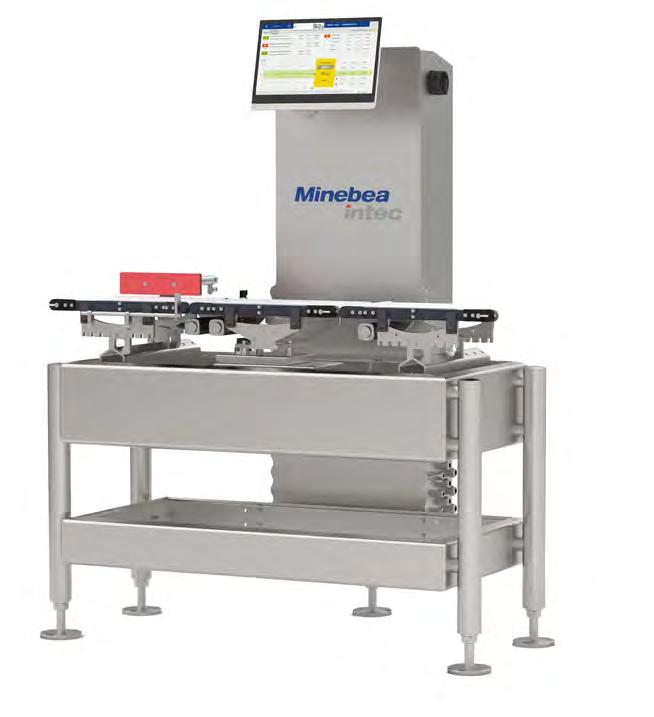
Le selezionatrici ponderali dinamiche di Minebea Intec, che monitorano il peso dei prodotti in tempo reale, aiutano a rispettare questi standard. Inoltre, il nuovo Blue HMI rende l’interfaccia delle bilance più semplice ed efficiente, consentendo di ottimizzare la tracciabilità e i processi produttivi.
Software per tracciabilità e gestione delle ricette
Minebea Intec offre anche software come SPC@Enterprise e ProRecipe XT®. Il primo raccoglie e memorizza dati di qualità e produzione, consentendo una rapida identificazione dei prodotti in caso di problemi. Il secondo è utilizzato nei processi di formulazione per garantire un dosaggio preciso degli ingredienti, particolarmente utile nei settori regolamentati come quello alimentare.
Certificazione NSF e MiNexx 3000
La certificazione NSF garantisce che i sistemi di pesatura e ispezione di Minebea Intec soddisfino gli alti standard di igiene. La piattaforma di pesatura MiNexx 3000®, certificata NSF, è infatti progettata per l’industria alimentare, con un design igienico che minimizza il rischio di contaminazione e facilita la pulizia. La precisione garantisce che i prodotti siano conformi alle quantità di riempimento richieste.
The MiNexx® 3000 weighing platform ensures reliable and highly accurate weighing results in the food industry.
ProRecipe XT® è il sistema intuitivo di gestione delle ricette per tutti i processi di formulazione manuali e semiautomatici.
ProRecipe XT® is an intuitive recipe management system designed for all manual and semiautomatic formulation processes.

Checkweighers, metal detectors, weighing platforms, X-ray inspection systems, and recipe management tools for all formulation processes: Minebea Intec provides advanced technologies designed to ensure quality and increase productivity.
Imagine an urgent meeting where the quality control team announces that metal shavings have been found in a batch of food products. A recall is now inevitable, and the team must handle a number of urgent tasks: informing customers, halting production, and inspecting machinery to prevent future contamination. According to the FDA and the EU RAPEX database, foreign bodies are responsible for up to 23% of food recalls, resulting in substantial financial losses and reputational damage.
Minebea Intec offers customers not only a wide range of advanced technologies, but also a comprehensive service network, focused on delivering reliable solutions to effectively manage situations like these. Minebea Intec supports its customers at every stage—from initial consultation to installation, commissioning, and after-sales service. This support ensures efficient products that conform to international standards, enabling manufacturers to focus on increasing sales rather than crisis management.
Strict international regulations such as HACCP, ISO 22000, and NSF set high standards for hygiene and quality in food production.
To meet these standards, while also coping with rising costs of raw materials, energy and labour, manufacturers must depend on technologies that combine reliability and precision. Minebea Intec provides customised technological solutions designed to meet these needs, as summarised below.
The HACCP preventive food safety system requires manufacturers to identify potential hazards (biological, chemical, physical) and define critical control points (CCPs) to eliminate them.
Minebea Intec’s Mitus® metal detector, featuring MiWave technology, is ideal for monitoring these critical points. Its high sensitivity allows it to detect even the smallest metal particles, contributing to product safety.
In addition, X-ray inspection systems, such as those in the Dymond series, not only detect metal contaminants but also other foreign bodies, including glass, stones, plastics, and bones. These systems also check packaging completeness and product quality, enabling manufacturers to meet international hygiene standards.
ISO 22000 standards and traceability
ISO 22000 outlines the requirements for food safety management and works in conjunction with HACCP to ensure
safe and traceable production of food.
Minebea Intec’s dynamic checkweighers support compliance with these standards by monitoring product weight in real time. In addition, the new Blue HMI simplifies the interface of the scales, enhancing efficiency and optimising traceability and production.
Minebea Intec also provides software solutions, such as SPC@ Enterprise and ProRecipe XT®. SPC@Enterprise collects and stores quality and production data, enabling rapid identification of products in the event of an issue. ProRecipe XT® supports formulation processes by ensuring accurate dosing of ingredients, which is particularly useful in highly regulated industries such as food production.
NSF certification and the MiNexx 3000
NSF certification ensures that Minebea Intec’s weighing and inspection systems meet the highest standards of hygiene. In fact, the NSF-certified MiNexx 3000® weighing platform is specifically designed for the food industry. Its hygienic design reduces the risk of contamination and makes cleaning easier. Its high level of precision ensures that products meet the required fill quantities.


icotek MIS Pad. 7, stand B76
Il nuovo Sistema di Interfaccia Modulare (MIS) di icotek è una soluzione innovativa per il collegamento di connettori industriali e di gestione dei cavi. Il sistema combina l’ingresso cavi divisibile con la possibilità di integrare i connettori 3A o 4A direttamente nel telaio. Sono adatti a questo scopo gli inserti 3A e 4A di icotek e di molti altri produttori.
Il passacavo consente l’ingresso, la sigillatura e lo scarico della trazione di cavi con e senza connettori, con diametri da 1 a 15 mm, in conformità alla norma DIN EN 62444. I connettori industriali 3A o 4A vengono inseriti direttamente nel telaio. Il sistema completo è costituito da un telaio con alloggiamento aggiuntivo per l’inserto della presa, un coperchio, due viti e un elemento di bloccaggio. Il set comprende anche la controparte, una custodia per l’inserto 3A/4A e un pressacavo (M20 per 6-12 mm o M25 per 13-18 mm).
Il telaio è conforme alla normativa CE e compatibile con numerosi produttori, tra cui Harting, Ilme, Phoenix Contact, TE Connectivity, Weidmüller, Lapp, Amphenol, Molex e RS Pro.
La nuova proposta icotek permette risparmio di spazio grazie alla combinazione
di connettori industriali e ingresso cavi che evita tagli aggiuntivi.
A questo si aggiunge un grado di protezione IP65 ottenuto grazie alla guarnizione iniettata sul retro. L’ IP65 viene mantenuto anche quando si utilizzano doppi gommini mentre il grado di protezione IP54 è ottenuto grazie al coperchio di protezione disponibile come accessorio.
La soluzione icotek permette inoltre una facile installazione poiché i gommini passacavi vengono inseriti nel telaio. Una volta assemblato, il coperchio viene avvitato, mentre il connettore viene innestato e bloccato in posizione con una clip. Il sistema garantisce elevata flessibilità che lo rende compatibile con un’ampia gamma di produttori e adatto a diverse applicazioni industriali.
In sintesi. Il MIS è la scelta perfetta per le applicazioni in cui la gestione dei cavi e il connettore devono essere integrate senza difficoltà e con un ingombro ridotto. La combinazione di funzionalità, protezione e flessibilità lo rende una soluzione unica sul mercato.
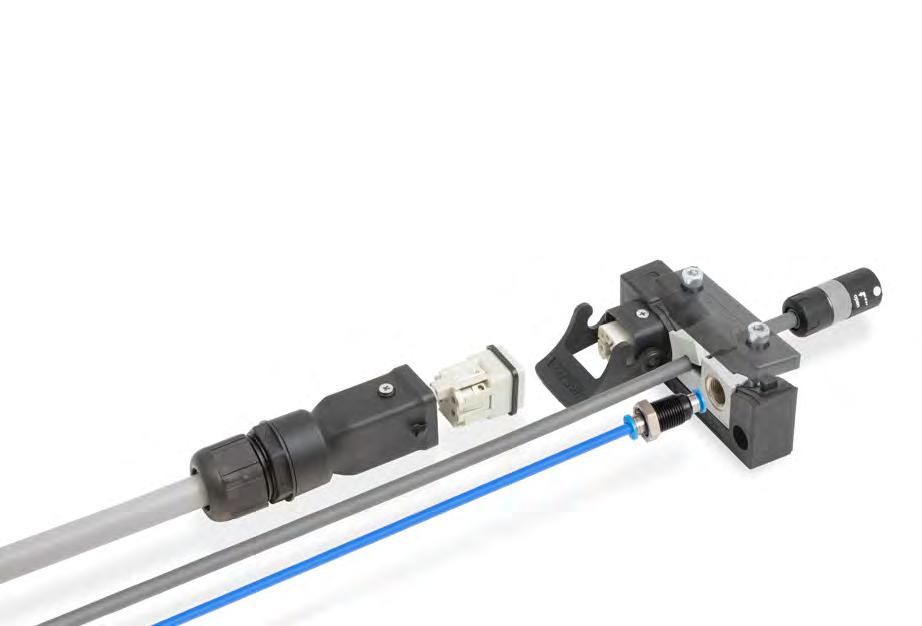
icotek MIS: Modular Interface System
Hall. 7, booth B76
The new Modular Interface System (MIS) from icotek is an innovative solution for connecting cable management and industrial connectors. The system combines a split cable entry with the option of integrating 3A or 4A connectors directly into the frame. Suitable for this are 3A and 4A inserts from icotek and many other manufacturers.
The cable entry enables the entry, sealing and strain relief of cables with and without connectors, with
cable diameters from 1 to 15 mm, in accordance with DIN EN 62444. 3A or 4A industrial connectors are plugged directly onto the frame. The complete system consists of a frame with add-on housing for the socket insert, a cover, two screws and a locking element. The set also includes the counterpart, a housing for 3A/4A pin insert and a cable gland (M20 for 6-12 mm or M25 for 13-18 mm).
The frame is CE compliant and compatible with numerous manufacturers, including Harting, Ilme, Phoenix Contact, TE Connectivity, Weidmüller, Lapp,
MIS (cifre 2315/2715)
Ingresso cavi divisibile con connettore Han 3A / Han 4A / IP65 / UL Type 12
Accessori:
I connettori non utilizzati possono essere coperti con un coperchio di protezione opzionale per garantire la protezione IP54.
Dettagli tecnici:
• Diametri dei cavi: 1 - 15 mm
• P ressacavi: M20 (6 - 12 mm), M25 (13 - 18 mm)
• Taglie dei connettori industriali: 3A, 4A
• Classi di protezione: IP65, IP54 opzionale
• Standard: UL Tpe 12, DIN EN 62444
MIS (2137/2517 digits)
Split cable entry with connections for Han 3A / Han 4A connectors / IP65 / UL Type 12
Accessories:
I connettori non utilizzati possono essere coperti con un coperchio di protezione opzionale per garantire la protezione IP54.
Technical details:
• Cable diameters: 1 - 15 mm
• Cable glands: M20 (6 - 12 mm), M25 (13 - 18 mm)
• Industrial connector sizes: 3A, 4A
• P rotection classes: IP65, optional IP54
• Standards: UL Type 12, DIN EN 62444
Amphenol,
The icotek solution is a space saving thanks to the combination of industrial connectors and cable entry avoids additional cut-outs, saving space.
Moreover the IP65 high protection rating is achieved thanks to the injected seal on the back. The IP65 degree of protection is maintained even when using double grommets; moreover IP54 is achieved with the protective cover available as an accessory.
The icotek MIS offers a simple installation thanks to the cable grommets which are
automatically fixed in the frame. Once fully assembled, the cover is screwed on and the plug is locked into place with a clip. The system offers great flexibility being fully compatible with a wide range of manufacturers and suitable for various industrial applications. The MIS is the perfect choice for applications where cable management and plug connections need to be integrated seamlessly and in a space-saving manner. The combination of functionality, protection and flexibility makes it a unique solution on the market.

Rockwell Automation

CAMA e Rockwell Automation
protagonisti di un progetto di confezionamento ad elevate performance per il settore dolciario.
Rockwell Automation: Pad. 3, stand C129
Iconsumatori non hanno mai avuto così tante opzioni. Tutti i prodotti e le specialità immaginabili, in confezioni e formati adatti a tutte le occasioni: singoli, doppi, in più gusti, nei formati snack, famiglia, gigante... insomma ce n’è per tutti! A questa varietà si aggiungono le attività di marketing e le promozioni, con prodotti stagionali, confezioni regalo e promozioni basate sui volumi, solo per citarne alcune.
Dal punto di vista della produzione, questa varietà comporta già delle complessità, ma è nel confezionamento secondario e terziario che iniziano le vere sfide, con tipi di prodotto, volumi e formati di scatole/pacchetti/promo che richiedono un’ampia gamma di soluzioni di confezionamento. Molti utilizzatori finali, inoltre, spesso richiedono che tutte queste funzionalità siano disponibili in un’unica macchina.
Una linea flessibile per soddisfare ogni esigenza del consumatore
E questa è stata la sfida lanciata da Hawaiian Host, azienda nordamericana con sede a Honolulu, leader nell’industria dolciaria e il più grande produttore al mondo di noci di macadamia ricoperte di cioccolato.
Hawaiian Host Group necessitava una nuova macchina per il confezionamento primario dei
prodotti a base di macadamia, una soluzione che ottimizzasse l’operatività dell’azienda e, al contempo, fornisse un approccio modulare per poter gestire future innovazioni di prodotto.
A raccogliere la sfida non poteva che essere una importante realtà italiana: Cama Group, leader nella progettazione e produzione di macchine per l’imballaggio nel settore alimentare.
La cooperazione tra CAMA e Rockwell
Automation: un caso di successo
La linea creata da Cama Group per Hawaiian Host Group è stata progettata su misura per affrontare le specifiche problematiche del cliente. È dotata di un’architettura di controllo
Rockwell Automation che include PLC, drive, HMI, switch e blocchi I/O. Questo ha permesso di ottenere il massimo rendimento grazie alla Integrated Architecture®, un sistema di controllo e informazione unificato di Rockwell Automation che fornisce una piattaforma di controllo un framework di progettazione standard, connettività interoperabile e sicura, strumenti di visualizzazione e dispositivi intelligenti per svariate discipline. Sono state inoltre utilizzate soluzioni la realtà aumentata per la formazione, i cambi di prodotto e formato e la manutenzione.
Il cuore della macchina sono i robot delta integrati di pinze appositamente progettate. In base alle informazioni sulla qualità, la forma e la posizione fornite da uno scanner laser avanzato, prelevano i cioccolatini dal nastro trasportatore e li posizionano delicatamente in vaschette di polietilene tereftalato (PET) che arrivano in parallelo da un disimpilatore.
Una volta riempite, le singole vaschette - o le coppie di vaschette separate da un foglio di imbottitura - sono caricate in scatole di cartone prima che vengano formati e inseriti i coperchi. Il risultato finale sono scatole complete

contenenti da quattro a 32 cioccolatini.
La linea è anche in grado di realizzare confezionamento sfuso, dove i robot caricano i cioccolatini direttamente nelle scatole. Questo tipo di confezionamento sfuso è utilizzato anche come ripiego nel caso si presentassero problemi alla linea e può evitare tempi di fermo significativi. Al termine del processo, le scatole vengono sottoposte a raggi X e poi trasportate a una incartonatrice a fine linea.
Risultati di successo con l’automazione avanzata
La collaborazione tra CAMA e Rockwell Automation si è rivelata un motore di trasformazione per Hawaiian Host Group. L’automazione avanzata ha non solo incre -
CAMA and Rockwell Automation lead a high-performance packaging project for the confectionery industry. Rockwell Automation: Hall 3, booth C129
Today's consumers have more choices than ever before. Every imaginable product and speciality, available in packaging and formats suitable for every occasion: single packs, twin packs, assorted flavours, snack-size, family packs, and jumbo formats... there is truly something for everyone! Adding to this variety are marketing activities and promotions, including seasonal products, gift packaging and volume-based offers, to name just a few.
From a production standpoint, this diversity already brings a certain level of complexity. However, the real challenges emerge in secondary and tertiary packaging, where product types, volumes and box/pack/promo formats demand a wide range of packaging solutions. Moreover, many end users expect all these capabilities to be integrated into single machine.
A flexible line to meet every consumer need
This was the challenge set by Hawaiian Host Group, a North American company based in Honolulu, a leader in the confectionery industry and the world's largest producer of chocolate-covered macadamia nuts.
mentato l’efficienza, accelerando la produzione e minimizzando i tempi di inattività, ma ha anche introdotto una notevole flessibilità, grazie a un sistema modulare pronto ad accogliere le future evoluzioni dei prodotti. Parallelamente, l’integrazione di sofisticati controlli di sicurezza ha elevato gli standard di protezione per i lavoratori. L’ottimizzazione dei processi, di conseguenza, ha portato a una significativa riduzione dei costi operativi, mentre l’automazione stessa ha agito da garante per una maggiore qualità del prodotto. L’adozione di queste soluzioni innovative non solo consolida la posizione di Hawaiian Host Group nel mercato, ma apre anche nuove prospettive di crescita e competitività nel lungo termine.
The company needed a new machine for the primary packaging of its macadamia products - a solution that would optimise current operations while offering a modular design capable of handling future product innovations.
Rising to the challenge was Cama Group, a major Italian company and a leading designer and manufacturer of packaging machines for the food industry.
The collaboration between CAMA and Rockwell Automation: a success story
The line developed by Cama Group for Hawaiian Host Group was custom-designed to address the company's specific needs. It is equipped with a Rockwell Automation control architecture that includes PLCs, drives, HMIs, switches and I/O modules. This was made possible through Rockwell Automation's Integrated Architecture®, a unified control and information system that connects industrial operations across multiple disciplines, offering one control platform, a standard design framework, interoperable and secure connectivity, visualisation tools and smart devices. Augmented reality
solutions were also used for training, product and format changes and maintenance.
At the heart of the machine are delta robots equipped with specially designed grippers. Using quality, shape and position data provided by an advanced laser scanner, the robots pick up chocolates from the conveyor belt and gently place them into polyethylene terephthalate (PET) trays, which arrive in parallel from a de-stacker.
Once filled, the individual trays - or pairs of trays separated by a padding sheet - are loaded into cardboard boxes, after which the lids are formed and inserted. The final result is complete boxes containing between four and 32 chocolates.
The line is also capable of bulk packaging, with robots loading chocolates directly into boxes. This type of bulk packaging also serves as a fallback option in the event of line problems, helping to prevent significant downtime. At the end of the process, the boxes are x-rayed and then transported to a cartoning machine at the end of the line.
Successful results through advanced automation
The collaboration between CAMA and Rockwell Automation proved to be a powerful driver of transformation for Hawaiian Host Group. Advanced automation has not only increased efficiency - accelerating production and minimising downtime - but has also introduced considerable flexibility, thanks to a modular system designed to accommodate future product innovations. At the same time, the integration of sophisticated safety controls has raised the standards of worker protection. Process optimisation has also resulted in a significant reduction in operating costs, while automation itself has served as a key factor in ensuring high product quality. The adoption of these innovative solutions has not only strengthened Hawaiian Host Group's market position but also opened new opportunities for long-term growth and competitiveness.

La nuova serie di inverter di frequenza Bonfiglioli è la scelta ideale per le applicazioni di imballaggio, garanzia di grande flessibilità e prestazioni di alto livello. Grazie alla sua struttura modulare, il sistema si integra perfettamente in qualsiasi tecnologia e rete di automazione
Bonfiglioli ed è compatibile con un’ampia gamma di protocolli Fieldbus, sia su base seriale che su base Ethernet, a favore di una produzione ottimizzata, in linea con gli standard dell’Industria 4.0.
AxiaVert di Bonfiglioli pone la sicurezza funzionale al primo posto e offre tutte le principali funzioni di sicurezza richieste
dal mercato: STO, SS1, SBC, SLS, SLP, SOS. Le sue varianti di Sicurezza Funzionale consentono di perfezionare la configurazione, senza la necessità di aggiungere componenti di sicurezza esterni e garantendo un’operatività sicura e monitorata, a rischio minimo.
AxiaVert di Bonfiglioli rappresenta la migliore opzione di integrazione della comunicazione Fieldbus over EtherCAT (FsoE) perché elimina gli elevati costi di manodopera e cablaggio veicolando tutte le comunicazioni di sicurezza tra l’inverter, il PLC e i componenti dell’architettura di sicurezza, direttamente sul fieldbus.
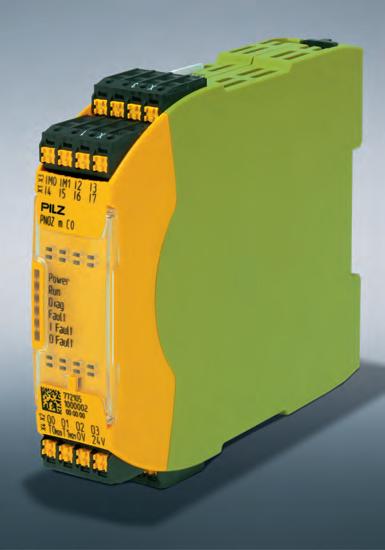
Bonfiglioli AxiaVert now with new safety functions
The new Bonfiglioli AxiaVert Series is the ideal choice for packaging, guarantee of great flexibility and the highest levels of performance. Thanks to its modular design, AxiaVert is a drive which offers seamless integration into any Bonfiglioli technology and automation networks, as well as compatibility across an extensive range of Fieldbus protocols, both on serial and Ethernet ones, fostering production optimization in accordance with Industry 4.0 standards.
Bonfiglioli’s AxiaVert prioritizes functional safety, therefore, it offers all the main safety functions required by the market: STO, SS1, SBC, SLS, SLP, SOS. Its different Functional Safety variants allow to optimize configuration, reducing the need for external safety components and ensuring a safe and controlled operation to minimize standards.
Bonfiglioli’s AxiaVert represents the best integration of the Fieldbus EtherCAT FSoE communication, which eliminates significant labor and cabling costs by carrying all safety communication between

Da Pilz il più piccolo sistema di controllo di sicurezza: PNOZ mC0
PNOZ mC0 è una soluzione semplice, compatta e flessibile per la sicurezza delle macchine. Grazie ai suoi 8 ingressi sicuri è possibile collegare funghi di emergenza, sensori RFID, barriere fotoelettriche, gestire muting, bimanuali e governare numerose altre funzioni tra cui vari attuatori di diverso tipo con i loro eventuali feedback attraverso le 4 uscite sicure. La semplicità di programmazione è garantita dalla versione gratuita del PNOZmulti Configurator 11 che offre elevati livelli di sicurezza e flessibilità. La versione più recente include la funzione di gestione utenti che permette di proteggere il dispositivo base PNOZ m C0 da accessi non autorizzati. Grazie ad una security key memorizzata nel dispositivo, inoltre, è possibile proteggere la logica di sicurezza da eventuali manipolazioni esterne. In sintesi, con PNOZ m C0, un solo modulo garantisce molteplici soluzioni di sicurezza.
inverter, PLC and safety architecture components, directly over the fieldbus.
PNOZ mC0 is a simple, compact and flexible solution for machine safety. With its 8 safe inputs, it is possible to connect emergency stop buttons, RFID sensors and light curtains, manage muting and two-hand controls and regulate numerous other functions including various actuators of different types with their
possible feedback through the 4 safe outputs.
Easy programming is guaranteed by the free version of PNOZmulti Configurator 11, which offers high levels of safety and flexibility. The latest version includes the user management function to protect the basic PNOZ m C0 device from unauthorized access. With a security key stored in the device, it is also possible to protect the safety logic from external tampering. To sum up, with PNOZ m C0, one module is sufficient to guarantee multiple safety solutions.
Pad. 5, stand B90
Le macchine di confezionamento richiedono precisione, velocità e affidabilità in spazi sempre più compatti. I servoattuatori premo® di WITTENSTEIN alpha sono progettati proprio per rispondere a queste esigenze, offrendo massima densità di potenza, alta efficienza energetica e integrazione semplificata, anche negli ingombri più ridotti: premo® è quindi la risposta ideale a chi cerca prestazioni e sicurezza nelle linee di packaging di nuova generazione.
Grazie al design compatto e modulare questi servoattuatori consentono configurazioni personalizzate di motori e riduttori, ottimizzando le prestazioni in funzione dell’applicazione. La tecnologia monocavo digitale dimezza il cablaggio e migliora la gestione termica ed energetica: un vantaggio chiave per le macchine flow-pack e i sistemi di confezionamento ad alta velocità, dove ogni frazione di secondo conta. La serie premo® include tre linee progettate per rispondere a ogni esigenza. TP Line, ad alta dinamica, è perfetta per applicazioni complesse e cicli produttivi rapidi; con SP Line, dotato di resolver e albero liscio, Wittenstein guarda ai sistemi di movimentazione, mentre XP Line, progettata per essere estremamente versatile, offre alte prestazioni e robustezza in uno spazio minimo. A completare l’offerta: lubrificanti per ambienti alimentari, encoder certificati fino a SIL2, freni di stazionamento potenziati e numerose opzioni geometriche e sensori.
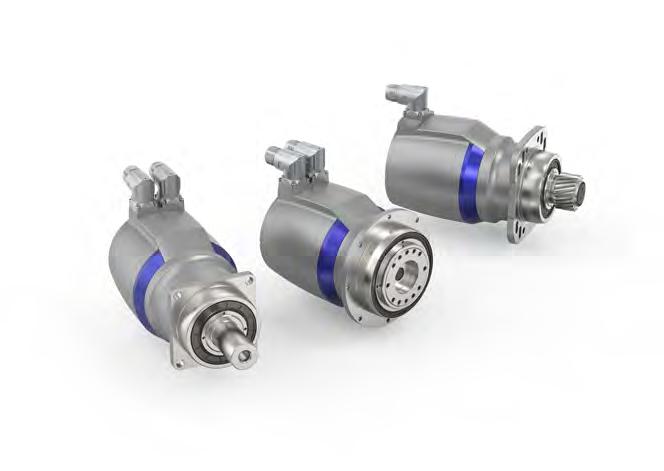
premo®: the evolution of WITTENSTEIN alpha servo actuators
Hall 5, booth B90
Packaging machines require precision, speed and reliability in increasingly compact spaces.
WITTENSTEIN alpha premo® servo actuators are designed precisely to meet these needs, offering maximum power density, high energy efficiency and simplified integration, even in the smallest of spaces.,Thanks to their compact and modular design, premo® servo actuators enable customized motor and gearbox configurations, optimizing performance according to the application. Digital singlecable technology cuts wiring by half and improves thermal and energy management: a key advantage for flow-pack machines and high-

casa /’kasa/ s. f.
Est.: Luogo degli affetti, con il sinonimo di famiglia
speed packaging systems, where every fraction of a second counts. The premo® series includes three lines designed to meet every need.
With the highly dynamic TP Line, perfect for complex applications and fast production cycles; with SP Line, equipped with resolver and smooth shaft, Wittenstein looks towards handling systems, while XP Line, designed to be extremely versatile, offers high performance and robustness, occupying minimal space. The offer is completed with lubricants for food environments, encoders certified up to SIL2, enhanced holding brakes, and numerous geometric and sensor options.
All this makes premo® the ideal answer for those seeking performance and safety in next-generation packaging lines.
IMA 27-30 MAGGIO 2025 - FIERA MILANO PADIGLIONE 1 - STAND C-17/D-18
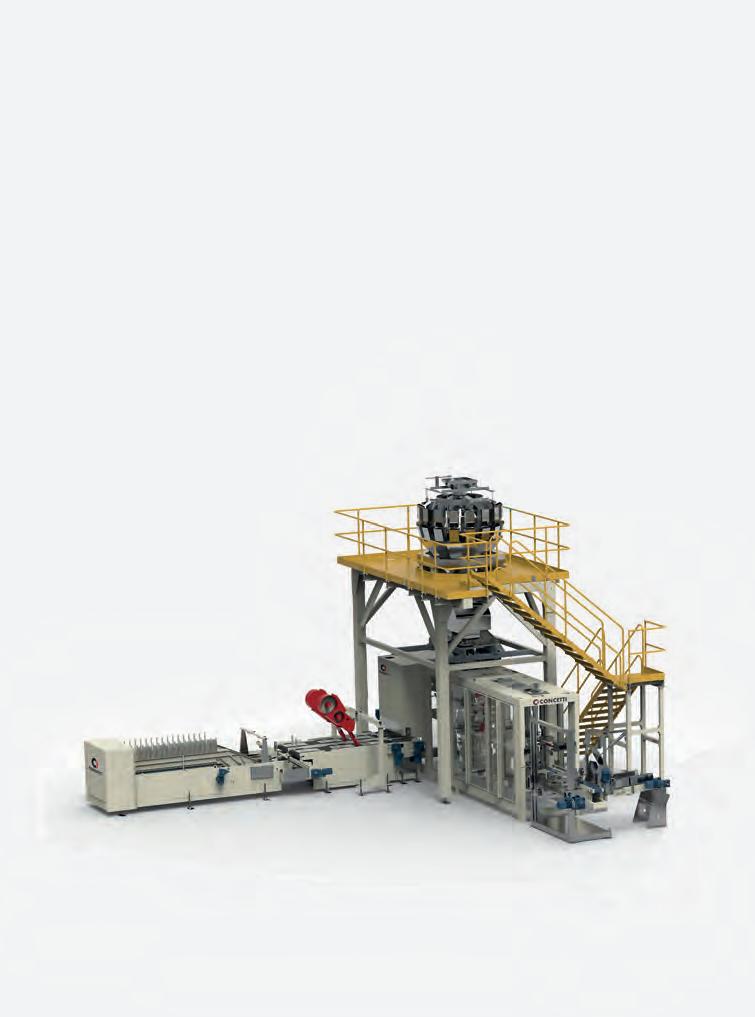
SCOPRI L’INNOVAZIONE NEL CONFEZIONAMENTO PER IL PET FOOD!
Visita lo Stand C17-D18, Padiglione1, e scopri come la nostra IPF 25 può trasformare il tuo processo produttivo.
Non perdere l’occasione di toccare con mano l’innovazione che fa la differenza!

Un partner all’avanguardia
per un’industria del packaging sempre più sostenibile
Pad. 5, stand A81
Dal 1959 SMC è sinonimo di innovazione nel settore dei componenti pneumatici per l’automazione industriale. Con 12.000 prodotti base e più di 700.000 varianti, dal trattamento aria alla strumentazione, alle valvole e attuatori, offre soluzioni d’avanguardia per l’industria Automobilistica, Elettronica, Alimentare e Life Science. Il settore del packaging in cui SMC opera è costantemente chiamato a rispondere a sfide sempre più complesse, dettate da normative stringenti in materia di confezionamento, protezione del prodotto, tracciabilità e sostenibilità che guida la ricerca su design e nuovi materiali.
Soluzioni avanzate per la gestione del packaging secondario
In un contesto così dinamico e competitivo, l’imballaggio di secondo livello - che comprende operazioni come il Pick and Place, la pallettizzazione e la preparazione alla distribuzione - riveste un ruolo strategico per garantire un flusso produttivo continuo, efficiente e ottimizzato. In questo contesto, SMC rappresenta un partner tecnologico di riferimento, offrendo componenti e sistemi progettati per massimizzare la produttività e ridurre i costi operativi facendo di sicurezza, affidabilità e innovazione le sue parole chiave. La gamma SMC comprende sistemi di presa, ventose e eiettori, tutti pensati per rispondere alle esigenze specifiche delle moderne linee di imballaggio.
La ventosa ZP3C
Tra i prodotti più versatili, la ventosa ZP3C si distingue per la sua capacità di trasferire con efficacia materiali abrasivi come il cartone. Disponibile in versioni piane con nervature sia a soffietto che in diametri da 40 a 50 mm, la ZP3C garantisce un’elevata resistenza all’usu-


ra e consente la notevole riduzione dei costi di manutenzione; caratteristiche che ne fanno la soluzione ideale per applicazioni Pick and Place e processi di confezionamento che richiedono affidabilità e costanza di prestazioni anche nei cicli più intensi.
Sistema di presa a vuoto ZGS
Per applicazioni dove compattezza, integrazione e velocità sono fattori chiave, SMC propone il nuovo sistema di presa con il vuoto ZGS, una soluzione all-in-one perfettamente integrabile con robot industriali e collaborativi. Il design modulare semplifica l’installazione, riduce i tempi di avviamento e facilita la manutenzione. Il sistema comprende un eiettore compatto, una spugna, valvole di alimentazione e rottura, vacuostato, connettore M8 per la connessione rapida e un’alimentazione pneumatica diretta. Con ZGS, l’efficienza nelle operazioni di pallettizzazione viene completamente ridefinita.
Eiettori ZKJ
Per esigenze più complesse, come quelle legate a sistemi di trasferimento tramite vuoto, macchine di assemblaggio automatico, linee di imballaggio e disimballaggio o nastri trasportatori per pannelli, SMC propone il manifold di eiettori ZKJ, una soluzione ad alte prestazioni dotata di controllo integrato. La sua architettura permette la gestione simultanea fino a 16 eiettori attraverso un unico dispositivo, integrando la comunicazione via bus di campo e garantendo un’elevata efficienza energetica. Grazie al design compatto e all’integrazione dei collegamenti su un solo lato, il modello ZKJ si adatta perfettamente anche agli ambienti di lavoro più esigenti. Attraverso questa gamma di componenti avanzati, SMC supporta concretamente gli operatori del settore nel migliorare produttività, efficienza e sostenibilità.

A cutting-edge partner for an increasingly sustainable packaging industry Hall 5, Booth A81
Since 1959, SMC has been synonymous with innovation in the field of pneumatic components for industrial automation. With 12,000 basic products and more than 700,000 variations, from air treatment to instrumentation, valves and actuators, it offers cutting-edge solutions for the Automotive, Electronics, Food and Life Science industries. The packaging industry SMC operates in is constantly called upon to respond to increasingly complex challenges, dictated by stringent regulations on packaging, product protection, traceability and sustainability that drives research into design and new materials.
Advanced solutions for secondary packaging management
In such a dynamic and competitive environment, secondary packaging - which includes operations such as Pick and Place, palletizing and preparation for distribution - plays a strategic role in ensuring a continuous, efficient and optimised production flow. In this context, SMC is a technology partner of choice, offering components and systems designed to maximise productivity and reduce operating costs, making safety, reliability and innovation its keywords. The SMC range includes gripper systems, pads and ejectors, all designed to meet the specific needs of modern packaging lines.
One of the company’s most versatile products, the ZP3C pad stands out for its ability to efficiently transfer abrasive materials such as cardboard. Available in flat versions with ribs, both with bellows and with diameters from 40 to 50 mm, the ZP3C guarantees excellent resistance to wear and tear and significantly reduces maintenance costs. These features make it the ideal solution for Pick and Place applications and packaging processes that require reliability and consistent performance even in the most intensive cycles.
ZGS vacuum gripper system
For applications where compactness, integration and speed are key factors, SMC offers the new ZGS vacuum gripper system, an all-in-one solution that can be perfectly integrated with industrial and collaborative robots. The modular design simplifies installation, reduces start-up time and facilitates maintenance. The system includes a compact ejector,

foam, supply and release valves, pressure switch, M8 connector cable for quick connection and a direct pneumatic supply. ZGS redefines efficiency in palletizing operations.
ZKJ ejectors
For more complex requirements, such as vacuum transfer systems, automatic assembly machines, packaging and unpacking lines or panel conveyors, SMC offers the ZKJ vacuum manifold, a highperformance solution with integrated control. Its architecture enables the simultaneous management of up to 16 ejectors through a single device, integrating fieldbus communication and ensuring high energy efficiency. Thanks to its compact design and single-side connection integration, the ZKJ fits perfectly into even the most demanding working environments. Through this range of advanced components, SMC provides practical support to industry players in improving productivity, efficiency and sustainability.

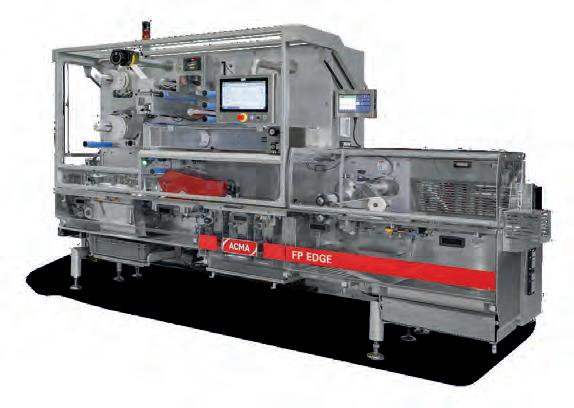
ACMA is one of the leading manufacturers of packaging machines in the consumer goods market, with a large international share. It designs and manufactures automatic packaging machines for such sectors as Confectionery, Detergents and Soaps, and E-commerce.
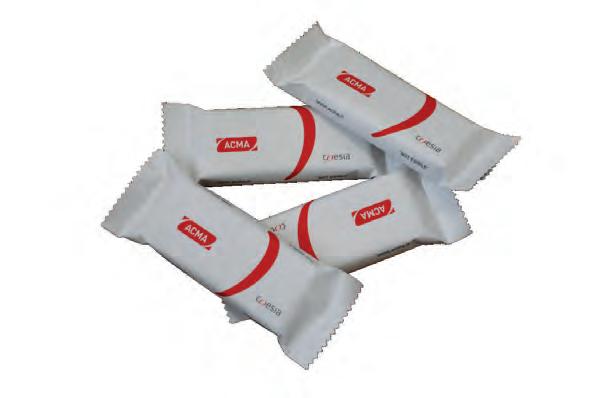
FP EDGE is a high-speed continuous motion horizontal form-fill and seal machine designed to flowrap products with cold-sealing material taken from a reel at a film speed up to 150 m/ min. Ready to manage paper-based materials, it’s engineered for efficiency and flexibility, ensuring seamless integration of both plastic and paper materials for eco-friendly packaging solutions. The system optimizes production quality and material consumption, aligning with modern sustainability standards. Visit acma.it to discover more!







Il Gruppo ha sviluppato una linea innovativa di prodotti per il confezionamento alimentare che aderisce alle più stringenti normative in materia di qualità e sicurezza.
Con il passare del tempo, i prodotti alimentari si alterano, perdendo qualità. Per allungare la vita del cibo, garantirne la sicurezza e mantenere le qualità, la ricerca ha perfezionato tecniche di confezionamento in atmosfera protettiva dove, nel processo di confezionamento di alimenti e bevande, l’aria viene sostituita da gas o miscele che tutelano le proprietà organolettiche e nutritive.
Foodline®: shelf life e riduzione dello spreco alimentare
Foodline® garantisce molti benefici, tra cui la pianificazione ed efficientamento produttivo, la riduzione dei costi di produzione e degli scarti, la migliore copertura territoriale e distributiva, la conservazione delle qualità organolettiche e, fondamentale, elevati livelli di sicurezza alimentare. Vantaggi economici a cui si affiancano i benefici in termini di sostenibilità poiché freschezza, colore, gusto e aroma vengono preservati, migliorando così la shelf-life. La conservazione in atmosfera protettiva, quindi, è
fortemente eco-sostenibile: oltre a prolungare la vita degli alimenti ed evitare di gettarli prima del necessario, riduce il numero di trasporti necessari alla distribuzione, grazie all’ottimizzazione dell’immagazzinamento e dello stoccaggio.
Aroma+: un’esperienza più intensa
Per evitare cattivi odori all’apertura delle confezioni, la fase di confezionamento alimentare è una delle più sensibili e centrali nel ciclo di vita di un prodotto. Il fenomeno non è tanto dovuto alla cattiva qualità o alla scorretta conservazione dell’alimento, bensì dalla normale presenza di composti organici volatili imponendo all’industria alimentare di trovare delle soluzioni. La miscela di gas e aromi del sistema brevettato da SIAD, minimizza la presenza delle molecole responsabili degli odori sgradevoli ed esalta la qualità dei prodotti. Aroma+, abbinato al confezionamento MAP con i gas Foodline®, permette al consumatore di percepire all’olfatto, le migliori caratteristiche del prodotto confezionato. Un successo ottenuto grazie alla giusta combinazione di miscele, gas e aromi specifici messi a



punto dalla lunga esperienza di SIAD nel settore. Aroma+ permette di esaltare le qualità organolettiche di qualsiasi prodotto con una tecnologia di facile installazione e utilizzo. Il sistema Aroma+ viene posizionato direttamente a bordo della macchina confezionatrice e permette di completare l’operazione aggiungendo all’alimento il gas aromatizzato, attivando o escludendo questa
SIAD SPA
Via San Bernardino 92 24126 Bergamo, tel. 035-328111 foodandbeverage@siad.eu.
opzione a seconda dell’alimento trattato. Un team di esperti SIAD affianca il cliente in tutto il percorso di installazione e gestione, fin dalla selezione dell’aroma naturale più adatto al prodotto con un’ampia scelta che spazia dalle note olfattive neutre, per accrescere il profumo naturale del prodotto, ai toni più intensi, come il rosmarino, per valorizzare ulteriormente l’alimento.
The Group has developed an innovative line of food packaging products that adheres to the most stringent quality and safety regulations.
Over time, food products alter, with a decline in quality. To extend the life of food, ensure safety, and maintain quality, research has perfected protective atmosphere packaging techniques where, in the process of packaging food and beverages, air is replaced by gases or mixtures that protect the organoleptic and nutritional properties.
Foodline®: shelf life and reducing food waste
Foodline® offers many benefits, including production planning and efficiency, a reduction in production costs and waste, improved territorial and distribution coverage, preservation of organoleptic qualities and, crucially, high levels of food safety. These economic benefits are complemented by
sustainability benefits, because freshness, colour, taste and aroma are preserved, thus improving shelf-life. Protective atmosphere storage is thus particularly ecofriendly: in addition to prolonging the life of food and avoiding throwing it away earlier than necessary, it reduces the amount of transport required for distribution, by optimizing storage and warehousing.
Aroma+: a more intense experience
To avoid unpleasant odours when packages are opened, food packaging is one of the key stages in a product’s life cycle. This is due not so much to poor quality or improper storage of the food as to the normal presence of volatile organic compounds, forcing the
food industry to find solutions. The mixture of gases and aromas in the system patented by SIAD minimizes the presence of the molecules responsible for unpleasant odours, enhancing product quality. Aroma+, combined with MAP packaging with Foodline® gases, allows the consumer to perceive the finest characteristics of the packaged product through their sense of smell. This successful result has been achieved thanks to the right combination of specific blends, gases and flavourings developed thanks to SIAD’s long experience in the sector. Aroma+ makes it possible to enhance the organoleptic qualities of any product, with technology that is easy to install and use. The Aroma+ system is placed directly on
board the packaging machine and allows the operation to be completed by adding flavoured gas to the food, activating or excluding this option depending on the type of food being processed.
A team of SIAD experts supports the customer throughout the installation and management process, starting from the selection of the most suitable natural aroma for the product, with a wide selection of options ranging from neutral olfactory notes, to boost the natural aroma of the product, to more intense tones, such as rosemary, to further enhance the food.
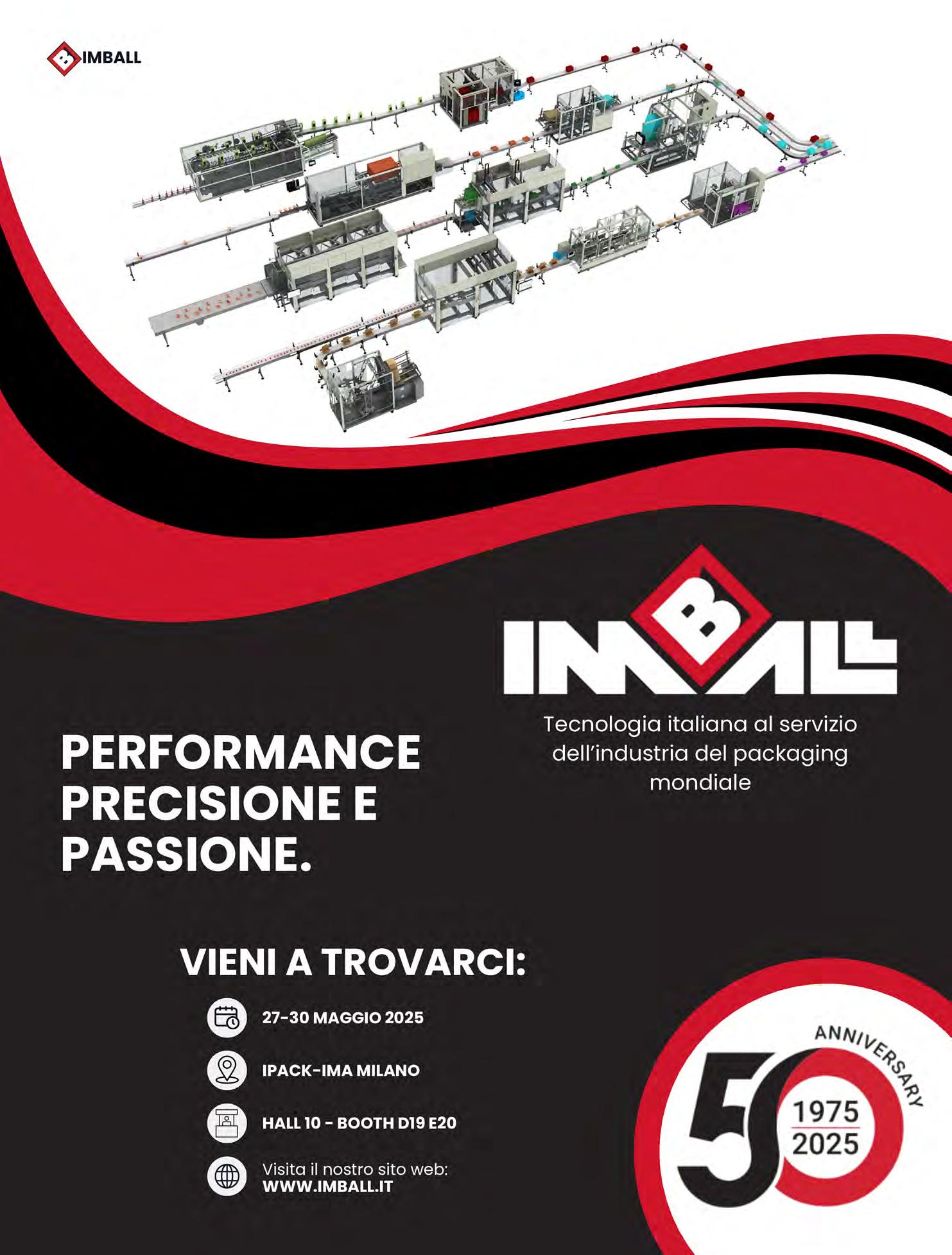


SPL Industries presenta il nuovo bancale in lamiera riciclabile, intelligente e resistente, progettato per rispondere alle esigenze della logistica moderna Pad. 1, stand A127
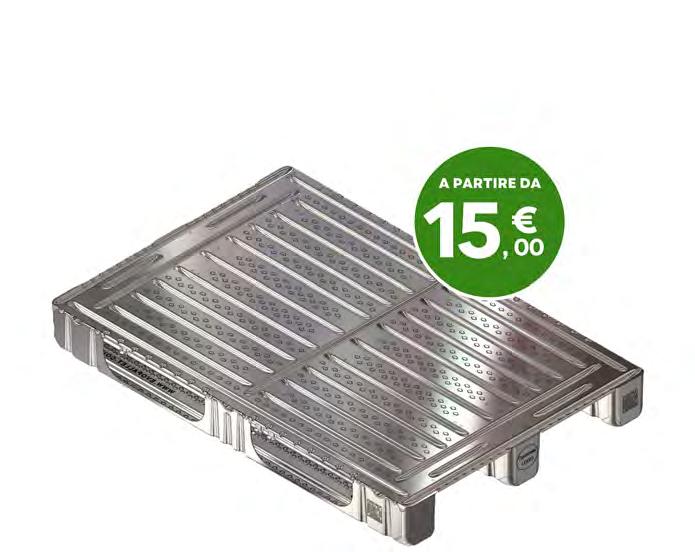
Si chiama Evopallet l’innovativo prodotto sviluppato e brevettato da SPL Industries, un’eccellenza italiana operante nel centro Italia nell’ambito dello stampaggio lamierati, che si distingue per un processo produttivo completamente internalizzato. La potenzialità dell’azienda è basata su tecnologie all’avanguardia e impianti robotizzati di ultima generazione, che garantiscono efficienza e standard elevati.
Grazie alla propria visione e a un team altamente specializzato, SPL Industries ha progettato e sviluppato una delle innovazioni più ambiziose: il pallet del futuro, EVOPALLET. In un contesto in cui la logistica è chiamata a ridurre l’impatto ambientale senza rinunciare a efficienza e sicurezza, Evopallet rappresenta una risposta evoluta e concreta. Progettato e prodotto interamente in Italia, è realizzato con materiali 100% riciclabili e un processo produttivo alimentato da energia rinnovabile.
I punti di forza
Evopallet si distingue per digitalizzazione, resistenza e personalizzazione. A differenza dei pallet tradizionali, non si deteriora, non assorbe umidità e non rilascia schegge o polveri. È ignifugo, lavabile, inodore e adatto anche ad ambienti controllati come quelli farmaceutici o alimentari.

Il particolare design realizzato in lamiera zincata con struttura antiscivolo, garantisce stabilità e flessione minima anche sotto carichi elevati. Compatibile con i sistemi automatizzati che utilizzano EPAL, resiste a notevoli escursioni termiche e può essere stoccato all’aperto senza rischio di degrado.
Con un prezzo a partire da 15€, Evopallet offre il vantaggio di un recupero economico alla rottamazione fino al 30% del valore, promuovendo economia circolare e risparmio.
Dotato di codice univoco Data Matrix - con possibilità di scegliere tra QR Code e Barcode - inciso a laser su ogni lato, assicura tracciabilità in tempo reale, gestione intelligente del magazzino e ottimizzazione dei flussi anche con un deterioramento del codice fino al 30% della superficie. Infine, è completamente personalizzabile nei colori e nel logo, e grazie alla sua leggerezza rispetto al legno, riduce i costi di trasporto e aumenta l’efficienza operativa.
Evopallet non è solo un pallet: è un sistema completo ed evoluto di soluzioni integrate per chi punta all’eccellenza operativa salvaguardando l’ambiente.
Sul web: www.evopallet.com

SPL Industries unveils a new, recyclable, smart and durable sheet metal pallet designed to meet the needs of modern logistics Hall 1, booth A127
Evopallet is the name of this innovative product developed and patented by SPL Industries, an outstanding company operating in central Italy in the field of sheet metal stamping, with production carried out entirely in-house. The company’s potential is based on cutting-edge technology and state-of-the-art robotic equipment, which ensure efficiency and high standards.
With its vision and highly specialized team, SPL Industries has designed and developed a particularly ambitious innovation: EVOPALLET, the pallet of the future. In a context where the logistics process is required to reduce environmental impact without compromising on efficiency and safety, Evopallet offers an advanced, practical response. Designed and manufactured entirely in Italy, it is made with 100% recyclable materials and a production process powered by renewable energy.
Evopallet stands out for digitalization, strength, and customization. Unlike traditional pallets, it does not deteriorate, absorb moisture, or release splinters or dust. It is flame retardant, washable, odourless, and is also suitable for controlled environments such as those in the pharmaceutical or food sector. The special design made of galvanized sheet metal with a non-slip structure ensures stability and minimal bending even under high loads. Compatible with automated systems using EPAL, it is able to withstand significant temperature fluctuations and can be stored outdoors without risk of damage.

With prices starting at €15, Evopallet offers the advantage that up to 30% of its value can be recovered when scrapped, aiding the circular economy and saving money.
With a unique Data Matrix code - QR Code or Barcode - laser-engraved on each side, it ensures real-time traceability, intelligent warehouse management and flow optimization even with code deterioration of up to 30% of the surface area. Finally, logos and colours are fully customizable, and because it is lighter than wood, transportation costs are lower and operational efficiency is improved.
Evopallet is more than just a pallet: it is a complete, advanced system of integrated solutions for those seeking operational excellence while safeguarding the environment.
Website: www.evopallet.com



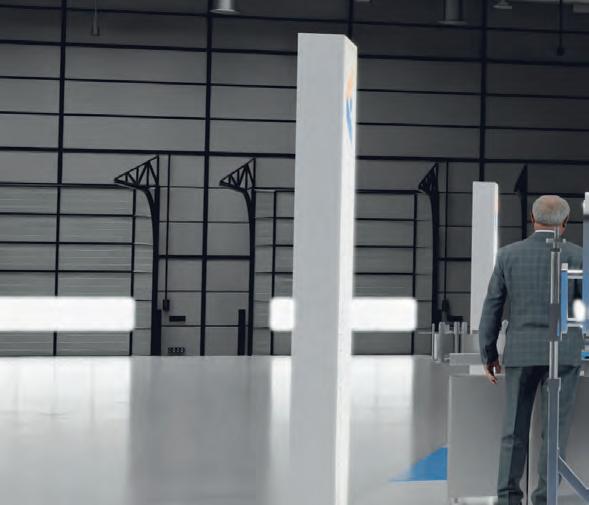






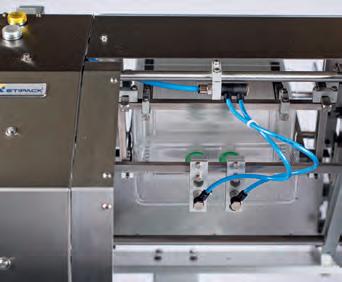
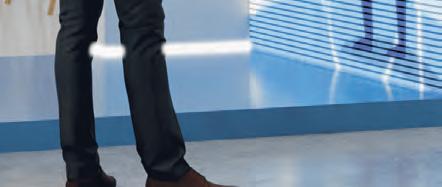
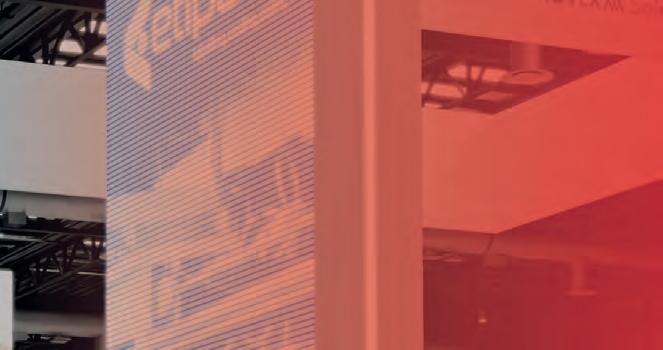



















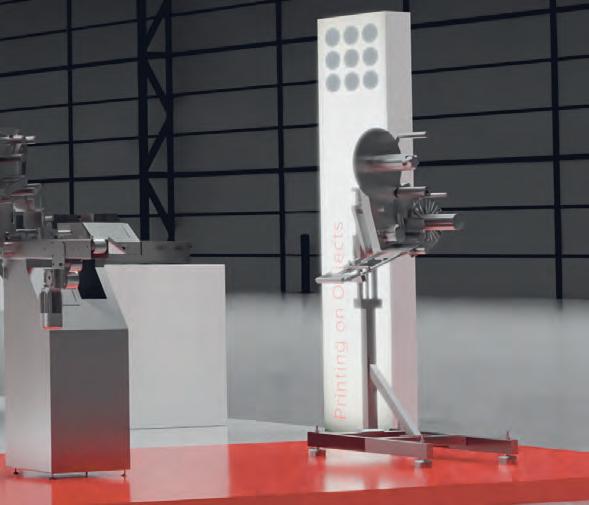


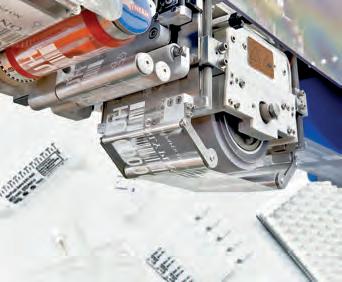




Essere flessibili va bene, essere veloci e flessibili è meglio. Le macchine confezionatrici della Schubert dimostrano come si fa. Il controllo intelligente e la robotica precisa sostituiscono la meccanica complicata garantendo la massima flessibilità in tutti i processi di confezionamento. Di conseguenza l‘80% dei gruppi industriali leader di FMCG (fast-moving consumer goods) si affidano a noi e al confezionamento perfetto con consumi minimi. Proprio come vuole la nostra Mission Blue. Creiamo situazioni win-win: per il pianeta e per voi. www.schubert.group/en/food.html

Panoramica sulle tecnologie che animeranno la prossima edizione di Ipack-Ima e Pharmintech. L’innovazione, intesa come progresso su sostenibilità e digitale, non può prescindere da un’assidua ricerca verso nuovi materiali, macchine e componenti che, insieme, possano dialogare in modo intelligente per alzare l’asticella della produttività. Questo è ciò che principalmente traspare dalla voce diretta degli espositori di cui vi proponiamo una sintesi.
Servizio a cura della Redazione di ItaliaImballaggio, in collaborazione con Ipack-Ima
Overview of the technologies that will be enlivening the upcoming edition of Ipack-Ima and Pharmintech. Innovation - in terms of progress on sustainability and digitalisation - is reliant on consistent research into new materials, machines and components that can work together intelligently to raise the bar with regard to productivity. This is the main conclusion that transpires from what we heard straight from the mouths of exhibitors, a summary of which is offered here.
Edited by ItaliaImballaggio in cooperation with Ipack-Ima

With 20 years of experience in the automation and packaging industry and located in Scandiano, Reggio Emilia, at the heart of Emilia's 'Packaging Valley', Ercopac leverages flexibility, innovation, and sustainability to drive its business growth. “Although our brand is now consolidated, we are constantly working to increase its recognition through participation in international
Direttore Commerciale e Fondatore Pad. 6, stand G01 - H02
Attiva nel settore dell’automazione e del packaging con un’esperienza ventennale, Ercopac ha sede a Scandiano in provincia di Reggio Emilia. L’azienda fa di flessibilità, innovazione e sostenibilità le leve di sviluppo del proprio business.
“Per quanto il nostro brand sia ormai consolidato, lavoriamo costantemente per aumentarne la riconoscibilità attraverso la partecipazione a fiere internazionali come Ipack-Ima. Tra le soluzioni in fiera i robot delta per i nostri sistemi di pallettizzazione, nello specifico per la preparazione a strato, che permettono di manipolare carichi fino a 50 kg
fairs such as Ipack-Ima. In terms of solutions, one new development is particularly interesting: the integration of delta robots into our palletising systems, specifically for layer preparation, enables us to handle loads of up to 50 kg with exceptional performance and efficiency. At Ipack-Ima we will also be presenting the new patents with which we aim to improve the
con prestazioni elevatissime. Presenteremo inoltre i nuovi brevetti focalizzati su sostenibilità e digitalizzazione con cui puntiamo a migliorare l’efficienza non solo nel fine linea ma anche a monte del processo produttivo. Al centro, la garanzia di monitorare in tempo reale la stabilità del pallet fasciato, sia in termini economici che ambientali (la nostra gamma di fasciatori permette l’utilizzo di film riciclato). Sempre con un occhio di riguardo verso la riduzione dei consumi e dei materiali, abbiamo sviluppato soluzioni che ottimizzano la distribuzione del film sul prodotto e riducono il numero di giri di fasciatura, con un risparmio immediato di film laterale del 20-30% rispetto ai competitor. Infine, Ipack-Ima sarà l’occasione per mostrare l’evoluzione delle nostre soluzioni per l’intralogistica, segmento a cui guardiamo con una serie di nuovi prodotti”.
efficiency of our customers' lines, not only at the end of the line but also upstream of the production process. These centre on ensuring real-time monitoring of the wrapped pallet's stability, addressing both financial and environmental considerations. With a view to reducing consumption and materials, we have developed solutions that optimise the
distribution of the film on the product and reduce the number of wrapping turns, with an immediate 20-30% savings in side film compared to competitors. IpackIma will also serve as an opportunity to showcase the evolution of our intralogistics solutions, a sector we are targeting with a range of new products being unveiled”.


Etipack designs, manufactures and sells hi-tech labelling and coding systems, Friction Feeder and Pick & Place designed to meet the needs of customers in the most advanced market segments (pharmaceuticals, cosmetics, food, chemicals and paper products). Since 2019 it has been part of the PID-Possehl Identification Solutions division of the German group Possehl.
“We are constantly in search of new technologies and products capable of
CEO
Pad. 4, stand A39 - B40
Etipack è un gruppo internazionale che progetta e costruisce sistemi per l’etichettatura, per la codifica, sfogliatori e Pick & Place dedicati ai settori farmaceutico, cosmetico, alimentare, chimico e cartotecnico. Dal 2019 fa parte della divisione PID-Possehl Identification Solutions, del gruppo tedesco Possehl.
“Siamo costantemente alla ricerca di nuovi prodotti in sinergia con le altre aziende del gruppo. Presto saremo pronti con una nuova serie di sistemi Print & Apply, dedicati quindi alla stampa in tempo reale e all’applicazione di etichette su diversi imballi, che si integrano con i Print Engine Module di Novexx, altra azienda
fitting in with the group’s synergic vision and are developing crossselling projects together with the other companies in the PID-Possehl Identification Solutions division. Over the next few months we will be introducing a new range of Print & Apply systems for use on various types of packaging which will integrate with the Print Engine Modules in the product ranges of the other companies in our division, particularly Novexx. As part of our
Laminati Cavanna
Presidente
Pad. 5, stand B58
Dal 1969 Laminati Cavanna realizza in conto terzi accoppiamenti e laminazioni di film di materiale plastico per il settore dell’imballaggio flessibile, destinati al settore alimentare, farmaceutico, cosmetico, tecnico, elettrico ed industriale.
“Visto il successo ottenuto nell’edizione 2022, anche quest’anno abbiamo grandi aspettative su Ipack-Ima che si conferma lo spazio ideale per fare networking. L’idea è di
Since 1969 we have been laminating and coating film for flexible packaging for food, pharmaceuticals, cosmetics, technical, electrical and industrial sectors.
“Given the success of the 2022 show, expectations for Ipack-Ima this year are high. Ipack-Ima is the ideal event for networking. I would like to make Stand 2025 a space for conferences and
affiliata. Stiamo inoltre continuando a lavorare anche in ottica Industry 4.0 implementando soprattutto l’HMI (Human Machine Interface). Abbiamo implementato i nostri sistemi affinché siano sempre più user friendly e consentano una facile connessione e dialogo delle nostre teste etichettatrici con il sistema produttivo all’interno del quale vengono inserite. Altro aspetto sul quale ci stiamo concentrando è lo sviluppo di applicatori elettrici che potrebbe essere una delle novità proprio per Ipack-Ima 2025.
Un accenno, infine, a Pharma Flexi il nostro prodotto di punta che continua a essere richiesto e apprezzato sul mercato europeo e internazionale. Questa soluzione, rivolta al settore farmaceutico, è in grado di trattare fiale, flaconi, capsule e siringhe a produzioni molto elevate, arrivando a etichettare fino a 400 pezzi al minuto”.
commitment to innovation, we are continuing to concentrate on Industry 4.0 and above all on HMI (Human Machine Interface) solutions. A stronger focus on graphics and usability means that our systems are more user-friendly and our labelling heads are easily able to connect and dialogue with the overall production system.
Another aspect we are concentrating on is the development of electric applicators. This is a development
rendere lo stand 2025 un’area dedicata a conferenze e dibattiti sui nostri temi, magari in collaborazione con l’organizzazione fieristica. Non producendo macchinari e non essendo direttamente sul mercato con nostri prodotti, vorrei che il nostro stand diventasse un luogo di incontro, quasi come se i visitatori venissero a casa nostra, per scambiare idee, opinioni, esigenze. La fiera è sicuramente il punto di riferimento del nostro settore specialmente ora che è chiaro a tutti quanto sia importante incontrarsi e confrontarsi proprio in ambito fieristico. La nostra è un’azienda in crescita che procede sul solco di quello che ha fatto il fondatore, mio padre, ma innova seguendo le dinamiche del mercato per dare risposte rapide ed efficaci”.
debates on the issues that are important to us, perhaps working in association with the show organisers. Since we do not produce machinery and are not directly on the market with our products, I would like our stand to become a place to meet up with visitors, almost as if they were coming to our home, to exchange ideas and opinions, and discuss needs. Ipack-Ima is certainly a
key event for our segment, especially now that everyone is aware of how important it is to meet up and discuss ideas, and this fair is the perfect opportunity for this. Our company is growing along the lines established by the founder, my father, but it is also innovating in synch with market dynamics to provide fast and effective responses”.
area we will continue to explore and may be one of the innovations we launch at Ipack-Ima 2025. Last but not least Pharma Flexi, the technology we presented at the last edition of Ipack-Ima, a flagship product which we are continuing to roll out across the European and international markets. This innovative and versatile machine is capable of labelling vials, bottles, carpules and syringes with throughput rates of up to 400 pieces per minute.







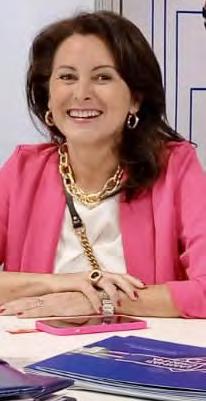





























Discover the key trends shaping personal care, from formulation to packaging. Engage with industry experts, brands, manufacturers, and suppliers to explore innovations for every market segment, sustainability, and advanced production solutions.
JOIN US
28-29th May 2025
IMA Omas Tecnosistemi
Cerro Maggiore, Milan - Italy


CEO
Pad. 5, stand C68
PMI innovativa con quartier generale nel territorio bresciano, Qwarzo mette a frutto 20 anni di conoscenze e di ricerche nel campo della chimica inorganica. La sua tecnologia di punta è oggi il coating Qwarzo®, un rivestimento brevettato invisibile a base minerale che riveste i materiali senza alterarne la riciclabilità. La tecnologia a base di silice può essere utilizzata per sostituire la plastica e i film plastici su carta, tessuto, metallo e altri substrati, conferendo al materiale cui viene applicato nuove caratteristiche funzionali, nuova identità e prestazioni elevate.
“Con le soluzioni Qwarzo® le aziende possono rispondere alle nuove richieste di circolarità, allineandosi ai trend del riciclo, proiettandosi nella direzione dei monomateriali e della sostenibilità.
Per comprendere le dinamiche del mercato del packaging e interpretarle al meglio, promuoviamo un costante dialogo con tutti gli attori dell’ecosistema packaging, come del resto dimostra la nostra partecipazione a una fiera come Ipack-Ima, punto di riferimento per il networking e per la creazione di partnership di valore”.
Qwarzo is an innovative SME with headquarters in the Brescia area. Its technology harnesses 20 years of knowledge and research in the field of inorganic chemistry, in particular its flagship product today is Qwarzo® coating, a patented invisible mineral-based coating. The silica-based technology, can be used to replace plastic and plastic films on paper, fabric, metal and other substrates, giving the material to which it is applied new functional characteristics, new identity and high performance.
With Qwarzo® solutions, companies can respond to new demands for circularity, aligning themselves with a trend that embraces recycling and requires all manufacturers to innovate in the direction of single-materials and sustainability. In order to understand the packaging market in the best possible way, Qwarzo promotes a constant dialogue with all the players in the packaging ecosystem, as demonstrated by its participation in trade fairs such as Ipack-Ima, the ideal place for networking”.
Saba Automation Alessandro Pollini
Direttore Commerciale
Pad. 6, stand D37 - E38
Nata nel 2005 all’interno del comprensorio ceramico modenese, Saba Automation ha presto ampliato i suoi orizzonti verso tutti i principali mercati di riferimento, dall’alimentare, al chimico, dalla carta al tissue, guardando in generale al mondo consumer. L’azienda è ormai da tempo in grado di esportare in tutto il mondo linee complete, tailor made, disegnate al proprio interno in stretta collaborazione con il cliente e con un grande plus: un software proprietario interamente pensato per soddisfare le soluzioni del fine linea.
“A Ipack-Ima daremo spazio ai nostri impianti legati all’ industria 4.0/5.0 su cui abbiamo un’esperienza più che decennale di integrazione con i più moderni gestionali. L’inserimento in linea della robotica antropomorfa Kuka, di cui siamo official dealer, è un altro ambito che ci contraddistingue e che ci rende competitivi sul mercato. Tengo a precisare che la caratteristica di Saba Automation è la customizzazione di impianti su misura dove si esce dalle logiche standardizzate per focalizzarsi su requisiti specifici. In fiera, una grande video-wall proporrà le nostre case history di maggiore successo, senza dimenticare le demo software che caratterizzano le nostre linee, isole robotizzate e cartesiane, rendendoci unici nel panorama dei competitor”.
Founded in Modena’s ceramic district in 2005, Saba Automation S.r.l. soon expanded its horizons to include all the main target markets, from food to chemicals, to paper and tissue, turning its attention to the consumer world in general. The company has long been exporting full bespoke lines worldwide, all of which are designed internally, working closely with the customer, and offer a great plus, namely a proprietary software designed and built for end-of-line solutions.
“At Ipack-Ima we will be showcasing our systems linked to industry 4.0/5.0, an area in which we have accrued over ten years of experience in machine integration and interfacing with the most recent ERP systems.
One of our distinctive signs is the incorporation of in-line robotics. We’ve built projects as a system integrator first for Comau and now for Kuka, with official dealer status, using anthropomorphic robots”.
“Saba Automation’s most distinctive offering is customisation and tailor-made systems, where we move beyond standardised systems to focus on the unique

needs of the customer. At the fair, a large video wall will display our most successful case histories, alongside demos of the software featured in our lines and our full automated work stations and those featuring 3-axis robots, setting us apart in the competitive landscape”.
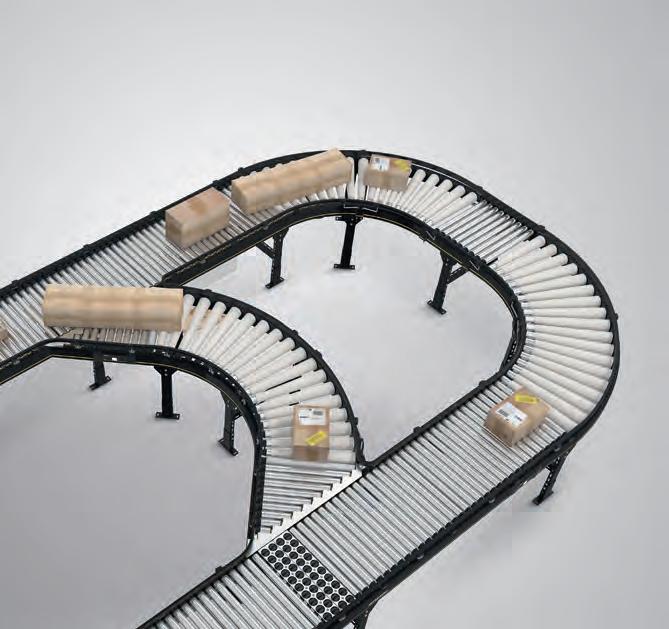

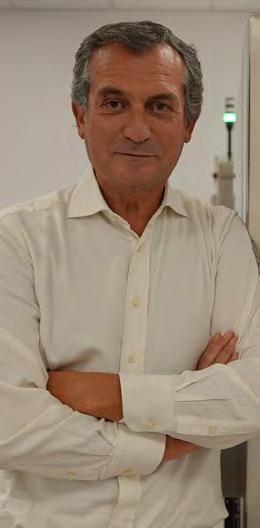
CEO e Fondatore Pad. 7, stand C59
Xnext è specializzata in sistemi di visione a raggi X secondo tecniche di ispezione per i mercati food, pharma e del riciclaggio, oltre a sistemi di controlli applicati nel settore aerospaziale. Sviluppata da un’idea originale, Xnext è oggi fornitrice di XSpectra®, una soluzione unica al mondo che conta 50 installazioni in Europa, in particolare Francia, Slovacchia, Italia con importanti evoluzioni previste negli Stati Uniti.
“Con XSpectra® abbiamo realizzato la soluzione di ispezione più avanzata al mondo nella ricerca di corpi estranei in profondità del prodotto. Sul piano delle prestazioni la qualità della nostra tecnologia è evidente in un ampio range di applicazioni in tutti i comparti dell’alimentare, dal dairy, alla pasta ripiena, alla carne processata, sughi pronti e creme spalmabili, ma anche nel packaging come lattine, buste per biscotti o insalata, bottiglie.
XSpectra® è costituita da un detector a raggi X che arriva fino a 1024 livelli di energia e da un software interamente basato sull’intelligenza artificiale che sfrutta al meglio le caratteristiche della macchina elaborando il risultato del Photon Counting ai raggi X. Tra i mercati di prossima destinazione c’è sicuramente il farmaceutico, su cui stiamo ancora lavorando per la messa a punto di un’evoluzione tecnica necessaria per rilevare grandezze inferiori a quelle del settore alimentare”.
Per maggiori informazioni contattate i nostri specialisti

Xnext produces X-ray vision systems compliant with non-destructive inspection systems for the food, pharmaceutical, and recycling industries and testing techniques commonly applied in the aerospace industry. Developed from an original idea, Xnext now supplies XSpectra®, a solution that is unique worldwide and is currently installed in 50 locations in Europe, more specifically in France, Slovakia, and Italy, with market developments expected in the United States.
“We have created with XSpectra® the most advanced inspection solution in the world for detection of foreign matter deep inside a product. The quality of our technology is clear in terms of performance in all areas of food processing such as dairy, stuffed pasta, processed meat, ready-made sauces, and spreads but also in packaging, such as cans, bags for biscuits or lettuce, and bottles.
The machine comprises a multi-energy x-ray detector providing up to 1024 energy levels and software based entirely on artificial intelligence that exploits all the machine’s characteristics when processing the result of the x-ray photon counting. The next markets that Xnext will be targeting will undoubtedly include the pharmaceuticals industry, where we are working on a technical development that will allow detection of smaller quantities than in the food industry”.
La piattaforma di trasporto modulare MCP si evolve in MCP
MCP PLAY è il futuro della movimentazione dei materiali.
Una soluzione che anticipa il mercato e offre nuove opportunità agli integratori di sistemi che possono così rivolgersi a mercati finora inesplorati.
• Maggiore rapidità di messa in servizio e avviamento per una conclusione più veloce di ogni progetto
• Progettazione semplificata del layout grazie a software intuitivi
• Minori esigenze di programmazione, che si traducono in risparmio di tempo e risorse
• Non sono più necessarie competenze avanzate di programmazione, ottenendo così più flessibilità
• L’integrazione è perfetta quasi senza fermo impianti
• Maggiore efficienza energetica per l’utente finale
Marcel, Ingegnere Meccanico
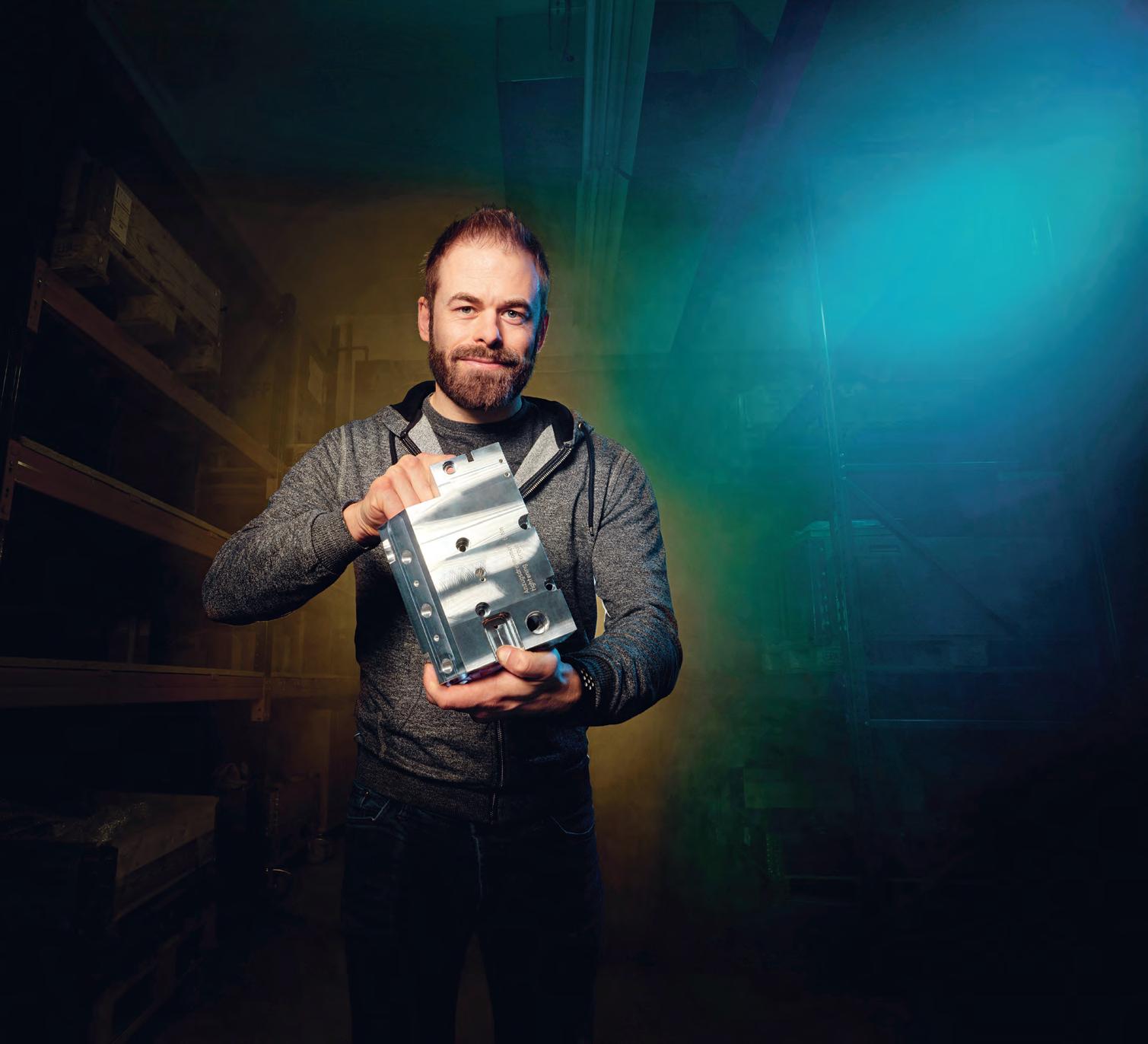


27.–30.05.2025
BOOTH D31 - E32 HALL 6
Alpha, fusore polivalente ad alte prestazioni.
È il momento della generazione Alpha. Pensare in modo nuovo, puntare su ciò che è collaudato. Perché abbiamo un obiettivo: il vostro successo. Capacità di fusione elevata e affidabilità, componenti durevoli, dimensioni compatte, eccellente sicurezza sul lavoro. Affinché possiate affrontare il futuro in tutta sicurezza.
Scoprite di più su Alpha.

Direttore Commerciale e Marketing
Pad. 2, stand B59
Pad. 5, stand B44
Da oltre 50 anni Omag progetta e realizza macchine e linee complete di confezionamento dedicate a diversi settori merceologici (farmaceutico in primis con il 60% del fatturato), ed è attiva con tre stabilimenti produttivi. I costanti investimenti in ricerca e sviluppo la rendono oggi tra i leader nel panorama italiano e internazionale.
“In fiera saremo presenti con uno spazio sia a Pharmintech che a Ipack-Ima, come nella precedente edizione. Pharmintech rappresenterà la vetrina ideale sia per la linea stick-pack che per le macchine
Since 1973 Omag designs and manufactures packaging machines and complete packaging lines for various goods sectors (pharma generates 60% of the turnover) with three production plants. The continuous investments in research and development have led OMAG to achieve a leading position in the

With over 30 years of experience developing technology for the pharmaceuticals market, SEA Vision is a long-standing partner to the market that provides solutions for industrial vision, traceability systems and automation processes.
“At Pharmintech we will be presenting significant innovations that combine sustainability and
confezionatrici dedicate al packaging di buste a 4 saldature di tipo verticale. Per entrambe le soluzioni è possibile un equipaggiamento con qualunque tipo di sistema di dosaggio, per prodotti polverosi, granulari, liquidi, pastosi o pezzi singoli. Grande flessibilità anche per le configurazioni, con dosatori speciali per componenti farmaceutici medicali. Quanto alla nuova linea dedicata al packaging secondario, prevediamo di esporre una proposta per il fine linea da top load o astuccio pre-incollato.
Omag progetta tutto in casa costruendo la maggior parte delle componenti nelle proprie officine, grazie all’impegno di oltre 150 dipendenti e con l’ausilio di un'area test, un laboratorio dotato di macchine pilota sempre disponibili, un ufficio tecnico e un dipartimento dedicato all’automazione”.
Italian and international markets.
“As in the previous edition, we will be exhibiting at both Pharmintech and Ipack-Ima. At Pharmintech, our stand will feature both stick pack technology, the vertical four-seal pouch machine, and the intermittent plate sealing machines. Both solutions can be equipped with any


type of metering system, for powders, granules, liquids, pastes, or individual items. Greater configuration flexibility is also offered, with special metered dispenses for pharmaceutical ingredients. As for the new line dedicated to secondary packaging, we plan to showcase an end-of-line solution for either
Direttore Marketing Pad. 2, stand B18
Da oltre 30 anni SEA Vision è un partner consolidato nel mercato farmaceutico per cui sviluppa tecnologie per la visione industriale, sistemi di tracciabilità, e soluzioni per i processi di automazione.
“A Pharmintech presenteremo importanti novità che coniugano sostenibilità e digitalizzazione, con focus particolare su “a-eye clearance”, rivoluzionaria tecnologia che utilizza l’IA per rendere i processi di line clearance più efficienti e
digitalisation, focussing specially on our AI powered solution for automated line clearance, "a-eye clearance", the revolutionary new technology that uses artificial intelligence to increase efficiency and safety during line clearance process. The aim of this innovation is to ensure machines are perfectly clean and that there are no residues
top-loading or pre-glued packs. With over 150 employees, Omag builds the majority of the components in its own facilities. The company also has an extensive test area, a laboratory equipped with pilot machines available at all times, an engineering department and an automation department.
sicuri, con l’obiettivo di garantire che le macchine siano libere e pulite da qualsiasi materiale residuo risultante da un lotto produttivo precedente, riducendo al minimo il rischio di errori e migliorando la qualità complessiva della produzione. Sarà inoltre lanciato in anteprima il concept del nuovo Harleblister Neurale, una versione innovativa del primo sistema di controllo per solidi in blister che SEA Vision presentò sul mercato esattamente 30 anni fa, ora rinnovato proprio grazie agli algoritmi di Intelligenza Artificiale che ne potenziano le performance. Attualmente stiamo concentrando i nostri sforzi su tre aree chiave - Track and Trace, RFID e pallettizzazione centralizzata - dove sono in corso di realizzazione progetti che influenzeranno in modo radicale i processi produttivi del settore.
from previous batches, to minimise the risk of errors and improve overall production quality.
We will also launch our new Harleblister Neurale, an innovative version of the first inspection system for solids in blister packs that SEA Vision presented on the market exactly 30 years ago. The system has now been enhanced
through the introduction of AI algorithms to improve inspection performance.
Currently we are focusing on three main areas - track and trace, RFID and centralised palletisation - with pioneering project that will drive to a radically innovation in the production processes of the sector”.


Managing Director Pad. 2, stand B35
Taim è una family company specializzata in impianti di processo per i mercati farmaceutico, cosmetico e alimentare. Negli oltre 35 anni di attività ha sviluppato competenze avanzate nella progettazione e realizzazione di macchinari per l’industria farmaceutica spaziando dalla formulazione e sintesi delle polveri alla granulazione, dal coating alla produzione di liquidi e dosi sterili, alle soluzioni chiavi in mano per equipaggiare interi stabilimenti.
“A Pharmintech saremo presenti con soluzioni biotech e per iniettabili, un ramo su cui lavoriamo da più di 15 anni. L’obiettivo è mettere in luce la nostra vasta competenza tecnologica attraverso un progetto che introduca novità su prodotti già consolidati sul mercato. La nostra visione a breve e medio termine è mirata a rispondere a richieste tecnologiche sempre più elevate, per anticipare gli standard futuri. Tra i driver di innovazione spiccano la digitalizzazione, su cui Taim si è attrezzata con un settore aziendale interamente dedicato all’ingegneria hardware e software, per rispondere in particolare all’esigenza di integrazione di macchine automatiche nei sistemi MES degli stabilimenti”.
Taim is a family business specialising in processing plants for the pharmaceutical, cosmetic and food markets. In over 35 years of activity, Taim has developed expertise in design and manufacture of machinery for the pharmaceutical industry ranging from powder formulation and synthesis to granulation, coating, liquid and sterile dose production and turnkey solutions to equip entire plants. The goal is to exhibit our vast technological expertise through an innovative project that introduces novelties on products
that are already well established in the market. Our short and medium term vision is definitely aimed at responding to increasingly hightech requests which require continuous research capable of anticipating future standards. Prominent among the drivers of innovation are digitalisation, for which Taim has equipped itself with a business sector dedicated entirely to hardware and software engineering, to respond -in particular- to the need for the integration of automatic machines into MES systems.
Direttore Commerciale
Pad. 2, stand B107
Leader mondiale attiva da oltre 65 anni nel mercato degli strumenti di misura di livello e pressione, Vega conta oltre 2.600 collaboratori sparsi in tutto il mondo. Le soluzioni Vega rispondono alle necessità di misure complesse richieste da impianti industriali specializzati nei settori, chimicofarmaceutico, alimentare, approvvigionamento idrico, depurazione, industria mineraria, produzione di energia. “Il futuro della strumentazione è disporre non solo di sensori affidabili e precisi ma anche interconnessi. Vega offre già da tempo soluzioni pronte per la digitalizzazione; tutti i sensori integrano infatti come standard la tecnologia Bluetooth per la taratura e la diagnosi. Un aspetto importante nel quadro della crescente digitalizzazione è una protezione efficace dagli attacchi informatici. Per questo abbiamo implementato la più recente norma per la sicurezza informatica IEC 62443-4-2. In particolare, il sensore radar VEGAPULS 6X soddisfa i massimi standard per la cyber security attualmente disponibili nell’industria dei processi”.

As a world leader that has been operating in level and pressure measurement instruments for over 60 years, Vega employs over 2,600 people worldwide. Vega’s portfolio includes, among other things, level
sensors and pressure sensors for chemical and pharmaceutical plants, the food industry as well as drinking water supply systems, metal extraction, sewage treatment plants and power generation stations.
“The future of instrumentation lies not only in the inclusion of high-precision reliable sensors but also in interconnection. Vega has been offering digitalisation-ready solutions for some time now; all sensors feature Bluetooth technology for calibration and diagnostics as standard. One key aspect of increasing digitalisation is ensuring effective protection against cyber-attacks. To tackle this issue, we have adopted the latest cyber security standard, IEC 62443-4-2. Specifically, our VEGAPULS 6X radar sensor meets the highest cyber security standards currently available for the process industries”.
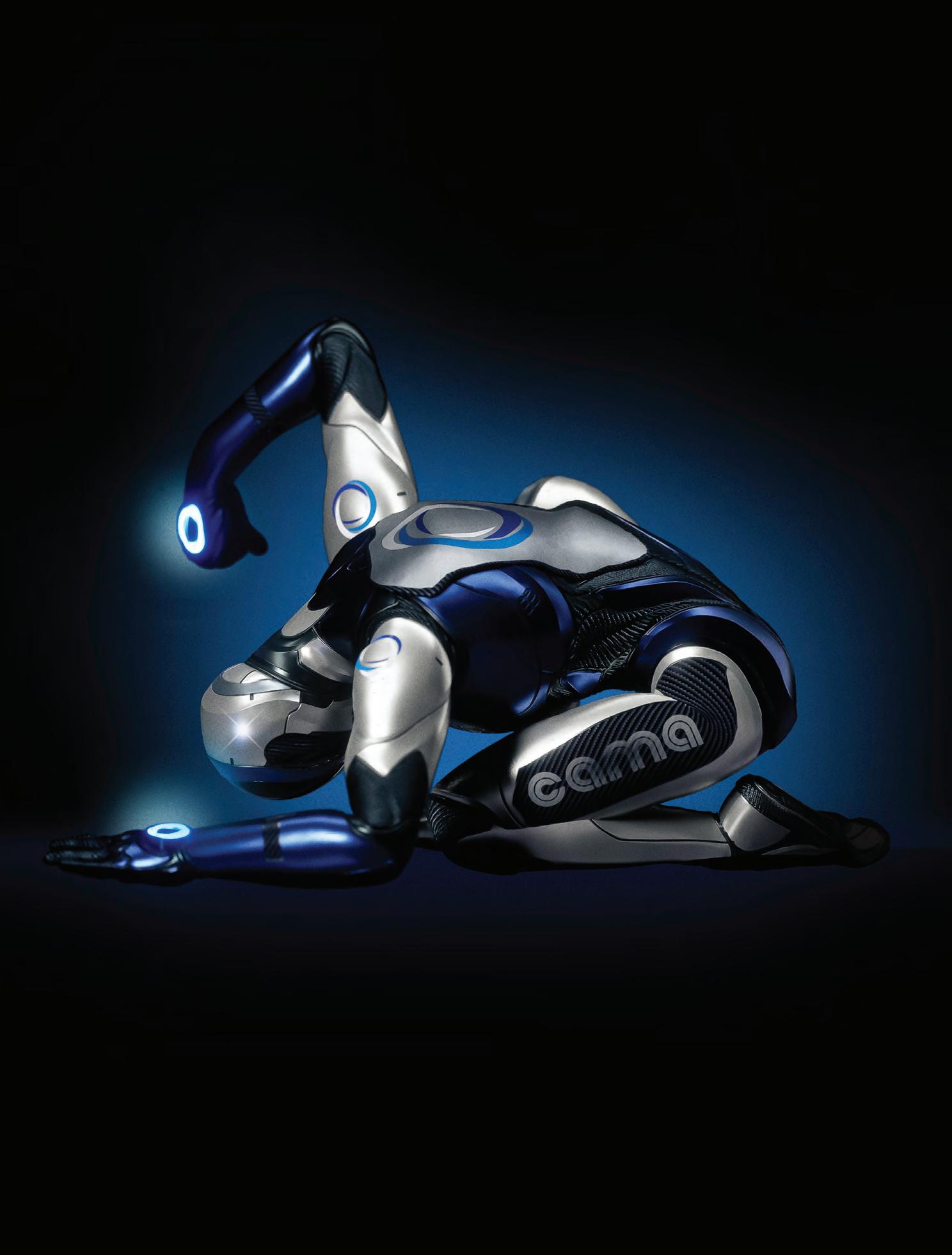

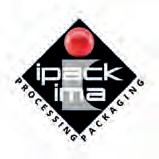





CMI Industries
ata nel 1982 con una forte specializzazione in riempimento e tappatura di prodotti chimici e corrosivi, CMI è tornata nel 2020 al business originario dopo un periodo di apertura a mercati come beauty, aerosol e laminazione. Nello stesso periodo, un importante passaggio ha visto l’inserimento di Davide Comoli come seconda generazione in azienda nel ruolo di CEO.
Sguardo rivolto al futuro per un’azienda molto presente sul territorio e in forte trasformazione grazie a un passaggio generazionale di successo. N
Ci racconti il vostro business e l’andamento del mercato che vi vede protagonisti “Da sempre la nostra forte specializzazione è focalizzata su riempitrici e tappatrici per prodotti chimici acidi e corrosivi.” esordisce Comoli “Abbiamo quindi un forte know-how in questo settore su cui oggi ci concentriamo pienamente e con risultati positivi a livello di ordini e di fatturato. Dal mio ingresso in azienda, infatti, la crescita è stata costante con performance
che vedono il 2023 chiudere con un fatturato a oltre 8 milioni, il 2024 superare i 10 milioni e il 2025 con portafoglio ordini già completo che proietterà oltre 11 milioni. Dopo una fase di riorganizzazione ed efficientamento dei processi siamo quindi tornati con successo sul nostro core business, lo sviluppo di linee complete per il riempimento e tappatura di prodotti chimici e corrosivi, mercato in cui vantiamo oltre 40 anni di esperienza e clienti storici che ci hanno sempre seguito nel tempo. Grazie alla nostra expertise, oggi gestiamo qualunque tipo di prodotto chimico, cremoso, viscoso, liquido per home e personal care, oltre a oli motore, vernici e uno spin off dedicato a creme spalmabili, marmellate, miele e qualche macchina per il cosmetico che coprono una minima quota del nostro fatturato”.
Quali sono i plus che vi hanno permesso di costruire e consolidare il vostro percorso aziendale?
“Un punto di forza di CMI è la capacità di fornire linee complete personalizzate chiavi in mano” prosegue Comoli “Questo avviene, grazie a una rete di partner specializzati con cui collaboriamo, costruendo soluzioni che il cliente ci delega in toto, dalla stesura del layout all’acquisto di macchinari di cui gestiamo FAT e SAT con montaggio e testing in azienda prima della consegna. La capacità di fornire un servizio completo e fortemente innovativo è rafforzata dalle nostre risorse interne a cominciare dall’R&D e dalla progettazione che, sempre
internamente, gestisce lo sviluppo software e hardware. La presenza di personale altamente qualificato ci permette di fornire risposte rapide spaziando dall’assistenza tecnica al troubleshooting, al post-vendita, al supporto nella gestione dei cambi formato. L’adeguamento agli standard 4.0 delle nostre macchine garantisce supporto continuativo a distanza, intervenendo poi on-site con personale tecnico specializzato in caso di problematiche che richiedano interventi in presenza”.
Guardando alla tecnologia quali sono gli elementi caratterizzanti delle vostre soluzioni?
“Le nostre macchine antiacido sono prodotte con materiali plastici o acciai speciali e leghe nobili come il titanio. La nostra competenza si estende quindi anche ai materiali perché non tutti i prodotti corrosivi si adattano a ogni metallo e serve associare i più idonei alle diverse componenti chimiche lavorate. Realizziamo i pezzi internamente, che si tratti di metalli o plastiche, su cui abbiamo una competenza avanzata. Da notare infatti, che una macchina realizzata in plastica richiede molte più ore di manodopera rispetto a una soluzione standard in acciaio inox. Il nostro personale è quindi anche specializzato in saldature su materiali plastici a cui si aggiungono fornitori che sanno scegliere le giuste mescole per gestire i diversi prodotti chimici da confezionare. Altro elemento caratteristico del nostro business è la varietà di formati, guidati dal marketing, su cui il settore chimico è molto attento, con significa-


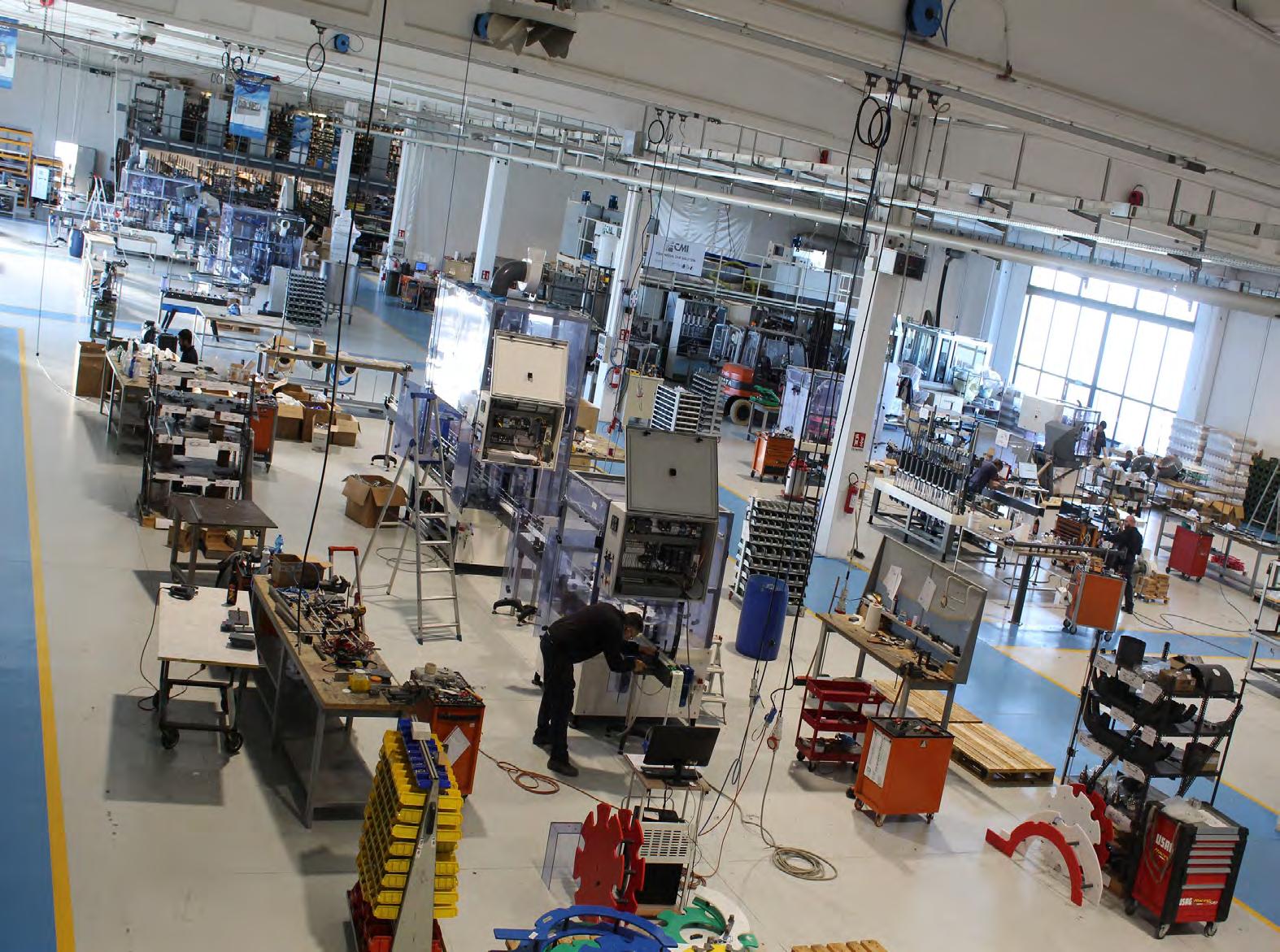
CMI INDUSTRIES A IPACK-IMA 2025
Riempitrice Lineare Antiacido Serie LOGYKA
La serie LOGYKA è una riempitrice automatica lineare progettata per il dosaggio preciso di liquidi corrosivi e non. Costruita interamente con materiali anticorrosione, è ideale per prodotti chimici aggressivi come acidi e candeggine, garantendo sicurezza, durata e alta produttività. È equipaggiata con misuratori di flusso magnetici Endress+Hauser, che assicurano massima precisione e affidabilità nel controllo del dosaggio. Integra inoltre l’innovativo sistema brevettato Ultracleaning, che riduce fino all’85% i tempi di cambio prodotto e abbatte del 75% l’utilizzo e i costi di smaltimento dei detergenti di lavaggio, migliorando sensibilmente efficienza e sostenibilità.
Tappatrice Rotativa MIRAY - 4 Teste
Progettata per garantire alte prestazioni e massima affidabilità, la tappatrice rotativa MIRAY è ideale per l’applicazione automatica di tappi trigger, dispenser, tappi a vite e pressione. Grazie alla sua struttura compatta, alla regolazione rapida dei formati e al controllo elettronico avanzato delle camme di tappatura, assicura produttività elevata, precisione di serraggio e integrazione ottimale nelle linee esistenti. Perfetta per i settori chimico, cosmetico e home care è disponibile anche in versione ATEX o Anticorrosiva.
tive differenziazioni nelle chiusure e packaging design innovativi progettati per essere caratterizzanti del brand. A questo si aggiunge la crescente sensibilità verso il green packaging che impone problematiche di macchinabilità e tenuta determinate da sgrammature e varietà di materiali riciclati, riciclabili e sostenibili. Per il nostro settore quindi, la forma è una variabile da non sottovalutare al pari di fragilità e instabilità dei materiali per il packaging che impon-
a Ipack-Ima 2025: cosa vedremo in fiera? “Ipack-Ima è una fiera in cui siamo storicamente presenti con importanti novità” prosegue Comoli “rappresentate quest’anno da una riempitrice lineare costruita in materiali plastici e nobili per prodotti corrosivi e un tappatore rotativo completamente elettronico per tappi trigger che permette di definire il profilo delle camme di tappatura da pannello. Con il partner Bosch Rexroth, inoltre, presentiamo un pacchetto per la verifica delle performance della macchina in ottica 5.0, che offre accesso alla diagnostica e analisi della performance, includendo la sostenibilità. L’ESG è un driver importante, dove le soluzioni CMI Industries, permettono di fornire dati misurabili grazie all’elevata digitalizzazione e a una filiera di fornitura estremamente corta, favorita dall’ecosistema territoriale di imprese in cui operiamo che ci permette di abbattere drasticamente le emissioni. Ulteriore nota di sostenibilità è data dalla considerevole riduzione dei consumi d’acqua, risultato dello sviluppo di un sistema di lavaggio brevettato che garantisce massima efficienza, velocità, minimi tempi di fermo macchina e consumi di energia e acqua estremamente ridotti”.
CMI Industries
In quali mercati siete presenti?
“Uno dei più importanti per noi è sicuramente il mercato italiano, che copre il 30-40% del fatturato” conclude Davide Comoli “a questo si aggiungono il mercato australiano dove abbiamo un agente da oltre 12 anni e la Turchia dove la velocità delle nostre macchine unita ad affidabilità ed efficienza sono i nostri punti di forza rispetto ai concorrenti locali. Con velocità superiori ai 50 pezzi al minuto, le nostre soluzioni assicurano standard di qualità, efficienza e
prestazioni difficilmente eguagliabili, indipendentemente dalla concorrenza, sia essa mediorientale, cinese, africana o proveniente dal bacino del Mediterraneo. Si tratta di mercati in cui siamo presenti e in crescita con rappresentanze a Dubai e approcci nel continente americano, in particolare in Messico. In estrema sintesi, quello che fa di CMI Industries una scelta vincente sono qualità, performance, affidabilità e la capacità di fornire soluzioni personalizzate chiavi in mano”.
A forward-looking company undergoing major transformation, driven by a successful generational transition
Founded in 1982 with a strong focus on filling and capping solutions for chemicals and corrosive substances, CMI returned to its original business in 2020 following a period of diversification into markets such as beauty, aerosols and lamination. This shift coincided with a significant transition, marked by the appointment of Davide Comoli as CEO, representing the second generation of leadership within the company.
Tell us about your business and how you are performing in the market
“Our core expertise has always centred on filling and capping machines for acidic and corrosive chemicals,” explains Comoli. “Therefore, we possess deep know-how in this field, which we now are fully leveraging - with positive results in both orders and sales. Since I joined the company, in fact, growth has been steady. We closed 2023 with sales exceeding €8 million, surpassed €10 million in 2024, and our 2025 order book is already full, setting us on track to exceed €11 million. Following a phase of reorganisation and process optimisation, we successfully returned to our core business: the development of complete lines for filling and
capping chemical and corrosive products. It is a market in which we boast over 40 years of experience and long-standing customers who have remained loyal to us throughout the years. Thanks to this expertise, we are now able to handle a wide range of products, including chemical, creamy, and viscous products, home and personal care liquids, as well as motor oils, and paints. We have also created a spin-off featuring spreadable creams, jams, honey, and some machines for cosmetic products, although these represent a very small portion of our turnover”.
What are the key strengths that have enabled you to build and consolidate your business over time?
“One of CMI’s greatest strengths lies in our ability to deliver fully customised turnkey lines,” Comoli continues. “This is made possible through a trusted network of specialised partners, with whom we collaborate to develop comprehensive solutions. Customers entrust us with the entire process, from layout design to machinery procurement, and we handle both FAT and SAT procedures with in-house assembly and testing prior to delivery. Our capacity to provide a complete and highly innovative
The LOGYKA automatic linear filling machine is designed for the accurate dosing of both corrosive and non-corrosive liquids. Constructed entirely from corrosion-resistant materials, it is ideally suited for handling aggressive chemicals such as acids and bleaches, ensuring safety, durability and high productivity. The machine features Endress+Hauser magnetic flow meters, which ensure exceptional dosing accuracy and reliability. It also incorporates the innovative patented Ultracleaning system, which reduces product changeover times by up to 85% and lowers the consumption and disposal costs of washing detergents by 75%, significantly improving efficiency and sustainability.
Designed for high performance and maximum reliability, the MIRAY rotary capping machine is ideal for the automatic application of trigger, dispenser, screw, and press-on caps. Its compact design, fast format changeover, and advanced electronic control of capping cams ensure high productivity, precise cap application and optimal integration into existing production lines.
Ideal for the chemical, cosmetic and home care industries, MIRAY is also available in ATEX or ANTICORROSIVE versions.
service is further strengthened by our in-house expertise, starting with our R&D and design departments, which develop hardware and software in-house. The presence of highly qualified in-house personnel allows us to respond quickly to a wide range of needs, from technical assistance
and troubleshooting to after-sales support and management of format changeovers. Our machines are fully compliant with industry 4.0 standards, enabling continuous remote support. When necessary, we also dispatch our specialised technicians for on-site interventions”.
Looking at technology, what are the defining elements of your solutions?
“Our anti-acid machines are built using plastics, special steels and high-grade alloys such as titanium. Our expertise, therefore, also extends to materials because not all corrosive substances are compatible with every type of metal. It is important to select the most suitable material for each chemical component being processed. All parts, whether metal or plastic, are manufactured in-house, where we have developed extensive expertise. In fact, it’s important to note that producing a machine made from plastic often requires significantly more labour hours than a standard stainless steel solution. Our personnel are also highly specialised in welding on plastic materials, and we collaborate with suppliers who have the expertise to select the most suitable compounds for packaging a wide range of chemical products. Another key aspect of our business is the ability to manage a wide variety of formats, which is increasingly important in the chemical industry, where marketing drives strong differentiation in closures and innovative packaging designs that serve as key elements of brand identity. Added to this is the increasing demand for sustainable packaging, which presents challenges in terms of machinability and sealing performance due to factors such as weight reductions and the use of recycled, recyclable, and sustainable materials. In our industry, shape is just as important as the fragility and instability of the packaging materials themselves. These challenges demand highperformance, versatile machines that can adapt to constant variations in products, formats and materials. At the same time, it is essential to maintain stability and the ability to handle high production volumes with minimal downtime”.
Speaking of technology, what are your thoughts on what we will see at IPACK-IMA 2025?
“IPACK-IMA is a trade show where we have always showcased our most significant innovations,” Comoli continues. “This year, we will present a linear filling machine
made from plastic and high-grade materials, specifically designed for corrosive products, along with a fully electronic rotary capper for trigger caps, which allows the profile of the capping cam to be configured via a control panel. Together with our partner Bosch Rexroth, we will also present a package for the testing of machine performance, developed with an industry 5.0 approach. This solution offers access to diagnostics and performance analysis, including sustainability metrics. ESG is a key driver for us. CMI Industries’ solutions enable the collection of measurable data through advanced digitisation and a highly streamlined supply chain. This is made possible by the local industrial ecosystem in which we operate, allowing us to significantly reduce emissions. Another important contribution to sustainability is the significant reduction in water consumption, achieved through the development of a patented washing system. This solution ensures maximum efficiency and speed, minimises downtime, and delivers exceptionally low energy and water consumption”.
In which markets are you present?
“One of our most important markets is undoubtedly Italy, which accounts for 30 to 40% of our turnover,” concludes Davide Comoli. “We also have a longstanding presence in Australia, where we have worked with a local agent for over 12 years, and in Turkey, where the speed, reliability and efficiency of our machines give us a clear advantage over local competitors. With speeds exceeding 50 pieces per minute, our solutions deliver unrivalled standards of quality, efficiency and performance - whether the competition comes from the Middle East, China, Africa or the Mediterranean basin. These are markets where we are already active and continuing to grow, with representation in Dubai and an expanding presence in the Americas, particularly in Mexico. In short, what makes CMI Industries a winning choice is our commitment to quality, high performance, reliability and the ability to deliver fully customised turnkey solutions”.



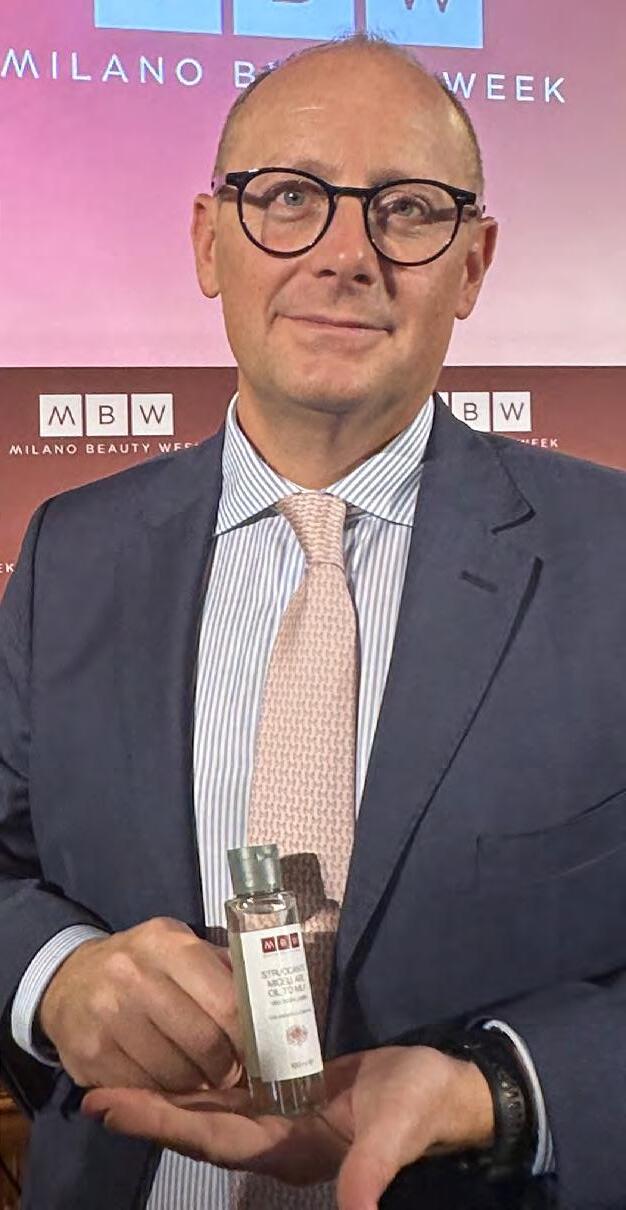
Aliplast
A Ipack-Ima materiali innovativi e vision
Aliplast è nata nel 1982 come società di raccolta di materiali plastici, diventando una delle aziende leader nel riciclo delle materie plastiche per la produzione di polimeri rigenerati, film flessibili in rLDPE e lastre in rPET. L’azienda è presente a Ipack-Ima con la sua proposta di materiali riciclati e sostenibili proposti in collaborazione con partner strategici per rafforzare una filiera del riciclo. Si tratta di un settore industriale capace di trasformare i rifiuti in risorse, grazie allo sviluppo di materiali innovativi sempre più protagonisti dell’impegno che il settore packaging mette in campo per la sostenibilità. Ne parla Michele Petrone, AD di Aliplast, che offre un quadro della strategia messa in campo per fare del riciclo un protagonista sempre più centrale in tutti i mercati.
Partiamo dal PPWR che entra ora nel vivo della fase applicativa.
“Per noi il PPWR è opportunità”, esordisce Petrone, “il regolamento ha infatti diretta applicazione in tutti gli Stati membri e definisce un set di regole uniformi per tutti, con standard che permettono alla filiera del riciclo di proporre un prodotto standardizzato ad un mercato sempre più consapevole delle proprie scelte, nel pieno spirito di contribuire alla transizione verso l’economia circolare. Il PPWR si fonda su pilastri quali riciclabilità e contenuto minimo riciclato: la spinta al 2030 è una sfida da vincere. Per fare questo, noi, Aliplast, partiamo dalla tracciabilità, provenienza dal materiale, qualità e macchinabilità. L’obiettivo è infatti fornire
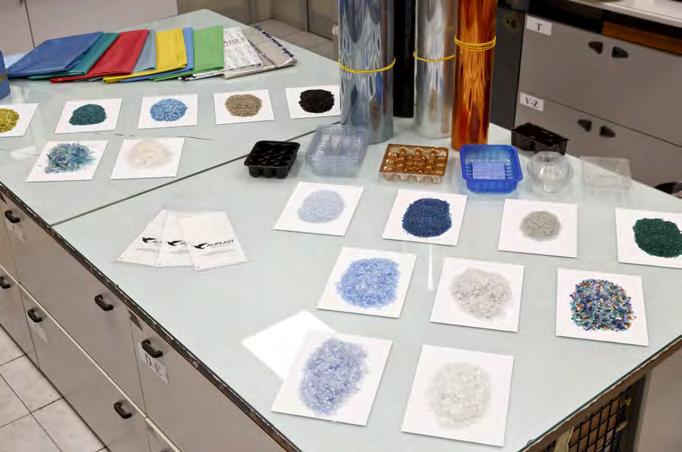
ai clienti la materia prima seconda per un prodotto perfettamente qualificato grazie a un regolamento condiviso”.
Quali sono i settori e i paesi più allineati alle nuove prescrizioni?
“Ci sono settori, ad esempio quelli legati alla plastica monouso, che hanno già iniziato il percorso di allineamento verso le prescrizioni del PPWR: è un esempio concreto l’effetto che si è avuto a partire dal 1 gennaio 2025 della direttiva SUP, che prevede il contenuto minimo di materiale riciclato pari almeno al 25% per le bottiglie per bevande e liquidi alimentari”.
Prosegue Petrone: “Il tema oggi è farsi trovare pronti e condividere la necessità di abbracciare una sostenibilità che sia ambientale, sociale ed economica capace di portare il sistema verso una vera economia circolare. Normative, con-
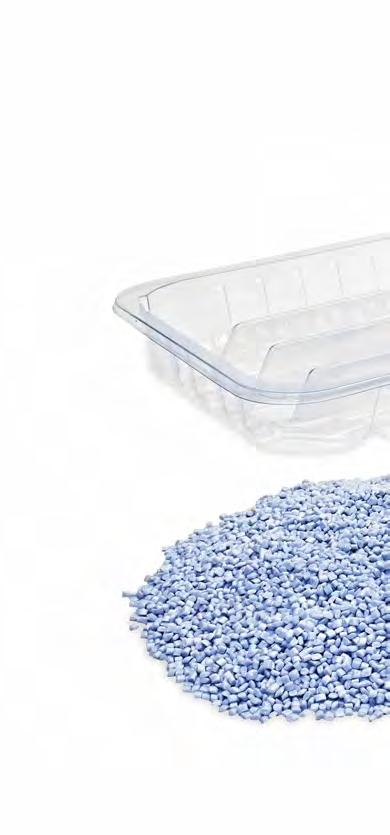
trolli, sensibilità del consumatore e capacità delle aziende di rispondere alla domanda, sono tutti elementi fondamentali che incidono sul risultato”.
L’atteggiamento dei consumatori e le dinamiche di mercato cambiano quando si parla di sostenibilità in settori diversi?
“L’atteggiamento dei consumatori è sicuramente più attento e dimostra sempre di più quella maggiore sensibilità che permette di riconoscere un valore alla materia prima seconda, un valore che possa discostarsi dalla mera logica di prezzo di acquisto e vendita. Alcuni settori quali, quali quello della cosmetica, sono già stati in grado di trasferire il valore della sostenibilità, mentre altri hanno intrappreso questo percorso, dovendo lavorare su aspetti chiave per ottenere un packaging sostenibile. Pensiamo a riciclabilità, rifiuti di imballaggio riciclati su larga scala e progettazione, design che assicuri la riciclabilità. Si tratta di aspetti su cui Aliplast si impegna, guardando a un consumatore pronto a scelte sostenibili in prodotti di aziende capaci di scelte altrettanto sostenibili. GDO, Food, Cosmetica, Farmaceutico, sono tutti settori che abbracciano la sostenibilità e chiedono partnership qualificate che permettano lo sviluppo di soluzioni avanzate condividendo il valore che vede nel rifiuto la ricerca di una risorsa che vive sempre un nuovo inizio, grazie a una filiera industriale capace di valorizzarlo. Aliplast, con i suoi partner, porta quindi avanti il concetto di sostenibilità del prodotto, generando valore condiviso con il “close loop” che per noi è una realtà consolidata da anni”.
La sostenibilità del packaging riflette anche dinamiche geopolitiche, influenzando l’export: cosa vedete dal vostro osservatorio?
“Le politiche protezionistiche possono portare a difficoltà nell’approvvigionamento dei materiali, aspetto che Aliplast
può eventualmente contrastare grazie alla filiera europea su cui può contare. Il nostro punto di forza è il modello closed loop, dove il cliente diventa anche un fornitore, trasformando lo scarto in risorsa e portando alla costruzione di un mercato nazionale ed europeo del riciclo. Siamo infatti presenti in Polonia, Spagna, Francia e grazie agli stabilimenti produttivi italiani, raggiungiamo tutta l’Europa. In sintesi, le politiche protezionistiche ci preoccupano ma siamo pronti a fornire materiale con qualità e sostenibilità documentate ai nostri clienti. La nostra logica è quindi quella di presentarsi non solo come Aliplast ma come parte di un’ampia filiera di partner che permettono al sistema di produrre packaging sostenibile creando un vero percorso circolare”.
Che novità vedremo dal vostro R&D, quali le traiettorie?
“La ricerca per noi è un punto di forza, con un R&D in ogni stabilimento” afferma Michele Petrone. “L’obiettivo è studiare materiali capaci di comunicare qualità, trasmettendo i concetti di purezza e trasparenza di un prodotto che dal rifiuto ritorna ad essere bellezza, qualità, stile. Il nostro team guarda al futuro cercando nuove risposte, grazie a partnership con il mondo accademico e stakeholder qualificati che ci permettono di intercettare gli sviluppi tecnologici e di mercato. Il percorso che dalla raccolta porta al riciclo e alla realizzazione di nuovi materiali, dimostra la capacità di sviluppo e innovazione di un’intera filiera costruita con diversi anelli della catena del valore: Aliplast è proprio uno di questi anelli e può, anzi deve, giocare il ruolo di legame tra loro. Gli investimenti che stiamo effettuando ci vedono protagonisti nella realizzazione di nuova capacità di riciclo installata: Modena sarà infatti il nostro polo del riciclo per le plastiche rigide, in particolare HDPE e polipropilene e da qui partirà la nostra ulteriore offerta di altissima qualità per soddisfare le previsioni di contenuto minimo riciclato in un sito dove l’economia circolare e la sostenibilità si realizza anche in sinergia con il Gruppo Hera in un processo produttivo basato sulla circolarità delle risorse: Il nuovo impianto si inserisce in un polo impiantistico del Gruppo Hera già consolidato e potrà così sfruttare le potenzialità di diverse linee di business. In particolare, sarà alimentato dall’energia elettrica prodotta dal vicino termovalorizzatore, mentre il processo produttivo utilizzerà l’acqua in uscita dal depuratore, per poi reimmetterla nello stesso, chiudendo così un circolo virtuoso. Il tutto nel pieno rispetto delle scadenze previste per i progetti faro dell’economia circolare che prevede un finanziamento per il tramite dei fondi PNRR”.

Maria Costanza Candi
Founded in 1982 as a plastics collection company, Aliplast has grown to become a leader in plastic recycling, specialising in the production of regenerated polymers, rLDPE flexible films and rPET sheets. At Ipack-Ima, Aliplast presents its range of recycled and sustainable materials, developed in cooperation with strategic partners to strengthen the recycling supply chain. This is an industrial sector with the power to transform waste into resources, driven by the development of innovative materials that are increasingly shaping the packaging industry’s commitment to sustainability.
Michele Petrone, CEO of Aliplast, talks about this vision and outlines the company’s strategy to make recycling a key player across all markets.
Let’s start with the Plastic and Packaging Waste Regulation (PPWR), which is now entering its implementation phase.
“For us, the PPWR represents an opportunity,” begins Petrone. “This regulation is directly applicable across all Member States and establishes a uniform set of rules for everyone. It sets clear standards that enable the recycling chain to offer standardised products to a market that is becoming increasingly conscious of its choices, fully aligned with the broader goal of supporting the transition to a circular economy. The PPWR is based on key pillars such as recyclability and minimum recycled content - its 2030 targets are a challenge that must be met. To achieve this, Aliplast focuses on traceability, material origin, quality and machinability. Our goal is to provide customers with high-quality secondary raw materials that meet strict standards thanks to a harmonised regulatory framework”.
Which sectors and countries are most aligned with the new requirements?
“Some sectors, such as those involving single-use plastics, have already begun aligning with the requirements of the PPWR. A concrete example is the impact of the SUP Directive, which mandates a minimum recycled content of at least 25% in beverage and liquid food bottles starting from 1 January 2025. Petrone continues: “Today, the key is to be prepared and to share the commitment to sustainability - one that is environmental, social and economic and capable of moving the system towards a truly circular economy. Standards, controls, consumer awareness and the ability of companies to meet the demand are all essential factors that will influence the outcome”.
Do consumer attitudes and market dynamics change when it comes to sustainability in different sectors?
“Consumers are certainly more attentive today, showing growing awareness and a sensitivity that allows them to recognise the value of secondary raw materials, a value that goes beyond the simple logic of purchase and sale price. Some sectors, such as cosmetics, have already succeeded in conveying the value of sustainability, while others are beginning this journey and need to address key factors in order to achieve sustainable packaging. We’re talking about recyclability, large-scale use of recycled packaging waste, and designing products with recycling in mind,” says Petrone. “These are the areas Aliplast is committed to, aiming to meet the expectations of consumers who seek sustainable products from companies that share the same commitment to sustainability. Sectors such as large-scale retail, food, cosmetics, and pharmaceuticals are all
embracing sustainability and looking for qualified partnerships capable of delivering advanced solutions that reflect a shared vision. Solutions that treat waste as a resource with the potential for continuous renewal, thanks to an industrial supply chain capable of transforming it. Together with our partners, Aliplast is advancing the concept of product sustainability by generating shared value through the closed-loop model, which is something we have been doing for years”.
Packaging sustainability also reflects geopolitical dynamics, influencing exports. What can you see from your vantage point?
“Protectionist policies can create challenges in sourcing materials, but Aliplast is well-positioned to address this, thanks to the strength of our European supply chain. Our greatest asset is the closed-loop model, where the customer also becomes a supplier, transforming waste into a resource and helping build a national and European recycling market. In fact, we are already established in Poland, Spain, and France and our Italian production facilities allow us to serve the entire European market. In short, while protectionist measures are a concern, we are ready to support our customers with materials that offer documented quality and sustainability. Our logic is, therefore, to present Aliplast not as an isolated player but as part of an extensive network of partners working together to produce sustainable packaging and create a truly circular economy”.
What can we expect from Aliplast’s R&D? What directions are you exploring?
“Research is one of our strengths,” says Michele Petrone. “We have R&D teams operating in every plant, with a clear objective to develop
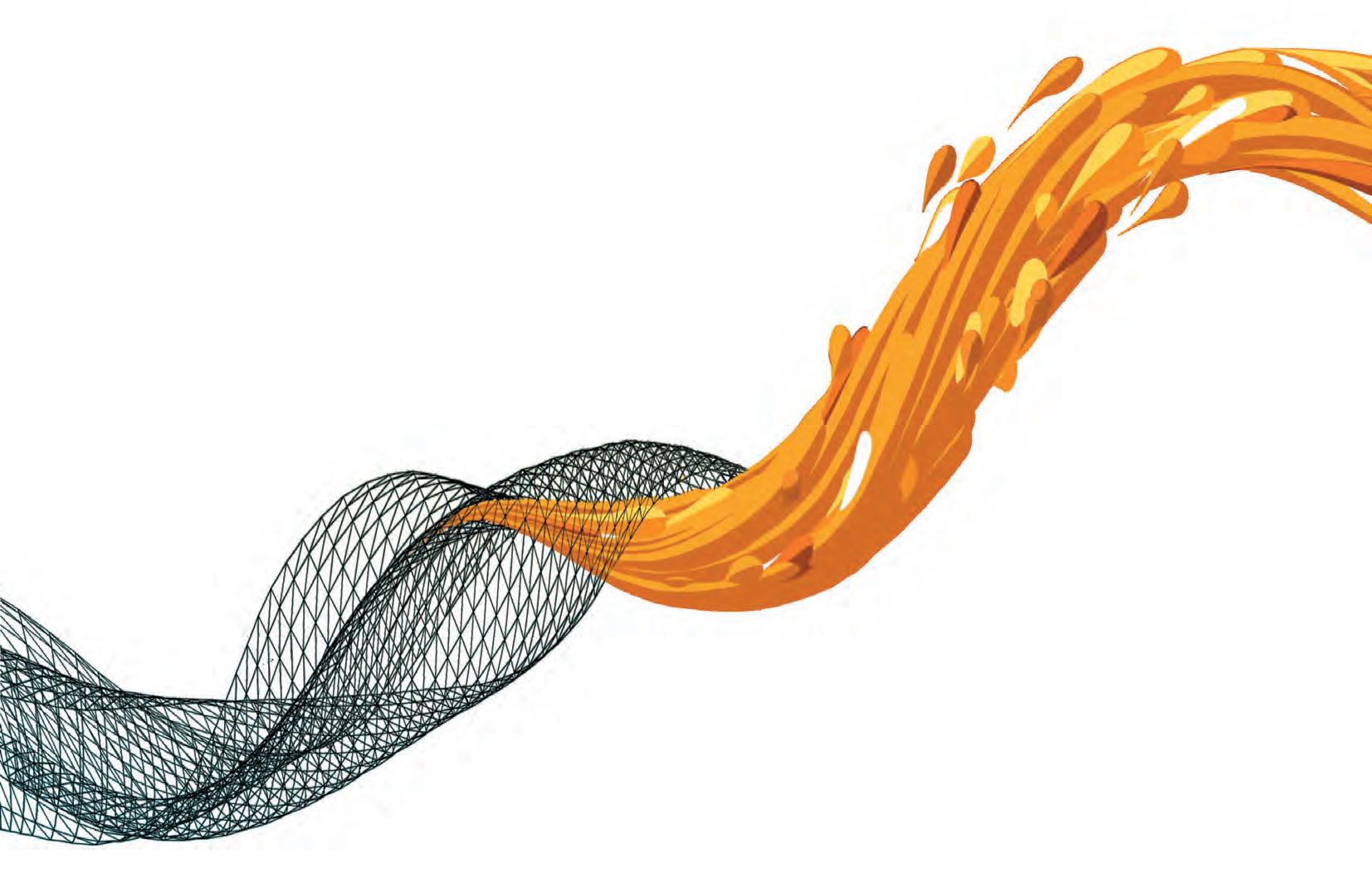
materials that convey quality by expressing the concepts of purity and transparency - transforming waste into products that reflect beauty, style and high standards. Our team is focused on the future, seeking new solutions through partnerships with academic institutions and qualified stakeholders. These collaborations allow us to anticipate both technological developments and market trends. The entire process, from collection to recycling and the creation of new materials, demonstrates the development and innovation capacity of a supply chain made up of multiple links in the value chain: Aliplast is one of these links and, indeed, must play a pivotal role in connecting them. The investments we are making position us as a key player in the creation of a new installed recycling capacity. In fact, Modena will become our recycling hub for rigid plastics, particularly HDPE and polypropylene. From this site, we will launch a new range of highquality materials designed to meet minimum recycled content requirements. This site will embody circular economy model, developed in synergy with the Hera Group, where sustainability is realised through a production process built on the circular use of resources. The new site is part of a well-established Hera Group industrial hub, allowing it to leverage the potential of multiple business lines. In particular, it will be powered by the electricity generated from the nearby wasteto-energy facility, while the production process will use water from the purification plant, which will then be fed back into the process, thus completing a virtuous circle. All of this is being developed in full compliance with the timelines set for flagship circular economy projects, which will be funded through the National Recovery and Resilience Plan (PNRR)”.
15—19 September 2025 Munich, Germany

Experience the comprehensive range of products across the entire value chain, from raw materials to packaging and logistics solutions – all in action. Network with industry experts, discover the “The Next Big Thing”, and gain valuable insights into the key topics:
Data2Value
Lifestyle & Health
Circularity & Resource Management
Are you ready?
Secure your ticket today!
Tetra Pak
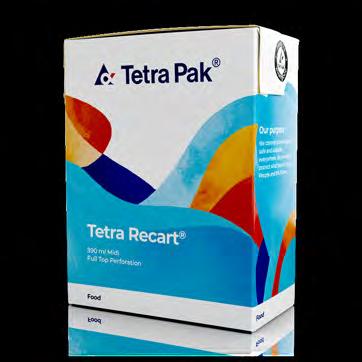
Comunicazione al consumatore, packaging design, sostenibilità, nuovi stili di vita e di consumo sono alcune delle parole chiave che caratterizzano l’azione globale di Tetra Pak, che con Paolo Maggi offre un punto di vista di ampio respiro sul mercato mondiale del packaging, tra nuove tendenze e vincoli normativi che, uniti alla sensibilità dei consumatori, guidano l’innovazione nello sviluppo di nuove soluzioni di confezionamento.
Dopo il voto del PPWR, il mercato guarda alla normativa facendone un punto di riferimento e un obiettivo. Come valuta il nuovo quadro?
“Seguiamo la vicenda PPWR fin dai suoi primi passi”, esordisce Maggi. “L’aspetto che ritengo fondamentale è che ci sia piena consapevolezza dell’impatto degli atti esecutivi sui diversi mercati. Un tema su cui stiamo sensibilizzando gli stakeholder sia a livello nazionale che europeo, per far comprendere il significato che la nuova normativa ha sulla filiera dell’imballaggio e agroalimentare. Manteniamo quindi un dialogo continuo con una varietà di interlocutori che spaziano dai trasformatori ai distributori come la GDO, senza dimenticare i clienti dei nostri clienti, i consumatori. Quanto all’impatto sulle politiche legate al monouso, dipende dalle categorie merceologiche, ma è chiaro che il PPWR sposti la responsabilità sulla grande distribuzione; ecco perché serve un dialogo con i consumatori. L’Osservatorio Packaging del Largo Consumo 2025 di Nomisma parla con chiarezza del ruolo svolto dai clienti nella spinta al packaging sostenibile, considerando che nel 75% dei casi i consumatori usano le qualità green della confezione come uno dei veicoli di informazione che orientano le decisioni d’acquisto. Visto il ruolo ricoperto da Tetra Pak nel-
la filiera alimentare, siamo i primi a sostenere la paperizzazione del nostro packaging, spendendo 100 milioni in R&D in uno sforzo concentrato verso un packaging sempre più sostenibile per materiale e design. Puntiamo infatti a una semplificazione che coniughi funzionalità e sostenibilità con l’obiettivo di raggiungere il 90% di base carta proveniente da filiere rinnovabili nelle nostre confezioni”.

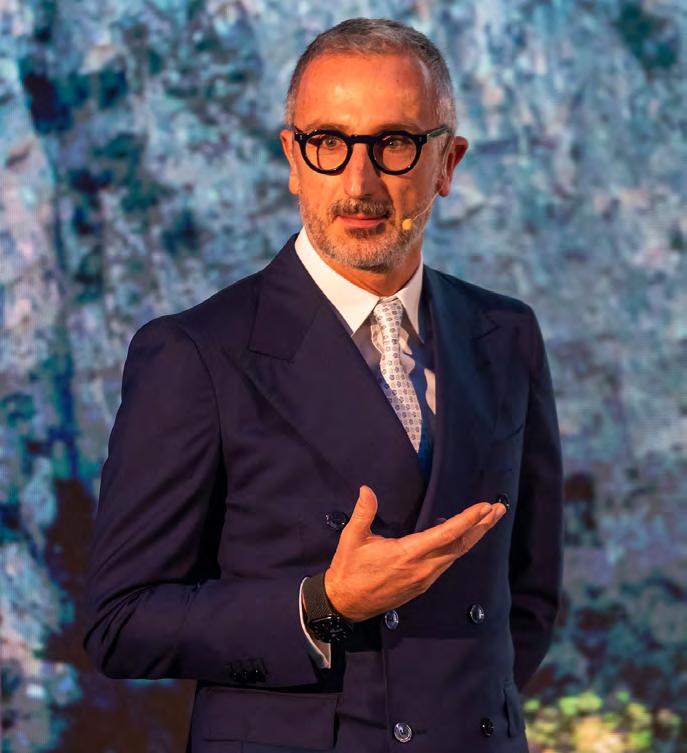

In questa logica quale prodotto della vostra ampia gamma riflette l’impegno per la sostenibilità dell’azienda?

“Tetra Recart è la nostra risposta alle richieste di maggiore sostenibilità del consumatore”, prosegue Maggi, “a cui va offerto un packaging che garantisca la food safety e contestualmente riduca l’impatto ambientale. Si tratta di una soluzione che offre numerosi vantaggi funzionali oltre alla sostenibilità: tra questi, la facilità di apertura senza forbici, la shelf life, l’efficienza nel trasporto e scaffalatura grazie a cube efficiency e leggerezza. Si tratta di qualità che riducono ulteriormente le emissioni con una funzionalità che offre vantaggi sia al retailer che al consumatore, senza dimenticare le ampie superfici del pack che aiutano sia la comunicazione che l’informazione sul prodotto e la confezione”.
Parlando di comunicazione al consumatore il passaggio al labelling è inevitabile…
“Tetra Pak ha sviluppato una soluzione tecnologica di digital printing che permette di migliorare la qualità della stampa, introducendo sistemi di tracciabilità a monte e a valle della filiera. Questo ci permette di attribuire una vera e propria identità individuale a ogni singola confezione, che si tratti di personalizzazione a fini di marketing o tracciabilità del prodotto, che siamo in grado di seguire dal trasformatore al distributore. Oggi è possibile seguire la storia del singolo prodotto fino al lotto di produzione, avvicinandosi sempre di più alla sensibilità del consumatore con logiche tipiche della tracciabilità farmaceutica”.
Una multinazionale globale ha una visione panoramica sulla geopolitica del packaging: a quali trend assistete nei mercati in cui siete operativi?
“Il nostro osservatorio è globale visto che operiamo in 160 paesi. Investiamo quindi molto tempo e risorse nel cogliere le tendenze di clienti, consumatori e distributori. Due in particolare meritano di essere condivise in termini di prodotto e soluzioni. La prima guarda ai prodotti FSN, cioè funzionali, nutrizionali, arricchiti di proteine. Un trend visibile anche nel nostro mercato dove un esempio emblematico sono latte e yogurt arricchiti e in generale tutti i prodotti che guardano ai clienti che cer-


cano prodotti ad elevato contenuto proteico. Si tratta di un trend che modifica le abitudini alimentari del consumatore italiano, introducendone di nuove o ampliando quelle esistenti. Il latte, ad esempio, è una tipica referenza da colazione che oggi viene consumato tutto il giorno on the go, richiedendo formati di packaging innovativi. Per rispondere ai nuovi stili di vita e di consumo, abbiamo quindi introdotto formati da 200 a 300 ml con soluzioni che favoriscono il consumo senza cannuccia. Sui succhi da 200 ml, in particolare, abbiamo introdotto una tecnologia che ci permette la macro injection in contenitori che sono allo stesso tempo più sostenibili poiché senza cannuccia e appealing. Un secondo aspetto importante è il cambio della struttura demografica, che vede nuclei famigliari più piccoli che richiedono porzioni inferiori e quindi nuovi packaging design funzionali e sempre più sostenibili”.
Maria Costanza Candi
Consumer communication, packaging design, sustainability, new lifestyles and consumption are some of the keywords that characterise Tetra Pak’s global strategy. In this interview, Paolo Maggi offers a broad perspective on the global packaging market, exploring emerging trends and regulatory constraints that, together with growing consumer awareness, are driving innovation in the creation of next-generation packaging solutions.
Following the PPWR vote, the market is looking at the legislation as both a benchmark and a target. How do you assess the new regulatory framework?
“We have been closely monitoring the PPWR process since its inception,” Maggi began. “What I believe is most important is a clear understanding of the impact that executive decisions can have on different markets. This is an issue on which we are actively engaging stakeholders at both national and European levels to ensure they fully understand the significance of the new legislation for the packaging and food supply chain. For this purpose, we maintain ongoing dialogue with a wide range of stakeholders – from processors to distributors, including large-scale retail chains – while also keeping in mind the end users, i.e. consumers.
The impact of policies related to single-use plastics varies by product category, but what is evident is that the PPWR places the responsibility on large retailers. This is why consumer engagement is needed. The findings of Nomisma’s Osservatorio Packaging del Largo Consumo 2025 clearly underscore the role consumers play in driving demand for sustainable packaging.
In fact, 75% of consumers view the eco-friendly qualities of packaging as a key factor influencing their purchasing decisions. Given Tetra Pak’s role in the food supply chain, we are the first to support paperbased packaging, investing €100 million in R&D as part of a focused effort to develop increasingly sustainable packaging materials and design solutions. In fact, we are working towards a simplified packaging design that combines functionality and sustainability, with the aim of reaching a 90% paperbased composition using renewable resources.”
With this in mind, which product from your extensive range best reflects the company’s commitment to sustainability?
“Tetra Recart is our response to growing consumer demand for more sustainable packaging,” Maggi continues. “We must offer packaging solutions that guarantee food safety while minimising environmental impact. Tetra Recart not only meets sustainability standards but also delivers a range of functional benefits: it’s easy to open without scissors, offers an extended shelf life, and improves transport and shelf efficiency thanks to its lightweight, cubeefficient design. These qualities help further reduce emissions while offering practical benefits for both retailers and consumers. In addition, the pack’s large surface allows for clear communication of product details and packaging information.”
Speaking of consumer communication, the passage to labelling is inevitable...
“Tetra Pak has developed a digital printing technology that improves print quality, introducing traceability systems both upstream and downstream along the supply chain. This enables us to assign a unique identity to each individual pack, whether for marketing customisation or product traceability, which we can track from the processor to the distributor. Today, we are able to trace the journey of each individual product down to its production batch, bringing us ever closer to consumer’s expectations and applying traceability standards typically seen in the pharmaceutical industry.”
A global multinational has a broad perspective on the geopolitics of packaging. What trends are emerging in the markets where you operate?
“Our vantage point is truly global, as we operate in 160 countries,” continues Paolo Maggi. “That’s why we invest a lot of time and resources in monitoring trends among customers, consumers and distributors. Two key trends stand out in terms of products and solutions. The first concerns FSN products, i.e. functional, nutritional, protein-enriched offerings. This trend is also evident in our market, with enriched milk and yoghurt serving as key examples – part of a broader category of products aimed at consumers looking for highprotein options. It’s a trend that is reshaping the eating habits of Italian consumers, introducing new ones or expanding existing ones. Take milk, for example. Once primarily associated with breakfast, it is now consumed throughout the day and increasingly on the go, prompting the need for innovative packaging formats. In response to these new lifestyles and consumption habits, we have introduced 200 to 300-ml formats specifically designed for straw-less consumption. For 200 ml juice products in particular, we have implemented macro-injection technology that enables the creation of straw-less packs that are not only more sustainable but also visually appealing. A second trend is the shifting demographic landscape, with smaller households driving demand for smaller portion sizes and, in turn, packaging solutions that are both functional and increasingly sustainable.”
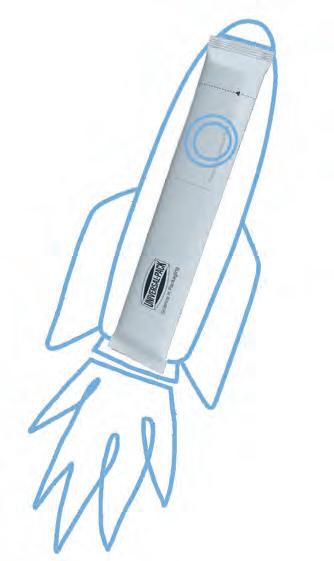









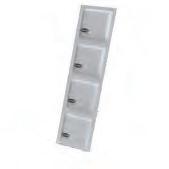


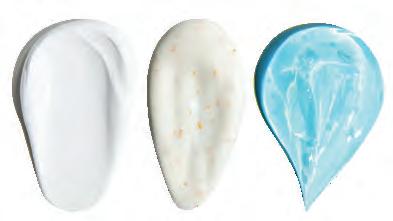
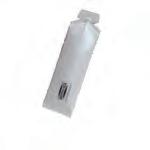



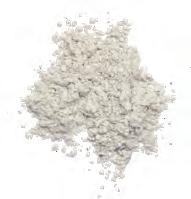



Le previsioni del Centro studi Mecs sull’export negli Usa. Riflettori accesi sull’America Latina: buoni i margini di sviluppo.
Luca Baraldi e Generoso Verrusio
è un prima e un dopo, una sorta di effetto spartiacque da cui nemmeno il mondo delle macchine per il packaging può dirsi immune. Colpa o merito, dipende dai punti di vista, della nuova traiettoria che a livello di politica economica e commerciale il presidente Donald Trump ha deciso di imprimere all’America.
I dazi continuano a generare panico, stress e caos sui mercati internazionali. Occorre però fare dei distinguo e soprattutto giocare di anticipo in questa contingenza liquida e mutevole. ItaliaImballaggio, in collaborazione con Mecs, il centro studi di Ucima, prosegue la sua lettura esclusiva dei fenomeni che riguardano il mondo del packaging.
Il focus di questa seconda puntata è sugli Stati Uniti, con un’analisi previsionale divisa per tipologie di macchine e settori clienti - il cui sguardo abbraccia il periodo 2024/2028 - e una digressione che per prossimità geografica ricade sull’area Mercosur (Brasile, Argentina, Bolivia, Uruguay e Paraguay). I numeri, come vedremo, confermano ancora una volta grande resilienza: le macchine per il packaging conti-
nuano a offrire opportunità di sviluppo, sebbene con ritmi più lenti.
Stati Uniti, mercato decisivo nonostante i dazi
Gli Stati Uniti mantengono appeal e prospettive di crescita. Il mercato del packaging a stelle e strisce ha raggiunto nel 2023 un valore complessivo di 11,9 miliardi di euro, con una copertura da parte dei produttori locali superiore al 60%.
Le importazioni (40%) si suddividono tra macchine nuove (73,4%) e parti di ricambio (26,6%). Tra i principali Paesi esportatori verso gli Stati Uniti, nel 2023, la Germania si posiziona al primo posto con il 23,7% della quota import, seguita dall’Italia (22%). Altri “fornitori” di rilievo includono Canada (13,5%), Svizzera (5,9%) e Cina (5,9%). Esaminando il mercato per tipologia di macchina, emerge in modo lampante che le categorie di maggior pregio sono le confezionatrici automatiche FFS (Form Fill Seal), con un valore di 2.104,4 milioni di euro, seguite dalle Riempitrici (2.078,2 milioni). Altre tipologie di macchine importanti per dimensione di mercato sono le Astucciatrici (1.413,5 milioni) e i Palettizzatori (1.303 milioni).

Volgendo l’attenzione ai settori clienti, infine, il Food è dominante con un valore di 4.285,6 milioni di euro, seguito dal Beverage con 2.729,3.
Chiude il podio la Pharma, con un valore di 1.397,7 milioni di euro.
Prima dell’annuncio dei dazi, le proiezioni indicavano una crescita media annua (Cagr) del +4,8% fino al 2028, con un mercato destinato a raggiungere i 15 miliardi di euro. Secondo queste proiezioni iniziali, i settori che mostravano tassi di crescita attesi superiori alla media del mercato totale erano il Chimico (Cagr +5,2%) e il Food (+4,9%). Tra le famiglie di macchine, quelle con le migliori prospettive di crescita media annua erano le Manipolatrici (Cagr +5,2%), le Astucciatrici (+5%), le Etichettatrici (+5%), i Palettizzatori (+5%) e le Chiuditrici (+5%).
A valle del “new deal” trumpiano, invece, con l’inizio delle prime tensioni commerciali, Mecs ha rivisto il suo modello previsionale, prevedendo un rallentamento della crescita in Usa, per un
valore totale di mercato pari a 14,5 miliardi di euro (Cagr +4,1%).
Tirando le somme, poco male verrebbe da dire. Sebbene le previsioni di espansione per i prossimi anni siano state ridimensionate, è molto probabile che il mercato USA continui a offrire opportunità significative all’Italia del packaging. Il Belpaese ha saputo ritagliarsi un ruolo da protagonista nel settore premium delle macchine per l’imballaggio e, dazi o non dazi, esistono ancora nicchie ad alto potenziale.
Mercosur, dinamismo e nuove opportunità
Il Mercosur è un mercato di dimensioni inferiori rispetto agli USA, vale complessivamente 2,9 miliardi di euro nel 2023. A fare da traino regionale ci sono Brasile (650 milioni di euro), Colombia e Argentina (entrambi intorno ai 200 milioni di euro).
L’Italia, nel 2023, costituisce il principale partner commerciale di questa area: detiene una quota del 27,8% delle importazioni totali.
Seguono Germania (20%), Stati Uniti (16,4%), Cina (9,4%) e Spagna (6,2%). Per il periodo 2024-2028, si prevede che l’export italiano verso il Mercosur possa crescere con un Cagr in aumento del 2,7%.
Per quanto riguarda le tipologie di macchine, nel 2023 le Riempitrici guidano il mercato con un giro di affari che si attesta a 606,2 milioni di euro, seguite dalle macchine FFS (584,5 milioni).
Analizzando i settori clienti, il settore Food rappresenta la quota maggiore del mercato regionale (984,9 milioni), seguito dal Beverage (795,3 milioni) e dal Pharma (382,8 milioni).
Secondo le analisi prospettiche di Mecs, il Mercosur crescerà da qui al 2028 con un Cagr del 3,7%, ovvero fino a circa 3,4 miliardi di euro in valore. Da parte del Perù sono attesi i risultati migliori: Cagr +5.5%. Tra i settori, il Pharma ha i tassi attesi più alti (Cagr +4,1%), mentre tra le tecnologie, FFS e Riempitrici traineranno la crescita dell’imballaggio primario, rispettivamente con 710 e 707 milioni di euro.
Mecs Study Centre forecast regarding exports to the USA. Spotlight on Latin America: good margins for growth.
by Luca Baraldi and Generoso Verrusio
There is a before and an after, a kind of watershed from which even the world of packaging machinery cannot claim to be immune. This is the fault, or the merit - that’s a matter of opinion - of the new economic and trade policy approach adopted by US President Donald Trump. Tariffs are continuing to cause panic, stress and chaos on international markets. However, distinctions need to be made, and above all, we need to keep ahead of the game in such a changeable, evolving situation.
In collaboration with Mecs, the UCIMA study centre, ItaliaImballaggio is continuing with its exclusive interpretation of the phenomena affecting the packaging world.
The focus of this second part is on the United States, with a forecast analysis divided by machine types and customer sectors - embracing the period 2024/2028 - and a digression that takes a look at the Mercosur area in the American continent (comprising Brazil, Argentina, Bolivia, Uruguay and Paraguay). The figures, as we shall see, again confirm the impressive resilience of the sector: packaging machinery continues to offer opportunities for growth, albeit at a slower pace.
The USA: a decisive market, despite tariffs
The USA remains an attractive market, offering prospects for growth. The American packaging market reached a total value of €11.9 billion in 2023, with coverage by local manufacturers exceeding 60%.
Imports (40%) are divided between new machines (73.4%) and spare parts (26.6%). Among the top countries exporting to the United States in 2023, Germany ranks first, with 23.7% of the import share, followed by Italy (22%). Other notable “suppliers” include Canada (13.5%), Switzerland (5.9%) and China (5.9%).
If we examine the market by machine type, it becomes glaringly obvious that the most valuable categories are automatic FFS (Form Fill Seal) packaging machines, with a value of €2,104.4 million, followed by Filling Machines (€2,078.2 million). Other machine types with a sizeable market share are Cartoning Machines (1,413.5 million) and Palletisers (1,303 million). Finally, with regard to customer sectors, Food tops the list, with a value of €4,285.6 million, followed by Beverage, with €2,729.3. Pharmaceuticals, with a value of €1,397.7 million, takes the third spot on the podium.
Prior to the tariff announcement, projections indicated a compound annual growth rate (CAGR) of +4.8% until 2028, with the market set to reach €15 billion. According to these initial projections, the sectors showing expected growth rates above the average for the total
market were Chemicals (CAGR +5.2%) and Food (+4.9 %). Among machine families, those with the best CAGR prospects were Manipulators (CAGR +5.2%), Cartoning Machines (+5%), Labelling Machines (+5%), Palletisers (+5%) and Closing Machines (+5%).
Downstream of the Trumpian “new deal”, however, with the onset of the first trade tensions, Mecs has revised its forecasting model, predicting a slowdown in US growth to a total market value of €14.5 billion (CAGR +4.1%).
To sum up, the outlook is not too gloomy. Although forecasts for expansion in the next few years have been scaled back, it is highly likely that the U.S. market will continue to offer significant opportunities for Italian packaging. Italy has been able to carve out a leading role for itself in the premium packaging machinery sector, and with or without tariffs, highpotential niche opportunities remain.
Mercosur: dynamism and new opportunities
Mercosur is a smaller market than the US, worth a total of €2.9 billion in 2023. The market in the region is driven mainly by Brazil (€650 million), Colombia and Argentina (both around €200 million).
In 2023, Italy was the main trading partner in this area, with a 27.8% share of total imports, followed by Germany (20%), the United States (16.4%), China (9.4%) and Spain (6.2%). For the period 2024-2028, Italian exports to Mercosur are expected to grow, with a 2.7% rise in CAGR.
In terms of machine types, Filling Machines led the market in 2023, with a turnover of €606.2 million, followed by FFS machines (€584.5 million). If we look at customer sectors, Food accounted for the largest share of the regional market (€984.9 million), followed by Beverage (€795.3 million) and Pharmaceuticals (€382.8 million). According to Mecs’ prospective analysis, Mercosur will grow between now and 2028, with a CAGR of 3.7%, increasing to around €3.4 billion in value. The best results are expected from Peru, with a 5.5% increase in CAGR. The highest rates are expected in the Pharmaceutical sector (CAGR +4.1%), while among technologies, FFS and Filling Machines will drive growth in primary packaging, with €710 and €707 million respectively.
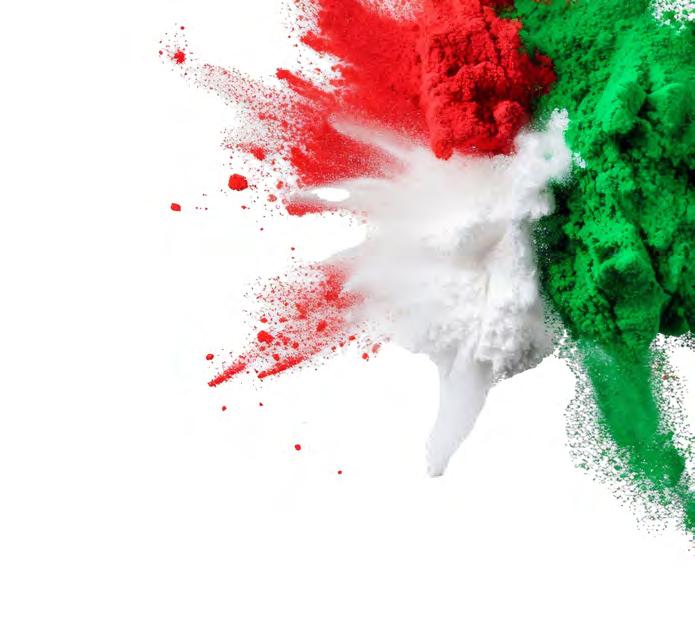

Netcomm Forum 2025: presentate le nuove proiezioni del mercato eCommerce B2c in Italia. Gli acquisti online saliranno a oltre 62 miliardi di euro (+6%) con una base di 35,2 milioni consumatori digital. I comparti Food & Grocery e Beauty&Pharma registrano incrementi superiori alla media.
Milena Bernardi
Procede spedita, seppur a ritmi più contenuti, la corsa dell’eCommerce B2c in Italia.
L’ultimo Osservatorio eCommerce B2c Netcomm - School of Management del Politecnico di Milano, prevede che nel 2025 il valore degli acquisti online crescerà del 6% rispetto al 2024 arrivando a superare i 62 miliardi di euro, di cui 22 miliardi generati dai servizi (+8% sul 2024) e più di 40 miliardi realizzati dai prodotti (+6%). Nell’ambito degli acquisti di prodotto, i comparti Food & Grocery e Beauty&Pharma sono quelli che performeranno meglio con incrementi superiori alla media (+7%) mentre Abbigliamento, Informatica ed Elettronica di consumo e Arredamento e home living andranno incontro a una crescita in linea con quella del settore (tassi compresi tra il +5% e il +6%). La penetrazione dell’online sul totale acquisti Retail (online+offline) nei prodotti è pari all’11,2%, mezzo punto percentuale in più rispetto al 2024.


Gli acquisti eCommerce B2c di prodotto in Italia
Nel 2025, il mercato eCommerce B2c di prodotto continua a crescere (+2,1 MILIARDI DI EURO rispetto al 2024)







La crescita del comparto, peraltro, avviene in un contesto geopolitico complesso e in continua evoluzione. A provocare incertezza sul futuro, oggi, è soprattutto l’introduzione dei dazi (al momento congelati) da parte degli Stati Uniti, ma anche - spiega Roberto Liscia, Presidente di Netcomm “La mancanza di strategie digitali efficaci e dell’innovazione tecnologica necessaria a competere sui mercati globali. Infatti, sebbene l’eCommerce sia uno
strumento chiave per favorire l’export delle PMI, oltre il 54% delle imprese italiane fatica a espandersi oltre i confini nazionali”. Secondo Liscia, in uno scenario così variabile e incerto le competenze diventano la vera chiave del futuro: “Non parliamo più solo di capacità tecniche o digitali, ma di un insieme complesso e integrato di saperi, attitudini, comportamenti che determinano la capacità di adattarsi, innovare, generare valore e che faranno sempre più la differenza nelle organizzazioni”.
CRESCITA IN LINEA CON LA MEDIA DEI PRODOTTI (+6%)
CRESCITA SUPERIORE ALLA MEDIA DEI PRODOTTI (+6%)
CRESCITA INFERIORE ALLA MEDIA DEI PRODOTTI (+6%)
Aumentano le aziende con un proprio sito di e-commerce
Il numero di imprese italiane che hanno attivato una piattafroma e-commerce è aumentato del 3,4% rispetto al 2024, raggiungendo le 91.000 unità, con una crescita marcata delle società di capitale (+8,5%). I dati evidenziano la maturazione del settore e l’integrazione di strategie digitali avanzate. I comparti più rilevanti sono il commercio e i servizi, con un forte coinvolgimento nei settori del Beverage, dell’Editoria e dei prodotti alimentari. Sul piano della comunicazione, l’82,7% delle aziende è presente sui social media, con Facebook e Instagram come i canali più utilizzati. La digitalizzazione è infatti in forte crescita, con il 67,2% delle aziende che mostra un alto livello di “Digital Attitude”. Tuttavia, oltre il 54% delle imprese presenta ancora un basso livello di internazionalizzazione, con la necessità di sviluppare strategie per esportare maggiormente il Made in Italy.
I social: principale fonte di orientamento per lo e-shopping
Secondo il report Netcomm NetRetail 2025, che indaga i comportamenti di acquisto digitale degli italiani e sulle prospettive per il commercio omnicanale in Italia, i consumatori che comprano online nel 2025 raggiungeranno i 35,2 milioni (+1,5 milioni rispetto all’anno precedente). I social media rimangono una fonte importante di orientamento per circa un acquisto su quattro (29,8%), insieme ai punti vendita e al retail media online, mentre le notifiche push segnano un leggero calo. Inoltre, in base alla categoria di prodotto, si osservano preferenze specifiche: ad esempio, l’uso di AI e chatbot è particolarmente rilevante nell’elettronica e nell’editoria, mentre il retail media offline è più influente nel settore alimentare.
I trend nei pagamenti online I metodi di pagamento per gli acquisti online in Italia sono sempre più diversificati (l’89% delle transazioni avviene al momento dell’ordine). I principali strumenti di pagamento sono il Digital Wallet (30,8%), la carta di credito (26,4%) e la prepagata sul sito (23,6%). Le aspettative dei consumatori in merito alle transazioni online riguardano soprattutto la sicurezza delle transazioni e la varietà di opzioni di pagamento, con una crescente domanda di soluzioni integrate e flessibili. Sebbene la richiesta di sicurezza sia diminuita negli anni, la varietà nelle modalità di pagamento è rimasta invece una priorità per gli utenti.
Netcomm Forum 2025: new projections of the B2C eCommerce market in Italy presented. Online purchases will rise to over €62 billion (+6%) with a base of 35.2 million digital consumers. Above-average increases recorded in the Food&Grocery and Beauty&Pharma segments.
The B2C eCommerce race in Italy is proceeding well, albeit at a slower pace. The latest eCommerce B2C Observatory Netcomm - School of Management of the Polytechnic University of Milan predicts a 6% rise in the value of online purchases in 2025 compared to 2024, reaching more than €62 billion, of which €22 billion will be generated by services (+8% compared to 2024) and more than €40 billion by products (+6%). In the area of product purchases, the best performance is forecast in the Food&Grocery and Beauty&Pharma segments, with above-average increases (+7%), while Apparel, Computers & Consumer Electronics and Furniture & Home Living will experience growth in line with that of the sector (rates between +5% and +6%). Online penetration of total Retail purchases (online+offline) in products is 11.2%, half a percentage point higher than in 2024.
Dealing with complexity
The growth of the industry is taking place in a complex and ever-changing geopolitical environment. At the moment, uncertainty regarding the future is mainly due to the introduction of excise duties (currently frozen) by the United States, but another factor, explains Roberto Liscia, president of Netcomm, is “the lack of effective digital strategies and the technological innovation necessary to compete in global markets. Although eCommerce is a key tool for boosting SME exports, more than 54% of Italian companies struggle to expand beyond national borders”.
According to Liscia, in such a variable and uncertain scenario, skills become the real key to the future: “We are no longer talking only about technical or digital capabilities, but about a complex and integrated set of knowledge, attitudes, and behaviours that determine the ability to adapt, innovate, and generate value, and which will increasingly make a difference in organisations”.
Increasing number of companies with their own e-commerce website
The number of Italian companies that have activated an e-commerce platform has increased by 3.4% since 2024, up to 91,000, with marked growth in corporations (+8.5%).
The data highlight the maturation of the industry and the integration of advanced digital strategies. The main sectors involved are trade and services, with a strong presence in the Beverage, Publishing and Food segments. In terms of communication, 82.7% of companies have a social media presence, with Facebook and Instagram the most widely used channels. There is a strong rise in digitalisation, with 67.2% of companies showing a high level of ‘Digital Attitude’. However, more than 54% of enterprises still have a low level of internationalization, with the need to develop strategies to boost Made in Italy exports.
Social media: the main source of guidance for e-shopping According to the Netcomm NetRetail 2025 report, which looks into the digital shopping behaviours of Italians and the prospects for omnichannel commerce in Italy, consumers shopping online in 2025 will reach 35.2 million (up 1.5 million from the previous year).
Social media remains an important source of guidance for approximately one in four purchases (29.8%), along with point-of-sale and online retail media, while a slight decline is observed in push notifications. In addition, based on product category, specific preferences are observed: for example, the use of AI and chatbots plays a significant role in electronics and publishing, while offline retail media is more influential in the food sector.
Trends in online payments
Payment methods for online purchases in Italy are increasingly diverse (89% of transactions occur at the time of order). The main payment instruments are Digital Wallet (30.8%), credit card (26.4%) and prepaid on the website (23.6%). Consumers’ expectations of online transactions mainly regard the security of transactions and the variety of payment options, with a growing demand for integrated and flexible solutions. Although the demand for security has decreased over the years, variety in payment methods has remained a priority for users.
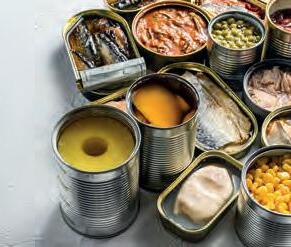








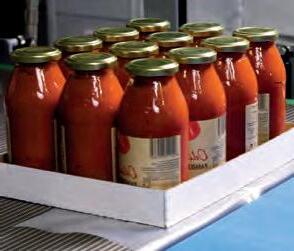

Grazie alla collaborazione con organizzazioni del terzo settore, studentesse e studenti del Corso di Laurea in Design del Prodotto Industriale dell’Università di Bologna hanno sviluppato una sperimentazione che esplora il potenziale dell’imballaggio come strumento di supporto emotivo.
Erik Ciravegna e Sara Battistini
Il progetto che presentiamo in queste pagine ha avuto come obiettivo l’ideazione di kit per persone in situazioni di vulnerabilità, con l’obiettivo di offrire sostegno nei momenti di crisi. I risultati mostrano come il design possa contribuire al benessere psicologico individuale, trasformando il packaging in un gesto tangibile di cura e attenzione.
Oltre l’involucro: il packaging come gesto di cura e simbolo di inclusione
Un progetto didattico che esplora il packaging design come supporto nei contesti di fragilità emotiva, ispirandosi al concetto di cura come gesto comunicativo.
Nel panorama attuale del settore del packaging, dominato da criteri di funzionalità, sostenibilità

Progetto di Alexia Gambini, Lucia Godoli, Giulia Grande, Maria Ravaioli, Beatrice Salvini.
Realizzato in collaborazione con l’U.S.S.M. Ufficio Servizio Sociale Minorenni - Sede di Bologna.
Il progetto supporta il dialogo tra assistenti sociali e minorenni autori di reato, incentivando l’apertura e la creazione di un rapporto di fiducia. Attraverso un diario personale e un gioco di carte, ragazze e ragazzi possono esplorare le loro emozioni e instaurare conversazioni autentiche, per un percorso di crescita personale e di recupero verso il rinserimento nella società.
e appeal comunicativo, si affaccia un’esperienza formativa che invita a considerare un’altra dimensione: quella della cura. Il progetto “Care Package. Kit per crisi emozionali” nasce all’interno del Laboratorio di Comunicazione Visiva del Corso di Laurea in Design del Prodotto Industriale dell’Alma Mater StudiorumUniversità di Bologna. Studentesse e studenti del secondo anno si sono cimentati in un’esplorazione originale su come un artefatto come il packaging possa contribuire a sostenere il benessere psicologico delle persone nei momenti di vulnerabilità.
Il Laboratorio propone ogni anno una sperimentazione progettuale che integra conoscenze teoriche e strumenti operativi, con l’intento di coniugare consapevolezza culturale e capa-

A project by Alexia Gambini, Lucia Godoli, Giulia Grande, Maria Ravaioli, and Beatrice Salvini.
Developed in collaboration with the Juvenile Social Service Office (U.S.S.M.) - Bologna branch.
The project promotes dialogue between social workers and juvenile offenders, fostering openness and the development of mutual trust. Through the use of a personal diary and a card game, participants are guided to explore their emotions and engage in meaningful conversations, supporting their journey of personal growth, recovery and reintegration into society.

Sintonia
Progetto di Tommaso Graziani, Alessia Menegazzo, Amanda Taravelli, Mireia Vila Blaya, Serena Zauli
Realizzato in collaborazione con la Fondazione Blue Butterfly E.T.S.
Il progetto intende promuovere il benessere individuale, familiare e sociale di giovani con autismo. Il kit, destinato ai caregiver, è costituito da un mazzo di carte con proposte di attività artistiche e musicali, provenienti dalle artiterapie. Comprende indicazioni su come realizzare tali attività ed eventualmente adattarle, anche con il supporto di professionisti.
cità progettuale. Per l’edizione 2024/2025 - a cura dei docenti Erik Ciravegna e Luca Grilli, con la collaborazione della tutor Sara Battistini e le cultrici della materia Elisa Valerio ed Elisa Vacondio - la sfida è stata quella di ideare “kit” capaci di offrire un supporto nei momenti di crisi emozionale, rivolti a persone che attraversano condizioni di fragilità temporanea o permanente. Non si tratta di sostituirsi a figure professionali specializzate, ma di progettare strumenti intermedi di consapevolezza, conforto e accompagnamento, che possano rappresentare un primo gesto di prossimità e incoraggiamento.
Dalla storia alla contemporaneità: l’evoluzione del “care package”
I kit progettati si ispirano al concetto di “care package”: un pacco che, nel corso del tempo, ha incarnato molte forme di solidarietà, conforto e connessione.
Il termine “care package” rimanda storicamente agli aiuti inviati nel secondo dopoguerra dall’organizzazione umanitaria CARE, nata per fornire assistenza alimentare alle popolazioni europee colpite dal conflitto. Il primo CARE Package, spedito nel 1946, conteneva beni di prima necessità ed è divenuto un simbolo tangibile di solidarietà internazionale. Ma la pratica di inviare doni o provviste a persone lontane ha radici ben più antiche, che attraversano epoche e culture: dai soldati dell’antica Roma

A project by Tommaso Graziani, Alessia Menegazzo, Amanda Taravelli, Mireia Vila Blaya, and Serena Zauli
Developed in collaboration with the Blue Butterfly E.T.S. Foundation.
The project is designed to promote the individual, family and social well-being of young people with autism. The project provides caregivers with a kit containing a deck of cards with suggestions for art and music activities inspired by art therapy practices. It includes guidance on how to carry out these activities and adapt them where necessary, also with the support of professionals.
ai cavalieri durante le Crociate, dai migranti del Novecento agli studenti fuori sede di oggi. In ogni epoca, questi gesti hanno rappresentato forme di cura materiale ed emotiva, strumenti di connessione tra chi dona e chi riceve. Il valore simbolico del “care package” è quello di un contenitore di attenzione, affetto e riconoscimento. È un gesto tangibile, che comunica presenza e sostegno, anche a distanza. Nel contesto contemporaneo, un kit può includere oggetti fisici, ma anche contenuti digitali come app, ebook, video. Ed è proprio questa ambivalenza - tra fisico e digitale, tra concreto e simbolico - che ha ispirato studenti e studentesse nella progettazione dei loro kit. L’attenzione è stata posta sull’equilibrio tra forma e contenuto, tra messaggio e supporto materiale. La campagna di comunicazione associata a ciascun kitdiffusa tramite social media, stampa o eventiha completato l’azione progettuale, veicolando messaggi di sensibilizzazione e promuovendo un’idea di design come atto sociale.
Packaging come interfaccia di relazione
Le crisi emozionali prese in esame dai gruppi di progetto riguardano situazioni frequenti ma spesso taciute: dalle malattie alle perdite, dai cambiamenti identitari ai conflitti interpersonali o interiori.
L’obiettivo è stato quello di fornire un primo sostegno emotivo, un segnale che dice: “non sei solo”, “non sei invisibile”.

Progetto di Francesca Guidotti, Tommaso Ilarda, Lisa Novelli, Camilla Poloni, Luca Riviello
Realizzato in collaborazione con l’Associazione G.R.D. Genitori Ragazzi Down Bologna.
Il progetto aiuta le persone con sindrome di Down tra i 18 e i 25 anni a gestire le emozioni e le relazioni sociali. Un gioco, da utilizzare in gruppo con una supervisione professionale, permette di apprendere ad affrontare le crisi emotive. Una campagna di sensibilizzazione mira a favorire l’inclusione e l’abbattimento degli stereotipi intorno alla sindrome di Down.
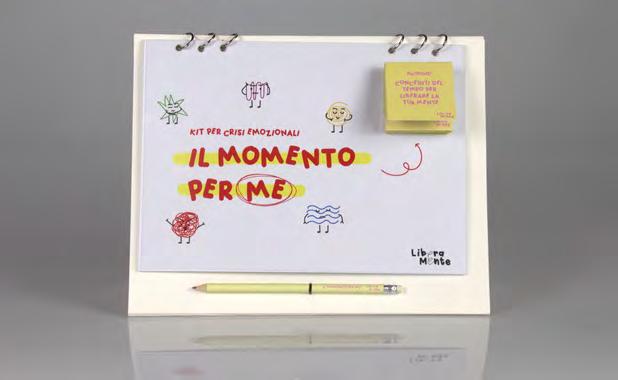
Progetto di Greta Mazzanti, Margherita Montanari, Leila Esperanza Ramos, Giulia Sampieri, Sofia Zini
Realizzato in collaborazione con La Rete Magica OdV - Amici per l’Alzheimer e il Parkinson
Il progetto è pensato per promuovere il benessere dei caregiver non professionisti che assistono familiari con Alzheimer o altre forme di demenza, fornendo un kit pratico per la gestione delle emozioni. Attraverso esercizi ispirati alla tecnica EMDR, aiuta a potenziare l’auto-efficacia, promuovendo l’equilibrio mentale, la serenità interiore e la consapevolezza emotiva.

A project by Francesca Guidotti, Tommaso Ilarda, Lisa Novelli, Camilla Poloni, and Luca Riviello
Developed in collaboration with the Genitori Ragazzi Down (G.R.D) Association of Bologna
The project supports young adults with Down syndrome (ages 18 to 25) in managing their emotions and navigating social relationships. It involves a group-based game, intended for use under professional supervision, that helps participants learn how to cope with emotional crises. An accompanying awareness campaign seeks to foster inclusion and dismantle stereotypes surrounding Down syndrome.
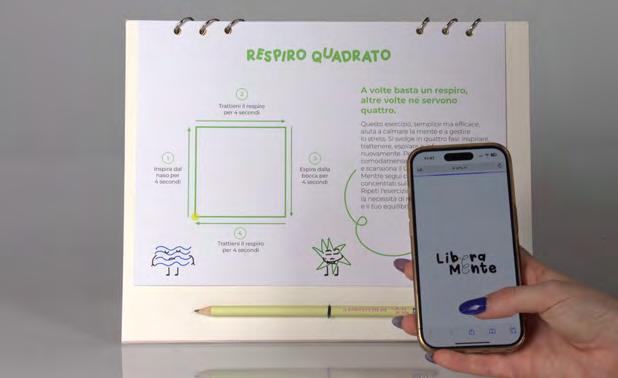
A project by Greta Mazzanti, Margherita Montanari, Leila Esperanza Ramos, Giulia Sampieri, and Sofia Zini
Developed in collaboration with La Rete Magica OdV - Friends of People living with Alzheimer’s and Parkinson’s disease
The project is designed to support the well-being of non-professional caregivers who care for family members affected by Alzheimer’s or other forms of dementia, offering a practical toolkit for emotional self-management. It includes exercises inspired by EMDR techniques to help strengthen caregivers’ sense of self-efficacy while fostering emotional awareness, mental balance and inner calm.
In questa prospettiva, il packaging non è più soltanto un involucro, ma diventa interfaccia relazionale, capace di avviare un processo di contatto e riflessione. I materiali, i formati, i messaggi, le grammatiche visive sono stati scelti con attenzione, per favorire un dialogo delicato e non invasivo, empatico e rispettoso. Il progetto ha visto la partecipazione attiva di numerose organizzazioni del territorio impegnate rispetto nel benessere psicologico, nella salute mentale e nell’inclusione sociale:
Associazione G.R.D. Genitori Ragazzi Down Bologna; Bimbo Tu, Cassero LGBTQIA+ Center, Educare alle Differenze, Fondazione Blue Butterfly E.T.S., La Rete Magica OdV - Amici per l’Alzheimer e il Parkinson, Scuola Penny Wirton Bologna - Associazione Diritto alla Parola, SIPEM SoS ER - Società Italiana Psicologia dell’Emergenza Emilia Romagna, Susan G. Komen Italia - Comitato Emilia-Romagna, U.S.S.M Ufficio Servizio Sociale Minorenni - Sede di Bologna. Il dialogo con queste realtà ha permesso di approfondire le esigenze specifiche di diversi target - minori, anziani, migranti, persone con disabilità - e di costruire soluzioni che rispondessero a bisogni concreti e articolati.
A fondamento del progetto vi è una visione del benessere psicologico come stato di equilibrio che consente all’individuo di sviluppare le proprie capacità, affrontare le sfide quotidiane, costruire relazioni sane e dare senso alla propria vita.
Il design, in questo contesto, si propone come mediatore tra bisogno e risposta, come linguaggio capace di facilitare la resilienza, stimolare l’autonomia e favorire l’inclusione. Il progetto Care Package ha messo in luce come il design possa agire non solo sulla forma degli oggetti, ma anche sui significati, sulle relazioni e sulla qualità della vita delle persone. In tal senso, il packaging si riconferma non solo contenitore, ma supporto comunicativo, capace di farsi carico della complessità emotiva e sociale del nostro tempo.

Progetto di Matilde Crostolo Gualtieri, Vittoria Gabelli, Adriana Grynyuk, Seza Güzelöz, Ester Herrera Ferrándiz.Realizzato in collaborazione con Susan G. Komen Italia - Comitato Emilia-Romagna.
Il progetto fornisce supporto pratico ed emotivo alle donne che hanno affrontato un intervento per il cancro al seno. Il kit comprende un diario personalizzabile con aggiornamenti mensili, spazi per la scrittura e QR code che rimandano a video di yoga oncologico. Con il “Murale delle Mani”, le donne di Komen lasciano un’impronta simbolica, trasmettendo un messaggio di sorellanza e guarigione.
“Care Package. Kit per crisi emozionali” non si limita a esplorare il design inclusivo: lo pratica, lo mette in scena e lo traduce in artefatti concreti e comunicabili. L’intero percorso didattico ha avuto come asse portante l’idea che il packaging possa essere un gesto che abbraccia, un artefatto che si prende cura delle persone. In un momento storico in cui il benessere psicologico è sempre più al centro dell’attenzione dell’opinione pubblica, ma ancora spesso stigmatizzato o trattato in modo astratto, questo progetto propone un approccio tangibile e sensibile. Un modo per riflettere, attraverso la pratica progettuale, sul ruolo che il design e la comunicazione visiva possono avere nel promuovere relazioni più umane, solidali e consapevoli.
Advanced Design Unit Università di Bologna Erik Ciravegna - erik.ciravegna@unibo.it; Sara Battistini - sara.battistini7@unibo.it
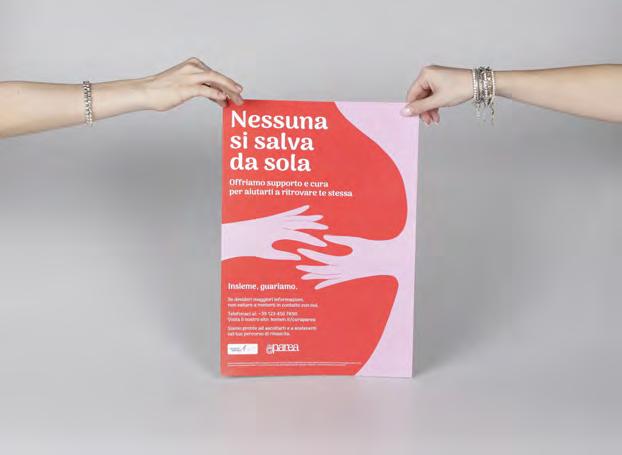
A project by Matilde Crostolo Gualtieri, Vittoria Gabelli, Adriana Grynyuk, Seza Güzelöz, and Ester Herrera Ferrándiz. Developed in collaboration with Susan G. Komen Italia - Emilia-Romagna Committee.
The project offers practical and emotional support to women recovering from breast cancer surgery. The kit includes a customisable journal with monthly updates, dedicated writing spaces and QR codes linking to oncology yoga videos. With the “Mural of Hands”, the women supported by Komen leave a symbolic imprint, conveying a message of sisterhood and healing.


Mia
Progetto di Ilaria Natali, Agnese Stoppa, Lucia Tinti, Annemein van den Heuvel, Chiara Zanoni
Realizzato in collaborazione con BimboTu
Il progetto è pensato per supportare giovani adulte affette da bulimia durante il processo di recupero. Il kit comprende un set da tavola per quattro persone con tovagliette e sottobicchieri con frasi motivazionali e una confezione di DAS, per stimolare la creatività e la condivisione. L’obiettivo è favorire il recupero di una relazione equilibrata con il cibo e momenti di convivialità.
A project by Ilaria Natali, Agnese Stoppa, Lucia Tinti, Annemein van den Heuvel, and Chiara Zanoni.
Developed in collaboration with BimboTu.
The project is designed to support young adults with bulimia along their path to recovery. The kit includes a table setting for four people, featuring placemats and coasters printed with motivational messages, as well as a package of DAS modelling clay to stimulate creativity and sharing. The goal is to help restore a balanced relationship with food and promote moments of conviviality.

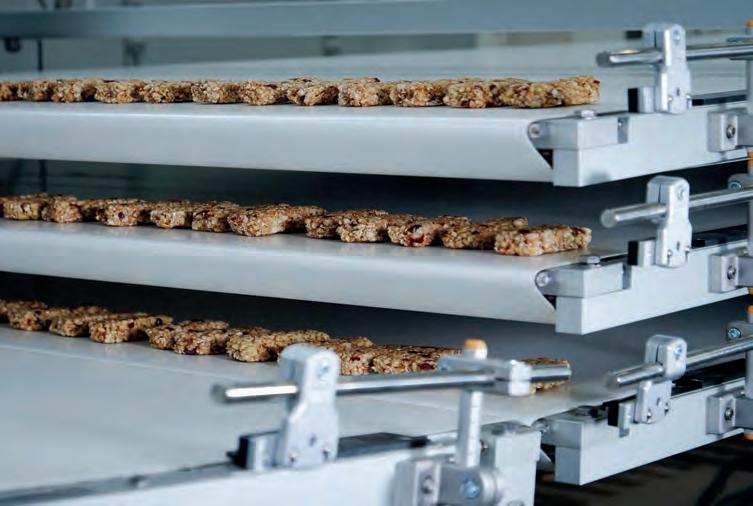

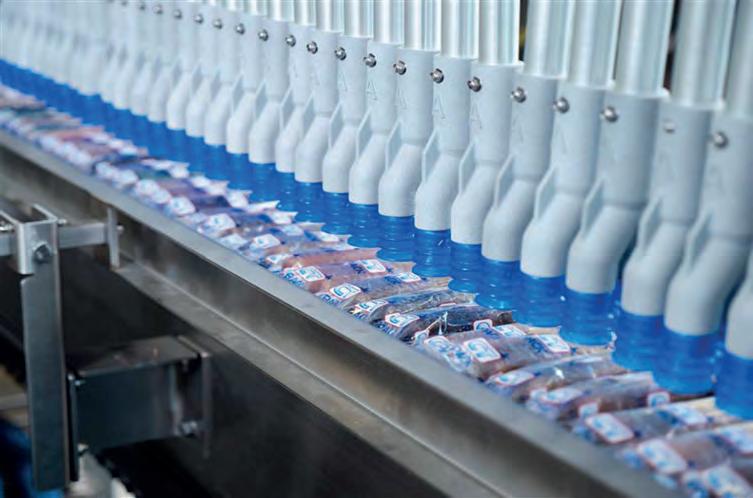


Thanks to a collaboration with third sector organisations, students from the Industrial Design Bachelor Programme at the University of Bologna developed an experimental project that explores the potential of packaging as a tool for emotional support.
Erik Ciravegna and Sara Battistini
The project presented on these pages aimed to design kits for people in vulnerable situations, with the goal of providing support during times of crisis. The results show how design can contribute to individual psychological well-being by transforming packaging into a tangible gesture of care and attention.
Beyond the wrapper: packaging as a gesture of care and symbol of inclusion.
An educational project exploring packaging design as a form of support in contexts of emotional vulnerability, inspired by the concept of care as a communicative gesture. In today’s packaging sector - largely driven by functionality, sustainability, and communicative appeal - a new educational experience invites us to consider another dimension: that of care. The project “Care Package. Kits for Emotional Crises” was developed within the Visual Communication Laboratory of the Industrial Design Bachelor Programme at the Alma Mater Studiorum of the University of Bologna. Second-year students engaged in an original exploration of how an artefact such as packaging can help support people’s psychological well-being in times of vulnerability.
The Laboratory promotes a design-based experiment each year, integrating theoretical knowledge and practical tools with the goal of combining cultural awareness and design skills. For the 2024/2025 edition - led by professors Erik Ciravegna and Luca Grilli, in collaboration with tutor Sara Battistini and subject experts Elisa Valerio and Elisa Vacondio - the challenge was to design “kits” capable of offering support during emotional crises, aimed at people experiencing temporary or ongoing states of fragility. The goal is not to replace professional specialists, but to create intermediate tools of awareness, comfort, and support that can serve as an initial gesture of closeness and encouragement.
From past to present: the evolution of the “care package”.
The designed kits draw inspiration from the “care package” concept: a package that, over time, has embodied many forms of solidarity, comfort and connection.
The term “care package” historically refers to the aid sent after World War II by the humanitarian organization CARE, which was established to provide food assistance to European populations affected by the conflict.
The first CARE Package, sent in 1946, contained essential goods and became a tangible symbol of international solidarity. However, the practice of sending gifts or supplies to distant loved ones has roots far back in time, spanning eras and culturesfrom Roman soldiers and Crusader knights, to 20th-century migrants and today’s university students living away from home.
In every era, these gestures have represented material and emotional care, tools of connection between giver and receiver. The symbolic value of the “care package” is that of a container of attention, affection and recognition. It is a tangible gesture that conveys presence and support, even across distances.
Today, a kit can include physical objects, but also digital content such as apps, eBooks, and videos. And it is precisely this dualitybetween physical and digital, concrete and symbolic - that inspired the students in designing their kits. Particular attention was given to the balance between form and content, between message and material support. The communication campaign accompanying each kit - shared through social media, print media, or eventscompleted the design stage by spreading awareness messages and promoting the idea of design as a social act.
Packaging as a relationship interface. The emotional crises examined by the project groups involve frequent but often unspoken situations: from illness to loss, from identity shifts to interpersonal or internal conflicts. The goal was to provide initial emotional support, a signal that says: “you are not alone”, “you are not invisible”. In this perspective, packaging is no longer just a container, but becomes a relational interface, capable of initiating a process of contact and reflection. Materials, formats, messages, and visual grammar were carefully selected to foster a gentle, non-invasive dialogue that was empathetic and respectful. The project involved the active participation of numerous local organisations dedicated to psychological well-being, mental health, and social inclusion: Associazione G.R.D. Genitori Ragazzi Down Bologna; Bimbo Tu, Cassero LGBTQIA+ Center, Educare alle Differenze, Fondazione Blue Butterfly E.T.S., La Rete Magica OdV - Amici per l’Alzheimer e il Parkinson, Penny Wirton School in Bologna - Associazione Diritto alla Parola, SIPEM SoS ER - Società Italiana Psicologia dell’Emergenza Emilia Romagna, Susan G. Komen Italia - Emilia-Romagna Committee, U.S.S.M Ufficio Servizio Sociale MinorenniBologna office. Dialogue with these organizations allowed for a deeper understanding of the specific needs of various target groups - minors, the elderly, migrants, people with disabilities - and for the development of solutions that respond to concrete and multifaceted needs.
Packaging that embraces. Underlying the project is a vision of psychological well-being as a state of balance that enables individuals to develop their abilities, face daily challenges, build healthy relationships and find meaning in their lives. In this context, design is proposed as a mediator between need and response, a language capable of facilitating resilience, stimulating autonomy and promoting inclusion.
The Care Package project highlighted how design can influence not only the form of the objects, but also the meanings they carry, the relationships they foster, and the overall quality of people’s lives. In this sense, packaging reaffirms itself not just as a container, but as a communicative contentcapable of embracing the emotional and social complexity of our time.
“Care Package. Kits for emotional crises” does not merely explore inclusive design: it practices it, stages it, and translates it into concrete, communicative artefacts. The entire educational journey has been guided by the idea that packaging can be a gesture that embraces, an artefact that takes care of people.
At a time when psychological well-being is increasingly the focus of public attention - yet still often stigmatised or abstractly discussed - this project proposes a tangible, sensitive approach. A way to reflect, through design practice, on the role that design and visual communication can play in fostering more human, supportive and conscious relationships.
Advanced Design Unit Università di Bologna Erik Ciravegna - erik.ciravegna@unibo.it; Sara Battistini - sara.battistini7@unibo.it


PESATRICI LINEARI, MULTITESTA LINEARI E MULTITESTA.
SCOPRI LA GAMMA DI SISTEMI DI PESATURA PIÙ COMPLETA SUL MERCATO
• Funzioni software avanzate per calcolare rapidamente e con estrema precisione la quantità di prodotto da pesare
• Massima facilità di pulizia grazie al telaio aperto e alla possibilità di smontare rapidamente tutte le parti a contatto con il prodotto, garantendo igiene e sicurezza alimentare
• Progettate per una manutenzione semplice e intuitiva, riducendo i tempi di inattività e aumentando l’efficienza operativa
VI ASPETTIAMO:
• IPACK-IMA | Stand A38 C49 Padiglione 3 @Milano | 27-30 maggio 2025 - Partner di:
comek.it
Sun Chemical affronta le costanti trasformazioni del mondo del packaging con un processo di continua ricerca delle migliori soluzioni per inchiostri, adesivi e coating destinati alla stampa rotocalco e flessografica.
Il mondo del Packaging sta cambiando rapidamente seguito dalle tecnologie di stampa e materie prime impiegate. Un percorso che nel mercato europeo è sempre più condizionato da normative e legislazioni che favoriscono concetti di sostenibilità e circolarità, mantenendo saldi i riferimenti di sicurezza prodotto attraverso regolamenti sempre più stringenti.
Circolarità nel packaging tra R&D e innovazione
L’imballo non può più essere visto solo dal punto di vista grafico e funzionale ma anche in considerazione al suo fine vita. In questo contesto Sun Chemical, forte dei suoi importanti laboratori Europei di Ricerca Sviluppo e Applicazione ha sviluppato una serie di soluzioni per il packaging compatibili con le più recenti tecnologie di riciclo meccanico.
Una nuova generazione di inchiostri liquidi
Tra le proposte di Sun Chemical spicca una nuova generazione di Inchiostri base solvente completamente esente da nitrocellulosa e adatta a più applicazioni, dalla stampa Flessografica al Rotocalco, dalla stampa esterna alla laminazione. La serie è stata studiata per offrire altissima qualità di stampa anche con basse lineature, grande versatilità di utilizzo e ottime performance in strutture laminate, anche dopo processi termici come pastorizzazione e sterilizzazione. Si tratta di una soluzione innovativa nata dalla forte sinergia tra i laboratori R&D integrati all’interno di Sun Chemical che spaziano dalla sintesi delle resine poliuretaniche più idonee alla ricerca di pig-
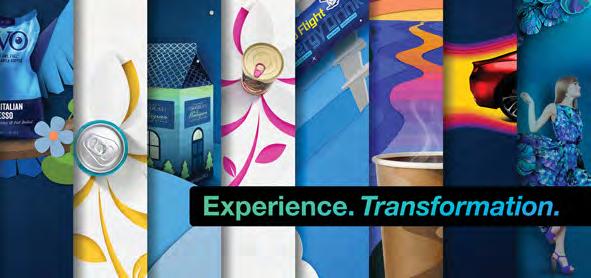
menti ad alte prestazioni, alla formulazione di adesivi di ultima generazione, senza dimenticare la specifica esperienza dei formulatori di inchiostri per packaging.
Innovazione nei prodotti a base acqua
Nonostante le sfide del mercato siano sempre più stringenti, Sun Chemical precorre i tempi trasformandole in opportunità. È il caso delle soluzioni a base acqua dove sono stati sviluppati una nuova serie di inchiostri di seconda generazione per stampa di superfici plastiche con altissime qualità di definizione delle immagini, alta resa cromatica e bassi consumi, perfettamente allineate con tutte le più recenti normative per il food packaging e le linee guida che spingono il mercato verso l’economia circolare.
Lacche e adesivi a barriera
Tra le innovazioni proposte al mercato da Sun Chemical spiccano anche lacche barriera e adesivi barriera che oggi, opportunamente combinati tra loro, permettono di sviluppare soluzioni di packaging che offrono elevate proprietà di barriera a vapore acqueo e ossigeno. Si tratta di soluzioni che permettono di passare da film multimateriali difficilmente riciclabili a film monomateriali a basso spessore completamente riciclabili, a film biodegradabili o addirittura a strutture composte da carta funzionalizzata, in linea con il recente regolamento PPWR e la direttiva SUP.
Per quanto il mondo del packaging possa trasformarsi, la gamma di prodotti Sun Chemical risponde pienamente al claim aziendale Esperienza e Trasformazione: una filosofia che guida ogni giorno i tecnici nel trovare soluzioni innovative capaci di fare la differenza.
Sun Chemical responds to the ongoing evolution of the packaging industry through continuous research and development of innovative inks, adhesives and coatings for gravure and flexographic printing.
The packaging world is changing rapidly, and printing technologies and raw materials must evolve with it. In the European market, this transformation is increasingly influenced by regulations and legislation that promote sustainability and circularity, while maintaining stringent standards on product safety through increasingly tighter regulations.
Circularity in packaging: where R&D meets innovation
Packaging can no longer be viewed solely from a graphic and functional perspective but also considering its end-of-life. In this context, Sun Chemical, supported by its leading European research, development and application

laboratories, has developed a range of packaging solutions compatible with the latest mechanical recycling technologies.
Among Sun Chemical’s latest developments is a new generation of solvent-based inks that are completely nitrocellulose-free and suitable for a wide range of applications, including flexographic and gravure printing, external printing and lamination. The range has been designed to offer the highest quality printing, even with low line screen values, great versatility of use, and excellent performance in laminated structures, even after
thermal processes such as pasteurisation and sterilisation. This innovative solution stems from a strong synergy between Sun Chemical’s integrated R&D laboratories: from the synthesis of the most suitable polyurethane resins to the search for highperformance pigments, and the formulation of next-generation adhesives – all supported by the specialised expertise of packaging ink formulators.
Despite increasingly stringent market challenges, Sun Chemical stays ahead of the curve by turning them into opportunities. This is particularly true for water-based solutions, where a new range of second-generation inks has been developed for printing on plastic surfaces. These formulations offer extremely high image definition, high colour yield, and low consumption, in full compliance with the latest food packaging regulations and the guidelines steering the industry
towards a circular and sustainable economy.
Barrier lacquers and adhesives
Among the innovations introduced by Sun Chemical are barrier coatings and barrier adhesives that, when combined appropriately, offer the possibility of developing packaging with excellent moisture vapour and oxygen barriers. These solutions support the transition from multi-material films that are difficult to recycle to singlematerial, thin, fully recyclable films, biodegradable films, or even structures made from functionalised paper. All of this aligns with the recent Packaging and Packaging Waste Regulation (PPWR) and SUP directive. No matter how much the packaging world evolves, Sun Chemical’s product range continues to embody the company’s motto – Experience. Transformation. – that guides its technicians every day in finding innovative solutions that can truly make a difference.
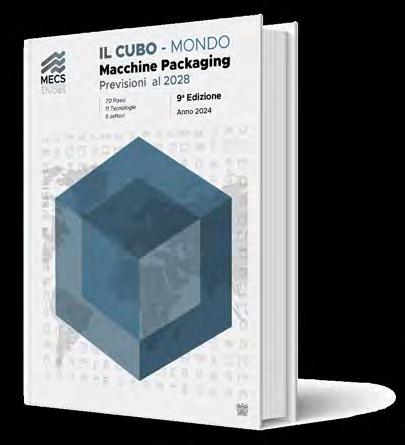







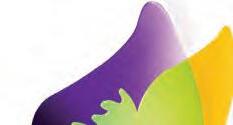

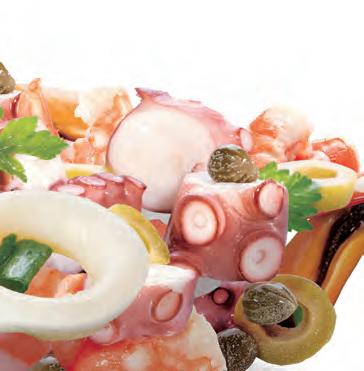





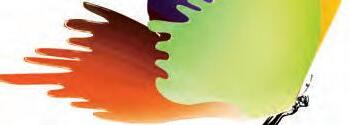



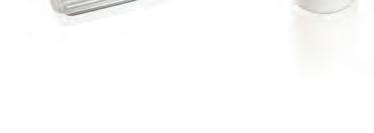






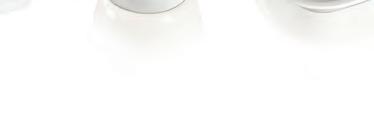




«Un’edizione speciale, con oltre 100 aziende del comparto macchine», Antonia Benvegnù. In fiera ItaliaImballaggio ha incontrato anche Antonia Benvegnù, Head of Sales Cosmopack Bologna, Asia and Americas, che ha condiviso un primo bilancio della manifestazione: “Questa è un’edizione speciale, in cui Cosmopack si è presentato più grande del solito: ci sono più di 600 aziende che coprono tutti i segmenti della filiera produttiva. Siamo soddisfatti perché siamo riusciti ad ampliare il comparto delle macchine di processo, confezionamento ed etichettatura, arrivando a ospitare più di 100 aziende di questo
segmento, italiane e internazionali. Molto apprezzata anche la possibilità di utilizzare tutto il padiglione 19, che nel 2024 veniva condiviso con una parte di collettive straniere: questo ci ha permesso di ampliare l’offerta espositiva e di facilitare il flusso dei visitatori”.
Benvegnù (Head of Sales Cosmopack): “A special edition, with over 100 companies from the machinery sector”
At the fair, ItaliaImballaggio also met with Antonia Benvegnù, Head of Sales Cosmopack Bologna, Asia and the Americas, who offered an initial over-
view of the event: “This has been a special edition, with Cosmopack larger than usual. More than 600 companies took part, representing every segment of the production chain. We are very satisfied because we have succeeded in expanding the processing, packaging and labelling machinery segment to include more than 100 exhibitors, both Italian and international. Another highlight was the opportunity to use the entirety of Hall 19, which in 2024 had been shared with several international collectives. This year, having full access to the space allowed us to expand the exhibition offering and improve the flow of visitor traffic”.

ItaliaImballaggio ha incontrato alcuni protagonisti della fiera bolognese, che si è chiusa con grande successo di pubblico. Benvegnù (Head of Sales Cosmopack): “Soddisfatti per l’ampliamento dell’offerta espositiva”.
Maria Costanza Candi
Innovazione e R&D, versatilità, customizzazione, flessibilità nei cambi formato, controllo della qualità attraverso soluzioni sensorizzate, machine learning sono tra le parole chiave più utilizzate tra gli espositori presenti a Cosmopack 2025. Produttori di macchine, fornitori di materiali e prodotto finito altamente specializzati sui mercati beauty e personal care che esportano in tutto il mondo forti degli elevati standard propri del made in Italy e del made in Europe. ItaliaImballaggio ne ha incontrati alcuni, raccogliendo una fotografia del settore dinamica e fortemente orientata all’innovazione.
ItaliaImballaggio spoke with some key players at the Bologna Trade Fair, which concluded with great success. Benvegnù (Head of Sales at Cosmopack): “Satisfied with the expansion of the exhibition offering”.
Innovation and R&D, versatility, customisation, flexibility in format changes, quality control through sensor-based technologies, and machine learning were among the most frequently cited keywords by exhibitors at Cosmopack 2025. Machinery manufacturers, suppliers of materials and finished products highly specialised in the beauty and
personal care sectors presented solutions that are exported worldwide, built on the high standards of Made in Italy and Made in Europe excellence.
ItaliaImballaggio spoke with several of them, capturing a dynamic and strongly innovation-driven snapshot of the sector.
Baralan
Come osservano in azienda «ci presentiamo a Cosmoprof Worldwide Bologna incarnando il perfetto equilibrio tra innovazione tecnologica ed eccellenza industriale. Un esempio concreto? Un esclusivo packaging personalizzato con decorazione tridimensionale, simbolo tangibile del nostro impegno verso il futuro. L’adozione di tecnologie avanzate, come la stampa 3D, rivoluziona il concetto stesso di design. Con il primo Report ESG, Baralan inaugura inoltre un nuovo approccio integrato: la sostenibilità non è solo un obiettivo, ma un principio guida che attraversa ogni aspetto della nostra gestione, diventando un valore imprescindibile». «Ogni scelta riflette infatti un impegno ESG autentico, che va oltre la riduzione dell’impatto ambientale. Per noi, qualità significa coniugare bellezza e sostenibilità in modo armonioso, senza compromessi. Grande attenzione è riservata anche all’offerta di soluzioni monomateriali e dal design essenziale, come i Raquel Jars che, come ogni creazione Baralan, portano un nome femminile, simbolo di identità e stile. Perché il packaging del futuro - sottolineano ancora in Baralan - comincia oggi, attraverso ricerca, visione e il desiderio di contribuire a un mondo più bello e più sostenibile».
Il loro credo si riassume in una frase semplice ma potente: “Building bridges between dreams and reality”.
Baralan
“At the heart of its presence at the trade fair, Baralan positions itself as the exclusive partner of the 2025 edition of Cosmoprof Worldwide Bologna, embodying the perfect balance between technological innovation and industrial excellence. A concrete example? An exclusive, custom-designed packaging featuring three-dimensional decoration - a tangible symbol of our commitment to the future. The use of advanced technologies, such as 3D printing, is revolutionising the very concept of design. With the release of its first ESG Report, Baralan launches a new integrated approach: sustainability is no longer just a goal but a guiding principle embedded in every aspect of the company, becoming an indispensable value”.
“Every choice reflects a genuine ESG commitment,” they explain at Baralan, “one that goes beyond simply reducing environmental impact. For us, quality means combining beauty and sustainability in perfect harmony, without compromise. Great attention is also paid to offering mono-material solutions and minimalist design, such as the Raquel jars, which, like all Baralan creations, bear a feminine name as a symbol of identity and style”.
“Because the packaging of the future,” observes Baralan, “begins today, through research, vision and the desire to help create a world that is both more beautiful and more sustainable. Our credo is summed up in a simple yet powerful phrase: “Building bridges between dreams and reality”.
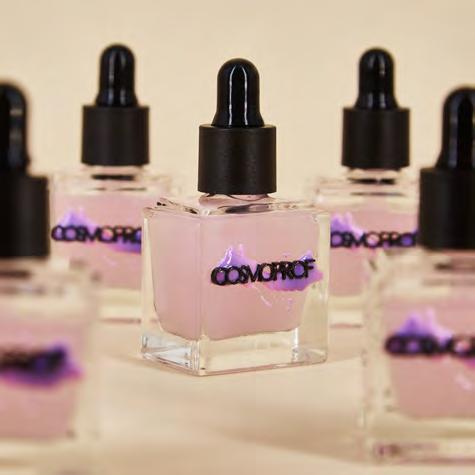


Marino Belotti
«Siamo una realtà italiana che opera da 50 anni nella packaging valley bergamasca» esordisce Rosalba Rotella chief commercial officer e alla direzione marketing. «Nati come fornitore del settore moda, in particolare bottoni, abbiamo acquisito da quel mercato cultura del design, precisione e capacità di anticipare i trend con soluzioni, proposte in diversi materiali, forme e applicazioni per colour cosmetics, solari compatti, profumeria solida e tutti quei prodotti che trovano il loro alloggiamento nei nostri compacts. Produzione, R&D, realizzazione stampi e atelier sono interni all’azienda dove si studiano le tendenze declinate in prodotto e proposte ai grandi player del beauty».
«I nuovi trend guardano a subculture e contaminazioni che provengono dall’Oriente e spingono oggi il consumatore a costruire il proprio stile» prosegue il CEO Alfredo Gavazzeni. «È qui che nasce la necessità di personalizzazione estrema del packaging, il che ci porta ad anticipare ai fornitori B2B soluzioni che interpretano il mood del cliente e ne orientano le creazioni, imprimendo un’accelerazione anticipataria sugli stili del futuro e guidando così il mercato. Le collezioni vengono infatti proposte in base alla stagionalità, utilizzando materiali come plastica e metallo con crescente attenzione a soluzioni sostenibili come PET monomateriale, removable e una gamma di soluzioni green certificate Eco Vadis Silver e ISO».
Marino Belotti
“We are an Italian company that has been operating in the heart of the Bergamo Packaging Valley for 50 years,” says Rosalba Rotella, Chief Commercial Officer and Marketing Director. “Having started out as a supplier to the fashion industry, particularly buttons, we’ve inherited from that world a strong design culture, precision and the ability to anticipate trends. Today, we offer solutions in a variety of materials, shapes and applications for colour cosmetics, compact sunscreens, solid perfumes and fragrances, and all products designed to be housed in our compacts. Our production, R&D, mould making and design atelier are all in-house. This allows us to study trends, translate them into products, and present them to major players in the
beauty industry.
“The latest trends draw inspiration from subcultures and contaminations coming from the East, encouraging today’s consumers to create their own unique style,” continues CEO Alfredo Gavazzeni.
“This is where the need for highly customised packaging arises, leading us to provide B2B suppliers with solutions that interpret the customer’s mood and inspire their creations - offering a forward-thinking edge on emerging styles and positioning them at the forefront of the market.
Collections are presented seasonally, using materials such as plastic and metal, with an increasing focus on sustainable solutions such as mono-material PET, removable components and a range of EcoVadis Silver- and ISO-certified green solutions”.

«Tra le novità presentate in fiera da Sales, spicca un’etichetta ideata da Spazio Di Paolo, dedicata al mondo del wine&spirits di lusso» racconta Domenico Tessera Chiesa owner e CEO. «Si tratta di una soluzione realizzata con un frontale in carta Pearl accoppiata con un PP ultra-clear “no label look”. Il frontale presenta un rilievo tattile ottenuto con lamina colata in linea con la tipologia di Brut. Inoltre, è presente una serigrafia nera elegante abbinata ad un rilievo a secco in cornice. Il film ultra-trasparente, prima di essere accoppiato a registro con il frontale, viene nobilitato con stampa in lamina oro bifacciale e fondino in serigrafia. L’etichetta rappresenta un esempio emblematico delle nuove richieste del mercato che dopo anni di minimalismo torna al gusto del lusso declinato sull’oro, con varietà di nobilitazioni che guardano a lamine ed effetti tattili. L’esperienza del consumatore inizia quindi nelle prime fasi di contatto con la confezione, che permette di viverne il mood attraverso l’estetica, il senso del lusso e il ritorno del concetto di bello, ricco, allegro, variopinto. Tra le altre soluzioni proposte da Sales troviamo una linea di etichette in PP riciclato 100%, stampate in offset digitale con massima risoluzione e riduzione degli sprechi: un progetto realizzato per un player BCorp attivo nel beauty&personal che abbina sostenibilità del pack all’effetto naturale ottenuto grazie ad una speciale vernice a finire con effetto soft touch. La sostenibilità delle etichette offerte da Sales non si ferma all’origine delle materie prime provenienti da filiere europee, ma, grazie ad un adesivo appositamente studiato e certificato da Recyclass, garantisce un perfetto distacco dell’etichetta dal flacone in fase di riciclo, senza residui di colla. Il supporto siliconato è certificato FSC per un corretto conferimento all’interno della filiera di separazione e riciclo su cui Sales lavora come punto di forza della sua proposta commerciale».
“Among the new offerings presented at the fair by Sales is a label designed by Spazio Di Paolo, created specifically for the world of luxury wine and spirits”. “This solution features a pearlescent paper front laminated with ultra-clear PP to achieve a no-label look,“ explains Domenico Tessera Chiesa, Owner and CEO. “The front features a tactile relief created through inline foil casting, in keeping with the Brut style. It also features an elegant black screen print paired with framed embossing. Before being precisely laminated to the front, the ultra-transparent film is enhanced with double-sided gold foil printing and a screen-printed backing. The label is an excellent example of the market’s evolving tastes: after years of minimalism, there is a renewed appetite for luxuryinterpreted through gold and a variety of embellishments including foils and tactile effects. The experience of consumers now begins at the very first point of contact with the packaging, which allows them to experience the mood through its aesthetics, evoking a sense of luxury and reviving the concept of beauty as something rich, joyful and full of colour. Other solutions presented by Sales include a line of labels made from 100% recycled PP, digitally-offset printed at maximum resolution with minimal waste. Developed for a BCorp operating in the beauty and personal sector, the project combines packaging sustainability with a natural look and feel, achieved through a special finish with a soft-touch effect. Sales’ commitment to sustainability goes beyond the use of raw materials sourced from European supply chains. Thanks to a specially developed adhesive - certified by Recyclass - the labels ensure clean separation from the bottle during recycling, leaving no glue residue behind. In addition, the siliconised substrate is FSC-certified, supporting proper disposal within the separation and recycling chain, a key strength in Sales’ sustainability-driven business approach”.


«Siamo presenti in fiera dal 1996 - sottolinea Cristian Caroli - e non potevamo mancare all’edizione 2025 dove TGM presenta una gamma di macchine per riempimento e astucciamento rivolte alla cosmetica e al packaging secondario. Si tratta di un’astucciatrice verticale che garantisce alta flessibilità, cambio formato veloce e rapidità nelle operazioni, funzionale in particolare ai terzisti che gestiscono un’ampia varietà di prodotti. Le macchine verticali permettono carico manuale o automatico in base al grado di automazione dei clienti di cosmetico e farmaceutico, che rappresentano il 90 % del business di TGM. Quanto alle nuove forme farmaceutiche come i biofarmaci, TGM lavora sulla facilità di confezionamento e riempimento, sviluppando soluzioni a stretto contatto con le case farmaceutiche per definire processi ben verificabili e sicuri che permettono di dimostrare l’elevata qualità garantita dalle sue macchine».
TGM
“We have been attending the fair since 1996,” notes Cristian Caroli, “and we couldn’t miss the 2025 edition, where TGM is presenting a range of filling and cartoning machines designed for cosmetics and secondary packaging. Among the highlights are a vertical cartoner offering high flexibility, quick format changeovers and efficient operation, particularly suited to subcontractors managing a wide range of products. The vertical machines support both manual and automatic loading, depending on the level of automation preferred by cosmetic and pharmaceutical customers, who account for 90% of TGM’s business. In response to new pharmaceutical formats such as biopharmaceuticals, TGM focuses on simplifying packaging and filling operations. It collaborates closely with pharmaceutical companies to develop verifiable and safe processes that reflect the high standards of quality its machines are known for”.
«Tra i punti di forza di Unicom, c’è la filiera europea del prodotto che garantisce qualità per i clienti e tempi di approvvigionamento estremamente contenuti anche per piccoli stock» spiega Slawomir Baranski General manager dell’azienda polacca. «In un mercato dove la qualità del servizio viene prima del prezzo, Unicom garantisce infatti delivery in pochi giorni grazie alle linee produttive in Germania e alla catena logistica collocata in Polonia. Un vantaggio che ci permette una crescita continua grazie anche alla vasta gamma di prodotti che spaziano dal monomateriale, mercato in crescita, al riciclato al 30-50 %, per quanto il core business sia ancora largamente concentrato al 90% su materiali standard. Versatilità, disponibilità di stock per piccole e grandi produzioni, tempi di fornitura contenuti ed elevata qualità del prodotto sono i principali plus di Unicom che guarda al mercato italiano con crescente interesse e l’obiettivo di costruire una rappresentanza locale, dopo quelle di Spagna e Germania».
Unicom International
“One of Unicom’s key strengths is its European supply chain, which ensures high product quality for customers and extremely short lead times, even for small stocks,” says Slawomir Baranski, General Manager of the Polish company.
“In a market where service quality comes before price, Unicom guarantees delivery within days, thanks to production lines based in Germany and a logistics network in Poland. This advantage has allowed us to grow steadily, backed by a wide product range - from mono-material packaging, a segment that is growing, to solutions made from 30-50 % recycled content. However, the core business still relies primarily on standard materials, which account for around 90%. Versatility, stock availability for small and large production runs, fast delivery times, and high product quality are Unicom’s main strengths. The company is now turning its attention to the Italian market, aiming to establish a local presence following successful expansions in Spain and Germany”.
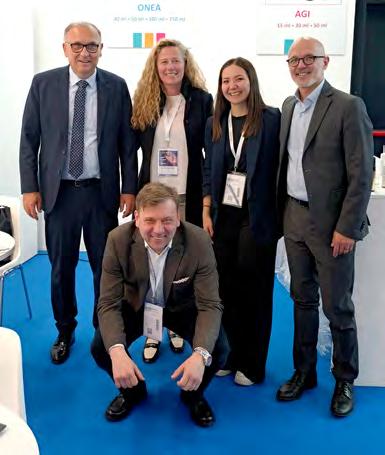
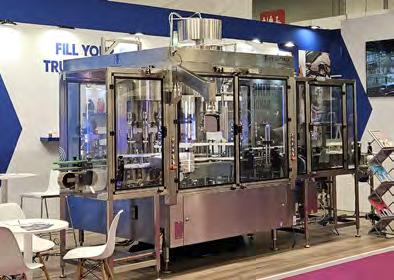
«In occasione di Cosmopack 2025, Weightpack ha presentato una riempitrice a peso netto e un tappatore ad alte prestazioni pensate per i settori home & personal care, con la possibilità di adattamento anche a prodotti alimentari, come l’olio edibile, grazie a specifici accorgimenti tecnici» spiega Laura Basile, marketing assistant. «Il sistema di riempimento a peso netto permette di ridurre in modo significativo gli sprechi, grazie a una bilancia ad alta precisione che monitora in tempo reale la quantità di prodotto presente nel contenitore. Al raggiungimento del peso desiderato, termina la fase di riempimento e si passa alla fase di tappatura. Ogni macchina Weightpack è progettata su misura per soddisfare le esigenze produttive dei settori food & beverage, dairy, home & personal care, chimico, farmaceutico, polveri e granulati. La tecnologia impiegata consente una produttività fino a 650 bottiglie al minuto e supporta formati fino a 20 litri. Sono disponibili configurazioni speciali, tra cui versioni resistenti alla corrosione, antideflagranti o dotate di sistemi per il controllo della
schiuma. Un esempio concreto è la macchina presentata a Cosmopack, proposta anche a IPACK-IMA: un sistema innovativo di riempimento a peso netto senza serbatoio, equipaggiato con rubinetti anti-schiuma. Questa soluzione è particolarmente adatta al trattamento di prodotti viscosi e ad alta densità, grazie all’impiego di una pompa in sostituzione del serbatoio, che garantisce un flusso costante e regolare, preservando le proprietà del prodotto lungo l’intero processo».
“At Cosmopack 2025, Weightpack presented a net weight filler and a high-performance capper designed for the home and personal care sectors, with the flexibility to adapt to food products, such as edible oils, thanks to specific technical features,” explains Laura Basile, Marketing Assistant. “The net weight filling system greatly reduces waste through a high-precision scale that monitors the amount of product in the container in real time. Once the desired weight is reached, the filling process stops, and the container proceeds to the capping phase. Each Weightpack machine is custom-designed to meet the production needs of a wide range of sectors, including food & beverage, dairy, home & personal care, chemicals, pharmaceuticals, as well as powders and granulates. The technology allows for outputs of up to 650 bottles per minute and supports container sizes up to 20 litres. Special configurations are also available, including corrosion-resistant, explosionproof and foam-control versions. A concrete example is the machine presented at Cosmopack, which was also featured at IPACK-IMA: an innovative tankless net weight filling system equipped with anti-foaming taps. This solution is particularly suitable for handling viscous and high-density products. By using a pump instead of a tank, the system ensures a consistent and steady flow, preserving the quality of the product throughout the entire process”.

«Con le etichette autoadesive, realizzate sia con materiali standard che con materiali eco-friendly, dai film riciclati, carte certificate FSC, ai materiali biodegradabili e compostabili, Arca Etichette è protagonista nel settore farmaceutico, cosmetico, chimico e alimentare con soluzioni sempre più sostenibili» osserva Martina Stea, Marketing Specialist. «Siamo una Società Benefit certificata B Corp, da sempre puntiamo a un approccio responsabile, sia dal punto di vista sociale che ambientale, del prodotto e dei processi produttivi. Ed è con questa filosofia che realizziamo etichette per ogni esigenza: per il decoro, anche in versione multipagina, per la sicurezza, per la logistica e non solo. Tra le specializzazioni di Arca Etichette spicca la divisione Sistemi con le sue soluzioni innovative per l’etichettatura autoadesiva e la marcatura laser».
Arca Etichette
“With our self-adhesive labels, made from both standard and eco-friendly materials, including recycled films, FSC-certified papers, and biodegradable and compostable materials, Arca Etichette is a key player in the pharmaceutical, cosmetics, chemical and food industries, offering increasingly sustainable solutions,” says Martina Stea, Marketing Specialist. “We are a certified Benefit
Company (BCorp), and have always pursued a socially and environmentally responsible approach to both our products and production processes. Guided by this philosophy, we produce labels for a wide range of needs: from decorative applications (including multipage versions) to security, logistics and beyond. Arca Etichette’s expertise also extends to its Systems Division, which develops innovative technologies for self-adhesive labelling and laser marking”.



Soluzioni su misura, assistenza global e, innovazione costante e sostenibilità energetica. Con Zambelli Packaging, il tuo business cresce nel segno dell'eccellenza.
Tailor-made solutions, global assistance, constant innovation and energy sustainability. With Zambelli Packaging, your business grows in the name of excellence.



ACMA SPA 111
AETNA GROUP SPA 150
ALTECH SRL 27
ARCOPLASTICA SRL 160
AUTOMATION ADDRESS SRL 19
BECKHOFF AUTOMATION SRL 3
C AMA 1 SPA 129
C APSULIT SPA II Cop.
CMI INDUSTRIES SPA 101
CO&MA SRL 81
COMEK SRL 157
CONCETTI SPA 109
CORNO PALLETS SRL 135
C T PACK SRL 155
CUTTING PACK SRL 59
EIDOS SRL 119
ELESA SPA 73
E TIPACK SPA 118
FB INTERNATIONAL INC 167
G.B. GNUDI BRUNO SPA 12-13
GAMPACK SRL 74
GERHARD SCHUBERT GMBH 120
GOGLIO SPA 130
ICOTEK ITALIA SRL 79
IMA INDUSTRIA MACCHINE AUTOMATICHE SPA 11, 31, 86, 123
IMBALL SRL 115
INTERROLL ITALIA SRL 125
LIVE-TECH SRL 53
LOGIMATIC SRL 112
LUXORO SRL 91
MARCHESINI GROUP SPA IV Cop.
MARKEM-IMAJE SRL A SOCIO UNICO 65
ME.RO SPA 104
MESSE DÜSSELDORF GMBH 21
MF GMBH 139
NIMA ERRE.TI PACKAGING SRL 29
NORELEM SRL 76
PAUL & CO GMBH & CO KG 33
PR RUBINO SRL 77
PRATI SRL 17
PUNTO PACK SPA SOCIETÀ BENEFIT 88
RECYCLA SRL 117
REED TÜYAP FUARCILIK A .Ş. 32
RICREA - CONSORZIO NAZIONALE PER IL RICICLO ED IL RECUPERO DEGLI IMBALLAGGI DI ACCIAIO III Cop.
ROBATECH ITALIA SRL U.S. 126
RONCHI MARIO SPA 54-55
S.I.A.D. SOCIETÀ ITALIANA ACETILENE & DERIVATI SPA Inserto Slegato
SC ANDOLARA SPA 7
SCHNEIDER ELECTRIC SPA Bandella SERVOTECNICA SPA 63
SIPRO SRL 84
SIS.MA SRL 66
SIT SPA STAMPA IMBALLAGGI TRASPARENTI 44-45
SUN CHEMICAL GROUP SPA 67
SUPER FILM AMBALAJ SANAYI VE TIKARET A.S. 68
TGM - TECNOMACHINES SRL 6
TIBER PACK SPA 82
UNIVERSAL PACK SRL 143
VANCOM IMBALLAGGI SRL 71
VERIMEC SRL 61
Z AMBELLI PACKAGING 165

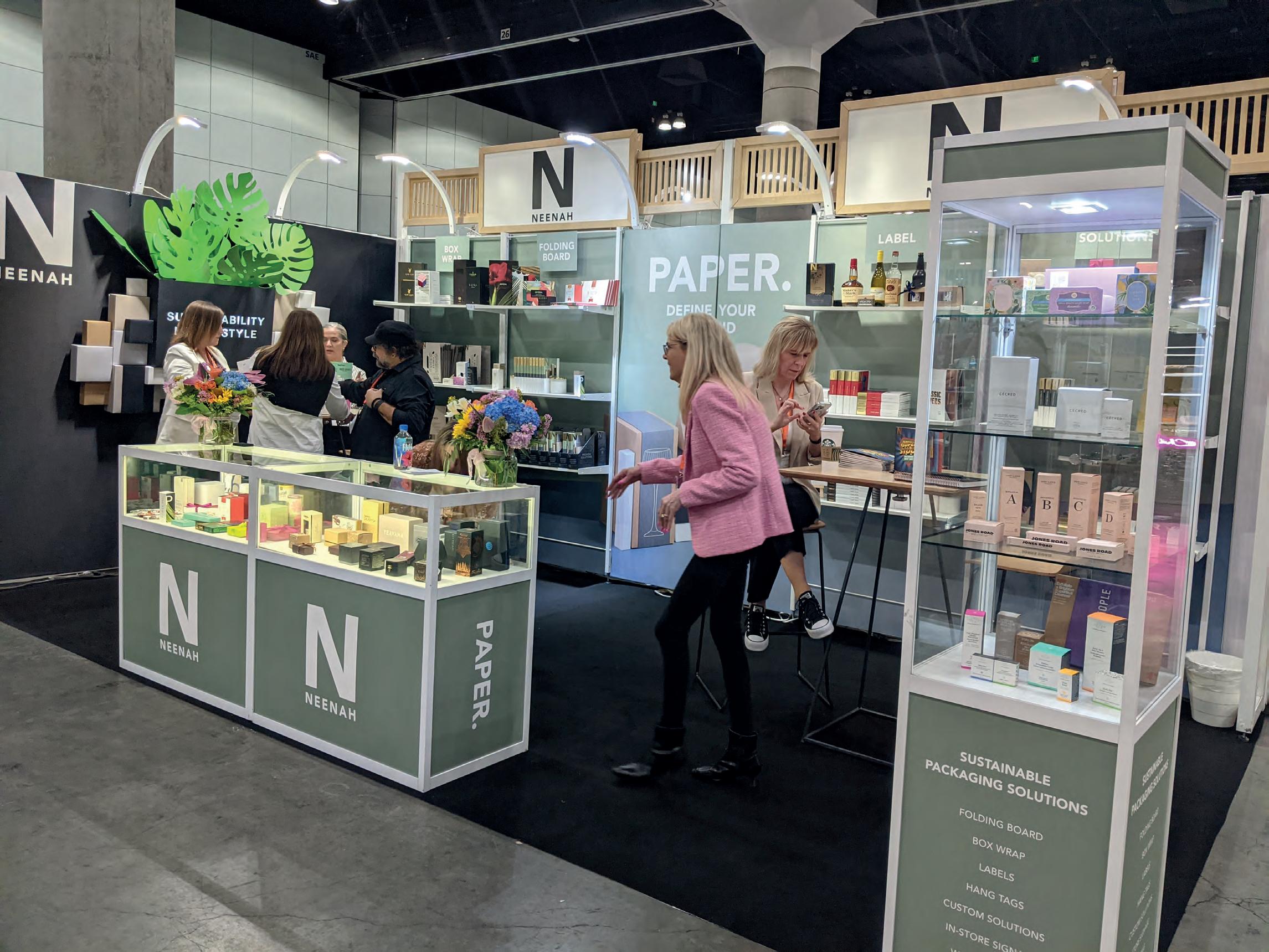
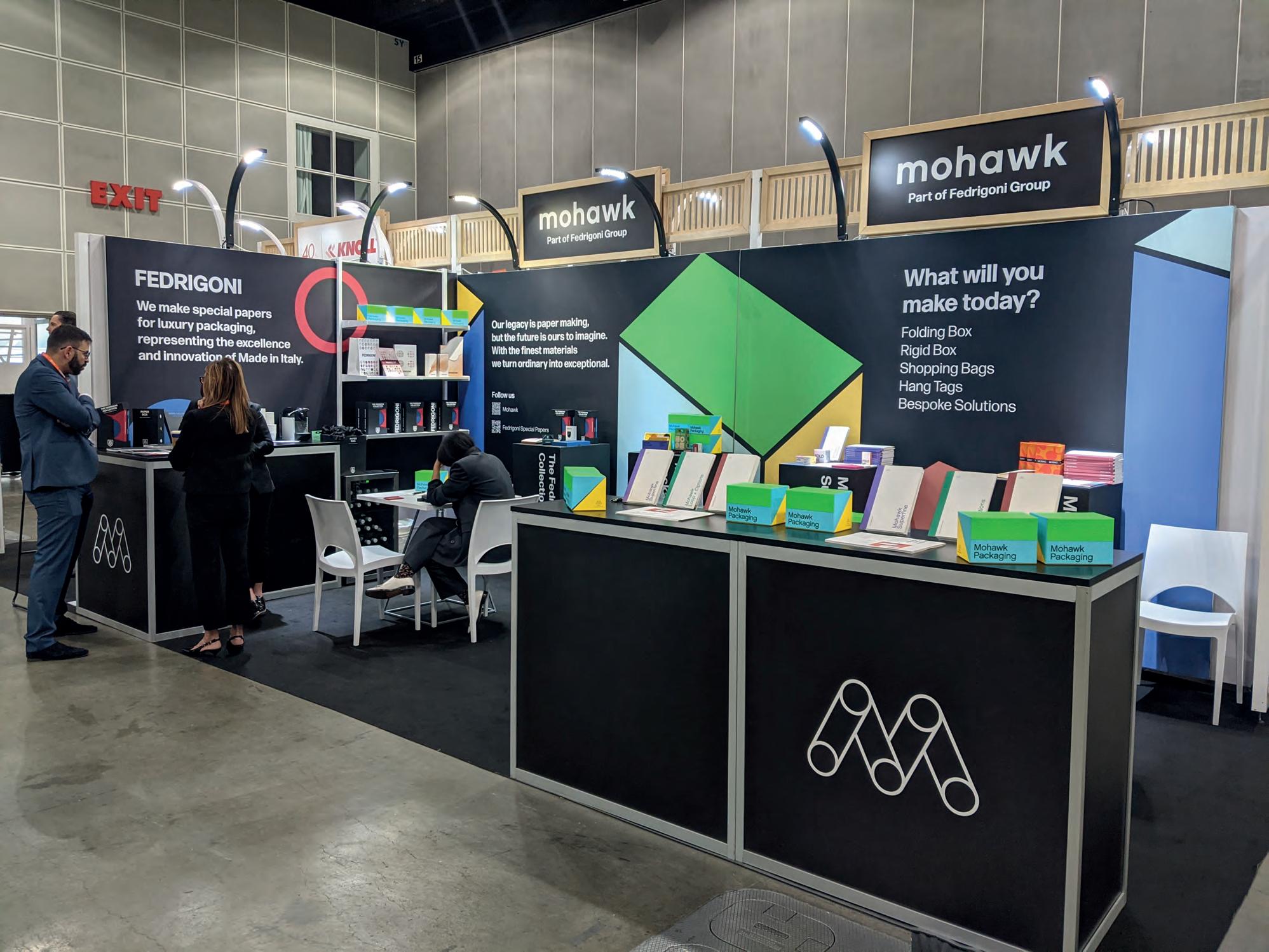


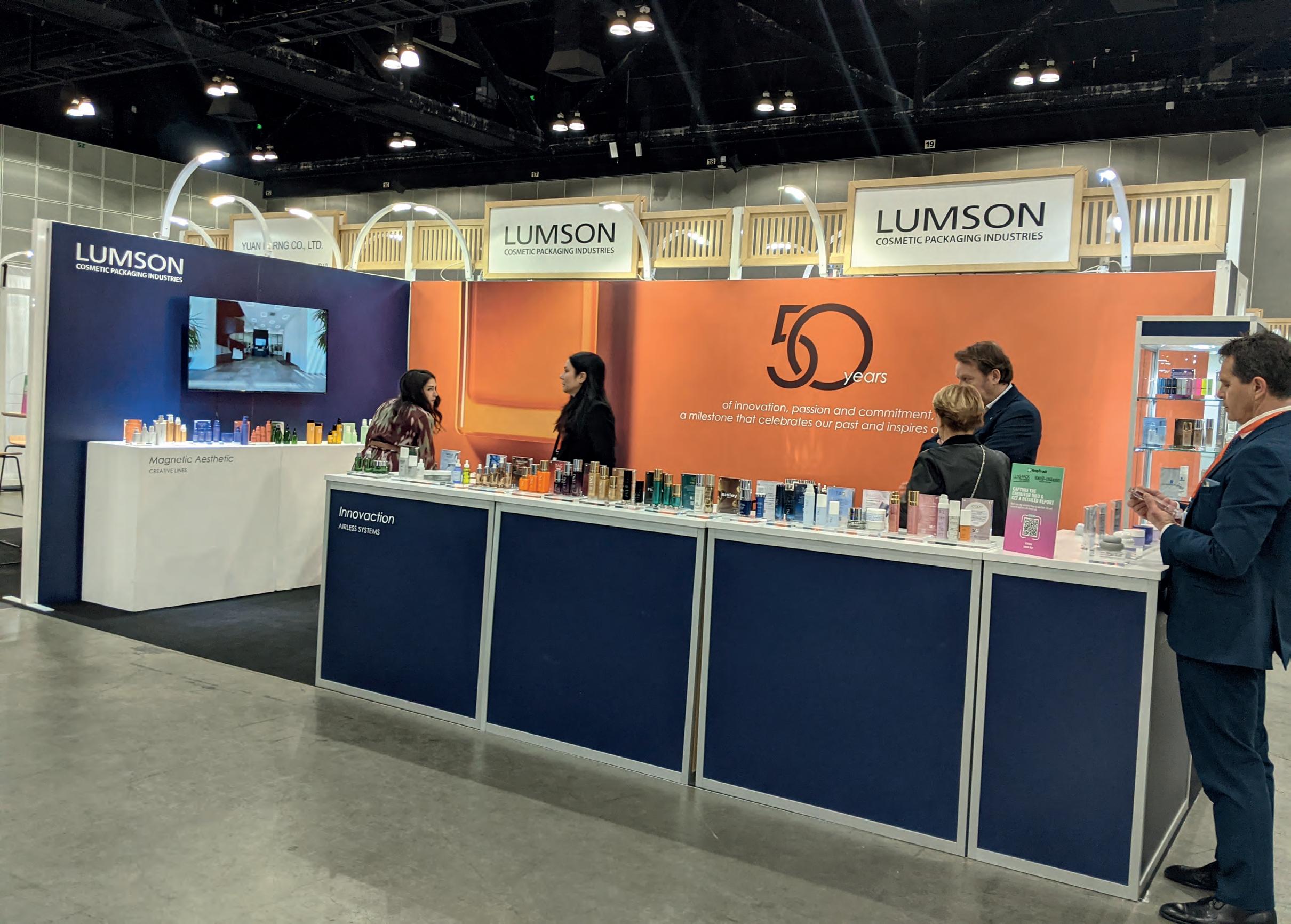


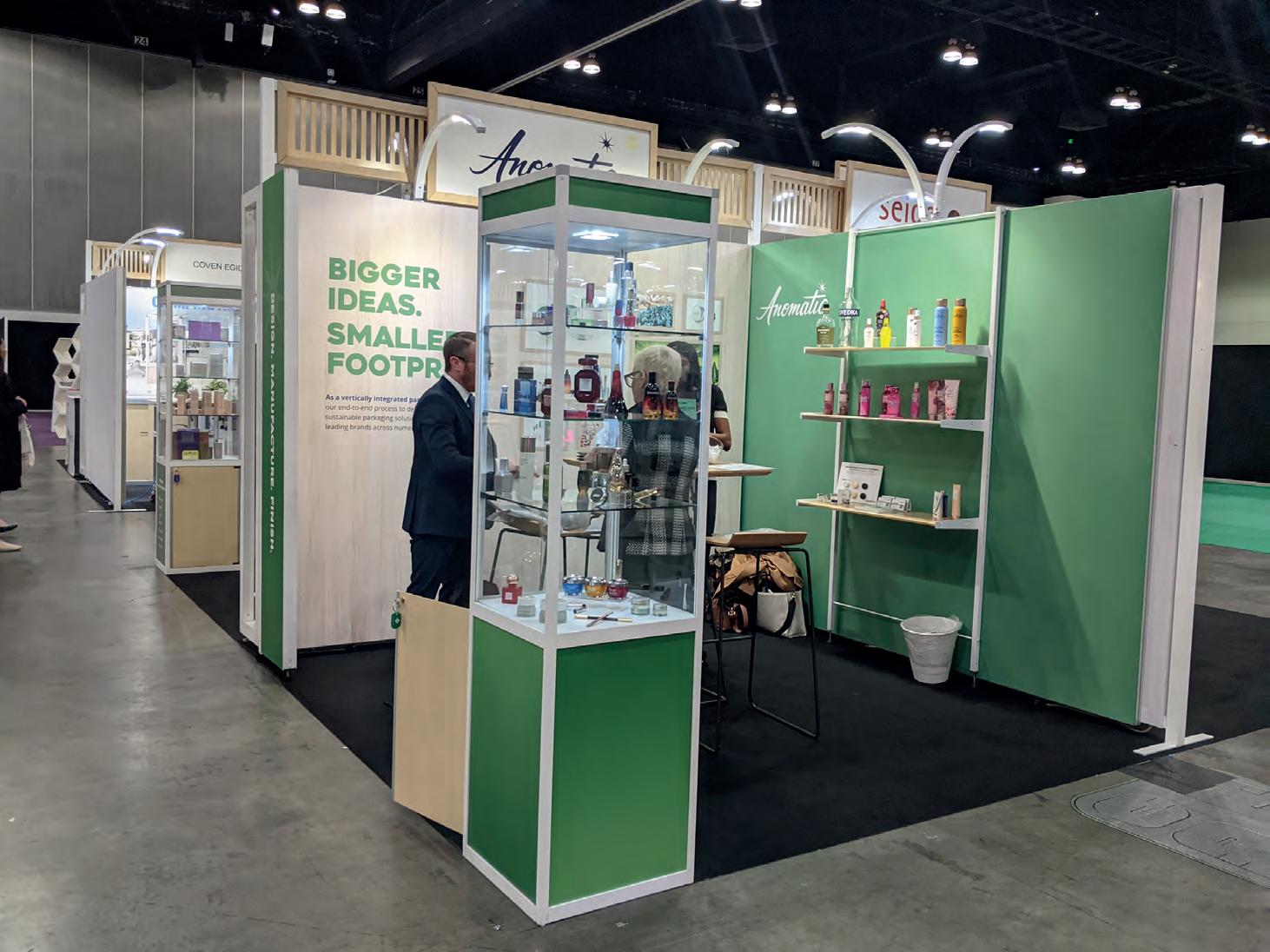
Soluzioni espositive chiavi in mano. Strutture su misura. Servizio completo, dall’idea alla realizzazione.
Stai organizzando il tuo prossimo evento negli Stati Uniti? Costruiamolo insieme. Contattaci per un preventivo.
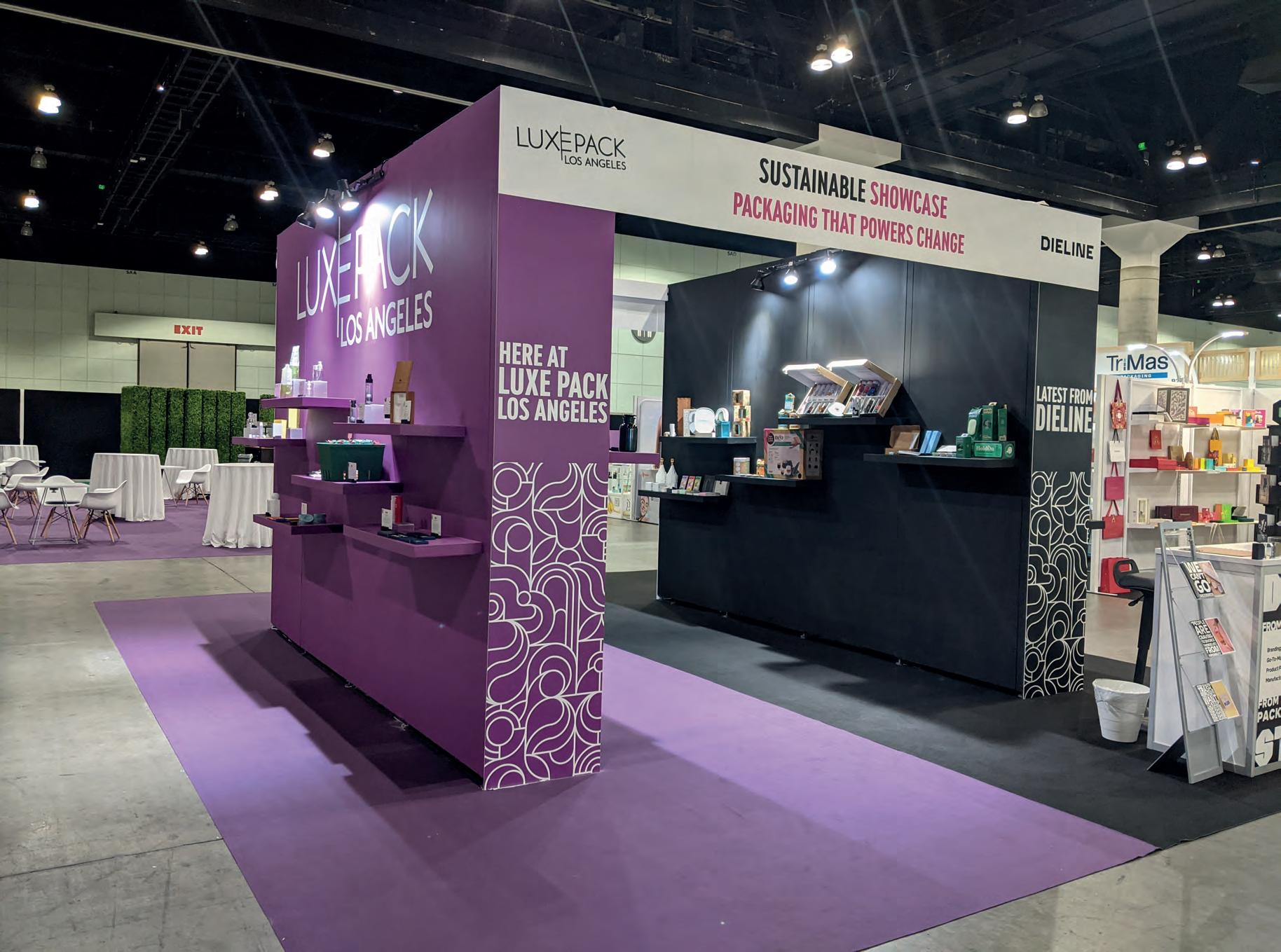
A. LOACKER SPA 36
ALIPLAST SPA 136
ALTECH SRL 89
AMICA CHIPS SPA 83
ARCA ETICHETTE SPA 159, 88
AUTOMATION ADDRESS SRL 89
AXOMATIC SRL 78
BARALAN INTERNATIONAL SPA 159
BARILLA G.E R. FRATELLI SPA 15
BD-EXPO 8
BOBST ITALIA SPA 37
BOLOGNAFIERE COSMOPROF SPA 159
BONFIGLIOLI RIDUTTORI SPA 108
BOSCH REXROTH SPA 131
BRAFIM MECPLAST SL 16
C.C.M. COOPERATIVA CARTAI
MODENESE SOC. COOP. 18
CAFFAREL SPA 35
CAMA 1 SPA 106, 70
CENTRO QUALITÀ CARTA (DIV. OPERATIVA LUCENSE) 83
CLABER ECOLOGIA 37
CMI INDUSTRIES SPA 131
COMEK SRL 87
CONAI - CONSORZIO NAZIONALE IMBALLAGGI 14
COOPBOX GROUP SPA 25
CT PACK SRL 72
CUTTING PACK SRL 58
D.C.M. SRL 95
DAVINES SPA 20
ENDRESS + HAUSER ITALIA SPA 131
ERCOPAC SRL 121
ETIPACK SPA 122, 90
EUROPEN 136, 140, 156 23, 28, 39
FATTORIE OSELLA SPA 32
FOOD CONTACT CENTER SRL 46
FOOD CONTACT SERVICES SRL 46
FRAUNHOFER ITALIA SCRL 36
GAMPACK SRL 75 GIFLEX 46
GOGLIO SPA 22, 64
GRANTERRE SPA 23, 34
GRIFAL SPA 24
GRUPPO HERA 136
HAPPY SRL 25
HERAMBIENTE SPA 66
HIPAC SPA 60
HIWIN SRL 100
ICO SPA - INDUSTRIA CARTONE ONDULATO 26 ICOTEK ITALIA SRL 105
IPACK IMA SRL 121, 14 IRPLAST SPA 28, 29, 30
ISTITUTO ITALIANO IMBALLAGGIO 14, 83
ISTITUTO STAMPA SRL 32, 34
KRAFT FOODS DEUTSCHLAND GMBH 14
L. POSSEHL & CO. MBH 122
LAMINATI CAVANNA SPA 122
LINDT & SPRUNGLI SPA 35
LUCAPRINT SPA 37
LUMSON SPA 38
M.H. MATERIAL HANDLING SPA 85
MARCHESINI GROUP SPA 78
MARINO BELOTTI SRL 159
MARKEM-IMAJE SRL A SOCIO UNICO 90
MECS SRL 144
METSÄ BOARD ITALIA SRL 35
MINEBEA INTEC ITALY SRL 102
MIP POLITECNICO DI MILANO 14
MIP POLITECNICO DI MILANO 147 MONACOFIERE 8 MUSTANGPACK SRL 40
NETCOMM CONSORZIO 147
OMAG SPA 127
PACKAGING MEETING SRL
CONSULENZA & FORMAZIONE 14
PILZ ITALIA SRL - SOCIETÀ CON UNICO SOCIO 108
PLASTIGRAF TREVIGIANA SRL 39, 41
PRATI SRL 92
PRINTINGPACK SRL 62
PUNTO PACK SPA SOCIETÀ BENEFIT 62
QWARZO SPA 124
RECYCLA SRL 66
REED TÜYAP FUARCILIK A.Ş. 10
ROCKWELL AUTOMATION SRL 106
S.I.A.D. SOCIETÀ ITALIANA ACETILENE & DERIVATI SPA 113
SABA AUTOMATION SRL 124
SACMI PACKAGING & CHOCOLATE SPA 98
SALES SPA 159
SCHNEIDER ELECTRIC SPA 98
SDR PACK SPA 66
SEA VISION SRL 127, 78 SIDEL SPA 80
SMC ITALIA SPA 110
SMILESYS SPA 40
SPL INDUSTRIES SRL 116 STORA ENSO ITALIA SRL 37 SUN CHEMICAL GROUP SPA 156 SUPER FILM AMBALAJ SANAYI VE TIKARET A.S. 69
TAGHLEEF INDUSTRIES SPA 41 TAIM SRL
- ADVANCED DESIGN UNIT DEL DIPARTIMENTO DI ARCHITETTURA 151
UNICOM INTERNATIONAL BARANSKI SP. K. 159
UNICOOP FIRENZE SCRL 25 UNIVERSAL PACK SRL 87
VEGA ITALIA SRL 128 VIMAR SPA 43
WEIGHTPACK SRL 159 WITTENSTEIN SPA 109
XNEXT

Siamo il tuo partner di fiducia, con persone, competenze e tecnologia a tua disposizione per soluzioni innovative e sostenibili su misura per il packaging. La nostra flessibilità, modularità e performance rispondono a tutte le tue esigenze e sfide future!

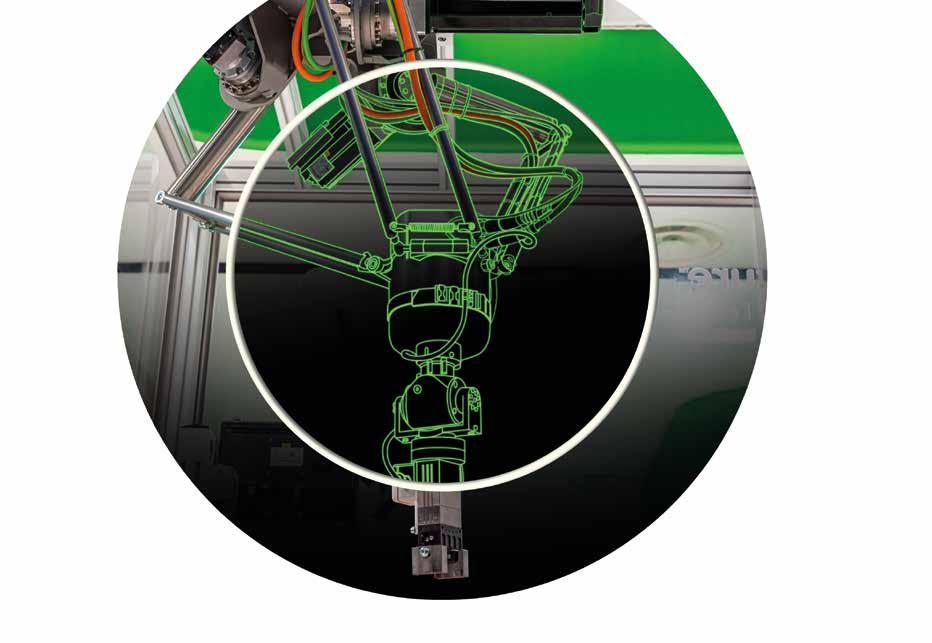



Questa è la nostra risposta a chi sogna in grande, a chi sfida l’impossibile.
Progettiamo e realizziamo macchine e linee di confezionamento per l’industria farmaceutica e cosmetica.
Ogni richiesta dei nostri clienti viene affrontata con spirito di innovazione e passione. Diamo forma ai progetti più ambiziosi, perché per noi ogni sfida è straordinaria
Vieni a trovarci a: PHARMINTECH powered by IPACK-IMA MILANO
27-30 maggio 2025
Padiglione 2 | Stand A26 B25
marchesini.com

